|
Note: If you are not at all familiar with basic electronics, you might find it easier to understand this chapter if you read chapter 12 first.
The pulsed devices mentioned so far have had moving parts but rotating or fluctuating magnetic fields can be created without moving parts. An example of this is Graham Gunderson’s solid-state electric generator shown in US Patent Application 2006/0163971 A1 of 27th July 2006 which is shown on page A-1038 of the appendix. Another example is: Charles Flynn's Magnetic Frame Another device of this type comes from Charles Flynn. The technique of applying magnetic variations to the magnetic flux produced by a permanent magnet is covered in detail in the patents of Charles Flynn which are included in the Appendix. In his patent he shows techniques for producing linear motion, reciprocal motion, circular motion and power conversion, and he gives a considerable amount of description and explanation on each, his main patent containing a hundred illustrations. Taking one application at random: He states that a substantial enhancement of magnetic flux can be obtained from the use of an arrangement like this: 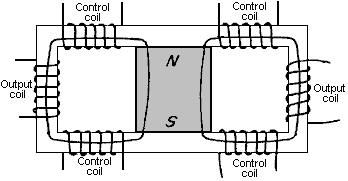 Here, a laminated soft iron frame has a powerful permanent magnet positioned in it’s centre and six coils are wound in the positions shown. The magnetic flux from the permanent magnet flows around both sides of the frame.  The full patent details of this system from Charles Flynn are in the Appendix, starting at page A - 338. Lawrence Tseung Lawrence has recently produced a subtle design using very similar principles. He takes a magnetic frame of similar style and inserts a permanent magnet in one of the arms of the frame. He then applies sharp DC pulses to a coils wound on one side of the frame and draws off energy from a coil wound on the other side of the frame. He shows three separate operating modes for the devices as follows:  Lawrence comments on three possible arrangements. The first on shown above is the standard commercial transformer arrangement where there is a frame made from insulated iron shims in order to cut down the "eddy" currents which otherwise would circulate around inside the frame at right angles to the useful magnetic pulsing which links the two coils on the opposite sides of the frame. As is very widely known, this type of arrangement never has an output power greater than the input power. However, that arrangement can be varied in several different ways. Lawrence has chosen to remove a section of the frame and replace it with a permanent magnet as shown in the diagram below. This alters the situation very considerably as the permanent magnet causes a continuous circulation of magnetic flux around the frame before any alternating voltage is applied to the input coil. If the pulsing input power is applied in the wrong direction as shown here, where the input pulses generate magnetic flux which opposes the magnetic flux already flowing in the frame from the permanent magnet, then the output is actually lower than it would have been without the permanent magnet.  However, if the input coil is pulsed so that the current flowing in the coil produces a magnetic field which reinforces the magnetic field of the permanent magnet then it is possible for the output power to exceed the input power. The "Coefficient of Performance" or "COP" of the device is the amount of output power divided by the amount of input power which the user has to put in to make the device operate. In this instance the COP value can be greater than one:  There is a limitation to this as the amount of magnetic flux which any particular frame can carry is limited by the material from which it is made. Iron is the most common material for frames of this type and it has a very definite saturation point. If the permanent magnet is so strong that it causes saturation of the frame material before the input pulsing is applied, then there can't be any effect at all from positive DC pulsing as shown. This is just common sense but it makes it clear that the magnet chosen must not be too strong for the size of the frame, and why that should be. As an example of this, one of the people replicating Lawrence's design found that he did not get any power gain at all and so he asked Lawrence for advice. Lawrence advised him to omit the magnet and see what happened. He did this and immediately got the standard output, showing that both his input arrangement and his output measuring system both worked perfectly well. It then dawned on him that the stack of three magnets which he was using in the frame were just too strong, so he reduced the stack to just two magnets and immediately got a performance of COP = 1.5 (50% more power output than the input power). Thane C. Heins. Thane has developed, tested and patented a transformer arrangement where the output power of his prototype is thirty times greater than the input power. He achieves this by using a figure-of-eight double toroid transformer core. His Canadian patent CA2594905 is titled "Bi-Toroid Transformer" and dated 18th January 2009. The abstract says: The invention provides a means of increasing transformer efficiency above 100%. The transformer consists of a single primary coil and two secondary coils. The two secondary coils are set on a secondary toroidal core which is designed to be maintained at a lower magnetic resistance than the primary toroidal core throughout the entire operating range of the transformer. Thus, when the transformer secondary delivers current to a load, the resulting Back-EMF is not allowed to flow back to the primary due to the higher magnetic resistance of that flux path, instead, the secondary coil's Back-EMF follows the path of least magnetic resistance into the adjacent secondary coil. You will notice that in the following diagram, the secondary transformer frame on the right is much larger than the primary transformer frame on the left. This larger size produces a lower magnetic resistance or "reluctance" as it is known technically. This seems like a minor point but in fact it is not, as you will see from the test results. 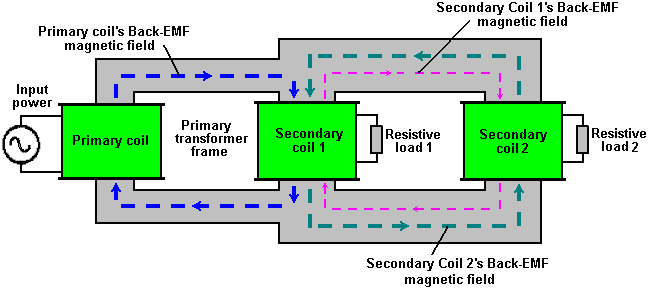 In a conventional transformer, the power flowing in the primary winding induces power in the secondary winding. When the power in the secondary winding is drawn off to do useful work, a Back-EMF magnetic flux results and that opposes the original magnetic flux, requiring additional input power to sustain the operation. In this transformer, that opposing magnetic flow is diverted through a larger magnetic frame which has a much lower resistance to magnetic flow and which, as a result, bleeds off the problem flux, sending it through secondary coil 2 in the diagram above. This pretty much isolates the input power from any opposition, resulting in a massive improvement in the operation efficiency. In the patent document, Thane quotes a prototype test which had a primary coil winding with 2.5 ohms resistance, carrying 0.29 watts of power. The secondary coil 1 had a winding with 2.9 ohms resistance, receiving 0.18 watts of power. The Resistive load 1 was 180 ohms, receiving 11.25 watts of power. The secondary coil 2 had a winding with 2.5 ohms resistance, and received 0.06 watts of power. Resistive load 2 was 1 ohm, receiving 0.02 watts of power. Overall, the input power was 0.29 watts and the output power 11.51 watts, which is a COP of 39.6 and while the document does not mention it directly, the primary coil should be driven at it's resonant frequency. A variation of this arrangement is to attach an outer toroid to the existing bi-toroid arrangement, like this:  This prototype, as you can see, is fairly simple construction, and yet, given an input power of 106.9 milliwatts, it produces an output power of 403.3 milliwatts, which is 3.77 times greater. This is something which needs to be considered carefully. Conventional science say that "there is no such thing as a free meal" and with any transformer, you will get less electrical power out of it than you put into it. Well, this simple looking construction demonstrates that this is not the case, which shows that some of the dogmatic statements made by present day scientists are completely wrong. This version of Thane's transformer is made like this: 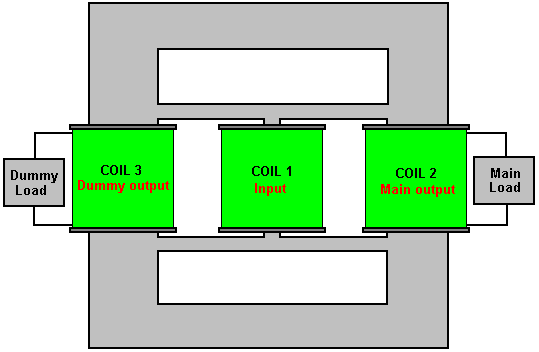 The way that off-the-shelf transformers work at the moment is like this:  When a pulse of input power is delivered to Coil 1 (called the "Primary winding"), it creates a magnetic wave which passes around the frame or "yoke" of the transformer, passing though Coil 2 (called the "Secondary winding") and back to Coil1 again as shown by the blue arrows. This magnetic pulse generates an electrical output in Coil 2, which flows through the electrical load (lighting, heating, charging, video, or whatever) providing it with the power which it needs to operate. This is all well and good but the catch is that the pulse in Coil 2 also generates a magnetic pulse, and unfortunately, it runs in the opposite direction, opposing the operation of Coil 1 and causing it to have to boost it's input power in order to overcome this backward magnetic flow:  This is what makes current scientific "experts" say that the electrical efficiency of a transformer will always be less than 100%. Thane has overcome that limitation by the simple and elegant technique of diverting that backward pulse of magnetism and channelling it through an additional magnetic path of lower resistance to magnetic flow through it. The path is arranged so that Coil 1 has no option but to send it's power through the frame as before, but the return pulse takes a much easier path which does not lead back to Coil 1 at all. This boosts the performance way past the 100% mark, and 2,300% has been achieved quite readily (COP=23). The additional path is like this:  Not shown in this diagram are the reverse pulses from Coil 3. These follow the easier outside path, opposing the unwanted back pulse from coil 2. The overall effect is that from Coil 1's point of view, the tiresome back pulses from Coil2 have suddenly disappeared, leaving Coil 1 to get on with the job of providing power without any hindrance. This simple and elegant modification of the humble transformer, converts it into a free-energy device which boosts the power used to drive it and outputs much greater power. Congratulations are due to Thane for this technique. While the brilliant dual-toroid technique of Thane Heins is very effective, it is not the only way of achieving spectacular performance from a transformer as can be seen here: The High-power Motionless Generator of Clemente Figuera Clemente Figuera of the Canary Islands died in 1908. He was a highly respected individual, an Engineer and University Professor. He was awarded several patents and was known to Nikola Tesla. Figuera’s design is very simple in outline. He has avoided the performance-killing Lenz Law magnetic feedback by splitting a transformer into three parts. Two parts form the primary winding and are shown on the left and on the right. The third part is the secondary winding which is located in the centre. Because of the splitting of the primary into two parts, Lenz’s Law has been abolished for this design, allowing a spectacular performance where the current drawn from the secondary winding has no effect on the current flowing in the two halves of the primary winding. There is also, no back-EMF as current flows continuously in both halves of the primary winding. The very clever method used by Clemente makes the strength of the current in the two halves of the primary to oscillate with one side repeatedly having first much more current and then far less current than the other half. This generates alternating current in the secondary, current which can be drawn off and used for useful work, powering lights, heaters, motors, etc. The following information comes from a man who wishes to remain anonymous. On 30th October 2012, he made the following comments about his repair to a Figuera patent which was missing some of the content. He says: I heard of Clemente Figuera for the first time from one of the Tesla articles. In 1902 the Daily Mail announced that Mr. Figueras (with an “s”), a Forestry Engineer in the Canary Islands, and for many years Professor of Physics at St. Augustine’s College, Las Palmas, had invented a generator which required no fuel. The newspaper article says that “He claims to have invented a generator which can collect the electric fluid, to be able to store it and apply it to infinite purposes, for instance, in connection with shops, railways and manufactures. He will not give the key to his invention, but declares that the only extraordinary point about it is that it has taken so long to discover a simple scientific fact. Señor Figueras has constructed a rough apparatus by which, in spite of its small size and its defects, he obtains 550 volts, which he utilises in his own house for lighting purposes and for driving a 20 horse-power motor. Señor Figueras is shortly coming to London, not with models or sketches, but with a working apparatus. His inventions comprise a generator, a motor, and a sort of governor or regulator, and the whole apparatus is so simple that a child could work it.” [Taken from “Perpetual Motion – A History of an Obsession”]. I was in one of the forums when someone mentioned Clemente Figuera and provided some links to documents referring to his work [1]. In one of the documents, I found what looks to be the only page showing sketches from one of his patents. After restoring the faint lines which show the wire connections, I was very surprised to see the similarities between the embodiment of Mr. Figuera’s drawing and one of my own for over-unity transformers. I was very eager to read any information about Figuera's work and the operation of his ‘Infinite Energy Machine’. It looks very suspicious that the pages describing the most important part of the machine have been ‘lost’. I then decided to just figure this machine out for myself.  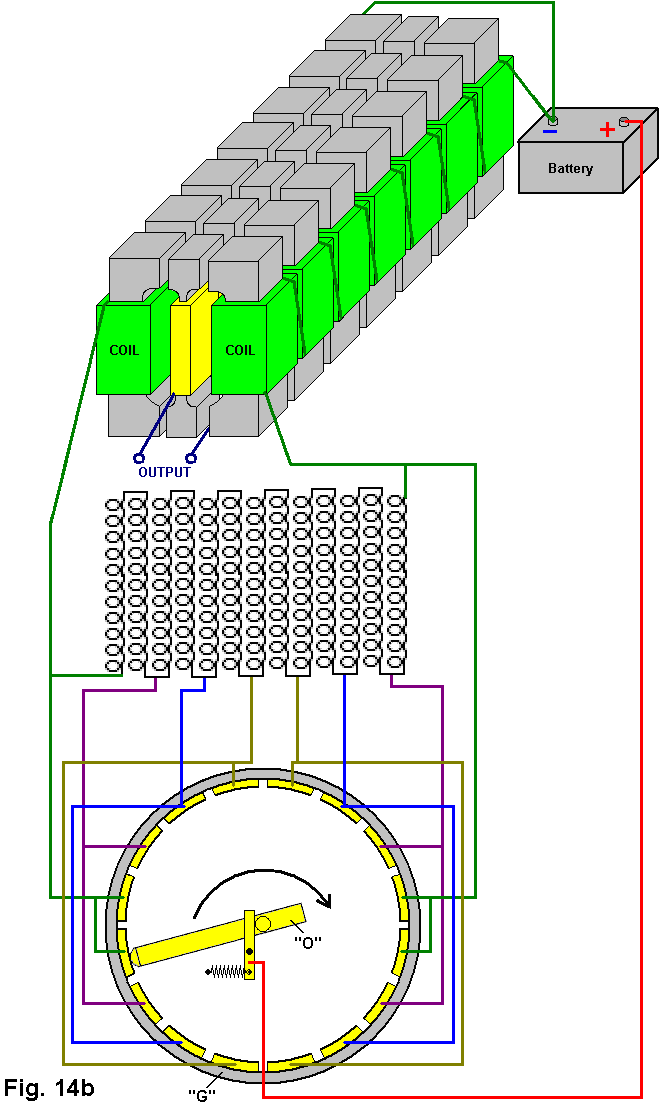 Please note that the rotating contact brush needs to be a “Make Before Break” type. That is, it needs to bridge across the gap between adjacent stator contact strips so that there is no sparking due to the current flow being interrupted. According to Mr. Figuera, an over-unity transformer can be built without permanent magnets and based on a very simple concept. Figuera’s generator consists of three rows of electromagnets, where each row is connected in series. The rows of “S” and “N” electromagnets function as the primary of the transformer, while the row of “y” electromagnets located in the centre functions the secondary. The “S” and “N” stand for South and North poles, respectively. The apparatus includes a resistor “R” having multiple taps connected to a type of distributor formed by a cylinder “G” and brush “O”. The brush “O” rotates around the cylinder “G” changing the location of the resistor taps. When the brush “O” rotates around the eight taps, it generates two stepped half-cycle sinusoids with 90° out of phase. I am proposing figure 15 to be the wiring diagram as originally disclosed by Mr. Figuera in his patents. The most significant component of the system is the arrangement of the electromagnets shown in section A-A taken from figure 14. Keep in mind that each electromagnet shown in figure 15 corresponds to a row of seven electromagnets connected in series as shown in figure 14. In addition, I would like to recommend that when building this apparatus, at least for the first implementation, try to duplicate all of the details of the machine shown in the patent. For example, figure 14 shows the top area of the “S” and “N” electromagnets approximately equal to twice the top area of the “y” electromagnets, etc. 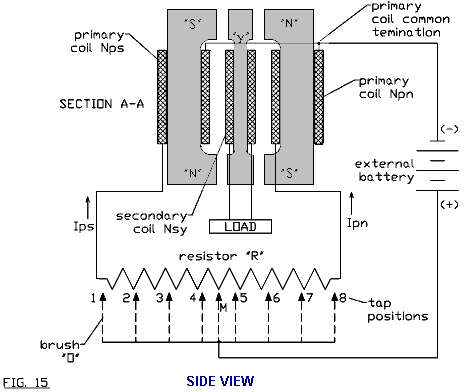 Even though Mr. Figuera used stepped sinusoidal currents Ips and Ipn, I considered the resistor in figure 15 to be a linear variable resistor having infinite taps and the voltage and current generated to be pure half-cycle sinusoids with 90° out of phase. The coils of the “S” and “N” electromagnets are tied together and connected to the negative potential of the external battery. The other terminals of the electromagnets are connected to both ends of the resistor “R”. The bush “O” is connected to the positive potential of the external battery and is continuously moving repeatedly from left to right and then back from right to left. The position of the brush “O” determines the magnitude of the DC currents Ips and Ipn passing through the primary coils “S” and “N”. For instance, when the brush is in position 1, the “S” coils see the full potential of the external battery corresponding to a maximum current Ips and magnetic field Bps, while at the same time, the current Ipn and magnetic field Bpn of the “N” coils are minimum because they are connected to the external battery through the maximum value of the resistor “R”. Figure 21 shows the voltage, current, and magnetic field waveforms flowing through these coils. The voltage induced in the secondary coils “y” is a sinusoidal alternating voltage. The secondary voltage should be zero when the magnitudes of the currents Ips and Ipn are equal. At this point, the magnetic field Bps and Bpn induce two voltages of the same magnitude and opposite polarity. 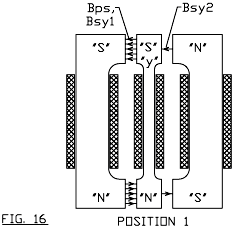 The magnetic interaction of “S”, “N”, and “y” electromagnets are shown in figures 16 through 20. Figure 16 illustrates the scenario when the brush “O” is at position 1. As previously stated, when the brush is at position 1 the current Ips and magnetic field Bps are maximum, while the current Ipn and magnetic field Bpn have a minimum value. When the secondary current Isy starts flowing, the “y” coils generate a magnetic field Bsy that opposes Bps in accordance with Lenz’s law. As a consequence, a south pole is created at the top of the “y” electromagnet and a north pole at the bottom. Because magnets of the same polarity repel and opposite polarities attract, it is likely that some of the induced magnetic field Bsy2 is diverted through the iron core of the “N” electromagnet, which represents a lower reluctance path. And, if the induced magnetic field Bsy can be rerouted to not oppose the magnetic field Bps that generates it, then, it might be possible to have an over-unity transformer.  Figure 17 illustrates the scenario to be expected when the brush is at position 3. The primary current Ips and primary magnetic field Bps are decreasing in magnitude while the magnitude of the primary current Ipn and magnetic field Bpn are increasing. The primary current Ips (and Bps) is still larger than primary current Ipn (and Bpn). As shown in the figure, part of the induced magnetic field Bsy2 is still coupled with the “N” electromagnets. 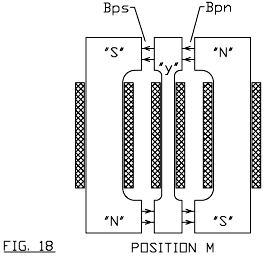 Figure 18 illustrates the scenario when the brush is at position M. This position is exactly at the centre of the resistor “R” and both currents Ips and Ipn are of equal magnitudes, and as a result, the magnetic field Bps and Bpn are also equal. The net voltage Vsy, current Isy, and magnetic field Bsy induced in the secondary coils “y” are all zero. 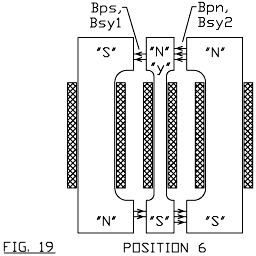 Figure 19 illustrates the scenario when the brush is at position 6. The primary current Ips and primary magnetic field Bps are still decreasing in magnitude while the magnitude of the primary current Ipn and magnetic field Bpn are increasing. The primary current Ips (and Bps) is now of lower magnitude than primary current Ipn (and Bpn). Because the magnetic field Bpn of the “N” electromagnets is stronger than the magnetic field Bps of the “S” electromagnets, the polarity of the induced voltage Vsy, current Isy, and magnetic field Bsy are reverse in accordance with Lenz’s law. In this situation, the secondary electromagnets “y” present the north poles at the top and the south poles at the bottom making the “y” and “N” electromagnets to repel and the “y” and “S” to attract. Because of the now higher reluctance of the “N” electromagnets and lower reluctance of the “S” electromagnets, it is expected that part of the induced magnetic field Bsy will coupled with the “S” electromagnets, and therefore, the effect of the Lenz’s law is minimised. 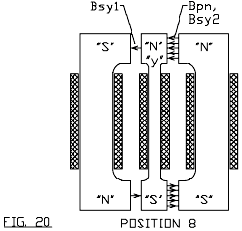 Figure 20 illustrates the scenario when the brush “O” is at position 8. The primary current Ipn and the magnetic field Bpn have maximum values. The induced secondary voltage Vsy, current Isy, and magnetic field Bsy are also maximum and of opposite polarities than the scenario corresponding for position 1. Again, part of the induced secondary magnetic field Bsy is attracted by the “S” electromagnet mitigating the effect of the Lenz’s law. References: [1] http://orbo.es www.bibliotecapleyades.net/tesla http://www.alpoma.net/tecob/?page_id=8258 Our thanks are due to the anonymous contributor who produced the above information on the work of Clemente Figuera whom I had never heard of before. Recently, the forum member ‘hanlon1492’ of the overunity.com forum has shared a translation of Figuera’s complete 1908 patent, lodged just days before he died, and it is reproduced here with thanks to ‘hanlon1492’ for his work and for freely sharing the results: Ministry of Development General Board of Agriculture, Industry and Commerce. Patents of Invention. Expired. Dossier number 44267. Instruction at the request of D. Clemente Figuera. Representative Mr. Buforn. Presented in the register of the Ministry in the 31st October 1908, at 11:55 received in the negotiated in the 2nd November 1908. BACKGROUND If we rotate a closed circuit inside a spinning magnetic field, with the closed circuit positioned at right angles to the lines of magnetic force, a current will be induced in the closed circuit for as long as there is movement, and the sign of that induced current will depend on the direction in which the closed circuit moves. This is the basis of all magnetic machines and electric dynamos from the original, invented by Pixii, in France and later modified and improved by Clarke to reach the design of the current dynamos of today. The principle on which this theory is based, has the unavoidable need for the movement of either the induction circuit or the magnetic circuit, and so, these machines are considered to be a transformer of mechanical work into electricity. PRINCIPLE OF THE INVENTION Considering carefully what happens in a dynamo in motion, we see that the coil turns of the induction circuit approach and move away from the magnetic centres of the magnets or electromagnets, and those turns, while spinning, pass through sections of the magnetic field of different magnetic strengths, because, while the maximum magnetic strength is in the centre of the core of each electromagnet, this action weakens as the induction coil moves away from the centre of the electromagnet, only to increase again when it is approaching the centre of another electromagnet with opposite sign to the first one. Because we all know that the effects seen when a closed circuit approaches and moves away from a magnetic centre are the same as when the circuit is motionless and the magnetic field increased and decreased in intensity, since any variation of the magnetic flow traversing a circuit produces an induced electrical current. Then, consideration was given to the possibility of building a machine which would work, based, not on the principle of movement as current dynamos do, but based on the principle of increasing and decreasing the strength of the magnetic field, or the strength of the electrical current which produces it. The voltage from the total current of the current dynamos is the sum of all of the induced currents generated in every turn of the induction coils. Therefore it does not matter if these induced currents were generated by rotating the induction coils, or by varying the magnetic flux which passes through them. In the first case, a greater amount of mechanical work is required than the amount of electricity generated, while in the second case, the force needed to produce the variation of magnetic flux is so insignificant that it can easily be taken from the output generated by the machine. Up to the present day, no machine based on this principle has been constructed for the production of large electrical currents, and which among other advantages, has overcome the necessity for motion and so, the energy needed to produce it. In order to attain the production of large industrial electrical currents, using the principle that electrical current can be provided by just changing the flow of magnetic flux through an induction circuit, the above disclosure should be sufficient, however, as this operating principle needs to embodied in a practical machine, there is a need to describe it in order to fully disclose how to carry out a practical application of this principle. This principle is not new since it is just a consequence of the laws of induction stated by Faraday in the year 1831: what it is new and claimed in this patent, is the application of this principle to a machine which produces large industrial electrical currents and which, up to now, has only been obtained by transforming mechanical work into electricity. We will therefore, provide a description of a machine based on the above principle disclosed in this patent; but it must be understood, and what is sought is the patent for the application of this principle, that all machines built based on this principle, will be included in the scope of this patent, whatever the form and way that has been used to make the application. DESCRIPTION OF GENERATOR OF VARIABLE EXCITATION “FIGUERA” The machine is comprised of a fixed inductor circuit, consisting of several electromagnets with soft iron cores enhancing induction in the induction circuit, which is also fixed in position and motionless, and which is composed of several coils, accurately positioned. As neither of the two circuits spin, there is no need to make them round, nor leave any space between one and the other. Here what it is constantly changing is the intensity of the excitatory current which drives the electromagnets and this is accomplished using a resistance, through which circulates a operating current, which is taken from one power source and passed through one or more electromagnets, thus magnetising one or more electromagnets. When the current is higher, the magnetisation of the electromagnets is increased, and when it is lower, the magnetisation is decreased. Thus, varying the intensity of the current, varies the magnetic field which crosses through the induction circuit. To assist in understanding this idea, it is convenient to refer to the attached drawing which is no more than a sketch intended to assist in understanding the operation of the machine built to implement the principle outlined above. 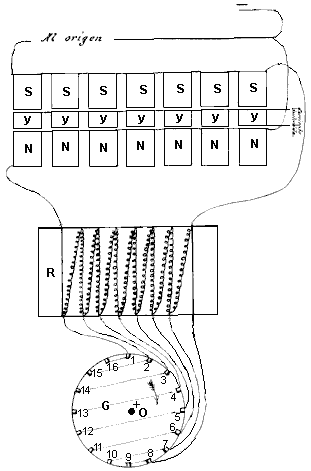 Suppose that electromagnets are represented by rectangles marked ‘N’ and ‘S’. Located between their poles is an induction circuit represented by the line of small rectangles marked ‘y’. A resistor ‘R’, drawn here in a simple form to help understanding of the entire system. Shown as ‘+’ and ‘-‘, is the excitation power, drawn from an external source. As can be seen in the drawing, the different sections of this resistor connect with the commutator bars embedded in a stationary cylinder of insulating material. A sliding-contact brush ‘O’, which always connects with more than one contact, rotates, carrying the excitation current. One of the ends of the resistor is connected to the electromagnets N, and the other end of the resistor is connected to the electromagnets S. Half of the terminals of the resistor go to half of the commutator bars of the cylinder. The other half of these commutator bars are connected directly to the first set of commutator bars. The operation of the machine is as follows: the brush O rotates inside cylinder G and is always in contact with two of the commutator bars. When the brush is touching contact 1 the current, flowing from the external source passes through the brush and powers electromagnets N to their maximum level of magnetisation, but the current passing through electromagnets S is insufficient to magnetise them because the whole of resistance R is too great to allow sufficient current to magnetise them. Therefore, the N electromagnets are fully powered while the S electromagnets are not sufficiently powered to be magnetised. When the brush connects with contact 2, the whole of the current will not flow through electromagnets N because it has to pass through part of the resistor. Consequently, some current will pass through the electromagnets S because it has to overcome less resistance than in the previous case. This same reasoning applies to the case when brush O connects with each of the different contacts around the first semicircle. Then the brush O starts to connect with the commutator contacts in the other half, each of which are directly connected to their corresponding commutator contacts in the first half. In short, the resistor has the function of a current-splitter, powering either one set of electromagnets or the other set of electromagnets repeatedly. It can be seen that electromagnet sets N and S operate in a complementary manner, because while the first set is being progressively powered up, the other set is being progressively powered down. This sequence is repeated continuously causing an orderly a constant variation of the magnetic fields passing through the induction circuit. This action can be maintained by just the simple rotation of a brush or group of brushes which rotate in a circle inside cylinder G driven by a small electric motor. As indicated by the drawing the current, once it has flowed through the electromagnets, returns to the power source where it originated. A small part of the output current from this device can be used to provide the ‘external’ excitation power mentioned above, thus making the machine self-exciting and to provide the current to operate the small motor which moves the brush causing the switching. Once started with an external power source, that external power source can be removed and the machine will continue to work indefinitely without any external power source. This invention is really new, very daring, and above all, has huge technical and industrial consequences in all areas. This patent was not applied for until a working machine based on these principles had been built, thus proving the concept to be sound and practical. ADVANTAGES OF THE ELECTRICAL GENERATOR “FIGUERA” 1. The completely free production of DC or AC electric current of any voltage which can be used for: a. Providing a driving force. b. Production of light. c. Production of heat. d. All other existing uses of electricity. 2. There is no need whatsoever for a driving force of any kind or chemical reactions or fuel consumption. 3. Needs little or no lubrication. 4. Is so simple that it can be easily operated by anyone. 5. Does not produce smoke, noise, or vibration when operating. 6. Indefinite operational life. 7. Has a wide range of uses: home management and industrial. 8. Easy construction. 9. Cheap to produce and market NOTE: A 20-year patent is requested for a “NEW GENERATOR OF ELECTRICITY, so-called “FIGUERA” of variable excitation, designed to produce electrical currents for industrial applications without using either driving force, nor chemical reactions. The machine is essentially characterised by two series of electromagnets which form the inductor circuit, between whose poles induction coils are placed. Both the induction and inductor circuits remain motionless and yet are able to produce a current induced by the constant variation of the intensity of the magnetic field forcing the excitatory current (coming at first from any external source) to pass through a rotating brush which, in its rotation movement, connects with the commutator bars or contacts of a ring distributor or cylinder whose contacts are connected to a resistor whose value varies from a maximum to a minimum and vice versa, according with the commutator bars of the cylinder which operates, and for that reason the resistance is connected to the electromagnets N by one of its side, and the electromagnets S at the other side, in such a way that the excitatory current will be magnetising successively with more or less strength, the first electromagnets, while, simultaneously decreasing or increasing the magnetisation in the second set, determining these variations in intensity of the magnetic field, the production of the current in the induced, current that we can use for any work for the most part, and of which only one small fraction is derived for the actuation of a small electrical motor which rotates the brush, and another fraction goes to the continuous excitation of the electromagnets, and, therefore, converting the machine to become self-exciting, being able to remove the external power which was used initially to excite the electromagnets. Once the machinery is in motion, no new force is required and the machine will continue in operation indefinitely. All in accordance with the described and detailed in this report and as represented in the drawings which are attached. Barcelona, the 30th of October, 1908. Signed: Constantino de Buforn. There are some practical points which have not been included so far and which need to be mentioned. The Figuera patent shows the electromagnets as just rectangles, and while C-shaped electromagnet cores have been indicated and discussed, there is a distinct possibility that the electromagnet cores are just I-shaped or even a short cylinder which is several times wider than it is tall. These more simple shapes could make it very much easier to construct, although the C-shaped core need only be three straight sections placed together. It is essential to construct each of the cores of the electromagnets from iron and only iron. While a laminated core does minimise eddy currents, in this application, a laminated core has a major negative magnetic effect (something which is not generally known). 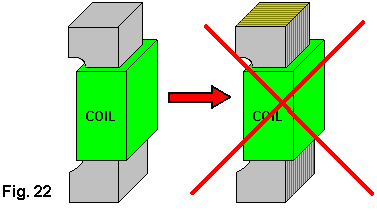 I have to agree wholeheartedly with the anonymous contributor when he recommends that any attempted replications stay as close to the arrangement shown in the patent drawing, and have seven separate sets of three electromagnets. However, for subsequent experiments, a somewhat easier construction with just one set of electromagnets might be tried, making the electromagents equal in length to the seven separate units: 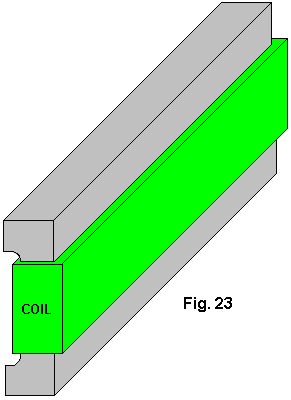 This arrangement has advantages if the design is taken on into manufacturing as less costruction is needed. Figure 15 shows two electromagnets connected at the top to the battery Minus and at the bottom to the battery Plus. But, one is marked with a North pole at the top and the other with a South pole at the top, so perhaps some explanation would be helpful. If the coils are connected that way, then one will have to be wound in a clockwise (“CW”) direction and the other in a counter-clockwise (“CCW”) direction:  Or the alternative is to have all of the electromagnets wound in the same way, and adjust the connections: 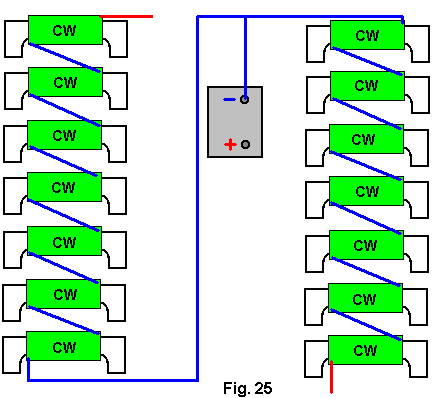 The Figuera design was implemented more than a hundred years ago, and so Clemente did not have any semiconductors available to him, and so he used a motor-driven commutator arrangement to produce the electrical switching which he needed. While I am in no way opposed to mechanical switching, especially where prototypes are concerned, there has to be an advantage in using solid-state switching, and while I am by no means an expert in that field, the following suggestions might be useful for experienced circuit builders. In spite of the wire-wound resistor bank having only eight connection points, the switching has to have sixteen outputs due to the backwards and forwards switching sequence which is used. A solid-state 16-way switching module can be constructed from two CD4017 Divide-by-Ten integrated circuits like this: 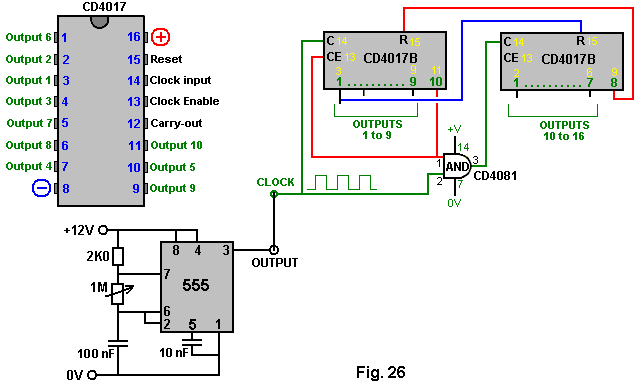 This arrangement gives sixteen outputs in sequence, so two outputs need to be connected together in order to match the mechanical switching which Clemente used. Presumably, it would not be advisable to connect two outputs directly together, and so an isolation diode (say, a 1N4148 type) would be required on each output. Please note that the pin connections shown here have been revised as it appears that in this circuit, the output pin 3 of the second 4017 chip does not function as expected: 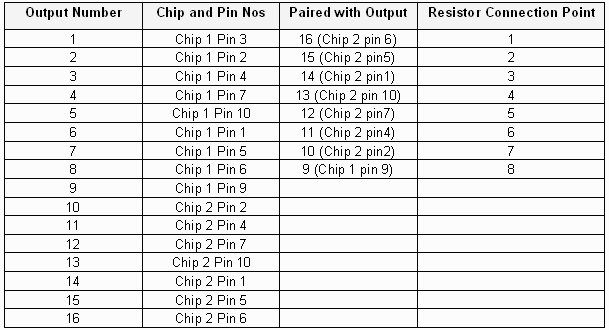 Eight power transistors can be used to energise each resistor connection point in the sequence required. As mechanical switching was used by Clemente, it really did not matter which way round the battery connections were made. We can match his switching exactly by using PNP power transistors (or possibly, P-channel FETs) which would make the arrangement like this (with just two of the eight connections being shown): 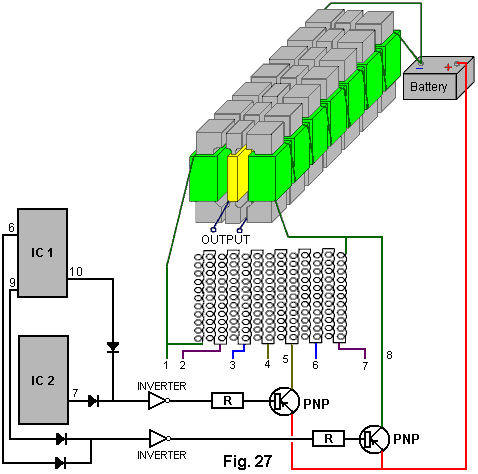 Or reverse the battery for the easier NPN option: 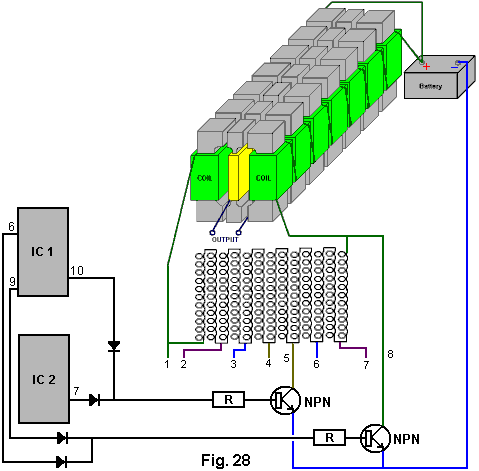 I have been asked by an electronics novice to show a possible construction form for this sort of circuit. I am not particularly good at that sort of thing, but here are a couple of diagrams of a non-optimised layout for a standard size of common stripboard: 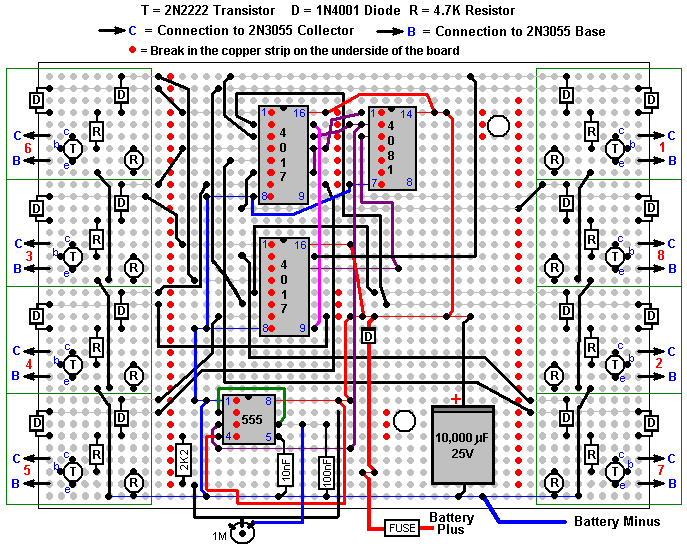 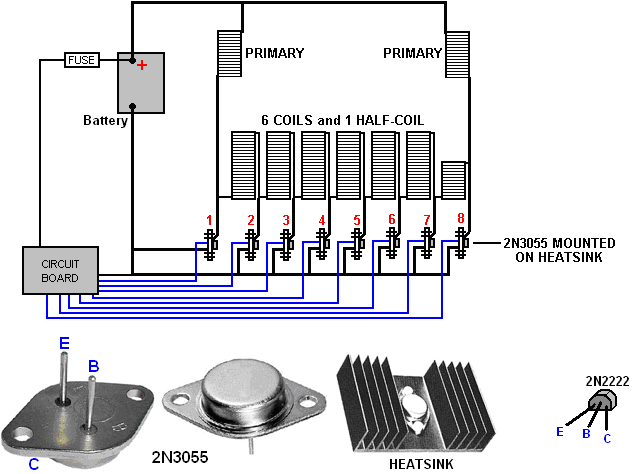 Experienced experimenter ‘Woopy’ has posted a video of a quick experiment to test the working principle of this Figuera design. It is here and in it, he short-circuits the secondary winding, showing that the input power is totally unaffected by the current draw from the secondary. He shows some very interesting oscilloscope shots:  The first screen shot surprises me as it shows clearly that the output is actually an excellent square wave while I would have expected it to be a sinewave as it is coming from a coil which has inductance. The second shot shows very clearly, how the two banks of primary electromagnets operate out of phase with each other thanks to Woopy’s mechanical 6-way switching arrangement. It is reported that Mr Figuera ran a 20-horsepower motor with his prototype and if that motor were fully loaded, then that is 15 kilowatts of power, easily enough to power a household. Please bear in mind that if the electromagnets are made from iron, whether laminated or not, that iron restricts the frequency, probably to 500 Hz or less, and so it is necessary to keep the frequency that low if using a solid-state circuit to drive the transformer. For 60 Hz output with mechanical switching, requires the motor to run at 3,600 rpm which is fairly fast although definitely achievable. Also, the output power will be limited by the current handling capacity of the wire in the secondary winding. The first page of the Appendix shows the current capacities for the standard AWG and swg wire sizes. Because this Figuera design is so important, being low-voltage, high power and not needing tuning I have recently been asked to explain it in greater detail and suggest some component values for people starting to experiment with it. I am not an electronics expert, and so my suggestions need to be taken as just that, namely, suggestions for a possible starting point for experimentation. The first point is that the two halves of the primary winding of the transformer become electromagnets when current flows through their windings. The strength of an electromagnet increases as the current flow increases. Large current: strong magnet. Small current: weak magnet. Clemente Figuera’s circuit is arranged so that the current through the windings is made to vary so that when one magnet is strong, the other one is weak. It works like this: 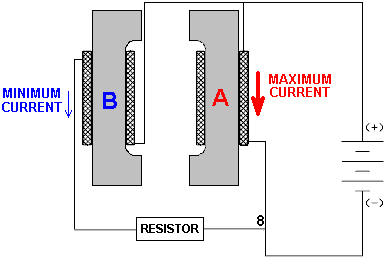 When the mechanical (or transistor) switching connects the battery to point ‘8’ in the previous diagrams, we get the situation shown above. Current from the battery flows directly through the right-hand electromagnet “A”, making it the strongest magnet that it can be. The electromagnet “B” on the left gets current flow from the battery all right, but that current is reduced because it has to flow through the resistor. When the switching changes and the battery is connected to point “1” in the previous diagrams, we get this arrangement: 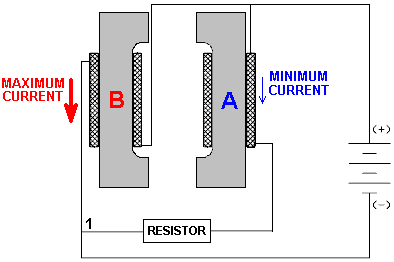 Here, electromagnet “B” is free of the resistor and gets it’s maximum possible current, making it the strongest magnet which it can be, while electromagnet “A” has it’s current reduced by the resistor getting in the way, making it the weakest magnet it can be when the system is running. If we switched between these two positions, we would get a square wave style of operation, but Clemente did not do that. Instead, he split the resistor into seven parts (if Fig.14 is drawn correctly, one part having only half the resistance of the other parts). This makes the arrangement like this: 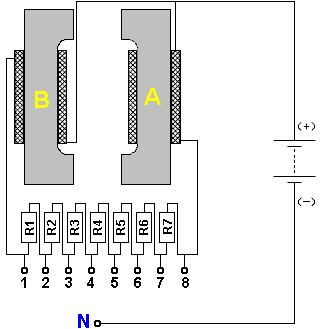 When the battery negative “N” is connected to point “2”, then the current flow through electromagnet “B” is hindered by resistor R1, but the current flow through electromagnet “A” is hindered by resistors R2 and R3 and R4 and R5 and R6 and R7, which together, have a far higher resistance than R1 on its own. This makes the current flow through electromagnet “B” far greater than the current flow through electromagnet “A”. When the battery negative “N” is connected to point “3”, then the current flow through electromagnet “B” is hindered by resistor R1 and resistor R2, but the current flow through electromagnet “A” is hindered by resistors R3 and R4 and R5 and R6 and R7, which together, have a far higher resistance than resistors R1 and R2. This makes the current flow through electromagnet “B” still greater than the current flow through electromagnet “A”. When the battery negative “N” is connected to point “4”, then the current flow through electromagnet “B” is hindered by resistors R1, R2 and R3, and the current flow through electromagnet “A” is hindered by resistors R4, R5, R6 and R7, which together, have a higher resistance than resistors R1, R2 and R3. This makes the current flow through electromagnet “B” somewhat greater than the current flow through electromagnet “A” (nearly a balanced flow as resistor R7 is only half the value of each of the other resistors. When the battery negative “N” is connected to point “5”, then the current flow through electromagnet “B” is hindered by resistors R1, R2, R3 and R4, while the current flow through electromagnet “A” is hindered by resistors R5, R6 and R7, which together, now have a lower resistance than resistors R1, R2, R3 and R4. This makes the current flow through electromagnet “B” somewhat less than the current flow through electromagnet “A”. When the battery negative “N” is connected to point “6”, then the current flow through electromagnet “B” is hindered by resistors R1, R2, R3, R4 and R5, while the current flow through electromagnet “A” is hindered by resistors R6 and R7, which together, now have a much lower resistance than resistors R1, R2, R3, R4 and R5. This makes the current flow through electromagnet “B” much less than the current flow through electromagnet “A”. When the battery negative “N” is connected to point “7”, then the current flow through electromagnet “B” is hindered by resistors R1, R2, R3, R4, R5 and R6, while the current flow through electromagnet “A” is hindered by resistor R7, which has a very much lower resistance than resistors R1, R2, R3, R4, R5 and R6 together. This makes the current flow through electromagnet “B” very much less than the current flow through electromagnet “A”. Clemente has arranged the battery switching sequence to be to points 1, 2, 3, 4, 5, 6, 7, 8, 8, 7, 6, 5, 4, 3, 2, 1, repeating over and over again. This makes the connections to points 1 and 8 to be twice as long compared to the connection times for the intermediate points, giving a sine-wave shape rather than a sawtooth shape. There is current flow through both electromagnets at all times. The current flow is never broken although, as you can see, the intensity of the current flow varies all the time with each electromagnet getting stronger than the other one repeatedly. The mechanical switching used by Clemente will work perfectly well, although there will be motor noise and wear on the switch contacts. A solid state version will be silent, more reliable and much longer lasting. There are many different way to build most electronic circuits and each builder will have his own favourite way of constructing the circuit. This Figuera circuit does not specify the battery voltage and so some people will want to use a twelve volt battery. As many FET transistors need as much as ten volts in order to switch on properly, a twelve volt supply is probably a little low for them, and so I suggest using the older bipolar transistors. As the transistor has to carry the current which passes through the electromagnets, it needs to be able to handle considerable current flow. The very common 2N3055 transistor can do that (as can many other suitable transistors). The switching rate is very, very slow for a transistor and so speed is not an issue. The voltage is very low, and so that is not an issue either and so the 2N3055 transistor is definitely a possible choice. In common with most high-power transistors, the current gain is low being between 20 and 30 typically. That means that to switch it on properly, a current of one twentieth of the switched current has to be fed into the base of the transistor. That base current is too high to be convenient, so we can raise the transistor gain to around 6000 by adding in a low-power transistor such as the 2N2222 transistor. The two transistors are connected together in a configuration called a ‘Darlington Pair’ which looks like this: 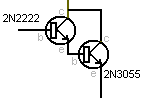 In this arrangement, the two Collectors are connected together, while the Emitter of the 2N2222 transistor feeds into the Base of the 2N3055 power transistor. With a high gain of six thousand or so for our transistor pair, we need to limit the current flowing through their combined Base-to-Emitter junction, and so we introduce a current limiting resistor R8 in the following circuit suggestion: 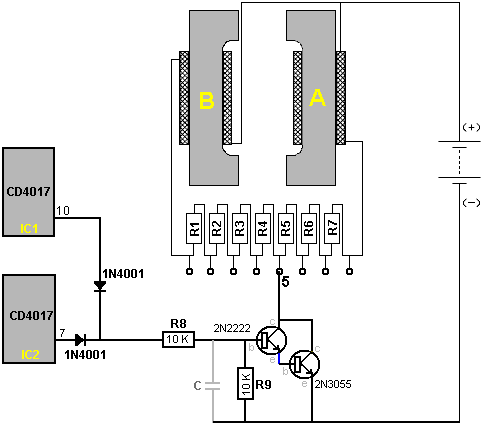 The 10K resistor value shown would limit the transistor current to about nine amps, while a 4.7K resistor would allow around eighteen amps. Each transistor pair is only on for one eighth of the time, but the 2N3055 transistors need to be mounted on a heat-sink. If a single metal plate is used as a heat-sink for all eight 2N3055 transistors, then mica washers (available from the supplier of the transistors) must be used between each transistor and the plate because the Collector of each 2N3055 transistor is it’s metal case and in this circuit, the Collectors do not connect to a common point. The mica washers pass heat but not electricity. Separate heat-sinks can, of course, be used. The capacitor “C” in the above circuit diagram will probably not be needed. The switching needs to maintain a constant current flow through both electromagnets. I would expect the 4017 chip switching to be fast enough to allow this to happen. If that proves not to be the case, then a small capacitor (probably 100nF or less) can delay the switch-off of the transistors just long enough to allow the next transistor in the sequence to be switched on to provide the required ‘Make-Before-Break’ switching. As indicated in the table above, the 4017 pins which feed the transistor pairs through the 1N4001 (or similar) diodes are: IC1 pin 3 and IC2 pin 6 for resistor connection point 1. IC1 pin 2 and IC2 pin 5 for resistor connection point 2. IC1 pin 4 and IC2 pin 1 for resistor connection point 3. IC1 pin 7 and IC2 pin 10 for resistor connection point 4. IC1 pin 10 and IC2 pin 7 for resistor connection point 5. IC1 pin 1 and IC2 pin 4 for resistor connection point 6. IC1 pin 5 and IC2 pin 2 for resistor connection point 7. IC1 pin 6 and IC1 pin 9 for resistor connection point 8. This Figuera design is very attractive as it uses only simple, readily available materials, low voltage and does not require difficult tuning. It also has the potential to be self-powered if part of the output is used to provide a voltage-stabilised power supply for the input power and the remaining output power can be kilowatts if the wire diameters chosen can carry that much current. Chapter 12 explains electronic circuitry in more detail. A contributor who wishes to remain anonymous does not like the circuit arrangement shown above and prefers this circuit which he has built and tested:  The NPN Darlington transistor BDX53 in this circuit is not available everywhere around the world and if that is the situation in your area, then using a 2N2222 transistor feeding a 2N3055 (or TIP3055) transistor as shown originally will work just the same. The Alexkor Zero-Back-EMF Coils Alex in Russia who has shared several of his motionless pulse-charging systems for batteries, now shares his design which does not appear to have any back-EMF effect on the primary coil. If that is the case, then any increase in output current draw does not have a corresponding increase in the current flowing through the primary coil. That is completely different to the way in which a conventional transformer operates. The arrangement is somewhat like the Transmitter / Receiver arrangement of Don Smith and while it looks to be a simple arrangement, is isn’t. Alex draws his coil configuration like this: 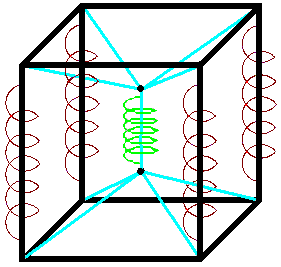 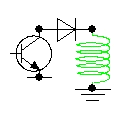 Here, his chosen form of construction is a frame of twelve lengths of 20 mm diameter plastic pipes – four at the top, four at the bottom and four verticals. Each pipe is filled with ferrite powder and there is an output coil wound on each of the four vertical pipes. Suspended in the centre is the primary coil which is 15 mm in diameter. All five coils are wound using 0.5 mm diameter enamelled copper wire (swg 25 or AWG #24). While Alex’s drawing shows a single strand of wire, the actual arrangement for the four output coils is that they are wound as a single layer bi-filar coil: 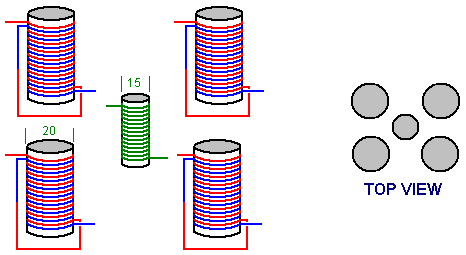 For this, the output coils are wound with two strands of wire side by side, in a single layer along the length of the plastic pipe. Then, the start of one wire is connected to the end of the other wire. As the coils are filled with ferrite, they can operate at high frequency, when the 15 mm primary coil is fed with either DC pulses or an AC sine wave. Each output coil can provide a separate output or the output coils can be connected in series to give a higher voltage or connected in parallel to give a higher output current. Alex also shows how ferrite toroids can be used, even with 220V mains, to give back-EMF-free transformer operation. If the input frequency is as low as the mains, then the toroids may be iron-dust types or they can be constructed from iron shims in the same way that ordinary mains transformers are constructed. However, please understand clearly that the current flowing through any coil connected across a high voltage source such as 110V or 220V and using any of the following configurations, is limited by the impedance of the coil itself. ‘Impedance’ is effectively ‘AC resistance’ at the frequency of the AC voltage supply. If the coil impedance is low, then the current flowing through the coil will be high and since the power dissipated by the current flow is Voltage x Current, the power dissipation with increased current goes up very quickly when the voltage level is as high as 220 volts. The power dissipation is in the form of heat which means that with excessive power dissipation, the wire in the coil is liable to melt or ‘burn out’ in an impressive flash of flame, smoke and blackened wire. Consequently, the coil winding needs to have many turns and the wire diameter needs to be sufficient to carry the current flow – the wire table on page 1 of the Appendix shows the current which can be carried by each size of wire when wound into a coil. If there is no back-EMF effect with the following configurations, then the current in the primary winding connected across the mains will not be affected by the other coils, so remember that when preparing the primary coil. The first arrangement uses three toroids to give four separate outputs. The amount of current which can be drawn from any secondary depends on the amount of magnetic flux which can be carried by the magnetic core or cores between the primary coil and that particular secondary coil. Obviously, the output current draw will also be limited by the current-carrying capacity of the wire used in the secondary coil. If that level of current is exceeded for any length of time, then the insulation of the wire will fail, turns will short-circuit together, the coil impedance will drop, the current increase further and the coil will burn out – so, common sense is called for  Here, the primary coil “1” is wound on a toroid which is horizontal in the picture above, and the secondary coils “2” are wound on toroids which are shown as vertical in the drawing. The important point here is that the toroids with the secondary coils, touch the primary coil toroid at right angles, that is, at 90-degrees. For convenience of winding the coils, any toroid can be assembled from two half toroids which allows the coil to be wound separately and when completed, slid on to one of the C-shaped half toroids before the two halves are placed together to form the complete toroid. The second arrangement uses three toroids: 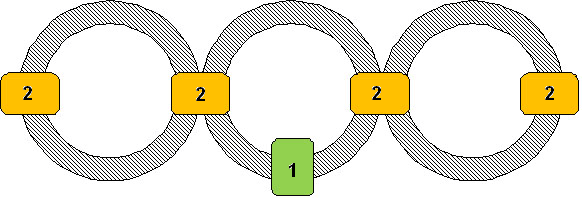 The third arrangement uses four toroids in a more powerful arrangement where the magnetic flux carrying capacity of the transformer is doubled as the cross sectional area of the toroids inside each coil is doubled. This is a more difficult arrangement to construct and if the coils are to be wound on a separate coil winder, then the toroids each need to be made from one half-toroid plus two quarter toroids so that the coils can be slipped on to two separate quarter-toroid sections which are curving in opposite directions, unless of course, the inside diameter of the coils is a good deal larger than the toroid cross section (which reduces the number of turns for any given length of coil wire): 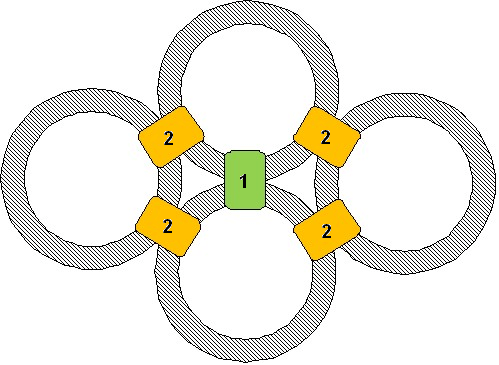 If these simple transformer arrangements operate as back-EMF-free devices as claimed, then the current draw from any, or all, of the secondary windings does not have any effect on the current flowing through the primary coil. This is quite unlike present day commercial transformers which are wound symmetrically, which in turn causes the current draw in the secondary coil to force an increased current in the primary winding. Alex (www.radiant4you.net) also shows another arrangement which uses seven toroids. He states that this arrangement is also free from the energy-wasting back-EMF designs used at present in most commercial items of equipment. He specifies that the intended operating frequency is 50 Hz which is the frequency of the mains as the difference between 50 Hz and the 60 Hz used in America is not significant in any way. This frequency suggests that the toroids could readily be made of iron as in commercial transformers. The prototype was wound with 0.5 mm diameter wire and aimed at a power level of 100 watts. The capacitors are high-power oil filled with capacitances up to 40 microfarad and rated at 450V when using 220V mains input. The tuning is very much like that of the RotoVerter shown in chapter 2. The physical layout is: 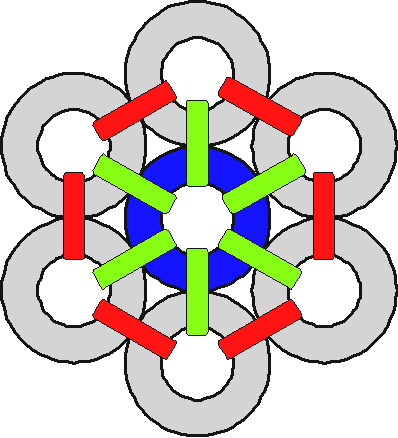 The central toroid is wound all around its circumference as indicated by the blue colour. This winding is fed directly with the input current source which would normally be from the mains or from a mains transformer, probably at a lower voltage. There are then twelve output coils, six shown here in green and six shown in red. For best operation, each of these output coils need to be ‘tuned’ to the central coil and that needs to be done by altering the capacitor size by experiment to get the best performance from each coil. When properly set up, increasing the current draw from any of the output coils does not increase the power flowing into the central input coil. This contradicts what is normally taught in schools and universities as they are only familiar with symmetrically wound transformers and motors where increased output current does indeed oppose the input power, causing increased input current and heat waste. The circuit is: 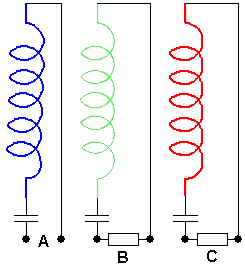 The blue coil has the power input at “A” and the capacitor in series with each coil is there to get all of the windings to resonate at the same frequency. The items “B” and “C” represent the useful load being powered by each coil, although, obviously, only two of the twelve output coils are shown in the circuit diagram above, and there are an additional five green and five red coils which are not shown in the circuit diagram. 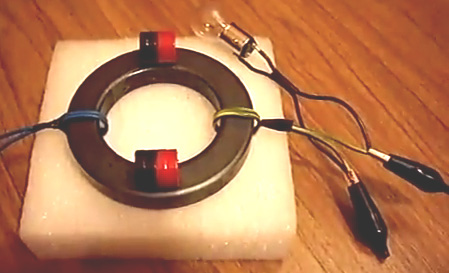 It is probably worth remembering that adding a magnet to a toroid or closed-loop core transformer can boost the output provided that the permanent magnet is not strong enough to saturate the core completely and prevent oscillation of the magnetic flux. This has been shown by Lawrence Tseung, Graham Gunderson and others, and so it might be worth while to experiment further with these configurations along the lines shown in the video here.   The Self-Powered Generators of Barbosa and Leal In July 2013, two Brazilian men, Nilson Barbosa and Cleriston Leal, published a series of patents which appear to be very significant. Their patent WO 2013/104042 published on 18th July 2013, is entitled “Electromagnetic device for Capturing Electrons from the Ground to Generate Electricity” and has some very interesting features. It describes a simple device which they describe as an “electron trap”. Their patents are written in Portuguese and an attempted translation of three of them is included at the end of the Appendix. An unusual feature of this design is the fact that it has a continuous conductive loop, in which it is claimed, current flows continuously, even without the need for an applied voltage. Instead, it is the magnetic fields of electromagnets which keep the current flowing. They state that an insignificant amount of input power produces a substantial power output, and they consider a COP of 100 to be about the minimum performance which can be expected from the design. That is a 1 watt input for a 100 watt output. One version of the electron trap looks like this: 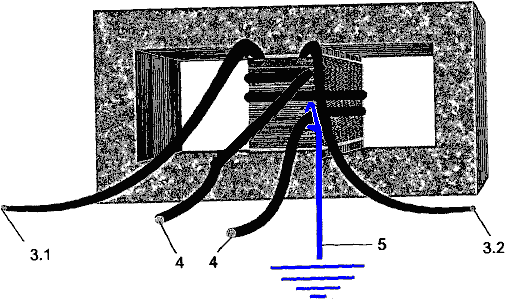 The inventors describe their device like this: “this electromagnetic-field-generating device, powered by a power source, produces an electromagnetic field which induces an electric current in a closed conductive circuit, creating an interaction between the magnetic poles of the equipment and the magnetic poles of the earth - through both electromagnetic attraction and repulsion. An endless supply of electrons is drawn from the earth into the conductive closed loop, which is connected to the ground through a conductive interconnected grid. The attracted electrons add to the current already flowing in the conductive closed loop, making power available for driving high-power loads, although the device itself is supplied with only a small amount of power.” One very interesting feature is that the continuous-loop coil formed by wire 4 in the diagram above, is literally, only two turns of wire. The power-gaining mechanism, amazingly, is the earth wire (shown in blue) which is merely wrapped around wire 4 and not directly connected to it as the electron-transfer link is by induction. With this arrangement, the current circulating in the closed loop wire 4, attracts more electrons from the ground, flowing through the wrapped connection of wire 5, into wire 4, augmenting the current flow there by a major amount. Wire 3 can have an alternating voltage applied to it in order to get alternating current in wire 4, but please understand that the current flowing in wire 4 is not the result of the current in wire 3. If the current in wire 3 is DC, then the current in wire 4 will be DC as this is not a conventional transformer, but instead, it is an electron trap, operating in an entirely different way. The electron trap can be connected in an AC circuit of this type: 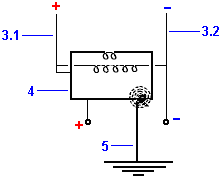 Here, the earth wire 5 is wrapped around the continuous loop wire 4, feeding it additional electrons captured from the ground. The ends of wire 4 are connected together to form the loop, and that connection also forms the positive side of the output (where a DC output is being produced). The magnetic field produced by the current flowing in wire 3, acts on the electron flow coming from the earth, but as it does not provide any of the electric power flowing in wire loop 4, the current flowing in wire 3 can be tiny, without affecting the power output. In their patent WO 2013/104043, also of 18th July 2013, they show several different ways of connecting their electron trap in a useful circuit. For example, like this: 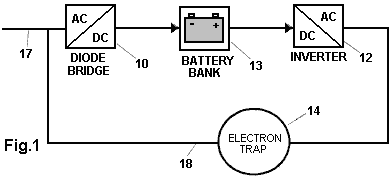 Here, the battery 13, is used to power an ordinary inverter 12, which produces a high alternating voltage, in this case, at very low power. That voltage is applied to the wire 3.1 to 3.2 of the electron trap, creating an oscillating magnetic field, which creates an oscillating inflow of electrons into the closed loop wire (4), which creates an amplified electrical output at the same frequency – typically 50 Hz or 60 Hz as those are the common mains frequencies. That amplified power output from the electron trap 14, is passed along wire 18 to an ordinary diode bridge 10, and the pulsing DC from the bridge is smoothed and used to replace the battery input to inverter 12. The battery is now switched out of the circuit and, as well as making the overall circuit self-powered, the power coming from the electron trap is used to recharge the battery if it needs recharging (and/or, perhaps, to charge the batteries of an electric car). Because the electron trap needs almost no input power at all, the input power to the inverter is very small, and so a good deal of additional AC power can be drawn off through cable 17, and used to drive powerful electrical loads, with no electrical power being needed from the battery. Being self-powered, the COP value for the circuit is infinity. Just as there are several different ways of using an electron trap in a circuit, there are several ways of constructing and connecting an electron trap. While it is possible to arrange the components so that the power output is 2-phase or 3-phase, here we will just deal with the ordinary, household, single-phase power supply. The first variation is to use more than one frame. Two frames can be connected like this: 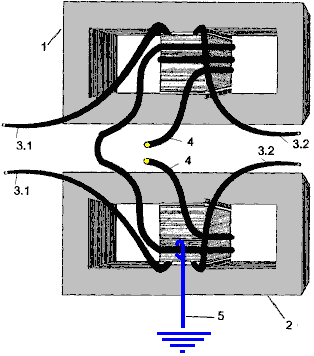 This is the actual drawing from the patent and it presents a slight problem in that it is not physically possible to implement the number 4 wire in the way shown. Each frame will have two complete turns wound on it, although the drawing does not show this. Because of the inaccuracy of the drawing, I am not able to say if the coil turns on frame 2, are in the same direction as those on frame 1. There are four possible ways of winding these 2-turn coils when interconnecting them, so perhaps experimentation can be used to determine which method works best. With this two-frame arrangement, there is just the one earth wire 5, as before, again, it is wrapped around wire 4 rather than being physically connected to it. The continuous wire loop 4 has two ends as before, but there are now two 3.1 wire ends and two 3.2 wire ends. The Portuguese translation programs produce highly questionable results for this area of the patent, but I gather that the inventors intend the two 3.1 ends to be connected together and the two 3.2 ends to be connected together, and then the joined ends are treated exactly as before, effectively putting the two windings in parallel. One disadvantage of this design is that it is not portable due to the earth connection. Barbosa and Leal deal with this problem in their patent WO 2013/104041 of the same date where they show a method of constructing an electron trap which collects excess electrons from the air. If you feel that there are no excess electrons in the air, then consider the fact that all of the aerial designs in chapter seven all extract and use those electrons. Also, consider the amount of electricity in a lightning strike, where much of the electrical energy comes from the air, and remember that world wide, there are between 100 and 200 lightning strikes every second. The free-electrons-in-the-air electron trap is somewhat more complicated than the earth-wire electron trap, with four pairs of coils (3 and 4) being mounted inside two aluminium hemispheres (1): 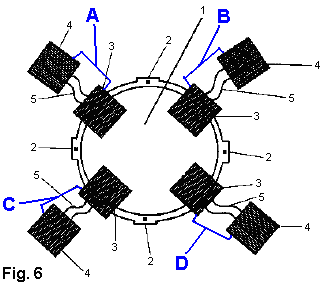 The methods for using the air-electrons trap are the same as those for the earth-wire electron trap. An earth-wire video demonstration is here with 22 watts producing 6 kilowatts. 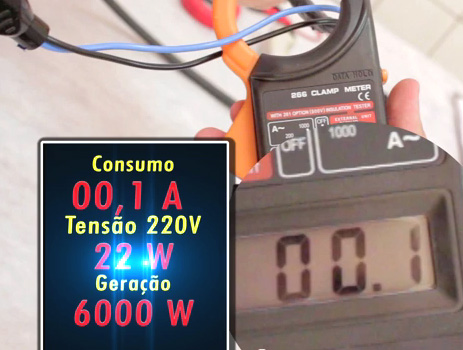 An attempted translation of the three Barbosa/Leal patents is here: ELECTRIC ENERGY GENERATION SYSTEM WITH FEEDBACK Inventors: Nilson Barbosa et Cleriston de Morales Leal 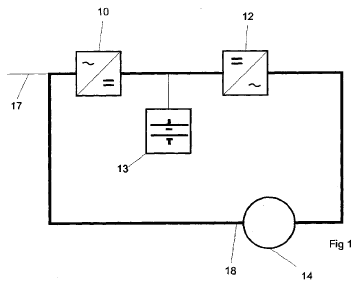 Abstract: The present invention relates to electric energy generation equipment comprising a basic circuit formed by a rectifier (10), for example, an AC/DC converter connected in series to an inverter (12), for example, a DC/AC converter, and a bank of batteries (13) connected in series between the rectifier (10) and the inverter (12). An electron-capturing element (14), which can be either a free space electron-capturing element or, alternatively, an earth electron-capturing element, is connected in series to the basic circuit formed by the rectifier (10), the inverter (12) and the battery assembly (13). The bank of batteries (13) powers the basic circuit because it is connected to the system. Consequently, the inverter (12) converts direct current into alternating current and supplies this current to the electron-capturing element (14). After receiving the electric current from the inverter (12), the electron-capturing element (14) starts capturing electrons from the alternating current and powering the rectifier (10), which converts the alternating current into a direct current in order to recharge the bank of batteries (13) and power the inverter (12) which powers the electron-capturing element, closing the feedback loop, and also providing electric energy for consumption by external loads. WIPO Patent Application WO/2013/104043 Filing Date: 01/11/2013 Application Number: BR2013/000016 Publication Date: 07/18/2013 Assignee: EVOLUÇÕES ENERGIA LTDA (Rua Santa Tereza 1427-B Centro - Imperatriz -MA, CEP -470 - Maranhão, 65900, BR) Technical field The present invention relates to a device for generating electricity, in particular self-powered equipment for generating electricity. Description of the Related Art There are many methods for generating electricity using electromagnetism, but all of these are electromechanical devices using magnets and have limited generating capacity and an ecological impact which makes them unsuited to large scale projects. Objectives of the Invention The aim of this invention is the sustainable generation of electricity, using a generator which is able to produce large amounts of electricity from an extremely low input current, which initially is supplied by a bank of batteries, but subsequently is supplied by the output from the generator which is also able to power external loads. The above objective, and other objectives, are achieved by the present invention through the use of a typical Uninterruptible Power Supply circuit comprising of an AC/DC rectifier feeding a battery bank which powers a DC/AC inverter, which is connected to a device to trap electrons from space (as described in Brazilian patent application No. BR1020120008378 of 13th January 2012) or alternatively, a device which extracts electrons from the Earth (as described in Brazilian patent application No. BR1020120008386 of 13th January 2012), which then passes the extracted electrons to the AC/DC rectifier, charging the battery bank, thus closing the loop as well as providing electricity to power external loads. The self-powered system for generating electricity from the present invention can be fixed or mobile. It is fixed when using electron capture from the earth due to the ground connection, or mobile when using electron capture from space. The self-powered electricity generating system of this invention may be configured in several different ways, each using the same inventive concept but using different arrangements of components. Different versions include single-phase, two-phase or three-phase versions, producing outputs of any power and voltage. Brief Description of the Drawings The present invention will now be described with the aid of drawings, but this patent is not limited to the versions and details shown in these drawings, although they show additional details and advantages of the present invention. The drawings:  Fig.1 - shows a basic circuit system for self-powered electricity generation of the present invention 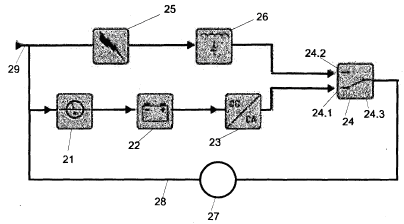 Fig.2 - shows a first embodiment of the constructive system for self-powered electricity generation of the present invention 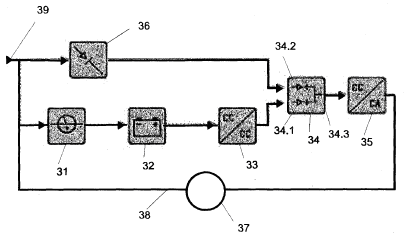 Fig.3 - shows a second embodiment of the self-powered system for generating electricity of the present invention 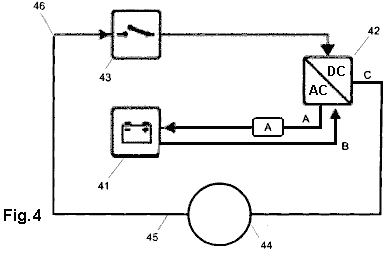 Fig.4 - shows a third embodiment of the self-powered system for generating electricity of the present invention 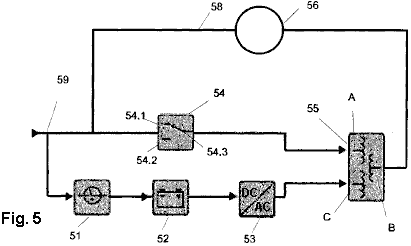 Fig.5 - shows a fourth embodiment of the self-powered system for generating electricity of the present invention 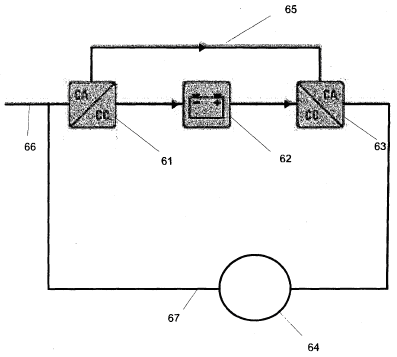 Fig.6 - shows a fifth embodiment of the self-powered system for generating electricity of the present invention; Detailed description of the Invention: There are different ways of closing the self-feeding cycle depending on the circuit configuration chosen. Some of these arrangements are shown in Figures 2 to 6, wherein the main circuitry continues to oscillate, continuously generating instant electricity.  As shown in Fig.1, the self-powered system for generating electricity comprises a basic circuit consisting of a rectifier (AC/DC converter) 10 which is connected in series to an inverter (DC/AC) 12. A bank of batteries 13 is connected between the rectifier 10 and the inverter 12. The output from the DC/AC inverter 12, connects to an electron-trap 14 which can extract electrons from space (as described in Brazilian patent application No. BR1020120008378 of 13th January 2012) or alternatively, extracts electrons from the Earth (as described in Brazilian patent application No. BR1020120008386 of 13th January 2012). When connected, the battery bank 13 provides power to the DC/AC inverter 12 which converts the direct current into alternating current and provides current to the electron-trap 14. The output of the electron trap 14 is passed through wire 18, to the AC/DC bridge rectifier 10, which keeps the battery bank charged as well as powering the DC/AC inverter 12. Additional power is passed to external equipment through wire 17. 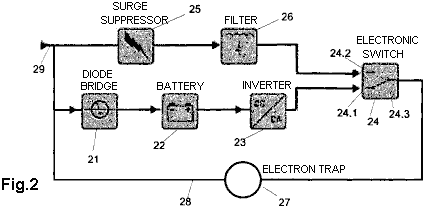 Fig.2, shows another embodiment of the system of this self-powered electric power generation equipment. It comprises a typical Uninterruptible Power Supply circuit of a battery charger (AC/DC converter) 21 connected to a drive device (a DC/AC inverter) 23 and between them, a battery bank 22 forming the basic circuit. Additional devices are an electron-trap 27 which may collect free electrons from space (as defined in Brazilian patent application No. BR1020120008378 of 13th January 2012) or, alternatively, collects electrons from the Earth (as described in Brazilian patent application No. BR1020120008386 of 13th January 2012). The 3-phase electronic switch 24 normally connects 24.1 to 24.3 connecting the electron trap 27 to inverter 23. Connected in parallel is the surge suppressor 25, which, when activated, via filter 26, causes switch 24 to disconnect the 24.3 to 24.1 link and instead, connect 24.3 to 24.2. An alternative arrangement for use in emergency situations, is to use the system no longer self-powered. For this, the system is comprised of a power input from an external power source, directly to the interconnection point 29 to provide power to surge suppressor 25, which provides power to feed the power output point 28 in order to power external loads. When the electron-trap 27 is turned off, the electronic transfer switch 24 reverts to its default position which connects point 24.1 to point 24.3 causing the circuit to function, once again, in its self-feeding mode. As soon as the electron sensor 27 provides sufficient power to the over-voltage sensor 25, it operates the transfer switch 24 through filter 26, ending the self-feeding phase and supplying energy directly to the power output point 28, in order to feed external loads. 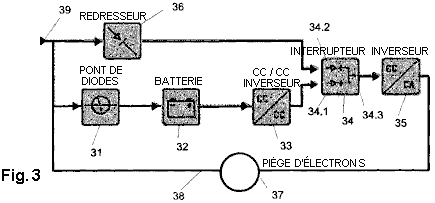 Fig.3 shows another embodiment of the self-powered system for generating electricity, comprising a device which includes the basic circuit of a typical Uninterruptible Power Supply, consisting of a battery charger (AC/DC converter) 31 connected to a drive device (inverter DC/AC) 35 and attached to them, a battery bank 32. This basic circuit together with other devices is connected to an electron-trap 37 for collecting free electrons from surrounding space or, alternatively, an Earth-connected electron trap 37. We have then, a bank of batteries 32 connected to the DC/DC converter 33, which is connected to the phase transfer switch 34 / 34.1 which is connected to point 34.3, which connects to the inverter 35, and so, the electron-trap 37. 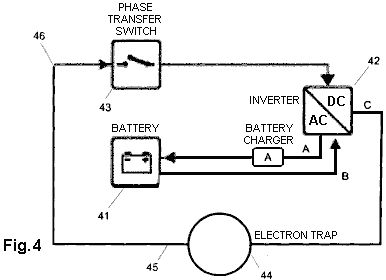 Fig.4 shows another embodiment of the system for self-powered electricity generation which is comprised of a basic circuit of a typical uninterruptible power supply, consisting of a battery charger (AC/DC converter) A connected to an inverter (DC/AC) 42 and attached to them, battery bank 41, and this basic circuit together with other devices are connected to a free space electron-capture device 44 or an earth-connection electron-trap 44. Comprising thus, a battery charger A connected to a battery bank 41, which is connected in series with inverter 42 at point B which is in series with point C of inverter 42 which is in series with the electron sensor 44, which is in series with the phase transfer switch 43 via the three-phase load output connection point 45. The phase transfer switch 43 is in series with the inverter 42, which is connected in series the (AC/DC converter) battery charger A feeding the battery bank 41. An alternative construction for use in emergency situations, in which the system ceases to be self-powered, the system may include power input from an external power source, via the interconnection point 46, thus providing electricity output 45, to power external loads. The battery bank 41 provides power to the inverter 42 which converts the direct current into alternating current and feeds the electron trap 44. The phase transfer switch closes when the batteries need recharging. Sensor 44 captures electrons, producing alternating current, which feeds the phase transfer switch 43 with alternating current input power. The phase transfer switch 43 feeds the inverter 42 which charges the batteries, closing the self-powering loop which provides power at the output 45, feeding both the power input and any external loads.  Fig.5 shows another embodiment of the system for self-powered electric power generation equipment comprising a circuit which includes a typical uninterruptible power supply comprising a battery charger (AC/DC converter) 51 connected to a DC/AC inverter 53 and attached to them, a battery bank 52. This basic circuit together with other devices are connected to a space free-electron capture device 56 (as defined in Brazilian patent application No. BR1020120008378 of 13/1/12) or, alternatively, an earthed free-electron collector 56 (as defined in Brazilian patent application No. BR1020120008386 of 13/1/12). This then comprises a battery charger 51 which is connected in series with a battery bank 52, which is connected in series with the inverter 53, which is connected in series with the transformer 55 at its point C, which is in series with its point B which is in series with the electron collector 56, which is in series with the battery charger 51 which is connected to the load exit point 58, which is also the circuit entry point 59, which is in series with the phase transfer switch 54 section 54.1, which is connected to terminal 54.3, which is in series with point A of the transformer 55 which exits at point B. Points A and 54.3 as well as the parallel points 54.1 and 54.2, are all parallel to the battery charger 51, the battery bank 52, the inverter 53 and to point C of the transformer 55. An alternative construction for use in emergency situations, in which the system ceases to be self-powered, the system may include an external power input point 59, allowing phase transfer switch 54 to provide power output 58, to feed external loads. Battery bank 52 provides power to the inverter 53, which converts the direct current into alternating current, feeding point C of the transformer, which comes out at points B and A of the transformer 55. Point B of the transformer feeds the electron-trap 56 producing alternating current which feeds the battery charger 51, recharging the battery bank 52. The battery charger 51 is connected in parallel with the transfer switch 54 via connection points 54.1 and 54.3, feeding point A of the transformer, which comes out at point B. Point A of the transformer and the switch transfer points 54.3 and 54.1 are in parallel to the battery charger 51, the battery 52, the inverter 53 and point C of the transformer 55. 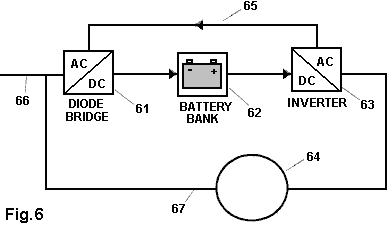 Fig.6 shows another embodiment where a rectifier 61 is connected to an inverter 63 and a battery bank 62, and to a space free-electron trap 64 or alternatively, an earth electron trap 64 comprising thus, a delta (AC/DC) converter 61, which is connected in series to a battery bank 62, which is connected in series with the (DC/AC) inverter 63, which is in series with the electron collector 64 which is connected in series with the delta converter (AC/DC) 61 whose AC part is in series with the alternating AC current inverter 63 via a connecting wire 65 which is in parallel with the DC part of the delta converter 61 with the battery bank 62 and the DC part of inverter 63. An alternative construction for use in emergency situations, in which the system ceases to be self-powered, the system may comprise a power input from an external power source, via the interconnection point 66 connected to the delta converter 61, the output 67 supplying power, to the external loads. Battery bank 62 provides power to the inverter 63, which converts the direct current into alternating current, powering the free-electron collector 64. The captured electrons from collector 64 form an alternating current which feeds the delta converter 61 via an output power load wire 67. The alternating part of the three-phase delta converter 61 is fed with alternating current from inverter 63 via connecting wire 65, which is connected in parallel to the continuous DC delta converter 61, which feeds the battery bank 62 and with the continuous portion the inverter 63, closing the cycle of self-feeding and supplying power at the output 67, which is the output power point. Having described examples of preferred embodiments, it should be understood that the scope of the present invention encompasses other possible forms of construction, using the electron collectors connected to a basic circuit of a typical uninterruptible power supply of energy, known as a UPS, comprising a rectifier device (an AC/DC converter) 10, connected to one inverter (DC/AC converter) 12, and attached between them, an energy storage device (typically, a battery bank). A very important part of the above patent is the device described as a “collector of free-electrons”, either from the earth or from space. We have to go to the patent applications mentioned above to find the details of these designs: Application Number: BR2013/000015, Publication Date: 07/18/2013, Filing Date: 01/11/2013 Assignee: EVOLUÇÖES ENERGIA LTDA (Rua Santa Tereza 1427-B Centro - Imperatriz, MA- CEP -470 - Maranhäo, 65900, BR) Technical Field The present invention refers to electromagnetic equipment for electric power generation or alternatively for thermal power generation. More specifically equipment capable of producing abundant electricity and thermal energy from a tiny amount of input electrical energy. Description of the Related Art According to Lenz's law, any induced current has a direction such that the magnetic field it generates opposes the change in magnetic flux which produced it. Mathematically, Lenz's Law is expressed by the negative sign (-) that appears in the formula of Faraday's Law, as follows. The magnitude of the induced emf (ε) in a conducting loop is equal to the rate of change of magnetic flux (ΦΒ) with time:  As an example of application of Faraday's Law, we can calculate the electromotive force induced in a rectangular loop that moves in or out, with constant speed, a region of uniform magnetic field. The magnetic field flux through the surface limited by the loop is given by: 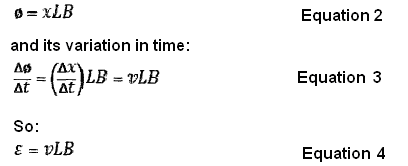  A conductor traversed by an electric current immersed in a magnetic field undergoes the action of a force given by:  Thus, the effect of the current induced in the loop appears as forces Ff, and F - FM. The first two cancel each other out and the third is cancelled by an external force Pext needed to maintain the constant speed loop. As the force FM must oppose the force Fext, current (i) induced in the loop by varying the magnetic flux must have the meaning indicated in Fig.3. This fact is a particular example of Lenz's Law. Considering the experimental activities discussed with Faraday's law, when a magnet approaches a coil, the induced current in the coil has a direction as shown in Fig.1. This generates a magnetic field whose north pole is facing the north pole of the magnet, that is, the field generated by the induced current opposes the motion of the magnet. When the magnet is moved away from the coil, the current induced in the coil has a direction opposite to that shown in Fig.1, thereby generating a magnetic field whose south pole is facing the north pole of the magnet. The two poles attract each other, that is, the field generated by the induced current opposes the movement of the magnet away from the coil. This behaviour is present in all current power generators, and known as ‘engine brake’ is highly undesirable as it increases the resistance and so, the energy loss. When two electromagnetic coils are placed facing each other, as shown in Fig.2, there is no current in either of them. At the instant of power-up of one of the coils, the current in the coil, generates an induced current in the second coil. When powered up, the current in the coil goes from zero to its maximum value, and then remains constant. Thus, when the current is changing, the magnetic field generated by it, (whose north pole faces the second coil) is also changing and so the magnetic flux of this field through the second coil is also changing. Then there is a current induced in the second coil whose sense is such that the magnetic field it generates tends to decrease the flow mentioned above, that is, its north pole confronts the north pole of the first field coil. When the power switch is opened, the current in the first coil drops from its maximum value to zero, and correspondingly its magnetic field decreases. The flux of the magnetic field in the second coil also decreases, and the induced current now flows in the opposite direction. This current flow direction produces an enhancing magnetic field, that is, it has a south pole facing the north pole of the field of the first coil. Thus, there is a realisation of the principle of conservation of energy, expressed by Lenz's law, wherein any induced current has an effect which opposes the cause that produced it. Assuming that the induced current acts to favour the variation of the magnetic flux that produced the magnetic field of the coil, it would have a south pole facing the north pole of the approaching magnet, causing the magnet to be attracted towards the coil. If the magnet were then released, it would experience an acceleration toward the coil, increasing the intensity of the induced current and thus create an enhanced magnetic field. This field, in turn, would attract the magnet with increasing force, and so on, with a continuing increase in the kinetic energy of the magnet. If energy were to be withdrawn from the magnet-coil system at the same rate at which the kinetic energy of the magnet increases, then there would be an endless supply of energy. So it would be a perpetually operating motor, which would violate the principle of conservation of energy. Therefore, it can be concluded that current generators feature a large energy loss during the generation of electricity. Objectives of the Invention An objective of the present invention is to contribute to the generation of sustainable energy, proposing an electromagnetic machine capable of producing abundant electricity from an extremely low input of electrical energy. The above objective and other objectives are achieved by the present invention by a device comprised of at least one electromagnetic field-generating device (without a core or with at least one core) powered by an electrical power source (without a core or with at least one core) having their coils, or sets of coils, wound on at least one common conductive member in a closed circuit which itself has a polarised voltage which is connected to at least one conductive interconnection element which is connected to a grounding grid, these interconnections creating a new technical effect, namely, the appearance of an electric current which keeps circulating in a closed conductive loop, and which can therefore be used to power external loads. The device which is the object of the present invention operates as follows: the electromagnetic field generating device, powered by a power source, produces an electromagnetic field which induces an electric current in a closed conductive circuit, creating an interaction between the magnetic poles of the equipment and the magnetic poles of the earth - through both electromagnetic attraction and repulsion. An endless supply of electrons is drawn from the earth into the conductive closed loop, which is connected to the ground through a conductive interconnected grid. Attracted electrons add to the current already flowing in the conductive closed loop, making power available for driving high-power loads, although the device itself is only supplied with a small amount of power. Thus, advantageously, the device which is the object of the present invention, acts as a trap for electrons from the earth and this allows the generation of electricity. Advantageously, the present electromagnetic equipment generates either electricity or thermal energy, providing access to this new source of energy is through an electromagnetic field. The interconnections of the components of the electron-trap of the present invention, cause an advantageous new technical effect, namely, the appearance of an electric current which keeps circling in the conductive closed circuit, with or without voltage being applied and even without a load being connected to the loop - provided that the electron-trap is connected. The proposed sensor can also be used to generate thermal power, depending on the form in which you want to use the effect of the flow of electrical current produced in this electromagnetic equipment. For the generation of thermal energy in amounts proportional to the power of the electron-trap, through the movement of electrons in the conductive closed loop itself, the resistance should be increased by increasing the number of turns around the cores in the conductive element of the closed circuit, and in that instance, the coils of the electromagnetic field generating device, will then be made of heat-insulated electrical circuit components, bearing in mind the required temperature which is to be produced. The thermal energy generated by the electron-trap can be used in any application from domestic to industrial applications. This technology can also be used for various technical purposes in electric machines. By "electrical machines", it should be understood to include: static electrical machines, transformers, ballasts, rotating electrical machines, synchronous machines, dual power supply machines, current rectifiers in synchronous cascade, external pole machines, synchronous current machines alternating current machines and/or direct current machines, electronic equipment and electrical resistances. The capture of electrons can provide single-phase, two-phase or three-phase supplies, operating at low, medium or high voltage. The capture of electrons by induction, does not impact on the environment. The fact is that we use as the capturing force, only a negligible amount of electricity relative to the current captured by the sensor. The relationship between power input and the quantity of electricity generated by the electron-trap is at least 1 to 100, that is, for each 1 watt provided to the sensor, there is at least 100 watts of power available for external loads. This relationship, however, is not limited, as it depends on the mounting of the electron-trap and the objectives of the circuit, and so, the generated power can be greater than 100 times the input power. Another advantage of the earthed electron- trap proposed in the present invention is that the electron-trap can transport electrons from point "A" to point "B" without a voltage drop across the closed-loop conductive element - if it is biased with a voltage - regardless of the distance between the points depending on the strength and quantity of the electromagnetic field generating devices. It is also possible to transport electrons when the conductive element in a closed circuit is itself not polarised. Thus, the electric current is transported without voltage, just by the magnetic field formed between the device and the generator of the electromagnetic field. Brief description of the Drawings The present invention will now be described with the aid of drawings, but the design is not limited to the implementations shown in these drawings, although they show other details and advantages of the present invention. The figures show: 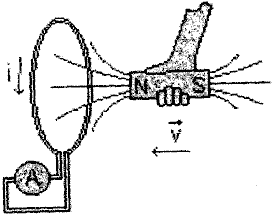 Fig.1 - illustrates Faraday’s law.  Fig.2 – is a representation of Faraday’s law. 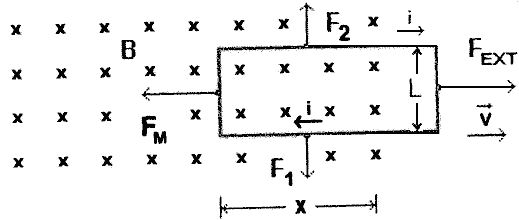 Fig. 3 – is a representation of Faraday’s law. 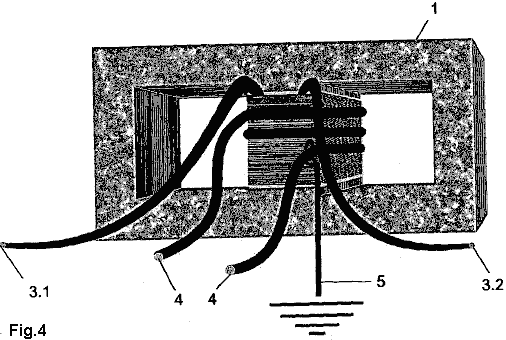 Fig. 4 - is a perspective view of an electron-trap with a single phase coil. 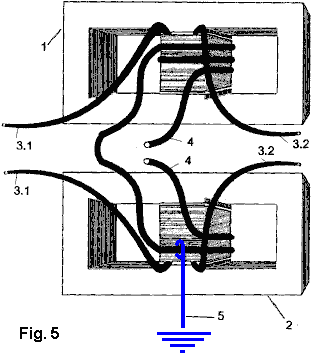 Fig.5 – is a perspective view of a single-phase electron trap with two coils. 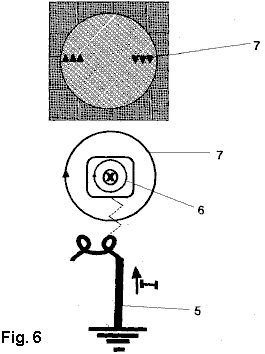 Fig.6 - is a representation of the effect of electromagnetic flux in the coils around the cores of the electron trap. 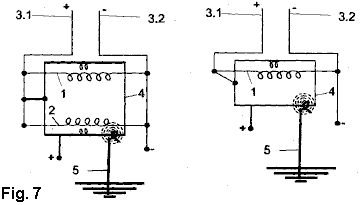 Fig.7 - is a representation of an electrical circuit with two coils of the link/coil conductor polarised. 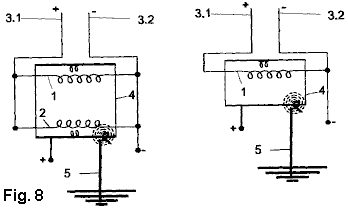 Fig.8 - is a representation of an electrical circuit with two coils of the link/coil conductor not polarised. Detailed Description of the Drawings  Fig.4 shows one of several types of electron-trap proposed by the present invention, where the electron-trap is single-phase and consists of at least one electromagnetic field-generating device with at least one set of coils, in this case it happens to be an electromagnetic type coil with one common magnetic core, but it could alternatively have any number of windings of any kind and shape. However, the electron-trap proposed by the present invention can be constructed with a different type of electromagnetic field generating device, such as an electromagnetic inductor or magnet of any type or shape, or any combination of them, and in unlimited numbers for each phase of the electron trap. When winding these coils, for example, coil 4-4, each coil must have at least one complete turn, preferably two turns if the objective is to generate electricity, and preferably four turns if the objective is provide thermal energy. The number of turns in the coils wound around the common core, is directly related to the amount of current to be generated. At least one conductive interconnection element, in this case the driving member 5 - which can be copper or any other suitable conductive, material whether insulated or not insulated, connects or loop-links wire 4 to the ground grid. The connection between the conductor 5 and wire 4 is by electromagnetic induction. Winding 4 is also the power supply for the loads which are to be powered by the captured electrons. Also in Fig.4, the power wires 3.1 and 3.2 (live phase and neutral) have an input from an external power coil 1 which can be energised from any external source of electricity such as a power grid. The trapped electrons can be configured to supply DC or AC current. Thus, if the coil 1 power source is alternating electrical current - AC, then the electron-trap provides alternating electrical current. If the power source is continuous electrical current - DC, then the electron-trap provides continuous electrical current - DC. The electrical supply provided by the trapped electrons can be single-phase, two-phase or three-phase, and at low, medium or high voltage.  Fig.5 shows an electron-trap with two single-core phase coils: 1 and 2, although these coils may be of any type and shape. However, the electron-trap proposed by the present invention can be constructed with other types of electromagnetic field generating device, with at least one electromagnetic inductor or electromagnet which can be of any type and shape, with any combination of them, and in unlimited quantities in each phase of the electron-trap. The coils on frames 1 and 2 may have other shapes, but they must each have at least one complete turn, particularly in coil 4. The number of turns in this winding are directly related to the amount of current to be generated. This coil also makes the interconnection between the coils 1 and 2 forming the link between their two cores. At least one conductive interconnection element, in this case the driving member 5 - which can be copper or any other suitable conductive, material whether insulated or not insulated, connects or loop-links wire 4 to the ground grid. The connection between the conductor 5 and wire 4 is by electromagnetic induction. In electron-traps which have numerous sets of coils 1 and 2, the ends of all of the power-supply conductors 3.1 can all be connected to each other, and all of the 3.2 conductor ends may be connected together. Thus, all of the coils 1 and 2 can be fed exactly the same voltage. The power to energise coils 1 and 2 can be provided from any external source of supply of electricity such as a power grid. In electron-traps which have numerous coils 1 and 2, a single coil winding 4 connects the cores of all of the coils 1 and 2.  The diagram shown in Fig.6, illustrates the magnetic induction 6 around the core "X" of the coil 1. This induction causes electrical current flow in the conductor coil link 7/4, attracting electrons from the earth, through the conductive member 5, to the magnetic field of the electron-trap, where those electrons are added to the current generated by induction in the link coil 4 conductor loop circulating between north and south magnetic poles.  Fig.7 shows how the connections should be made in one version of the electrical circuit of the electron-trap proposed in this invention. The diagram shows the electrical circuit of an electron-trap where the link/coil driver 4 is polarised with a voltage. This is one form of construction for an electron-trap which has two coils 1 and 2, where a link/coil loop conductor 4 is biased with a voltage, that is, there is a link connecting the coil conductors 4 of a power supply 3.1 or 3.2, whatever the stage. In this way, earth electron-traps, by adopting this circuit, that is, with the link/conductor loop 4 and polarised voltage on coils 1 and 2, besides being used as a power source for external loads, can also be used for thermal power generation.  Fig.8 shows how connections should be made in another electric circuit electron-trap proposed in this invention. the circuit illustrates a circuit of an electron-trap with a non-polarised link / coil driver 4. This is one form of construction of the electron-trap where a link / coil conductor 4 of the spiral conductor coils 1 and 2 is not polarised, that is, there is no such link connecting conductor / conductor coil conductors 4 of a coil 3.1 or 3.2. Thus, earth electron-traps adopting this circuit, that is, with the link coil not polarised, the current flows without there being voltage in the link/coil conductor 4 joining the first and second coils by electromagnetic induction. They can also be used for generating thermal energy. The structure of the circuit - in the open or closed coils 1 and 2, and always in the closed link / loop lead 4 - makes it possible to generate current by induction and electron capture by electromagnetism on the link conductor 4 - where current is generated and stays in motion with or without voltage, as the coils 1 and 2 are being fed. Thus, the present invention provides a new concept for electrical energy generation, since it is obtained from an electric current circling without consumption and even without an output load being attached to it. Additionally, because the induced electrical current flows regardless of the voltage present, it can be used as a current stabiliser for electrical networks whether they be single-phase, two-phase or three-phase, with low, medium or high voltage. SPACE ELECTRONS TO GENERATE ELECTRICITY Application Number: BR2013/000014 Publication Date: 07/18/2013 Filing Date: 01/11/2013 Assignee: EVOLUÇÕES ENERGIA LTDA (Rua Santa Tereza 1427-B Centro - Imperatriz -, MA - CEP -470 - Maranhão, 65900, BR)  Abstract The invention relates to a device that comprises at least three sets (A, B, C, D) of at least one device for generating an electromagnetic field (3) and (4), powered by an electricity source (without a core or with at least one core) the cores thereof or any extension thereof, preferably the windings or sets of windings thereof, being surrounded by at least a single conductive element forming a polarised and energised closed-circuit (5), the sets of electromagnetic-field generating devices (3) and (4) being linked together by their opposing poles to encourage the interaction of their electromagnetic fields, which ideally, are located between two hollow metal hemispheres (1) so as to concentrate and enhance the electromagnetic fields, these interconnections causing, as a novel technical effect, the emergence of an electrical current that circulates, with or without voltage, in the conductive element forming a closed-circuit (5) - even if no load is connected. Description FROM SPACE, FOR ELECTRICITY GENERATION" Technical Field The present invention relates to electromagnetic equipment for electrical power generation and/or thermal power generation. More specifically, equipment capable of producing abundant electricity and thermal energy from a tiny input of electrical energy. Description of the Related Art According to Lenz's law, any induced current has a direction such that the magnetic field it generates opposes the change in magnetic flux that produced it. Mathematically, Lenz's Law is expressed by the negative sign (-) that appears in the formula of Faraday's Law, as follows. The magnitude of the induced emf (ε) in a conducting loop is equal to the rate of change of magnetic flux (ΦΒ) with time:  As an example of application of Faraday's Law, we can calculate the electromotive force induced in a rectangular loop that moves in or out, with constant speed, a region of uniform magnetic field. The magnetic field flux through the surface limited by the loop is given by:   A conductor traversed by an electric current immersed in a magnetic field undergoes the action of a force given by:  Thus, the effect of the current induced in the loop appears as forces Ff, and F - FM. The first two cancel each other out and the third is cancelled by an external force Pext needed to maintain the constant speed loop. As the force FM must oppose the force Fext, current (i) induced in the loop by varying the magnetic flux flux must have the meaning indicated in Fig.1. This fact is a particular example of Lenz's Law. Considering the experimental activities discussed with Faraday's law, when a magnet approaches a coil, the induced current in the coil has a direction as shown in Fig.2. This generates a magnetic field whose north pole is facing the north pole of the magnet, that is, the field generated by the induced current opposes the motion of the magnet. When the magnet is moved away from the coil, the current induced in the coil has a direction opposite to that shown in Fig.2, thereby generating a magnetic field whose south pole is facing the north pole of the magnet. The two poles attract each other, that is, the field generated by the induced current opposes the movement of the magnet away from the coil. This behaviour is present in all current power generators, and known as ‘engine brake’ is highly undesirable as it increases the resistance and so, the energy loss. When two electromagnetic coils are placed facing each other, there is no current in either of them. At the instant of power up one of the coils, the current in the coil, generates an induced current in the second coil. When powered up, the current in the coil goes from zero to its maximum value, and then remains constant. Thus, when the current is changing, the magnetic field generated by it, (whose north pole faces the second coil) is also changing and so the magnetic flux of this field through the second coil is also changing. Then there is a current induced in the second coil whose sense is such that the magnetic field it generates tends to decrease the flow mentioned above, that is, its north pole confronts the north pole of the first field coil. When the power switch is opened, the current in the first coil drops from its maximum value to zero, and correspondingly its magnetic field decreases. The flux of the magnetic field in the second coil also decreases, and the induced current now flows in the opposite direction. This current flow direction produces an enhancing magnetic field, that is, it has a south pole facing the north pole of the field of the first coil. Thus, there is a realisation of the principle of conservation of energy, expressed by Lenz's law, wherein any induced current has an effect which opposes the cause that produced it. Assuming that the induced current acts to favour the variation of the magnetic flux that produced the magnetic field of the coil, it would have a south pole facing the north pole of the approaching magnet, causing the magnet to be attracted towards the coil. If the magnet were then released, it would experience an acceleration toward the coil, increasing the intensity of the induced current and thus create an enhanced magnetic field. This field, in turn, would attract the magnet with increasing force, and so on, with a continuing increase in the kinetic energy of the magnet. If energy were to be withdrawn from the magnet-coil system at the same rate at which the kinetic energy of the magnet increases, then there would be an endless supply of energy. So it would be a perpetually operating motor, which would violate the principle of conservation of energy. Therefore, it can be concluded that current generators feature a large energy loss during the generation of electricity. Objectives of the Invention The present invention aims to contribute to the generation of sustainable energy, proposing electromagnetic equipment capable of producing abundant electricity from an extremely low input of electrical energy. The above objective and other objectives are achieved in the present invention by a device comprising at least three sets of at least one electromagnetic field generating device (without a core or with at least one core) powered by an electrical power source, having their cores or any extension of them, with their coils or sets of coils, wound on at least one common conductive member in a closed circuit which is polarised by a voltage source, and these sets of electromagnetic field generating devices are arranged with their poles in confrontation, to promote the interaction of electromagnetic fields, and, preferably, positioned between two hollow metallic hemispheres, in order to focus and enhance their electromagnetic fields - these interactions cause a new technical effect - the emergence of an electric current which keeps flowing in a closed loop, with or without voltage being applied to that closed loop, current which is capable of powering external loads - even if no load is attached to it. The device which is the object of the present invention operates as follows: Sets of electromagnetic field generating devices to be powered by an electrical power source, produce an electromagnetic field which induces an electric current in a closed conductive circuit, creating an interaction between the magnetic poles, and through repeated electromagnetic attraction and repulsion, provides an endless supply of electrons to the conductive closed loop itself. The electrons attracted by this technique, augment the current flowing in the closed conductive loop, which provides the current to power external loads of high power, in spite of the fact that the device itself is supplied with only a small level of power. Thus, advantageously, the device which is disclosed in the present invention forms a trap for electrons from space, resulting in the generation of electricity. The interconnections of the components of the electron-trap cause, a new technical effect, namely, the appearance of an electric current which keeps circling in a closed circuit, even without any voltage being applied to the closed circuit, and even without a load being connected to it. The present electromagnetic equipment generates electricity or thermal energy, providing access to this new source of energy through the use of an electromagnetic field. The proposed sensor can also be used for the generation of thermal energy depending on the form of circuit which is to be used, resulting from the flow of electric current produced by this electromagnetic equipment. This field generates a flow of electric current induced by electromagnetic coils, which appears in the linking interconnecting devices generating electromagnetic fields with electromagnets, inductors or magnets. This chain operates in a manner favourable to the variation of the magnetic flux produced by the magnetic field in the electron-trap. Thus, it creates a north pole and a south pole, providing an endless supply of electric current without resistance between the links which interconnect the devices which are generating the electromagnetic fields. So, induced electric current is generated with or without voltage in the interconnection links of electromagnetic field-generating devices, depending on the connection method of the electrical circuit of the electron-trap. The free-electrons collected by the space electron-trap can form alternating current (AC) or direct current (DC). The ratio of input power to output power is 1 to 100, that is, the generated power can be 100 times greater than the input power when there is at least one link / coil driver between the coils and the inductors or electromagnets. This relationship, however, is not limited to a factor of 100, as it depends on the shape of the electron-trap and its objective. Another advantage of the free space electron-trap of the present invention is that, with thermal insulation of the components in the electric circuit, it is possible to produce thermal energy at low, medium or high temperature, through the movement of the electrons in the conductors, coils and/or electromagnets. The temperature generated is linked directly to the number of turns in the coils. Thermal power generation performed by the sensor can be used for boiling and/or evaporation of liquids to be used in other types of energy generation, for example, replacing the use of coal and natural gas. Another advantage of the proposed electron-trap of the present invention is that the electron-trap can transport electrons from one point "A" to a point "B", without a voltage drop in the link - if it is polarised - regardless of the distance between the points, depending on the strength and quantity of the electromagnetic field-generating devices. It is also possible to transport the electrons when the link devices generating the electromagnetic field are not polarised. In this way, the electric current is conveyed without voltage but only by the magnetic field formed between the coils. This methodology can be used in various fields. Because of its simple construction, the electron-trap is a simple device which is compact, and performs low-cost power generation which can be used in all types of machinery, equipment and devices of all kinds, and many areas of application which require electricity in order to operate. The electron-trap can have single-phase, two-phase or three-phase output, and can generate electric current at low, medium or high voltage. Brief description of the Drawings The present invention will now be described with the aid of drawings, but the design is not limited to the implementations shown in these drawings, although they show other details and advantages of the present invention. The figures show:  Fig.1 - illustrates Faraday’s law  Fig.2 illustrates Faraday’s law where a magnet approaches a coil of just one turn.  Fig.3 is a view of one metallic hemisphere seen from above.  Fig.4 is a bottom view of the hemisphere with the coils in place. 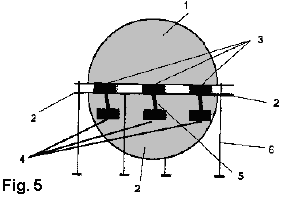 Fig.5 is a side view of the free-space electron-trap. 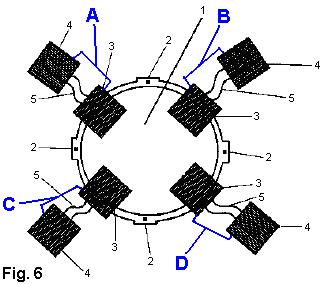 Fig.6 is an underside view of the space electron-trap, with its coils and electromagnets. 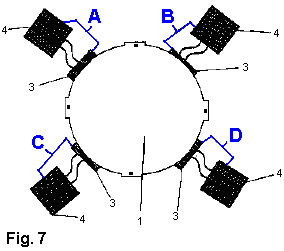 Fig.7 a view from above of the space electron-trap with its coils and electromagnets. 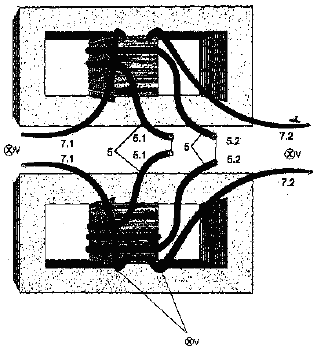 Fig.8 is a perspective view of an electron-trap with its coils.  Fig.9 shows the circuit diagram of the device, indicating the effect of electromagnetic field. 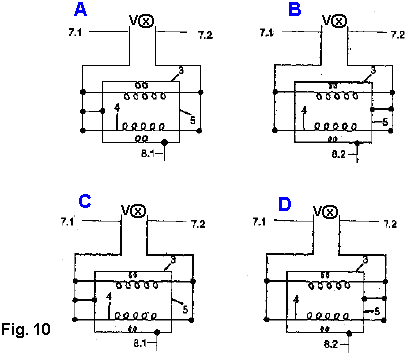 Fig.10 - shows the circuit diagram of the connection of the inductor coils in sets (A, B, C and D). 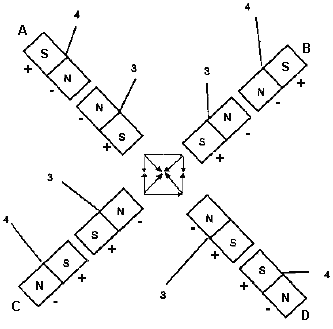 Fig.11 - is an electromagnetic diagram representation of north and south poles of the sets of coils (A, B, C and D).  Fig.12 is a representation of the electrons being attracted and repelled by the device. Detailed Description of the Drawings  Fig.3 is a top view of one of the two hollow metallic hemispheres 1 which is part of the electron trap of free space proposed in this invention. Hemisphere 1 is preferably made from, but not limited to, aluminium, and it has mounting tabs 2.  Fig.4 is a bottom view of metallic hemisphere 1. It has four electromagnetic field generating devices 3, positioned around the hemisphere and fixed to support 6 which is attached to hemisphere 1 by mounting tabs 2.  Fig.5 is a side view of the free space electron-trap. It shows the two metallic hemispheres 1 and 2 (which form an imperfect sphere), and three of the coils 3 which are attached to the mounting tabs 2 and three inductors 4 which form the closed circuit itself, and which are attached by conductors 5, and support member 6 on which are mounted coils 3 and their components.   Fig.6 and Fig.7 show the top and bottom views of the metallic hemisphere 1 which accommodates four coils 3 attached to the holder 6 (not shown) which is secured to the hemisphere 1 by its mounting tabs 2. Fig.6 also shows the inductors or electromagnets 4 their corresponding coils 3 and their interconnecting conductors 5. Each coil 3 and its linked inductor 4 forms a set. In Figures 6 and 7 there are four such sets, marked A, B, C and D. The coils 3, connected by their links 5, each have at least one turn, and if the objective is to generate electricity, then preferably two turns, and if the objective is thermal energy, then four turns. The coils 3 may have various different shapes. The number of turns in the coil 3 are directly related to the amount of current to be generated, and the connecting links 5 may be either a single conductor or more than one conductor, the cross-sectional area of conductor 5 being selected to carry the current which is to be generated. In sets A, B, C and D, the link conductors 5 have at least one turn around coils 3. This winding is connected to the respective electromagnets 4 of each set (A, B, C and D) as shown in Figures 6 and 7. Please note that the inductors and electromagnets 4 can be any type of inductor, and other types of coil may be used.  Fig.8 shows the inter-connecting coils 5 for each of the five sets A, B, C or D linking between coils 3 and 4 in each set. As shown in Fig.6 and Fig.7, the link 5 makes the connection between coils 3 and 4. This means that the wires marked 5.1 are all connected together, and the wires marked 5.2 are all connected together. Doing this, establishes the interconnection links 5 shown in the drawings. The power supply wires marked 7.1 are connected together as are the wires marked 7.2. The wires marked 7.1 are connected to the live phase of the external power supply, while the other ends marked 7.2 are connected to the neutral of the external power supply. In the space free-electron trap of the present invention, the coils 3 can be either single-phase, two-phase or three-phase. Also, the coils 3 may be powered by any voltage (V). The power coil 3 can be energised by any source of electrical energy such as a power grid. The electron-trap can be configured to produce alternating current or direct current. So, if the external power supply is alternating electrical current - AC, then the electron-trap provides an alternating electrical current output. If the power supply is DC, then the electron-trap provides an output of continuous electrical current - DC. The electron-trap can be configured for single-phase, two-phase or three-phase operation, with low, medium or high voltage outputs.  Fig.9 shows an electron-trap circuit diagram with four sets A, B, C and D of inductor coils 3 and 4. Induction is produced around core 9 of the three sets of coils A, B, C and D. The effect of the interaction of the electromagnetic fields 11 is shown. The induction via core 9, causes the circulation of electric current in the links 5, attracting the free electrons through the electromagnetic field of the trap. Then, the electrons join with the current generated by induction on link 5, circulating between the magnetic poles north-south and south-north. By way of example, the coils 3 are shown wound on a single phase column type core, but these can also be of any kind or shape. The electron-trap proposed by the present invention can be constructed with another type of electromagnetic field generating device which has at least one electromagnetic coil or magnet or electromagnetic inductor which can be of any kind or shape, or any combination of those, and with any number in each phase of the electron-trap. The electron capture occurs through an electromagnetic field which is formed with the connection of coils 3 with the electromagnets or inductors 4 through the links 5 between the eight components This closure produces the displacement of the electrons in the coil 3 set (A) (for simplicity, referred to as coil 3A), these electrons are attracted by the protons of coil 3D, and are repelled by the electrons of the electromagnetic field of the coil 3D itself. These coil 3D electrons are attracted by the protons of the coil 3B, and are repelled by the electrons of the electromagnetic field of coil 3B. These electrons of coil 3B are attracted by the protons of coil 3C, and are repelled by the electrons of the electromagnetic field of the coil 3C itself. Similarly, the 3C coil electrons are attracted by protons of the 3A coil, and are repelled by the electrons of the electromagnetic field of the coil 3A itself. These coil 3A electrons are attracted by the protons of the 3D coil, and are repelled by the electrons of the electromagnetic field of the 3D coil itself. Analogously, the coil 3D electrons are attracted by the protons of the coil 3B, and are repelled by the electrons of the electromagnetic field of the coil 3B itself. These 3B coil electrons are attracted by the protons of coil 3C, and are repelled by the electrons of the coil itself induced 3C, and then the coil 3C electrons are attracted by protons of coil 3A, and are repelled by the electrons of the electromagnetic field of the coil 3A itself. That cycle continues as the sets of coils A, B, C and D are being fed by a voltage. These endless attractions and repulsions generate an electric current in the link coil 5. In the electron-trap, the voltage is stable. Regardless of the amount of current generated-which can be very high, the voltage will be the same in the electric circuit of the sensor, because the current moves through the attraction and repulsion of the electrons, regardless of voltage.  Fig.10 illustrates a circuit diagram of the electrical connection between the coils 3 and 4 in sets A, B, C and D. It can be seen that the sets A, B, C and D are enclosed between the coils 3 and their associated inductors or electromagnets 4. The supply conductors 7.1 and 7.2, of sets A, B, C and D must be interconnected. When feeding power to the coils 3 and 4 the phase should be connected to 7.1 and the neutral to 7.2. The sets A, B, C and D after being fed with electric current, generate voltage through the attraction and repulsion of the electrons in the linking coil 5, where there is at least one output load 8.1, which should be connected joining sets A and C, and at least one load output 8.2, which should be connected joining sets B and D. The output points 8.1 and 8.2 are the respective phases and neutral of power points 7.1 and 7.2. In this way, a singl-phase electron-trap is created by two pairs of sets of coils/inductors 3 and 4. The 3/4 electromagnet coil set can be replaced by a 3/3 coil set, without any disadvantage to the electron-trap. Sets A, B, C and D, are inserted into a hollow metal hemisphere 1 preferably constructed from - but not limited to - aluminium. The hemisphere 1, whose function is to concentrate and maximise their electromagnetic fields, simulating an electron cloud, has a fixed support 6 connected to attachment tabs 2, and to which the coils 3 are fixed.  Fig.11 is a diagram of the electromagnetic north and south poles of the inductor coils 3 and 4 of sets A, B, C and D of the electron-trap. The electromagnetic behaviour described for Fig.9 is again demonstrated by the formation of the magnet assembly to the North Pole and South Pole being attracted and repelled by the lines of force of the magnet from the point "A" to point "D", point "A" to point "B", the point "B" to point "C", point "C" to point "A", and so on, as long as there is an electromagnetic field. The electromagnetic field of the space electron-trap provides that induced current in a direction similar to the variations of the magnetic flux that produced it. So, the magnetic field creates a north pole and a south pole in each of the sets A, B, C and D, as shown in Fig.11. By feeding the coils 3 of the electron-trap with a desired voltage a magnetic field is generated in coils 3, between the four sets A, B, C and D, which form a flow of electrons. This flow of electrons augments the electron flow which is circulating in the closed-loop link-coil 5, thus implementing free electron capture from space. The electromagnetic field of the coil 3A runs north to south, the electromagnetic field of the coil 3B runs north to south, the electromagnetic field of the coil 3C flows from south to north, and the electromagnetic field of the coil 3D flows from south to north, as shown in Fig.11. It should be noted that the sets A, B, C and D can be formed by any combination of coil, magnet and electromagnet. The south to north electromagnetic field induces current flow in the coil 3A. The north to south electromagnetic field induces current flow in the coil 3B. The north to south electromagnetic field induces current flow in the coil 3C and The north to south electromagnetic field induces current flow in the coil 3D. The induced current flow can have any power and it can be single-phase, two-phase or three-phase current.  Fig.12 shows the electrons being attracted and repelled by the induction coils 3 and 4. Being repelled and attracted by electromagnetic induction, the electric current flows without resistance. The electron-trap produces electromagnetic waves which can be used for various purposes, including signal transmission at any frequency and for any purpose. The capture is caused by these electromagnetic waves. The same physical effect can be achieved by the combination of the capture devices of other technologies, including electromechanical, electric, electronic, electromagnetic, or through the combination of a magnet or any other magnetised materials. The space free electron-trap of the present invention is a renewable source of electrical power production and a new way of generating energy through the capture effect, generating flows of electrons, generating ordered movement of electrons - electric current - as shown in Figures 9, 11, and 12. Electrons can move without any voltage difference in the continuous loop 5. Alternatively, the loop may be biased with any chosen voltage. The relevant Barbosa and Leal patents in Portuguese can be downloaded here: http://www.free-energy-info.tuks.nl/Barbosa1.pdf http://www.free-energy-info.tuks.nl/Barbosa2.pdf http://www.free-energy-info.tuks.nl/Barbosa3.pdf. Ultra-simple Free energy System from Lorrie Matchett The style of operation used by Barbosa and Leal looks as if it is related to the developments of Lorrie Matchett. On 16th June 2008, Lorrie Matchett published his very simple design for a device which captures usable free-energy (video: YouTube). His device is based on a very simple and well-know principle of static electricity. This is a principle which is taught in schools all around the world but is generally considered to be of no importance as static electricity is considered too low-power to be of any use. I seriously doubt that anyone who has been struck by lightning would consider static electricity to be “low-power” and suggesting that to them is likely to expand your vocabulary with some words which are seldom heard. Important Note: the following details mention the use of mains voltages and so let me stress that this presentation is for information purposes only and must not be construed as being a recommendation that you construct or use any such device. Should you choose to ignore this and construct and use Lorrie Matchett’s device, then please be fully aware that you do so entirely at your own risk and nobody else is in any way responsible for the results of what you do. The principle which is being used here is that an electrically charged object causes the migration of opposite charges on the surface of any object brought close to it. For example if a charged surface if brought close to a metal sphere, then this happens: 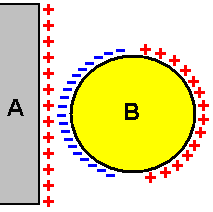 The ordinary metal sphere “B” which has no particular charge on it is very much affected by being close to a charged surface “A” and the closer it gets, the greater the effect. The surface of the sphere had an even distribution of positive and negative charges on its surface, giving it an overall charge of about zero, but the charged surface changes all that. The positive charges on surface “A” attract the negative charges on the surface of the sphere causing them to migrate towards surface “A”. While the positive charges on surface “A” do repel the existing positive charges on the surface of the sphere, the migrated negative charges of the sphere itself have an even greater effect, causing the segregation of electrical charges shown above. The situation returns to normal if the sphere is moved away again. However, the situation changes considerably if the metal sphere “B” is connected to the ground: 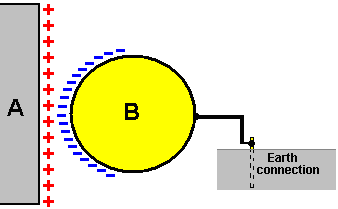 The movement of charges on the surface of the sphere is the same as before, but the Earth has millions of spare charges of both kinds and so, immediately siphons off the excess positive charges on the side of the sphere away from charged surface “A”. You will notice that charged surface “A” is not directly involved in any way and no charge moves from “A” to “B”. The same effect is seen if the surface “A” is negatively charged (except for the fact that the sphere has positive charges rather than the negative charges shown above. The only current flow is along the wire connecting the sphere to the earth connection. Lorrie Matchett uses this principle, and for the charged surface he connects one end of a brass rod to the ‘Live’ side of a 100V 60 Hz mains electricity supply. The other end of the brass rod is not connected to anything else. This produces this situation for 8.3 milliseconds: 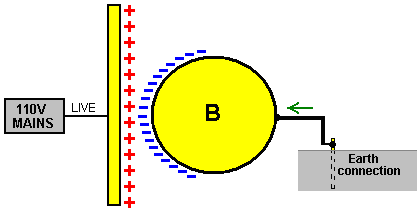 And then for the following 8.3 milliseconds the mains reverses and you get this situation: 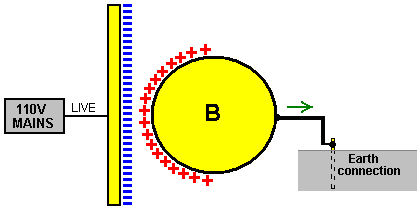 The result of this is that there is a backwards and forwards flow of static electricity along the earth connecting wire, a flow which reverses direction sixty times per second. This is not conventional electricity but is the same form of electricity which is collected by an aerial. Nikola Tesla’s patents show many different ways of utilising this static electricity, as does Herman Plauson in his patent (www.free-energy-info.com/Chapter7.pdf). Thomas Henry Moray produced fifty kilowatts of continuous power from quite a small aerial. Paul Baumann of the Swiss commune produced several kilowatts from static electricity. Lorrie Matchett settles for just a few watts and he does it like this: He connects the live wire of a 110V (RMS) AC mains supply to a brass rod 28-inches (710 mm) long and 3/16 inches (4.76 mm) in diameter. The rod is not directly connected to anything else and so does not form part of a closed loop circuit and so, no current flows from the mains. It must be stressed that the rod and connecting wire are potentially very dangerous and need to be insulated very carefully to ensure that touching them will not cause an electric shock. Please understand very clearly that as no current of any kind is drawn from the mains that this circuit is not “stealing electricity from the mains”. For convenience, and only for convenience, Lorrie uses the earthing system of the house mains supply by connecting a green earthing wire to the earth pin of his mains plug. It needs to be clearly understood that this has nothing directly to do with the mains supply and any good quality separate earth would be at least as good as the earthing point inside the mains plug. Effectively, there is only one mains connection. Instead of using a metal sphere as shown in the illustrations above, Lorrie uses a coil of wire wound around the insulation layer on his brass rod, and he passes the alternating flow of static electricity, drawn from the earth, through a standard diode bridge as shown here: 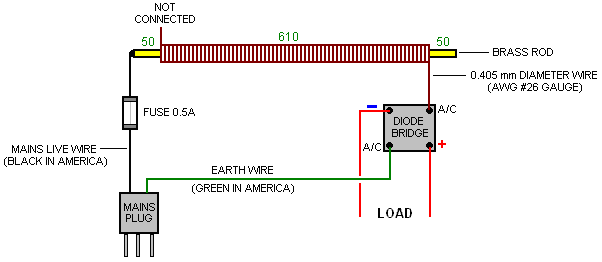 Lorrie covers the brass rod with insulation which is as thin as possible. He suggest heat-shrink tubing for the insulation and on top of it he winds 0.405 mm diameter, solid-core enamelled copper wire, covering a 24-inch (610 mm) length of the rod, placing the turns closely side by side and leaving 2-inches (50 mm) clear at each end of the rod. Thicker wire should not be used. He also shows a 500 milliamp fuse in the mains supply line. I am not at all happy about that as that fuse can power five incandescent 100-watt mains bulbs connected in parallel, and do you really want that amount of power flowing through you if your insulation is not good enough and you touch it? If you use a fuse in that position I would suggest a 20 mm glass quick-blow 100 mA fuse (mainly because no smaller one is readily available). The fuse is not needed for the circuit and is there in an attempt to protect careless humans. The coil wound on the insulated brass rod is only connected at one end and that end goes to one of the two “Alternating Current” tags on a 3A diode bridge. Lorrie does not specify the voltage rating for the diode bridge, but it needs to be a minimum of 170-volts if the mains is a 110V (RMS) type, and double that for a 220V (RMS) mains connection. I have no idea why he specifies a 3-amp rating, but the minimum bridge available locally at 3-amps which I would recommend is a 400V rated unit which is supplied at trivial cost. We need to understand the effect of the diode bridge. It halves the available voltage and doubles the frequency as illustrated here:  A 110V supply is supposed to swing from Minus 155V to Plus 155V and back again sixty times per second, which is an overall voltage swing of 310V. When passed through a diode bridge that changes to a voltage waveform which swings from Zero volts to Plus 154V and back again 120 times per second, which is an overall voltage swing of 154V which is an average or “RMS” voltage of 109V due to the sine wave shape. In the rest of the world, the mains voltage is 220V (RMS) nominal, alternating fifty times per second and the Live mains wire is colour coded brown in the UK and the earth wire yellow/green stripes. In passing, the Neutral wire is white for the American 110V system and blue for the 220V system used in the UK. This design has been brought to my attention by Jes Ascanius of Denmark who is a very able developer of all kinds of free-energy designs. He has replicated this design of Lorrie Matchett and confirms that it works. He has also taken the design further and shares some of the practical details which he has discovered through his own experimentation: For greater power, additional rods can be used: 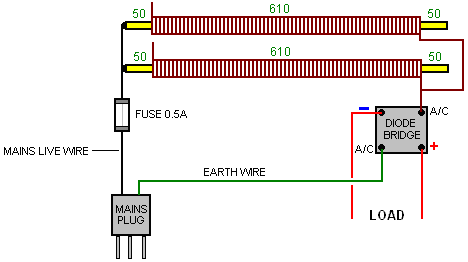 While brass is considered to be the best material for the rod, the diameter is not critical in any way and any size from 5 mm to 20 mm can be used and instead of a rod, a length of brass pipe should be quite suitable. It is also possible to use other materials for the rod but doing that reduces the output power available. Jes has checked the output of his implementation with the mains fuse removed. The result was an output voltage of 2.6V picked up from the many 220V 50Hz signals generated by the mains wiring all around the place for lighting and sockets. When the fuse is inserted, the voltage rises immediately to 129V with two rods or 162V with five rods. When that voltage is loaded with a 7-watt LED lighting array, the voltage gets pulled down to 61V, but good lighting is being produced for zero current draw from the mains. I would expect that putting a reasonably large capacitor across the load, that the reservoir effect of the capacitor would improve the LED output. Jes has a video of this here. Jes initially used two long rods wound with coils: 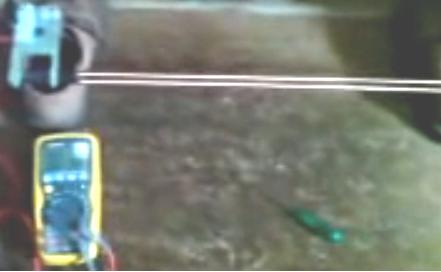 And later, five rods. His AC ammeter is sensitive enough to show that due to inefficiencies caused by the tiny stray capacitance between the rods and the coils, there is a very slight current draw from the mains. The mains wattage is far less than the output wattage of the system. An improvement implemented by Jes is adding four high-speed BYV27 diodes to the ordinary diode bridge like this: 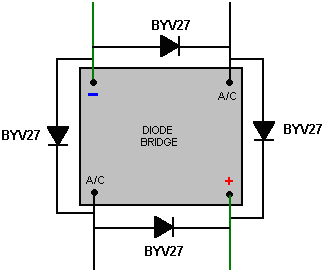 This has the effect of improving the action of the diode bridge and allows more power to extracted from each cycle of the energy flow. When using two brass rods, Jes gets his 5-watt LED array to light up like this:  Lorrie also extended his development to a remarkable 48 rods: 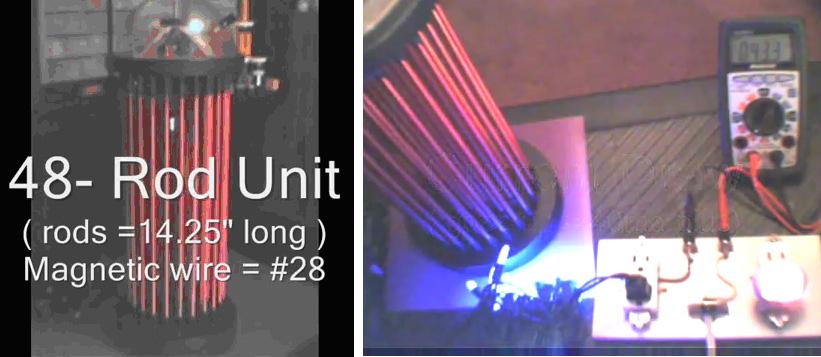 Video link. The electrical output could be used to charge batteries. Adding extra turns does not increase the output voltage. If the number of turns in each coil matches the output load, then the output power will be greater Alexkor in Russia, who is expert in recharging batteries has experimented with this concept and he uses ten coils connected in parallel. He does not use brass, but instead uses the much shorter 300 mm long, 3 mm diameter welding rods with their chemical coating removed. Also, these rods are only used to raise the effectiveness of two separate coils wound on each rod. Each coil is 700 to 750 turns of 0.4 mm diameter wire and the connections are made to the coils and not the rods, as shown here for a single coil pair : 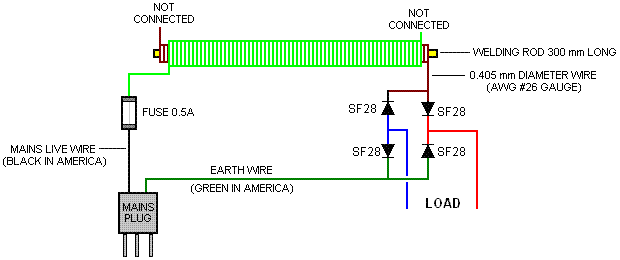 Alex isolates his set of 10 coil-pairs inside a short length of plastic piping:  and uses them to power his battery-charging circuit:  Theodore Annis & Patrick Eberly have produced a variation on this multiple-magnetic-path method which is shown in their US Patent Application 20090096219. They have opted to use a motionless reluctance switch which is a solid-state device which can block magnetic flow when energised. They have arranged one of their devices like this: 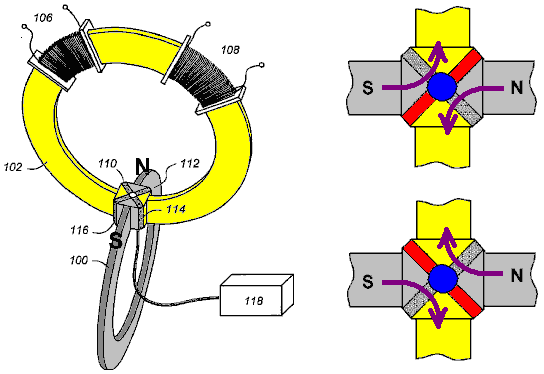 The ring shown in grey is a magnet which connects to the ring shown in yellow through two diagonal ‘reluctance’ (magnetic flow) switches. The yellow ring can carry magnetic flux and the control box marked 118 switches the diagonal strips on and off in turn, causing the magnetic flux to reverse it’s direction through the yellow ring. The coils wound on the yellow ring pick up this reversing magnetic flux and pass it out as an electric current. While only one pair of rings are shown here, the design allows for as many rings as are needed to be connected together as shown here:  The patent says: "The currently preferred motionless reluctance switch is described by Toshiyuki Ueno & Toshiro Higuchi, in their paper entitled "Investigation of the Dynamic Properties of a Magnetic Flux Control Device composed of Laminations of Magnetostrictive Piezoelectric Materials" - University of Tokyo 2004. As shown in Fig.4, this switch is made of a laminate of a Giant Magnetostrictive Material 42, a TbDyFe alloy, bonded on both sides by a Piezoelectric material 44, 46 to which electricity is applied. The application of electricity causes the reluctance of the piezoelectric material to increase. 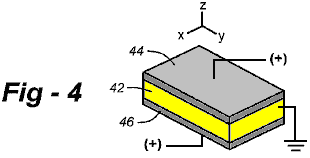 The full patent application is included in the Appendix. However, very interestingly, there is another, completely different patent application from Annis and Eberly, with the same publication date and the same number. It is not at all obvious to me how that could be, but here is the bulk of that other patent application (the original being in the Appendix) BASED UPON MAGNETIC FLUX SWITCHING Abstract In an electrical energy generator, at least one permanent magnet generates flux and a magnetisable member forms the single flux path. An electrically conductive coil is wound around the magnetisable member, and a plurality of flux switches are operative to sequentially reverse the flux from the magnet through the member, thereby inducing electrical current in the coil. A “Figure of Eight” construction comprises two continuous loops of magnetisable material sharing a magnetisable member common to both loops. An alternative configuration uses stacked loops and a separate piece of material acting as the magnetisable member. One end of the magnet is coupled to one of the loops, with the other end being coupled to the other loop. Each loop further includes two flux switches operated in a 2 × 2 sequence to sequentially reverse the flux through the magnetisable member. A relatively small amount of electrical power is used to control the magnetic flux of a permanent magnet by switching the flux between alternate paths. The resulting power from the switched magnetic flux yields substantially more power than the power required for the input switching. Description FIELD OF THE INVENTION This invention relates generally to energy generation and, in particular, to methods and apparatus wherein magnetic flux is switched through a flux path to produce electricity. BACKGROUND OF THE INVENTION Magnetic flux may exist in “free-space,” in materials that have the magnetic characteristics of free-space, and in materials with magnetically conductive characteristics. The degree of magnetic conduction in magnetically conductive materials is typically indicated with a B-H hysteresis curve, by a magnetisation curve, or both. Permanent magnets may now be composed of materials which have a high coercively (Hc), a high magnetic flux density (Br), a high magneto motive force (mmf), a high maximum energy product (BHmax), with no significant deterioration of magnetic strength over time. An example is the NdFeB permanent magnet from VAC of Germany, which has an Hc of 1,079,000 Amperes/meter, a Br of 1.427 Tesla, an mmf ranging up to 575,000 Ampere-turns, and a BHmax of 392,000 Joules/meter3. According to Moskowitz, “Permanent Magnet Design and Application Handbook” 1995, page 52, magnetic flux may be thought of as flux lines which always leave and enter the surfaces of ferromagnetic materials at right angles, which never can make true right-angle turns, which travel only in straight or curved paths, which follow the shortest distance, and which follow the path of lowest reluctance (resistance to magneto motive force). Free space presents a high reluctance path to magnetic flux. There are many materials which have magnetic characteristics similar to those of free space. There are other materials which offer a low or lower reluctance path for magnetic flux, and it is these materials that typically comprise a defined and controllable magnetic path. High-performance magnetic materials for use as magnetic paths within a magnetic circuit are now available and are well suited for the (rapid) switching of magnetic flux with a minimum of eddy currents. Certain of these materials are highly non-linear and respond to a “small” applied magneto motive force (mmf) with a robust generation of magnetic flux (B) within the material. The magnetisation curves of such materials show a high relative permeability (ur) until the “knee of the curve” is reached, at which point ur decreases rapidly approaching unity as magnetic saturation (Bs) is reached. Some of these non-linear, high-performance magnetic materials are referred to as “square” due to the shape of their B-H hysteresis curves. An example is the FINEMET® FT-3H nanocrystalline core material made by Hitachi of Japan. Other examples include Superperm49, Superperm80, SuperMalloy, SuperSquare80, Square50, and Supermendur, which are available from Magnetic Metals in the USA. A “reluctance switch” is a device or means that can significantly increase or decrease (typically increase) the reluctance of a magnetic path. This is ideally done in a direct and rapid manner, while allowing a subsequent restoration to the previous (typically lower) reluctance, also in a direct and rapid manner. A reluctance switch typically has analogue characteristics. By way of contrast, an off/on electric switch typically has a digital characteristic, as there is no electricity “bleed-through.” With the current state of the art, however, reluctance switches exhibit some magnetic flux bleed-through. Reluctance switches may be implemented mechanically, such as to cause keeper movement to create an air gap, or electrically by various other means. One electrical reluctance switch implementation uses a control coil or coils wound around a magnetic path or a sub-member that affects the path. U.S. Navy publication, “Navy Electricity and Electronics Series, Module 8 -Introduction to Amplifiers” September 1998, page 3-64 to 3-66 describes how to modulate alternating current by changing the reluctance of the entire primary magnetic path by these means, one of which is used in a saturable-core reactor and the other in a magnetic amplifier. Flynn, U.S. Pat. No. 6,246,561; Patrick et al., U.S. Pat. No. 6,362,718; Pedersen, U.S. Pat. No. 6,946,938; Marshall, and US Patent Application 2005/01256702-A1 all disclose methods and apparatus that employ this type of reluctance switch for switching magnetic flux from a stationary permanent magnet or magnets for the purpose of generating electricity (and/or motive force). Another electrical means of implementing a reluctance switch is the placement within the primary magnetic path of certain classes of materials that change (typically increase) their reluctance upon the application of electricity. Another electrical means of implementing a reluctance switch is to saturate a sub-region of a primary magnetic path by inserting conducting electrical wires into the material comprising the primary magnetic path. Such a technique is described by Konrad and Brudny in “An Improved Method for Virtual Air Gap Length Computation,” in IEEE Transactions on Magnetics, Vol. 41, No. 10, October 2005 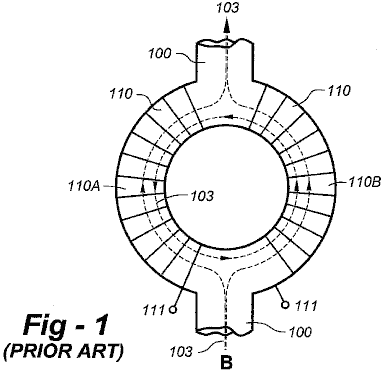 Another electrical means of implementing a reluctance switch is described by Valeri Ivanov of Bulgaria on the web site www.inkomp-delta.com, shown in Fig.1. An electric toroid 110 is inserted into a primary magnetic path (100), so that the primary magnetic path is divided into two sub-paths 110A and 110B. A net magnetic flux reduction effect in the primary magnetic path 100 results from the combination of the effects in the two sub-paths 110A and 110B, each of which results from different physics principles. In the first sub-path 110A, the magnetic flux generated by applying electrical current to the windings 110 around toroidal path 110 opposes and subtracts from its portion of the magnetic flux 103 received from the primary magnetic path 100 yielding a reduced magnetic flux, which is also further reduced by a decrease in the sub-path 110A's relative permeability thereby increasing the reluctance of the sub-path. In the second sub-path 110B, the magnetic flux generated by applying electrical current to the toroid windings 111 adds to its portion of the magnetic flux 103 received from primary magnetic path 100 yielding an increased net magnetic flux that approaches or exceeds the knee of the material's magnetisation curve thereby reducing its relative permeability and increasing its reluctance. SUMMARY OF THE INVENTION This invention is directed to methods and apparatus where magnetic flux is switched in both direction and intensity through a flux path to produce electricity. The apparatus broadly comprises at least one permanent magnet generating flux, a magnetisable member forming the flux path, an electrical conductor wound around the magnetisable member, and a plurality of flux switches operating to reverse sequentially, the flux from the magnet flowing through the member, thereby inducing electrical current in the coil. 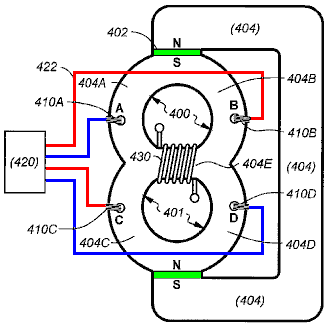 The preferred embodiment includes first and second loops of magnetisable material. The first loop has four segments in order A, 1, B, 2, and the second loop has four segments in order C, 3, D, 4. The magnetisable member couples segments 2 and 4, and the permanent magnet couples segments 1 and 3, such that the flux from the magnet flows through segments A, B, C, D and the magnetisable member. Four magnetic flux switches are provided, each controlling the flux through a respective one of the segments A, B, C, D. A controller is operative to activate switches A-D and B-C in an alternating sequence, thereby reversing the flux through the segment and inducing electricity in the electrical conductor. The flux flowing through each segment A, B, C, D is substantially half of that flowing through the magnetisable member prior to switch activation 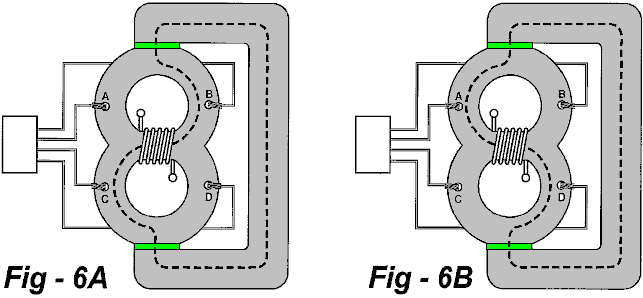 The loops and magnetisable member are preferably composed of a nanocrystalline material exhibiting a substantially square BH intrinsic curve. Each magnetic flux switch adds flux to the segment it controls, thereby magnetically saturating that segment when activated. To implement the switches, each segment may have an aperture formed through it and a coil of wire wound around a portion of that segment and through the aperture. The controller may be at least initially operative to drive the switch coils with electrical current spikes. The first and second loops may be toroidal in shape, and the loops may be spaced apart from one another, with A opposing C, and 1 opposing 3, and with B opposing D and 2 opposing 4. The magnetisable member in this case is preferably a separate piece of material. Alternatively, the first and second loops may form a “Figure of eight” shape, with the two loops intersecting to form the magnetisable member. The permanent magnet(s) and the material comprising the magnetic paths are preferably proportioned such that the material through the common segment is at or slightly below its maximum relative permeability before the electrically conducting output coil is energized. In the preferred embodiments, the power resulting from the switched magnetic flux yields substantially more power than the power required for the input switching. BRIEF DESCRIPTION OF THE DRAWINGS Fig.1 is a drawing of a prior art reluctance switch in the form of an electrical toroid inserted into a primary magnetic path; Fig.2 is a detail drawing of a reluctance switch according to the invention; Fig.3A and Fig.3B are detail drawings showing the use of four reluctance switches according to the invention; Fig.4 is a drawing which depicts a preferred embodiment of the invention; Fig.5 is a detail drawing an alternative reluctance switch according to the invention implemented through split laminations; Fig.6A and Fig.6B show the operation of an energy generator according to the invention; Fig.7A is an exploded view of a preferred energy generator construction; Fig.7B is a side view of the construction shown in Fig.7A; Fig.8 is a simplified schematic diagram of components used to simulate the apparatus of the invention; Fig.9A is a diagram that shows the current delivered to one pair of flux switches in the simulation; Fig.9B is a diagram that shows the current delivered to the other set of flux switches in the simulation; Fig.10 shows the output of the simulation shown here; and Fig.11 is a block diagram of a controller applicable to the invention DETAILED DESCRIPTION OF THE INVENTION 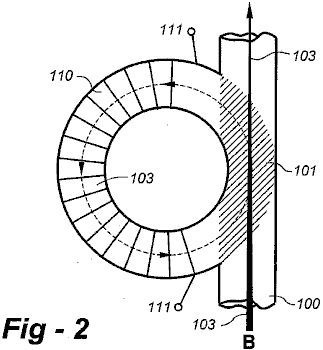 Fig.2 is a detail drawing of a reluctance switch according to the invention. The reluctance switch includes the following components: a closed magnetic path 110 comprised of a high performance magnetic material (preferably a non-linear material exhibiting a “sharp knee” as saturation is approached), around which is wound a coil 111. The closed magnetic path 110 shares a common segment 101 with a primary magnetic path 100, in which magnetic flux 103 is induced by a permanent magnet (shown in subsequent drawings). Electric current is applied to windings 111 having a polarity and sufficient amperage so that the magnetic flux generated in the path of switch 110 is additive to the magnetic flux 103 from the permanent magnet, such that the primary path 110 approaches or reaches magnetic saturation. 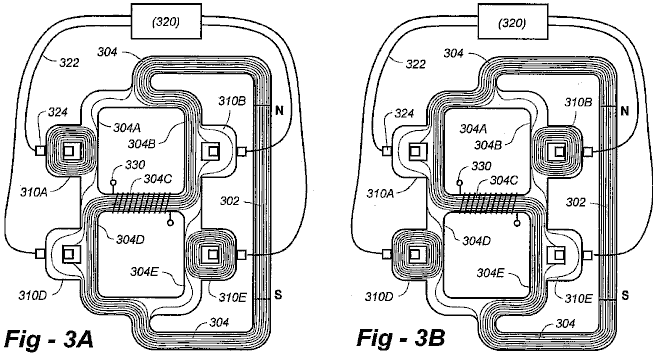 Fig.3A and Fig.3B are detail drawings of an apparatus which employs four reluctance switches according to the invention in a manner similar to that disclosed in U.S. patent application Ser. No. 11/735,746 entitled “Electricity Generating Apparatus Utilising a Single Magnetic Flux Path”, the entire content of which is incorporated herein by reference. In this and in all embodiments described herein, the geometry of the closed magnetic paths may be circular (toroidal), rectangular, or any other closed-path shapes . A primary path 304 carries the flux from permanent magnet 302 unidirectionally. Flux switch pairs 310 A/E and 310 B/D are activated in alternating fashion to reverse the flux in magnetisable member 304C, thereby inducing electrical current in winding 330. Fig.3A shows the flux flow in one direction, and Fig.3B shows it reversed. In Fig.3A, switches 310A and 310E are activated by controller 320 in electrical communication with the windings on the switches such as through conductor 322 to winding 324. The additional flux in switches 310A and 310E are additive with the flux that would otherwise be present in segments 304A and 304E, thereby saturating these paths, causing the flux through segment 304C to be in the direction shown. In Fig.3B, switches 310B and 310D are activated, saturating segments 304B and 304D, and reversing the flow. 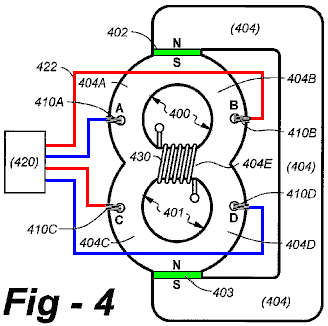 Fig.4 is a drawing that depicts an embodiment of the invention using circular toroids 400, 401 and multiple permanent magnets 402, 403 disposed in the primary path 404. The two toroids 400, 401 intersect, forming magnetisable member 404E. A coil 430 is wound around the member 404E, as shown. The primary magnetic path 404 interconnects the upper end of loop 400 and the lower end of loop 401. One of the magnets, 402, couples one end of the primary magnetic path 404 to the first loop 400, and another, 403, couples the other end of the primary magnetic path 404 to the second loop 401. In this, and all of the embodiments described here, the permanent magnets are strong, rare-earth magnets, and multiple magnets of any length (thickness) may be used in each case. Further, in all embodiments, the loops, primary magnetic path and/or magnetisable member are preferably constructed from a high magnetic permeability material such as the FINEMET FT-3H nanocrystalline soft magnetic material available from Hitachi. The invention is not limited in this regard, however, as alternative materials, including laminated materials, may be used. The connections of the primary magnetic path 404 to the two loops 400, 401 create four segments apart from the magnetisable member 404E, the four segments including two opposing segments A, B in the first loop on either side of magnet 402, and the two opposing segments C, D in the second loop on either side of magnet 403. Four magnetic flux switches are provided, each being operative to control the flux through a respective one of the four segments. A controller 420 is operative to activate the switches associated with segments A and D, and then B and C, alternately, thereby reversing the flux through the member 404E, and so, inducing electrical current in coil 430. 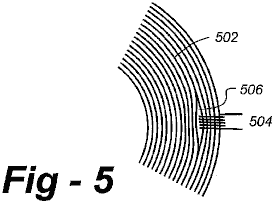 Apertures may be formed through each of the four segments, with the switches being implemented by coils 410A to 410D which pass through the apertures and around an outer (or inner) portion of each segment. As shown in Fig.5, if the loops are fabricated with laminated material 502, the laminations may be split at 506 to accommodate coil 504. The percentage of the segment surrounded by the coil may vary in accordance with the material used, the waveforms presented to the coils, and other factors, with the goal being to magnetically saturate each segment through activation of the associated switch, thereby reversing the flux through path 404E.  Fig.6A and Fig.6B show the operation of the apparatus of Fig.4. The primary path 404 carries the flux from permanent magnets 402 and 403 unidirectionally. Reluctance switches 410A to 410D are activated alternately to reverse the flux in segment 404E which, in turn, induces electrical current in winding 430. Fig.6A shows the flux flow in one direction, and Fig.6B shows it flowing in the opposite direction. In Fig.6A, switches 410A and 410D are activated by controller 420 in electrical communication with the windings on the switches, such as through conductors 422 to switch 410B. The flux provided by switches 410A and 410D, thereby saturating these paths, causing the flux through segment 404C to be in the direction shown. In Fig.6B, switches 410B and 310C are activated, saturating segments 404B and 404D, thereby reversing the flux through path 404E. 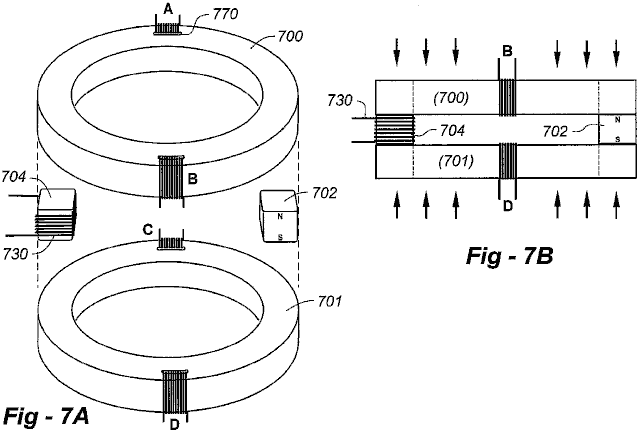 Fig.7A depicts a preferred construction of the apparatus depicted in Fig.4, Fig.6A and Fig.6B. Loops 400 and 401 are implemented as complete toroids 700, 701. This is important, since preferred high-performance magnetic materials are currently available in regular shapes of this kind. Note that, in this case, curved slots such as 770 are formed through the sides of each toroid to implement flux switches A to D. The magnetisable member in this embodiment is implemented with a block of material 704, preferably the same high-performance magnetic material used to construct loops 400, 401. Permanent magnet 702, shown at 702, preferably has the same length as block 704, enabling the various constituent parts to be held together with compression, shown in Fig.7B. The following sections summarise some of the important characteristics of the preferred embodiments: In terms of materials, the apparatus benefits from the use of nanocrystalline material with a “Square” BH intrinsic curve, a high Br (remanence) which is about 80% of its Bs (saturation), a low Hc (coercivity), and a fast magnetic response time to saturation. An example is FineMet FT-3H from Hitachi of Japan, which has a Br of 1.0 Tesla, a Bs (saturation) of 1.21 Tesla, a time to saturation (Bs) of 2 usec, and an Hc of −0.6 amp-turns/meter. Modern permanent magnets are used with a square BH intrinsic curve, a Br in the range of 1.0 Tesla or more, and high Hc in the range of −800,000 amp-turns/meter or more. An example is the NdFeB magnet from the German company VAC, which has a Br of 1.427 Tesla and an Hc of −1,079,000 amp-turns/meter. An important consideration is the matching of the magnet to the nanocrystalline material, both in Tesla rating and in cross-sectional area. The magnet's Br should be below the Bs of the nanocrystalline material. If the magnet is too “strong” for the nanocrystalline material, this may cause the nanocrystalline material to saturate at the area of contact with the magnet. The current driving the reluctance switches in the prescribed 2 × 2 sequence should have a sharp rise in the leading edge (Tr) of each pulse with a pulse width (Pw) and Amperage value that are sustained until released at the end of the pulse width (Tf). The table below shows the effects of input current pulse rise times (Tr) on the output. There exists a narrow band of Tr, before which there is small power output, at which there are excellent power output and COPs in the range of 200 to 400 or greater, and after which there is no major increase in power output. The COP of this device without the coupling circuit is defined as “Output power/Drive Power” for the switches. 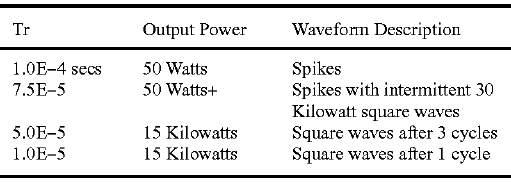 Richard Willis. On 28th May 2009 a European Patent application was filed by Richard Willis, entitled "Electrical Generator". During a TV interview, Richard stated that his design has COP=3600.  Available commercially from his Canadian company and sold under the name "Magnacoster", early in 2010 his advertised pricing is US $4,200 for a unit which has four separate 100 amp 12V outputs, giving a combined maximum output power of 4.8 kilowatts. A larger unit is priced at US $6,000 with four separate 24V outlets providing a 9 kilowatt combined output. The house-powering unit which is supplied with a 12 kilowatt inverter to provide mains AC power and which gets connected direct to the circuit-breaker box of the house, is priced at US $15,000. One particularly interesting statement made by Richard is that the output power is at a higher frequency than the input power. He suggests that the electrical signal bounces around inside the device, multiplying the power as it goes and giving the output higher voltage and higher current than the input. The design of the device is most interesting as it is very simple. It is shown in his patent application WO 2009065219, a somewhat reworded copy of which is included in the Appendix to this eBook. Richard's web site is here. However, while Richard’s designs do indeed work, he appears to be experiencing problems with the output wiring melting due to the very high current, and more importantly, the generation of high levels of unwanted electromagnetic radiation. These problems appear to have prevented him from supplying any commercial units at this time.
Available commercially from his Canadian company and sold under the name "Magnacoster", early in 2010 his advertised pricing is US $4,200 for a unit which has four separate 100 amp 12V outputs, giving a combined maximum output power of 4.8 kilowatts. A larger unit is priced at US $6,000 with four separate 24V outlets providing a 9 kilowatt combined output. The house-powering unit which is supplied with a 12 kilowatt inverter to provide mains AC power and which gets connected direct to the circuit-breaker box of the house, is priced at US $15,000. One particularly interesting statement made by Richard is that the output power is at a higher frequency than the input power. He suggests that the electrical signal bounces around inside the device, multiplying the power as it goes and giving the output higher voltage and higher current than the input. The design of the device is most interesting as it is very simple. It is shown in his patent application WO 2009065219, a somewhat reworded copy of which is included in the Appendix to this eBook. Richard's web site is here. However, while Richard’s designs do indeed work, he appears to be experiencing problems with the output wiring melting due to the very high current, and more importantly, the generation of high levels of unwanted electromagnetic radiation. These problems appear to have prevented him from supplying any commercial units at this time.
The circuit is based on a pulsed coil and two magnets and it has a number of unusual features. The power supply is unusual:  Richard arranges it like this so that either DC or AC can be used as the input power and so he follows that arrangement with a diode bridge, followed by two more diodes as shown here: 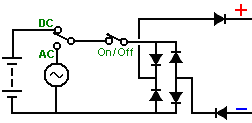 This is an interesting arrangement when the input is DC as it would be a more usual arrangement to have the diode bridge only in the AC input section and not included for the DC input where it just drops the input voltage and wastes electrical power unnecessarily. Still, that is the way it is shown in the patent, so that is the way it is shown here. The input power supply is fed to an electromagnet but is converted into a pulsed supply by the use of an interrupter switch which may be mechanical or electronic: 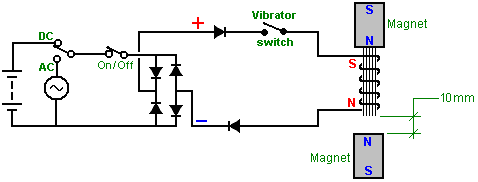 As can be seen, the arrangement is particularly simple although it is an unusual configuration with the electromagnet core touching one of the permanent magnets and not the other. The magnet and electromagnet poles are important, with the permanent magnet North poles pointing towards the electromagnet and when the electromagnet is powered up, it's South pole is towards the North pole of the permanent magnet which it is touching. This means that when the electromagnet is powered up, it's magnetic field strengthens the magnetic field of that magnet. There is a one-centimetre gap at the other end of the electromagnet and it's North pole opposes the North pole of the second permanent magnet. With this arrangement, each electromagnet pulse has a major magnetic effect on the area between the two permanent magnets. In the diagram shown above, just a few turns of wire are shown on the electromagnet core. This is just for clarity and it does not mean that only a few turns should be used. The strength of the magnets, the electromagnet wire thickness and number of turns are related to each other and experimentation will be needed to determine the best combination. The energy take-off from this device is shown here: 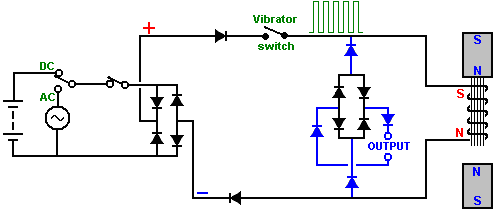 Richard states that the input power can be anywhere from under one volt to one million volts while the input current can be anything from under one amp to one million amps, so he clearly envisages a major range of constructions and components. The core material for the electromagnet is specified as ferrite, mumetal, permalloy, cobalt or any non-permeable metal material. It seems likely that iron filings embedded in epoxy resin is likely to be a suitable material as it can respond very rapidly to sharp pulses and it seems clear that in common with almost every other similar free-energy device, the rapidity of rise and fall of the power pulse is of major importance. Having said that, Richard states that the frequency of pulses in the output section is greater than the frequency of pulses applied to the input section. From this it seems likely that the device should be tuned so that the input pulses should be at a lower harmonic of the resonant frequency of the device. It is worth reading Richard's full description which is near the end of the Appendix. A second version of the circuit looks like a modification of the John Bedini pulsed rotor battery charging circuit with a rotor substituting for the second permanent magnet:  This enhances the operation of the Bedini device by providing an initial magnetic field in the coil. Silverhealtheu. One of the EVGRAY yahoo forum members whose ID is ‘silverhealtheu’ has described a simple device which appears to be not unlike the Richard Willis generator above.  The device consists of an iron bar one inch (25 mm) in diameter and one foot (300 mm) long. At one end, there is a stack of five neodymium magnets and at the opposite end, a single neodymium magnet. At the end with the five magnets, there is a coil of wire which is strongly pulsed by a drive circuit. Down the length of the bar, a series of pick-up coils are positioned. Each of these coils picks up the same level of power that is fed to the pulsing coil and the combined output is said to exceed the input power. The Motionless Generators of Heinrich Kunel While Richard Willis of Magnacoaster in Canada, has gone commercial with his generators, making each of the generator outputs multiples of 12V 100A, a lot of very interesting earlier information can be found in the 1982 patent of Heinrich Kunel. The patent describes four separate configurations of his basic design, a design which looks very much like that used by Richard Willis. Here is an attempted translation of the Kunel patent which is in German: PROCEDURES AND DEVICES FOR ENERGY PRODUCTION Application Number: DE19803024814 19800701 Priority Number(s): DE19803024814 19800701 IPC Classification: H02N11/00 EC Classification: H02K53/00 DESCRIPTION The invention concerns procedures and devices for energy production, which convert the magnetic flux from permanent magnets, without the need for rotary, or any other form of motion, into temporally variable induced flux and produce large fluctuations of the induced magnetic flux into electric current, without the need for a thermal circuit, or torque or chemical process, and in such a manner that the electric current is amplified. The energy problems of our time are sufficiently well-known in the professional world. The transformation of conventional primary energy forms into technically usable energy is relatively cost-intensive. Additionally, by doing this, precious and ever scarcer raw materials are being destroyed and pollutants are accumulated, pollutants which are able to cause the end of mankind. In order to reduce or avoid these and other disadvantages during power production, it is suggested according to this invention, that for the production of electric current by induction, no torque is used, but instead, the magnetic flux from permanent magnets is converted into an induced flux with large rapid variations, e.g. into a rapidly changing or pulsating induced flux, which can generate an electric current. In accordance with this invention, one proceeds from the basic arrangement where a permanent magnet is connected to an iron core via one or both of its poles, the core consisting of, for example, dynamo iron, pure iron or amorphous iron or any similar suitable material which has little or no core losses. Following the procedure of this invention if, for example, one pole of a bar magnet touches such an iron core and is aligned with the longitudinal axis of that core, then both the magnet and the core act as a magnet. During this initial magnetisation process of the core a magnetic flux flows in the core, which induces a current in a conducting circuit surrounding the core. If, in addition to the permanent magnet, a coil is wound around the core, and arranged in such a way that a current flowing in that coil wholly or partially interrupts the magnetic flux flowing through the core, then this causes another modification of the magnetic flux passing through a coil wound around the core. If this interruption of the flux flowing from the permanent magnet is large, and has the waveform of a Alternating Current, then a pulsating Direct Current is induced in the coil wound around the core. With an AC input to the magnetic flux modifier coil wound on the core beside the magnet, the coil receives two current flow direction changes per AC cycle, and so the magnetic flux coming from the permanent magnet is interrupted once and released once during each input power cycle. In this way, a pulsating induced Direct Current is generated in the output coil caused by the pulsating magnetic flux in the core. It was found that the induced flux from a permanent magnet achieves its full initial value of the magnetic flux density in the core also at the free end of the soft-iron magnetic core, even if there are several induction windings each with the same number of turns and the conductor cross section are appropriate as in a magnetic flux modification coil wound on the core, without changing the strength of the magnetic flux density or the remanence of the permanent magnet. The permanent magnet is not demagnetised when used to provide the flux in the core, no energy is extracted from it, unlike an electromagnetic core, whose windings require more operating current than that produced as an output. With an electromagnetic core, as much input current is required, as is induced in the output winding, corresponding to the relationships of the well-known transformer. Therefore it is important to produce the induction flux by using a permanent magnet. After the basic primary system, one can build e.g. energy linear generators or energy circle generators or other arising or suitable types and forms of energy generators, without the necessity of a rotor or a stator or any such mobile sections or providing torque in the generator. The invention is so designed as to make only frequency control governed by electrical means so that the internal induction flux in the generator core is essentially caused by the magnetic field of the permanent magnet. In the drawings constructional examples are schematically represented according to the invention: Fig.1 shows a linear energy generator in longitudinal cross-section.  Fig.2 shows a linear energy generator in the instantaneous state of the transmission of the induction flux of the permanent magnet to the generator core and  Fig.3 represents a linear energy generator at the moment of the interruption by the induced flux;  Fig.4 explains a static energy pulse generator with a closed magnetic circuit at the moment the transmission of the induction flux of the permanent magnet to the generator core block, 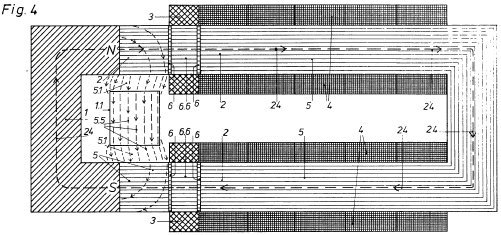 Fig.5 is a schematic diagram of the functional way in which the feedback process operates in a system according to the present invention,  Fig.6 shows a double linear energy generator with some of its sub-elements and  Fig.7 shows an energy generator, according to the present invention, with cyclic pulsing operation and with some of its sub-elements in and at the energy circuit. 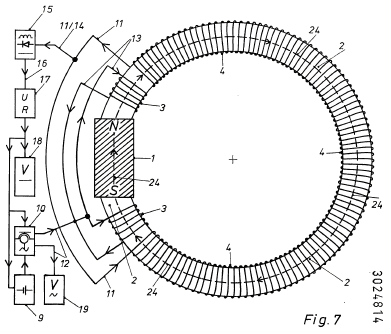  The linear energy generator shown in cross-section in Fig.1, consists of a permanent bar magnet 1 with a soft-iron magnetic generator core 2, which can be a single piece, or, as shown here, divided into two sections. The magnetic flux modification coil is not directly attached to the permanent magnet 1, so that the permanent magnet 1 is not subjected to the alternating fields produced by the magnetic flux modification coil 3. On the generator core 2, following the magnetic flux modification coil 3, there are several output coils 4. An air gap 6 serves as a gate or circuit-breaker for the magnetic flux coming from the permanent magnet 1 and the magnetic induction flux for the induction windings 4.  With this arrangement, an alternating current applied to the magnetic flux modification coil 3 is used to produce an alternating magnetic field in the air-gap 6, so that, as shown clearly in Fig.2, with each phase of the alternating current the induced magnetic flux 5 is directed first to the core 2 and then against the permanent magnet 1, as shown in Fig.3, causing the magnetic flux 5 induced in core 2 by the permanent magnet 1, is interrupted totally or partially, and thus experiences a modification which varies with time.  If an alternating current is supplied to the magnetic flux modification coil 3 e.g. with a frequency by 50 Hz, then the induced flux 5 in core 2 experiences one hundred modifications per second, inducing in the induction windings 4 a pulsating direct current 14 which has 50 positive maximum values per second.  Fig.2 illustrates that on the generator core 2 several induction windings 4 are wound, which correspond to the number of turns with same wire diameter as used in the magnetic flux modification coil 3. The permanent magnet 4 requires no electric current to produce its magnetic flux and nevertheless has at its North Pole end N of the core 2 the same magnetic saturation, as produced by the multiple number of turns of induction coil 4 of Fig.2 or in a continuous coil 4 as shown in Fig.3, receives a multiple version of the input current which is needed for the excitation of the magnetic flux modification coil 3. From the power source 9 the energising current flows to the pulse generator 10, the 1-amp ammeter 20 displays the intensity of the electric current. The induced current 7 or the pulsating direct current 14 is added via connections 11,1 and is measured by the 10-amp ammeter 20,2. The rectifier 15 (not shown) produces pulsating Direct Current which is smoothed and supplied as the DC output 18, through wire 21 to the battery charger 25, which provides the input for the power source 9.  The interruption of the magnetic flux by the direction change of the Alternating Current, necessary for the repeated modification of the induction flux 5, is shown in Fig.3. When the induction flux 5 is interrupted, the wire coil(s) 11.2 is negative in that instant. Wire 21 provides the connection to the output power (not shown) and the input power source 9. 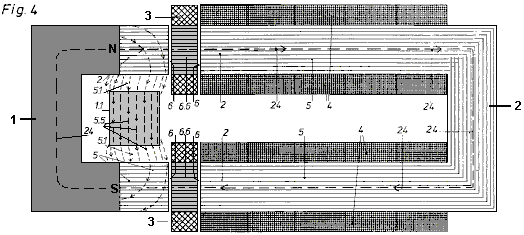 Fig.4 shows an embodiment of the above design which uses a U-shaped permanent magnet 1 and a U-shaped generator core 2 which has its two ends facing towards the poles of the permanent magnet 1. Wound around two narrow air gaps 6 and its own narrow core, is a magnetic flux modification coil 6.6. Fig.4 shows the instantaneous state, when the magnetic flux 5 is transferred from the magnetic flux modification coil 3 into the generator core 2 forming a closed magnetic circuit 24. The magnetic flux modification coil 3 here has a core 6.6, which alternately makes and interrupts the passage of the magnetic flux 5 between two narrow air gaps 6 from the permanent magnet 1 to the generator core 2 which has the induction windings 4, so that each pulse of the induction flux 5 induces a current in the induction windings 4. Thus a pulsating Direct Current results which is several times larger than the input energising current. When the direction of current flow in the soft-iron magnetic core 6.6 of the magnetic flux modification coil 3 is changed, then at that time, the magnetic flux 5 of the permanent magnet 1 flows over into the iron guidance block 1.1 and flows along the paths 5.5 and 5.1 to the South-pole of the permanent magnet 1 or to the equilibrium in the air gaps between the North-pole of iron guidance block 1.1 and the South-pole of the permanent magnet 1. The dashed line 5.5 from North-pole to South-pole through the iron guidance block 1.1 depict the magnetic flow when it is prevented from travelling through the generator core 2. This steering of the magnetic flux 5 prevents leakage flux entering the generator core 2 and so the maximum RMS of the induced current is achieved, as the generator core 2 is without magnetic excitation. PJK note: I have difficulty in accepting this as the excitation coil would appear to produce an equivalent magnetic flux into the U-shaped frame 2 as it blocks the permanent magnet flux passing across the air gaps between magnet 1 and electromagnets 3, and to make things worse, magnetic flux flows about a thousand times more easily through soft iron than through air. However, we do know that modulating the flux from a permanent magnet with the magnetic field from a coil is very effective in producing COP>1 as has been shown by the independent replication of Lawrence Tseung’s magnetic frame covered earlier in this chapter. The following schematic diagram Fig.5, shows the sequence in the cyclic process e.g. in an energy generator according to Fig.4.  The pulsating current from the power source 9 or Alternating Current 12 from the power-grid 23 flows through wire 13 to the magnetic flux modification coil 3 and produces a pulsating induction current 7 or pulsating direct current 14, which is converted by the rectifier 15 to smooth Direct Current 16 which is passed to the voltage regulator 17, and then on as Direct Current 16 now at the desired voltage, on to the DC output 18 and to the current transformer 10, by which the received Alternating Current 12 is led to the AC output 19 and coupled by AC link 22 with the power-grid input 23, whereby the AC output 19 can be supplied with current from the power-grid or from the electric output of the energy generator. 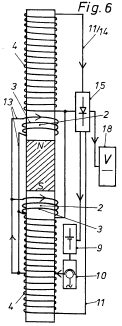 Fig.6 shows a double linear generator in accordance with the invention. On a preferably straight-line permanent magnet are fitted generator cores 2 of dynamo iron to its two poles. The magnetic flux modification coil 3 gets its working current from the power source 9 through a current transformer or from pulse generators 10 fed by the excitation circuit 13. Through appropriate windings 4 an output of either Direct Current or Alternating Current can be obtained. Pulsating Direct Current 14 from the induction current circuit 11 is smoothed and passed to the DC output 18 and to the input power source 9.  A further version of the system in accordance with the invention is shown in Fig.7. This is also a motionless energy producer, although it has a cyclic arrangement and function. In this generator there are no mobile sections such as a rotor and the induction flux 5, like the induction current 7, develops from a cyclically pulsating induction flux. The permanent magnet 1 is inserted into a circular generator core 2. The magnetic flux modification coils 3 can be operated with pulsating Direct Current 14 or as here with Alternating Current 12. For example, the Direct Current 16 from the power source 9 is led into a current transformer 10 converted into Alternating Current and fed into the exciter circuit 13. The magnetic flux modification coils are created so that the positive maximum value of the Alternating Current 12 opens and supports the natural flow of the permanent magnet flux 5 passing from the North-pole to the South-pole through the circular generator core 2 to form a closed magnetic circuit 24. If the magnetic flux modification coils 3 on both sides of the permanent magnet 1 carry the maximum negative value of the Alternating Current 12, then the natural magnetic flux in the generator core 2 is constricted by induction flux moving in the opposing direction in the magnetic flux modification coils 3 and this interrupts the magnetic flux 5 either totally or partially. In the case of temporally large modification of this sequence in the coil 4 a pulsating direct current 14 is caused, which is led by the induction circuit 11 to the electric rectifier 15, in which the pulsating direct current 14 is reduced to a smooth DC current. The Direct Current 16 can be passed to the DC output 18 and the input power supply 9 and the current transformer 10 which supplies the AC output 19 and AC to the magnetic flux modification coils 3. If the induction flux 5 is restricted in the core 2 by the magnetic flux modification coils 3, then an Alternating Current with a smaller negative maximum value is produced and the arithmetic average value during one period shifts down to zero. According to this invention in a cyclic process an energy circle is created, with considerable energy surplus for the supply of the various outputs as well as for the maintenance of the operation of this system. According to this invention, by avoiding the need for torque, the same induction effect is obtained by the magnetic flux modification coils and the use of permanent magnets in energy generation, as with the conventional generators which use the transformation of torque into electricity, whereby however, the energy value of the input torque is greater than the energy value of the electricity this generated. It was found that from each pole of the permanent magnet to the two ends of a U-shaped generator core one of the magnetic flux modification or guidance coils with or without core for transmission of the magnetic induction flux has to be designated in such a manner that by alternating induction flux, which is caused by the permanent magnet e.g. in the rhythm of the phase change of an alternating current frequency of the energising current the generator core is constantly commutated, as the North-pole will be transferred alternating to one and the other open end of the core and the coils likewise leading to the core to s-pole of the permanent magnet close the reversible magnetic circuit in the core with each current pulse, which is caused by a permanent magnet. In this way the induction flux in the core experiences its desired flux direction change and produces in the output windings of the generator an Alternating Current of the same frequency as those of the energising current, however with identical frequency to that of the input energising current. Since the pulsating or reversible induction flux is caused by a permanent magnet, no electric current is necessary for its production also for the whole length of the generator core and its output windings, because the reversible magnetic excitation of the core takes place indirectly in each case or directly via a permanent magnet, whose remanence is changed by the magnetic excitation of the generator core in accordance with the invention. The system according to invention for energy production and energy producer can be extremely efficient e.g. in high frequency operation with electronically controlled direct current pulse operation and it can output a multiple of the necessary input current and electricity be produced in this way, is produced without material being used up and without a thermal circuit or a torque being necessary. If several of these generators are cascaded in graduated increasing size e.g. in a series where the second generator receives the full output from first and third generator receives the full output of the second, then with a power multiplier of 10 for each generator, the sixth generator in the chain will have a 1000 MW performance if there is a 1000 W power input to the first (and smallest) generator at the start of the series. Thus it is possible to replace all well-known primary energies and procedures of the energy conversion with the systems and energy generators according to invention, for all future on economical into electricity because of their high costs, since these cannot operate in any way remotely as economically, as it is possible with the devices of this invention.  Valeri Ivanov’s Motionless Generator. There are other devices which have what appears to be a very important air-gap in a magnetic frame. One of these was displayed on a Bulgarian website and it is on the web page which is located here, put up by Elin Pelin and Valeri Ivanov, dated 2007, and recently translated into English. Valeri lives in Elin Pelin, Bulgaria and his motionless generator has COP=2.4 performance. Videos here and here are for his design, and it appears that he is about to go commercial: www.inkomp-delta.com in May 2014 It is shown that an effective device can be constructed from a permanent magnet, a toroid and a laminated iron yoke. The arrangement is displayed like this: 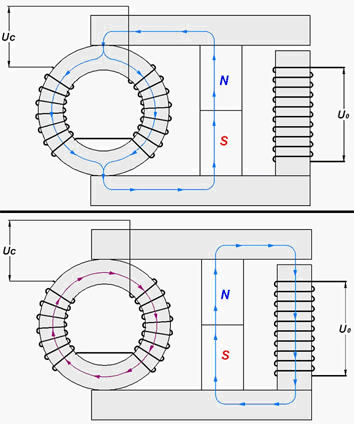 When the input coil is pulsed with an input voltage, it causes a flux reversal in the frame around which the output coil is wound, generating an electrical output. There is also a forum related to this and the better known MEG of Tom Bearden’s which can be found here where that particular message states that Valeri’s device can be made to work at frequencies as low as 50 Hz and can use standard laminated iron frame components and produces Coefficient Of Performance figures up to 5.4 (that is, the output power is more than five times the input power). A demo video is here but it is not in English. It may well be that in order to work well, the MEG needs a very narrow input coil with an air-gap on each side of it and the same may well apply to Lawrence Tseung’s magnetic frame shown earlier in this chapter. The Motionless Generators of Kelichiro Asaoka Kelichiro Asaoka received US patent 5,926,083 some two years before the well-known MEG patent of Tom Bearden and his associates. Personally, I find it hard to understand how the MEG patent (in the Appendix) could have been awarded when the Asaoka patent was already in place. However, here is most of the content of the Asaoka patent: Static magnet dynamo for generating electromotive force based on changing flux density of an open magnetic path ABSTRACT A static magnet dynamo including at least one permanent magnet having different poles; a first core comprising a soft magnetic material and which couples the different poles of the permanent magnet to form a closed magnetic path; a second core comprising a soft magnetic material which couples to the closed magnetic path via a paramagnetic material to form an open magnetic path; a magnetised coil wound around a portion of the first core where the closed magnetic path is formed; and an induction coil wound around a portion of the second core. A direction of a flux of the closed magnetic path is changed by applying an alternating voltage to the magnetised coil, generating an electromotive force in the induction coil by electromagnetic induction due changes in a flux of the open magnetic path induced by the change in direction of the flux of the closed magnetic path. FIELD OF THE INVENTION This invention relates to a dynamo which generates electromotive force by electromagnetic induction by changing the flux passing through an induction coil. More particularly, this invention relates to a static magnet dynamo that changes magnets that pass through an induction coil without turning the armature or electromagnet. DISCUSSION OF BACKGROUND Dynamos currently in practical use are so designed as to generate electromotive force by electromagnetic induction by changing the flux passing through an induction coil. Dynamos that generate power this way come in a wide variety, ranging from large models used in hydroelectric, thermal or atomic power plants to small models such as small dynamos with a diesel engine. In all dynamo models mentioned above, the armature and electromagnet are turned, to change the flux passing through the induction coil, thus generating electromotive force in the induction coil by electromagnetic induction. For examples, the armature and electromagnet are turned by the torque of a water turbine in hydroelectric power generation, by the torque of the steam turbine in thermal and atomic power generation, and by the torque of the diesel engine in small dynamos. Disadvantages: Dynamos that generate electromotive force by electromagnetic induction as mentioned above are so designed that, regardless of the size of the dynamo, the armature and electromagnet are turned in order to change the flux passing the induction coil. These dynamos are disadvantageous in that the said turning of the armature and electromagnet generates vibrations and noise. OBJECTS OF THE INVENTION The purpose of this invention is to provide a static magnet dynamo devoid of any torque-giving means or other moving part to eliminate vibrations and noise, in order to resolve the various problems mentioned above. To resolve the above problems, this invention is composed as described below. The static magnet dynamo involved in this invention consists of at least one permanent magnet, a first core consisting of a soft magnetic material forming a closed magnetic path by coupling the different poles of the said permanent magnet, a second core consisting of a soft magnetic material forming an open magnetic path by being coupled to the closed magnetic path via a paramagnetic material, a magnetised coil wound around a part consisting of only the closed magnetic path of the first core, and an induction coil wound around the second core. The point of this invention is to generate electromotive force in the induction coil by electromagnetic induction by changing the direction of the flux of the closed magnetic path by applying an alternating voltage to the magnetised coil and by changing the flux of the open magnetic path induced by changes in the direction of the flux in the closed magnetic path. The static magnet dynamo involved in this invention consists of at least one permanent magnet, a first core consisting of a soft magnetic material forming a closed magnetic path by coupling the different poles of the permanent magnet, a second core consisting of a soft magnetic material forming a bypass closed magnetic path coupled and arranged with the first core in such a manner as to include the permanent magnet of the closed magnetic path, a magnetised coil wound around the part consisting only of the closed magnetic path of the first core, and an induction coil wound around the part consisting only of the closed magnetic path of the second core. The aim of this invention is to generate electromotive force in the induction coil by electromagnetic induction by changing the direction of the flux of the closed magnetic path by applying an alternating current to the magnetised coil, and by changing the flux of the bypass closed magnetic path induced by changes in the direction of the flux of the closed magnetic path. Effects: In the above configuration, the static magnet dynamo involved in this invention consists of a first core consisting of a permanent magnet and a closed magnetic path, a second core consisting of an open magnetic path via a paramagnetic material, a magnetised coil wound around the part consisting only of the closed magnetic path of the first core, and an induction coil wound around the second magnetic path. The dynamo is so designed as to generate electromotive force in the induction coil by electromagnetic force by changing the direction of the flux of the first core by applying an alternating voltage to the magnetised coil, and by changing the flux of the second core induced by changes in the direction of the flux of the first core. This makes it possible to change the flux passing through the induction coil without a torque-giving means or other moving part and to generate electromotive force in the induction coil by electromagnetic induction, thus enabling power generation without causing vibrations or noise. This dynamo can also be downsized and made available at low prices. Other characteristics and benefits of this invention will be made clear by the description given below with diagrams attached. BRIEF DESCRIPTION OF THE DRAWINGS A more complete appreciation of the invention and many of the attendant advantages thereof will be readily obtained as the same becomes better understood by reference to the following detailed description when considered in connection with the accompanying drawings, wherein: 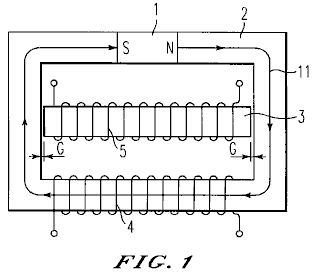 Fig.1 represents a basic configuration of a static magnet dynamo with an open magnetic path involved in this invention. 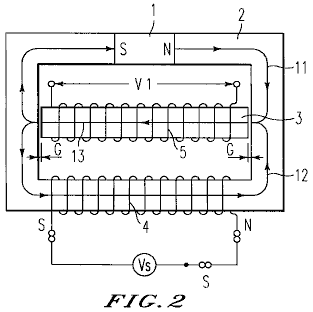 Fig.2 represents how a flux in the direction opposed to that of a permanent magnet typically occurs in the magnetised coil. 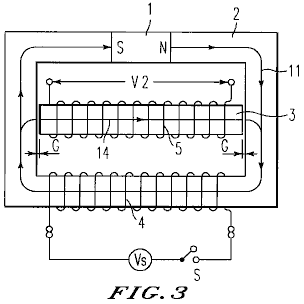 Fig.3 represents how a flux in the direction opposed to that of a permanent magnet typically disappears from the magnetised coil 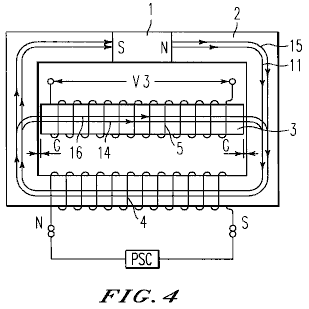 Fig.4 represents how a flux in the same direction as that of the permanent magnet typically occurs in the magnetised coil. 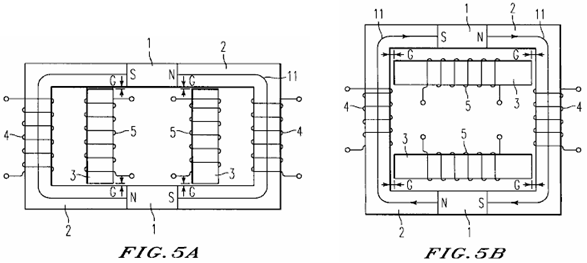 Fig.5 is a first embodiment of the static magnet dynamo involved in this invention. 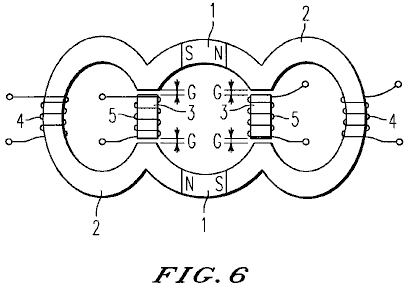 Fig.6 is a second embodiment of the static magnet dynamo involved in this invention.  Fig 7 is a third embodiment of the static magnet dynamo involved in this invention. 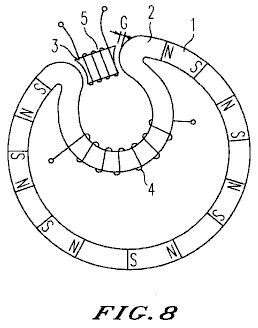 Fig 8 is a fourth embodiment of the static magnet dynamo involved in this invention. 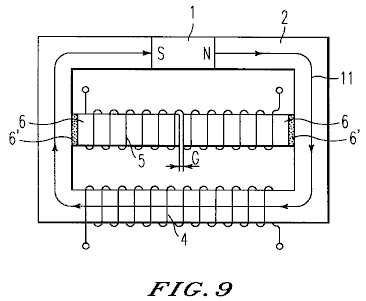 Fig 9 is a fifth embodiment with an open magnetic path.  Fig 10 is a basic configuration of a static magnet dynamo with a closed magnetic path involved in this invention. 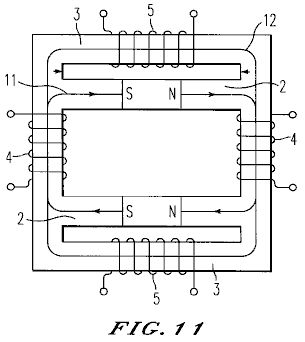 Fig 11 is a first embodiment of the static magnet dynamo with a closed magnetic path involved in this invention. DESCRIPTION OF THE PREFERRED EMBODIMENTS Referring now to the drawings, wherein like reference numerals designate identical or corresponding parts throughout the several views, and more particularly to Fig.1 where there is illustrated a basic configuration of the static magnet dynamo with one permanent magnet. Figs. 2, 3, and 4 describe how the static magnet dynamo represented in Fig.1 generates power. 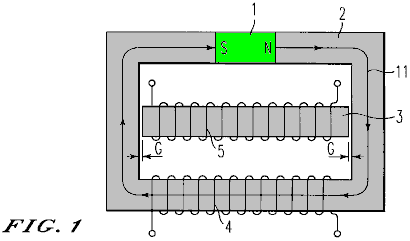 As indicated in the figures, the first core 2 formed to couple the permanent magnet 1 and the different poles of the permanent magnet 1 in an annular manner, forms a closed magnetic path. This closed magnetic path is then equipped with a second core 3 via a paramagnetic material 10 μm to 5 mm thick. This results in the formation of an open magnetic path consisting of a permanent magnet 1, part of a first core 2, a paramagnetic material, and a second core 3. The part consisting only of the closed magnetic path of the first core 2 is wound around with a magnetised coil 4. The second core 3 is then wound around with an induction coil 5 designed to generate electromotive force by electromagnetic induction. Here, the permanent magnet 1 is a magnet with a high residual flux density, a great coercive force, and a large maximum energy product for higher power generation efficiency. Typical materials used here are neodymium iron boride magnet (Nd2Fe14B), samarium cobalt magnet (Sm2Co17), or samarium iron nitride (Sm2Fe17N2). The first core 2 and the second core 3 are made of a soft magnetic material having a high permeability, with high initial, maximum, and other permeability levels, high residual flux density and saturation magnetisation, and small coercive force, thus making effective use of the flux of the magnetic path for power generation. Examples include Permalloy based alloys. Applicable paramagnetic materials are those with a specific permeability comparable to that of a vacuum, such as air, copper, and aluminium. When air is used as a paramagnetic material, that is, when a gap G is secured between the first core 2 and the second core 3, the second core 3 is retained with a solid paramagnetic material. The figures represent embodiments with a gap G, without a solid paramagnetic material designed to retain the second core 3. Following is a description of how a static magnet dynamo of the above configuration generates power. First, when no voltage is applied to the magnetised coil 4 of the static magnet dynamo, a first flux 11 is formed in the first core 2 in the direction going from the N pole to the S pole of the permanent magnet 1. In this state, no flux has been formed in the second core 3 coupled via the gap G. 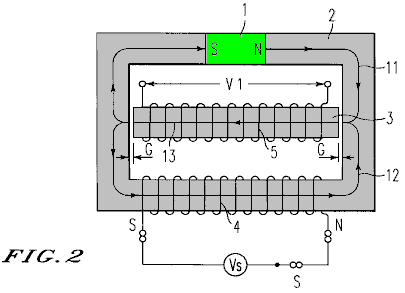 A voltage can be applied to the magnetised coil 4 in three manners described below. In the first voltage application, as indicated in Fig.2, a DC voltage VS is applied to the magnetised coil 4 in the direction that the voltage repels the first flux 11 of the first core 2 generated by the permanent magnet 1, and vice versa, that is, in such a manner that the second flux 12 occurs in the reverse direction of the first flux 11. As a result, the first flux 11 repels the second flux 12 and vice versa, so that the flux more easily leaks from the closed magnetic path. The first flux 11 and the second flux 12, which more easily leak from the closed magnetic path, jump across the gap G and enter the second core 3, so that a third flux 13 is induced in the second core 3. Furthermore, the induction of this third flux 13 changes the flux passing through the induction coil 5, so that electromotive force V1 occurs in the induction coil 5, resulting in power being generated. 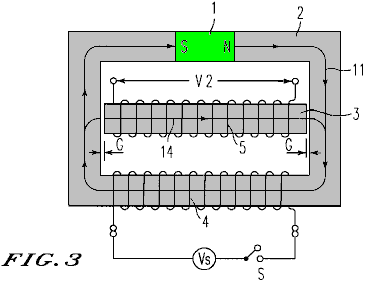 Next, removing the DC voltage applied to the magnetised coil 4 prompts the first core 2 to try going back to a state where only the first flux 11 is formed as indicated in Fig.1. At that time, the second core 3 has a flux in the reverse direction of the third flux 13, that is, the fourth flux 14 indicated in Fig.3, in order to kill the third flux 13. Then, the induction of the fourth flux 14 changes the flux passing the induction coil 5, so that electromotive force V2 occurs in the induction coil 5, resulting in power being generated. Power generation in this first voltage application can be realised by a static magnet dynamo involved in this invention, a DC power supply to apply a DC voltage VS to the magnetised coil 4, and a switching circuit that turns the DC power supply on and off. A contact-less switching circuit can be made if a semiconductor switching device, such as a thyristor, is available. The second voltage application is the same as the first voltage application up to the point where the third flux 13 is induced in the second core 3 by applying a DC voltage VS to the magnetised coil 4 so as to generate the second flux 12 in the reverse direction of the first flux 11 and where the third flux 13 is induced to generate electromotive force V1 in the induction coil 5, thus generating power. 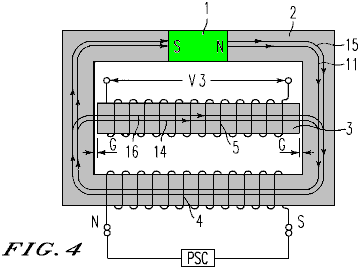 Next, changing the polarity of the DC voltage applied to the magnetised coil 4 generates in the first core 2 the first flux 11 caused by the permanent magnet 1, as well as the fifth flux 15 in the same direction as the first flux, caused by the magnetised coil 4. Here, the first flux 11 is given the fifth flux 15, so that the second core 3 is given the fourth flux 14 as indicated in Fig.4, as well as the sixth flux 16 in the same direction as the fourth flux 14. Furthermore, inducing the fourth flux 14 and the sixth flux 16 changes the flux passing through the induction coil 5, so that an electromotive force V3 larger than the electromotive force V2 is generated in the rotary coil to generate power. This second voltage application requires a polarity switching circuit PSC that changes the polarity of DO voltage instead of a switching circuit that turns on and off the DC voltage applied to the magnetised coil 4 in the first voltage application. This polarity switching circuit can be made of a semiconductor switching device, similarly to the switching circuit in the first voltage application. In the third voltage application, AC voltage VS is applied to the magnetised coil 4 instead of applying DC voltage to the magnetised coil 4 in the second voltage application with the polarity changed. The flux generated by applying AC voltage to the magnetised coil 4 becomes an alternating flux that alternates between the second flux 12 in Fig.2 and the fifth flux 15 in. Fig.4. Then, the flux induced in the second core 3 is the third flux 13 in Fig.2 when the second flux 12 is generated, and is the fourth flux 14 trying to kill the sixth flux 16 and the third flux 19 in Fig.4 when the fifth flux 15 is generated. That is, the flux induced in the second core 3 naturally also becomes an alternating flux. In power generation of this third voltage application, AC voltage is applied to the magnetised coil 4, which overcomes the need for a switching circuit or polarity switching circuit PSC, which was needed in the first and the second voltage application, so that the device becomes simplified. Furthermore, the flux induced in the first core 2 and the second core 3 becomes an alternating flux induced by AC voltage, so that the dynamo functions also as a transformer having a gap G between the first core 2 and the second core 3. It is therefore possible to increase further the electromotive force V generated by electromagnetic induction in the induction coil 5. Next, the power generation efficiency of a static magnet dynamo involved in this invention is described. The static magnet dynamo can be considered as a transformer if its permanent magnet 1 is removed and there is a gap G. A transformer entails an eddy current loss We and hysteresis loss Wh of the core, and a loss Wr due to the electric resistance of the coil. These factors are in a relation formulated below. Let the input be Win and the output Wo, and the Win becomes equal to the total loss, so that the conversion efficiency of the transformer is In reality, in Fig.1, the closed magnetic path consisting of the first core 2 contains a permanent magnet 1. The flux of this permanent magnet 1 therefore contributes to power generation. Therefore, in Fig.1, let the input be Win2 and the output Wo2, then Where Wp represents power resulting from the flux of the permanent magnet 1 contributing to power generation, and α represents a conversion efficiency obtained when the device is considered as a transformer with a gap G. Therefore, power generation efficiency is: Eff = (Wp / Win2) + α . . . . . . . (4) Here, since α < 1, if Wp / Win2 > 1, that is, if power obtained resulting from the flux of the permanent magnet 1 contributing to power generation is larger than dynamo power supplied to the magnetised coil 4, power generation efficiency becomes no less than 1, so that the device can display its performance as a dynamo. Thus, the inventor examined as described below how much the flux of the permanent magnet 1 contributes to the induction of the third flux 13 in Fig.2. First, the inventor provided static magnet dynamos of the basic configuration indicated in Fig.1, one with a permanent magnet 1 and another without a permanent magnet 1. The inventor then compared the power levels needed to induce fluxes of equal flux densities to the second core 3 of each embodiment, that is, the power levels supplied to the magnetised coil 4. As a result, an embodiment with a permanent magnet 1 required only a very low power level to be supplied to the magnetised coil 4. It was observed that the power level required was no more than one fortieth of that of the embodiment without a permanent magnet 1, depending on the test condition. In a static magnet dynamo involved in this invention, therefore, Win2 can be made sufficiently smaller than Wp, so that the inventor considers it possible to make Wp / Win2 > 1. Embodiment 1 Next, as the first embodiment, a static magnet dynamo system composed of two static magnet dynamos of the basic configuration is described based on Fig.5. 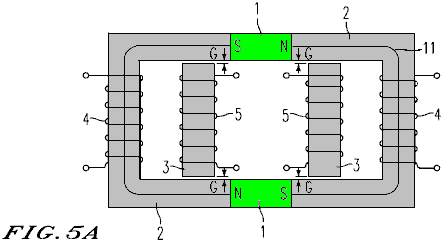 In Fig.5A, in a static magnet dynamo, a closed magnetic path is made of two permanent magnets 1 and two first cores 2 formed so as to couple the different poles of one permanent magnet 1 with the other permanent magnet 1 in an annular manner. This closed magnetic path is then equipped with a second core 3 via a gap G. This forms an open magnetic path consisting of a permanent magnet 1, part of a first core 2, a paramagnetic material, and a second core 3. 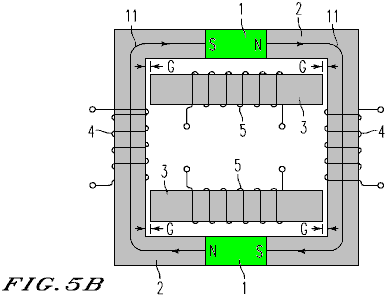 This open magnetic path can be arranged in two different ways. In one configuration, as indicated in Fig.5A, one open magnetic path can be made of two permanent magnets 1 and two second cores 3. In the other configuration, as indicated in Fig.5B, one open magnetic path can be made of one permanent magnet 1 and another can be made of one first core 2. The static magnet dynamos in Fig.5A and Fig.5B do not differ substantially in terms of effect results, except that their patterns forming such an open magnetic path differ. The part forming only a closed magnetic path of each first core 2 is wound around with a magnetised coil 4. Each second core 3 is then wound around with an induction coil 5 which generates electromotive force by electromagnetic induction. This static magnet dynamo forms a first flux 11 in the first core 2 in the direction going from the N pole to the S pole of the permanent magnet 1, with no voltage applied to the magnetised coil 4. Furthermore, the action of this dynamo applying voltage to the magnetised coil 4 and generating electromotive force in the induction coil 5 by electromagnetic induction to generate power is similar to static magnet dynamos of the basic configuration. The static magnet dynamo with two permanent magnets 1 as mentioned above has well-balanced magnetic paths. Since the flux of the permanent magnets 1 can be effectively used, this embodiment achieves higher power generation efficiency than static magnet dynamos of the basic configuration. The first embodiment is a static magnet dynamo system composed of two static magnet dynamos of the basic configuration. Similarly, a static magnet dynamo system can be made as a combination of three or more static magnet dynamos of the basic configuration (Figs. 1-4). In that case, similarly to the first embodiment, an open magnetic path can be formed in two manners. One configuration is the formation of one open magnetic path by coupling all permanent magnets 1 with a second core 3. The other is the formation of as many open magnetic paths as permanent magnets by coupling the N pole of each permanent magnet 1 to the S pole with a second core 3. Embodiment 2 Next, the second embodiment of the present invention is represented in Fig.6, 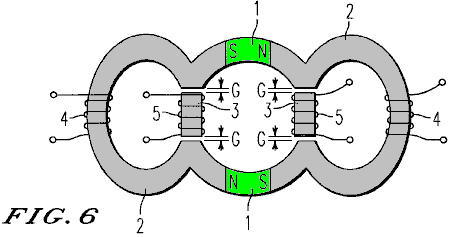 the third embodiment in Fig.7 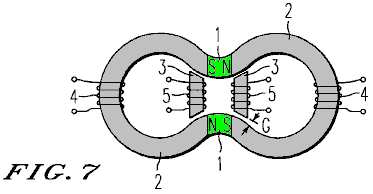 and the fourth embodiment in Fig.8 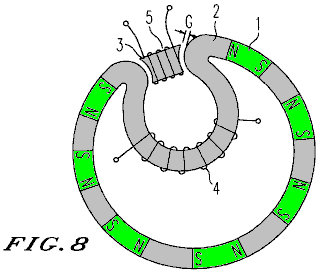 In these embodiments, the action of applying voltage to the magnetised coil 4 and generating electromotive force in the induction coil 5 by electromagnetic induction is similar to that of a static magnet dynamo of the basic configuration (Figs. 1-4). The second and the third embodiments represented in Fig.6 and Fig.7 have the same basic configuration as the first embodiment, except that the first core 2 in each embodiment is shaped quite differently. In the second embodiment, the part opposed to the end of the second core 3 sticks out toward the end of the second core 3. Thus, the leakage flux due to the repellence of the first flux 11 and the second flux 12 generated in the first core 2 jumps across the gap G and enters the second core 3 with greater ease. Embodiment 3 The third embodiment is so designed that the part coupling the second core 3 is that part of the first core 2 which is nearest to the permanent magnet 1 and, to shorten the open magnetic path even further, the two permanent magnets 1 are close to each other. Since a flux tends to form a closed magnetic path with the shortest distance, the leakage flux due to the repellence of the first flux 11 and the second flux 12 generated in the first core 2 jumps across the gap G and enters the second core 3 with greater ease. Embodiment 4 The fourth embodiment indicated in Fig.8, as opposed to a static magnet dynamo of the basic configuration, consists of a first loop where permanent magnets 1 with multiple closed magnetic paths are arranged circularly with the fluxes oriented in the same direction, and of a second loop which is wound around with a magnetised coil 4 and installed inside the first loop. Furthermore, the parts with their first cores 2 coupling the first loop to the second one stick out toward each other across a specified gap. The parts where this first core 2 stick out are coupled together with a second core 3 via a gap G to form an open magnetic path. This reinforces the flux of the permanent magnets 1 and makes it easier for the leakage flux due to the repellence of the first flux 11 and the second flux 12 generated in the first core 2 to jump across the gap G and enter the second core 3. Embodiment 5 The configuration of a static magnet dynamo involved in this invention has so far been described in terms of embodiments where an open magnetic path is connected to the first core 2 at both ends of the second core 3 via a paramagnetic material. However, this invention is not limited to these embodiments. 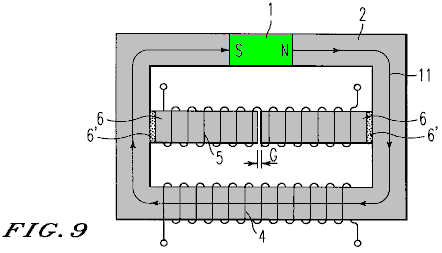 That is, as indicated in Fig.9, the open magnetic path may be embodied by extending any two parts of the first core 2 in the direction that they approach each other, thus defining them as core extensions 6, and coupling these core extensions 6 via a paramagnetic material 6'. This embodiment can be applied to all embodiments mentioned above. Embodiment 6  As indicated in Fig.10, a closed magnetic path consists of a permanent magnet 1 and a first core 2 formed so as to couple the different poles of the said permanent magnet 1 in an annular manner. This closed magnetic path is then equipped with a second core 3 so that it comes magnetically in parallel with the permanent magnet 1, so that a bypass closed magnetic path is composed of a permanent magnet 1, part of a first core 2, and a second core 3. The part consisting only of the closed magnetic path of the first core 2 is wound around with a magnetised coil 4. The second core 3 is then wounded around with an induction coil 5 designed to generate electromotive force by electromagnetic induction. The action of a static magnet dynamo of the above configuration generating power is described below. First, when no voltage is applied to the magnetised coil 4 of a static magnet dynamo, the first core 2 forms a first flux 11 in the direction going from the N pole to the S pole of the permanent magnet 1. In this state, a flux similar to that of the first core 2 is generated in the second core 3 as well. Embodiment 7 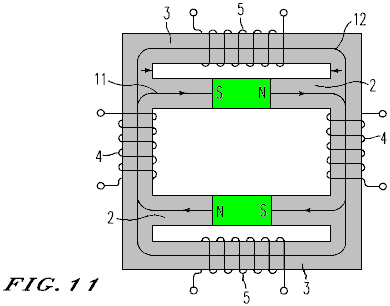 The seventh embodiment is described below based on Fig.11, in terms of a static magnet dynamo system composed of two static magnet dynamos of the basic configuration and with the relative position of the permanent magnets changed. In a static magnet dynamo, a closed magnetic path is composed of two permanent magnets 1 and two first cores 2 so designed as to couple the different poles of one of the permanent magnets 1 with the other permanent magnet 1 in an annular manner. This closed magnetic path is then equipped with a second core 3. This results in the formation of a bypass closed magnetic path consisting of a permanent magnet 1, part of a first core 2, a paramagnetic material, and a second core 3. The parts where a closed magnetic path of each first core 2 alone is formed are wound around with a magnetised coil 4. Each second core 3 is then wound around with an induction coil 5 designed to generate electromotive force by electromagnetic induction. In this static magnet dynamo, where no voltage is applied to the magnetised coil 4, a first flux 11 is formed in the first core 2 in the direction going from the N pole to the S pole of the permanent magnet 1. The action of applying voltage to the magnetised coil 4 and generating electromotive force in the induction coil 5 by electromagnetic induction to generate power is similar to that of a static magnet dynamo of the basic configuration. In the aforementioned static magnet dynamo incorporating two permanent magnets 1, magnetic paths are arranged in a well-balanced manner. This makes it possible to make effective use of the flux of the permanent magnets 1, so that power generation efficiency is higher than that of a static magnet dynamo of the basic configuration. This invention has so far been described somewhat in detail in terms of the most favourable embodiments. Since it is clear that a wide variety of embodiments can be realised without opposing the philosophy and scope of this invention, this invention will not be limited to any particular embodiment, except for the limitations described in the attached claim. Stephan W. Leben. There is an interesting video posted on YouTube here where a contributor whose ID is "TheGuru2You" posts some really interesting information. He starts with a circuit produced by Alexander Meissner in 1913 and shown here:  Stephan states that he has built this circuit and can confirm that it is a self-resonating powering circuit. Once a twelve volt supply is connected to the input terminals, the transistor switches on powering the transformer which feeds repeating pulses to the base of the transistor, sustaining the oscillations. The rate of oscillation is governed by the capacitor marked "C" in the circuit diagram above and the coil across which it is connected. 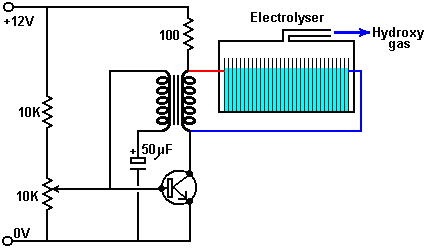 Interestingly, if that capacitor is replaced by an electrolyser (which is effectively a capacitor with the water forming the dielectric between the plates of the capacitor), then the frequency of the circuit automatically adjusts to the resonant frequency of the electrolyser and it is suggested that this system should be able to perform electrolysis of water requiring only a low power input and automatically slaving itself to the varying resonant frequency of the electrolyser. As far as I am aware, this has not been confirmed, however, the voltage pulsers designed by John Bedini do slave themselves automatically to their load, whether it is a battery being charged, or an electrolyser performing electrolysis. Stephan then suggests combining Alexander Meissner's circuit with Charles Flynn's magnetic amplification circuit. Here the transformer is switched to become the Charles Flynn oscillator winding plus a second winding placed alongside for magnetic coupling as shown here: 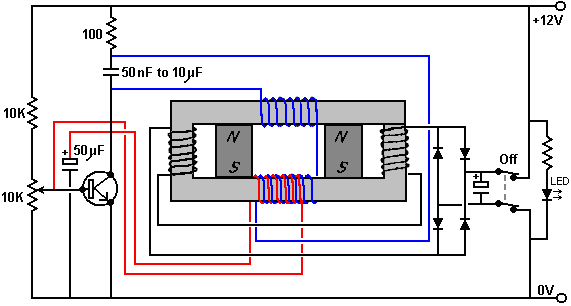 The transistor stage would be self-oscillating as before, the transformer now being made up of the red and blue coil windings. This oscillation would also oscillate the Flynn magnetic frame, producing an electrical output via the black coils at each end of the magnetic frame. This is, of course, an oscillating, or AC output, so the four diodes would produce a full-wave rectified (pulsating) DC current which is smoothed by the capacitor connected to the diodes. This circuit could be started by touching a 12 volt source very briefly to the output terminals on the right. An alternative would be to wave a permanent magnet close to the red and blue coils as that would generate a voltage in the coils, quite sufficient to start the system oscillating and so, becoming self-sustaining. Stephan suggests using the piezo crystal from a lighter and connecting it to an extra coil to produce the necessary voltage spike when the coil is held close to the blue coil and the lighter mechanism clicked. A surprising problem would be how to switch the device off since it runs itself. To manage this, Stephan suggests a two-pole On/Off switch to disconnect the output and prevent it supplying the input section of the circuit. To show whether or not the circuit is running, a Light-Emitting Diode ("LED") is connected across the output and the current flowing through it limited by a resistor of about 820 ohms. Anyone wanting to try replicating this device will need to experiment with the number of turns in each coil and the wire diameter needed to carry the desired current. Stephan states that you need to have at least twice the weight of copper in the (black) output coils as there is in the (blue) input coils in order to allow the device produce excess power. The first page of the Appendix shows the current carrying capacity for each of the standard wire diameters commonly offered for sale. As this is a fairly recently released circuit, I am not aware of any replications of it at this time. Floyd Sweet’s VTA Generator. Another device in the same category of permanent magnets in conjunction with oscillating coils, was produced by Floyd Sweet. The device was dubbed “Vacuum Triode Amplifier” or “VTA” by Tom Bearden. The device was capable of producing more than 500 watts of output power at 120 Volts, 60 Hz requiring less than one third of one milliwatt as input power. The output power can operate AC motors, lights, heaters and when rectified, DC motors. Thanks is due to Horst Weyrich who has recently provided me with links to useful material which I had not seen before. This link: YouTube is to a video in which Floyd shows most of the magnet conditioning process. Recently, some additional information on Floyd Sweet's device, has been released publicly by an associate of Floyd's who goes just by his first name of "Maurice" and who, having reached the age of seventy has decided that it is time to release this additional information. That information can be found in the Appendix. I am not aware of anybody who has succeeded in replicating Floyd’s VTA, but here is as much information as I have at this time. In the above video, Floyd talks about separating two of his conditioned permanent magnets with an “air gap” which is astonishing as he is putting them on opposite sides of a length of aluminium channel with thick walls and aluminium has a major damping effect on magnetic fields:  This arrangement which seems quite mad, is confirmed by a picture from Floyd’s lab. As shown here: 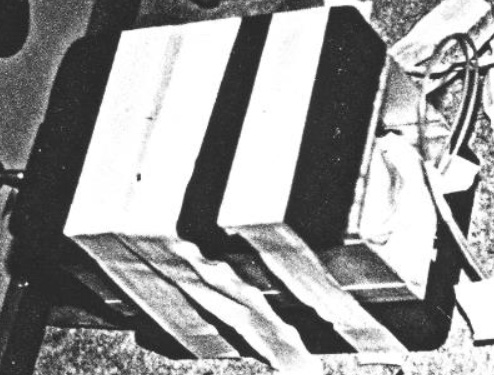 This shows clearly that the open ends of the channel are not between the two magnets allowing an unrestricted magnetic field to flow between them, but instead, two channel thicknesses of aluminium are between the two magnets, obstructing the magnetic flow – quite remarkable !! Floyd shows two coils being used to condition the magnets. The first is the large vertical coil shown here in front of Floyd:  The second coil is not seen as it is inside the vertical coil, sitting flat on the base, and consisting of an entire reel of AWG #17 (1.15 mm diameter) wire, something like this: 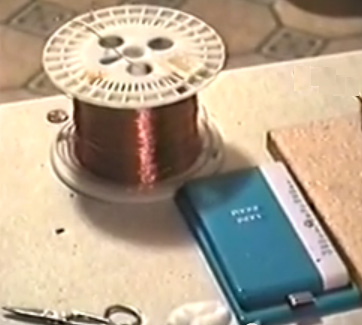 This coil operates effectively as an air-core solenoid, producing a strong axial magnetic field inside the larger coil which surrounds it. This inside coil is driven by a sine wave signal in the 10Hz to 15Hz range, boosted through a 100-watt audio amplifier which provides the current needed to impose the sine wave on this low impedance coil without distorting the waveform. The first step is to determine the resonant frequency of each of the two permanent magnets to be used. The ferrite magnets used appear to be about 6 x 4 x 1 inch (150 x 100 x 25 mm). As they will eventually be used as a pair, one end of each is marked so that they can be aligned in the correct orientation after conditioning. That size of magnet appears to have a resonant frequency of about 12Hz, but each magnet will be slightly different. The inside, low frequency coil is powered up at around 12Hz, the length of the magnet aligned with the Earth’s magnetic field (that is, North/South), and placed on top of the vertical coil. An iron shim as used in transformer core construction is placed vertically on top of the magnet as an indication of resonating: 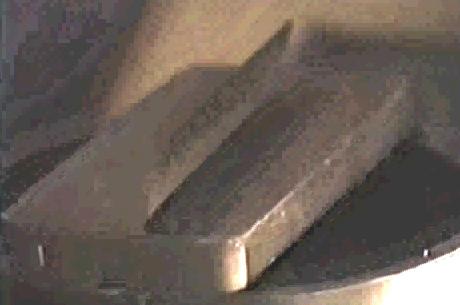 As shown in the video, the sine wave frequency feeding the AWG #17 coil is adjusted slowly to find the point at which the iron shim vibrates most strongly. That frequency is noted, and the same is done for the second magnet. It is not likely that the two resonant frequencies will be the same, and so the average frequency for the pair is used. Next, the two magnets are placed in attraction mode, one on each side of the aluminium channel, with their marked ends at the same end of the channel. That is, the North pole face of one will touch the aluminium and the South pole face of the other will touch the aluminium. The two magnets and their separating aluminium channel are then placed inside the main coil and aligned so that the outer North pole faces southwards and the opposite external South pole faces Northwards. The large coil dimensions are arranged so that the centre of the magnets is at the centre of the outer coil: 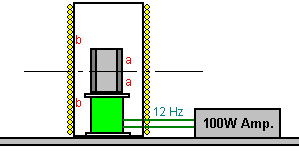 While the inner coil continues to be powered up with a powerful sine wave, the outer coil is now fed a 60Hz stream of sharp voltage pulses. These are generated by charging up a 16,000 microfarad 250V capacitor and then discharging it through an SCR (Thyristor) connected to the outer coil. It is important that the spikes be sharp as they are imposing that frequency on the internal magnetic structure of the magnets. Presumably, if aiming for a European 240V version, then the outer coil would be pulsed at 50Hz rather than the American 60Hz and the capacitor would be a 450V rated type. The working pictures of Floyd’s prototype powering a load, seem to indicate that the one input coil and one output coil as described by Ashley Gray below, are the same as used by Floyd as we see wires coming out of the open end of the channel. Horst wishes to emphasise that it is not easy to make a working replication of Floyd’s design as the people at hiaq.org have tried to replicate it for a number of years now, without any success. Ashley Gray of New Zealand. In April 2014, I was sent some information about a colleague of Floyd Sweet’s – Ashley Gray of Nelson, New Zealand. The version described by Ashley appears to be understandable. On 20th June 1994, Ashley says: After a trip to America in 1985 when I was first introduced to Floyd Sweet, I was invited to go back and work with him. At that time he was being funded by Mark Goldes of the Aesop Institute, and Darryl Roberts was working as co-coordinator for the Institute in L.A. After working with Floyd for some time we left America for England. At that stage the "politics" had become difficult. While we were in England, we were contacted by Mark Goldes and told that Floyd had obtained some results which they would like us to verify for them. On our return to New Zealand, Darryl Roberts sent us the Lab Notes which he had recorded during the first tests of the “Space Quanta Modulator” and it's construction details. We were asked to repeat the experiments to verify the results. We constructed the device but were unable to get any results at that time. In the light of the new information which had been released, I conducted some further experiments and managed to obtain some interesting results without magnet ‘conditioning’ which, as far as I was aware, was not used in the original device. The initial device which I constructed when in America, consisted of two 1-inch x 1-inch (25 x 25 mm) neodymium magnets mounted in a steel frame. There were two ‘modulating’ windings and one output winding. It was driven by a specially built sine-wave oscillator which was adjustable from 1 kHz to 2 kHz. We did not get any output or significant result from this device. Floyd felt that this was due to the high field strength of the neodymium magnets and the closed magnetic path. Floyd did not mention anything about magnet conditioning being necessary. A second prototype was then built, using Barium Ferrite magnets size 6-inches x 4-inches x 1-inch (150 x 100 x 25 mm): 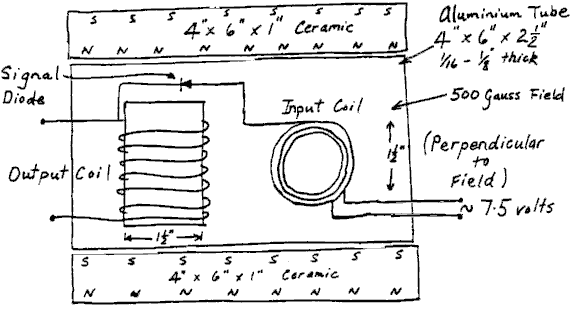 Ashley appears to be using magnets which are not ‘conditioned’. Ashley has had what I consider to be very significant results from his prototype with an output power of 111 watts for an input of just 0.001 watts (a COP of 111,000). Ashley’s successful build has an aluminium housing. People get the very mistaken idea that aluminium is not magnetic because magnets do not stick to it. The reality is that aluminium has a really major effect on magnetic fields and can be used as magnetic shielding if thick enough. Ashley’s design uses two coils at right-angles to each other and that style of operation can be seen in other free-energy designs. Anyway, take a look at the version built by Ashley: 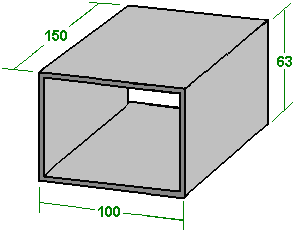 The aluminium enclosure is shallow. The ends are 4” x 2.5” which is 100 x 63 mm. The diameter of the input coil is 1.5 inches or 38 mm. Similarly, the output coil length has to be less than 63 mm. The diagram below may give a slightly better idea of the dimensions involved in the construction. At the present time, magnets of that size are available for £14 each in the UK. They each have an 8 Kg pull and are very heavy. 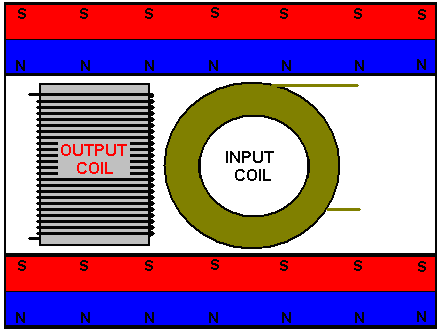 The magnetic lines of force flow through the length of the output coil and through the width of the input coil. As you can see from the diagram, the unit is compact in spite of the very large magnets. The input needed is a good-quality sine wave. Ashley also says: Details From Lab Notes of First Successful Tests Original Test Setup: A Signal Generator made by Wavetek, USA, was used to drive the input coil. Input coil: 1.5" diameter 120 turns #20 gauge (0.812 mm diameter, overall resistance about 1 ohm) Input = 7.5 volts at 3.l microamps = 23 micro watts Output Coil: 1.5" diameter 12 turns #12 gauge (2.05 mm diameter) Output = 10.4 volts sine wave at 1.84 amps = 19.15 watts at approx 400 Hz Comments: Frequency generally affected resistive 1.8 amp 20 watt bulb load proportionally - brightness increased with frequency, decreased with frequency except at certain points when it appeared inversely related, increasing as frequency decreased etc. First Modifications: The Signal generator was replaced with a purpose-built Sine Wave Oscillator of 9 volt output. The input coil was increased to 250 turns of #18 gauge (1.024mm) and the output coil was increased to 24 turns of #18 gauge(1.024 mm diameter) wire. Magnets, spacing, etc. all remained the same. Input: 7.2 volts at 143 micro amps (0.001 watts) Output: 24.2 volts at 4.6 amps = 111watts. Frequency 388 and 402 Hz Comments: By increasing the area of the wire exposed to/or occupying the fluctuating magnetic field the output was doubled. The exact proportions /ratios of the space filling volume of winding to output had not been determined at the time of writing. Magnet size seems to be less important than the volume of the windings, wire diameter, input voltage and current. The current is only limited by the impedance of the wire which rises dramatically in the magnetic field to several hundred thousand ohms, while the impedance when outside the magnetic the field is only 2 or 3ohms @ 400 Hz. (250 turns #18 (1 mm diameter) wire). The AC excitation current is only required to support I2R losses as the magnetic field requires no additional power, as it is not loaded by the wires passing through the field. The unit ran for 10 to 12 hours with no heating occurring but no longer duration tests were performed. The tests were witnessed by three people. Technical Notes: The quality of the oscillator is important - there should be no harmonic distortion i.e. it needs to be a pure sine wave. The signal diode divides the current into the circuit, and being parallel - puts a small microamp current into the power coil as well as the excitation coil. This works with the magnets in such a way that there is produced a vector complementation. When in close proximity to the magnets, the output load bulbs vibrate. Pavel Imris. Pavel was awarded a US patent in the 1970’s. The patent is most interesting in that it describes a device which can have an output power which is more than nine times greater than the input power. He achieves this with a device which has two pointed electrodes enclosed in a quartz glass envelope which contains xenon gas under pressure (the higher the pressure, the greater the gain of the device) and a dielectric material.  Here, the power supply to one or more standard fluorescent lamps is passed through the device. This produces a power gain which can be spectacular when the gas pressure in the area marked ‘24’ and ‘25’ in the above diagram is high. The patent is included in this set of documents and it contains the following table of experimental measurements: Table 1 shows the data to be obtained relating to the optical electrostatic generator. Table 2 shows the lamp performance and efficiency for each of the tests shown in Table 1. The following is a description of the data in each of the columns of Tables 1 and 2. 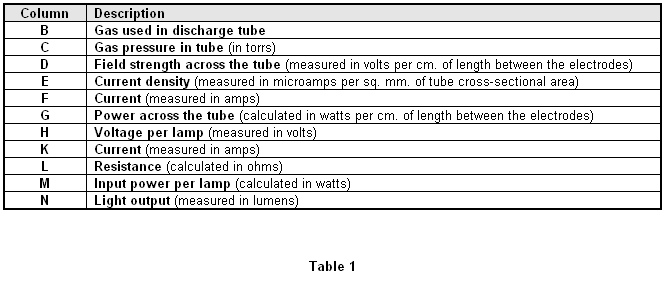  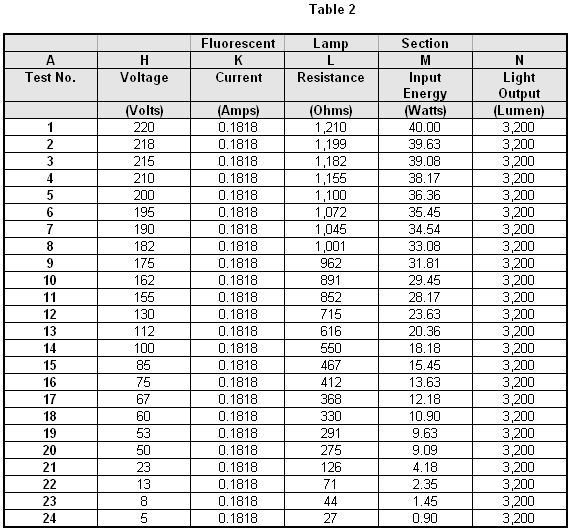 The results from Test No. 24 where the gas pressure is a very high 5,000 Torr, show that the input power for each 40-watt standard fluorescent tubes is 0.9 watts for full lamp output. In other words, each lamp is working to its full specification on less than one fortieth of its rated input power. However, the power taken by the device in that test was 333.4 watts which with the 90 watts needed to run the 100 lamps, gives a total input electrical power of 423.4 watts instead of the 4,000 watts which would have been needed without the device. That is an output power of more than nine times the input power. From the point of view of any individual lamp, without using this device, it requires 40 watts of electrical input power to give 8.8 watts of light output which is an efficiency of about 22% (the rest of the input power being converted to heat). In test 24, the input power per lamp is 0.9 watts for the 8.8 watts of light produced, which is a lamp efficiency of more than 900%. The lamp used to need 40 watts of input power to perform correctly. With this device in the circuit, each lamp only needs 0.9 watts of input power which is only 2.25% of the original power. Quite an impressive performance for so simple a device! The Michael Meyer and Yves Mace Isotopic Generator. There is a French patent application number FR2680613 dated 19th August 1991 entitled “Activateur pour Mutation Isotopique” which provides some very interesting information. The system described is a self-contained solid-state energy converter which abstracts large amounts of energy from an ordinary iron bar. The inventors describes the technique as an “isotopic mutation effect” as it converts ordinary iron (isotope 56) to isotope 54 iron, releasing large amounts of electrical energy in the process. This excess energy can, they say, be used to drive inverters, motors or generators. The description of the mechanism which is being used by the device is: “the present invention uses a physical phenomenon to which we draw attention and which we will call ‘Isotopic Change’. The physical principle applies to isotope 56 iron which contains 26 protons, 26 electrons and 30 neutrons, giving a total mass of 56.52 Mev, although its actual mass is 55.80 Mev. The difference between the total mass and the actual mass is therefore 0.72 Mev this which corresponds to an energy of cohesion per nucleon of 0.012857 Mev. So, If one introduces an additional 105 ev of energy to the iron core isotope 56, that core isotope will have a cohesion energy level of 0.012962 Mev per nucleon corresponding to iron isotope 54. The instability created by this contribution of energy will transfer the isotope 56 iron to isotope 54 causing a release of 2 neutrons. This process generates an excess energy of 20,000 ev since the iron isotope 54 is only 0.70 Mev while isotope 56 has 0.72 Mev. To bring about this iron isotope 56 conversion, we use the principle of Nuclear Magnetic Resonance.” The practical method for doing this is by using three coils of wire and a magnetic-path-closing support frame of iron as shown in this diagram: 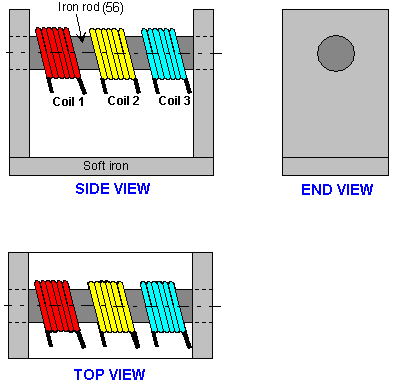 In this arrangement, Coil 1: Produces 0.5 Tesla when fed with DC, converting the iron bar into an electromagnet Coil 2: Produces 10 milli-Tesla when fed with a 21 MHz AC sinewave signal Coil 3: Is the output coil, providing 110, 220 or 380 volts AC at about 400 Hz depending on the number of turns in the coil This simple and cheap system has the potential for producing substantial energy output for a very long time. The inventors claim that this device can be wired to be self-powered, while still powering external devices. Coil 1 turns the iron rod into an electromagnet with it’s flux channelled in a loop by the iron yoke. Coil 2 then oscillates that magnetic field in resonance with the isotope 56 iron atoms in the rod, and this produces the isotope conversion and release of excess energy. Coil 3 is wound to produce a convenient output voltage. The Colman / Seddon-Gilliespie Generator. This device, patented by Harold Colman and Ronald Seddon-Gillespie on 5th December 1956, is quite remarkable. It is a tiny lightweight device which can produce electricity using a self-powered electromagnet and chemical salts. The working life of the device before needing refurbishment is estimated at some seventy years with an output of about one kilowatt. The operation is controlled by a transmitter which bombards the chemical sample with 300 MHz radio waves. This produces radioactive emissions from the chemical mixture for a period of one hour maximum, so the transmitter needs to be run for fifteen to thirty seconds once every hour. The chemical mixture is shielded by a lead screen to prevent harmful radiation reaching the user. The patent, GB 763,062 is included in the Appendix. This generator unit includes a magnet, a tube containg a chemical mixture of elements whose nuclei becomes unstable as a result of bombardment by short waves so that the elements become radio-active and release electrical energy, the mixture being mounted between, and in contact with, a pair of different metals such as copper and zinc, and a capacitor mounted between those metals. The mixture is preferably composed of the elements Cadmium, Phosphorus and Cobalt having Atomic Weights of 112, 31 and 59 respectively. The mixture, which may be of powdered form, is mounted in a tube of non-conducting, high heat resistivity material and is compressed between granulated zinc at one end of the tube and granulated copper at the other end, the ends of the tube being closed by brass caps and the tube being carried in a suitable cradle so that it is located between the poles of the magnet. The magnet is preferably an electro-magnet and is energised by the current produced by the unit. The transmitter unit which is used for activating the generator unit may be of any conventional type operating on ultra-shortwave and is preferably crystal controlled at the desired frequency. 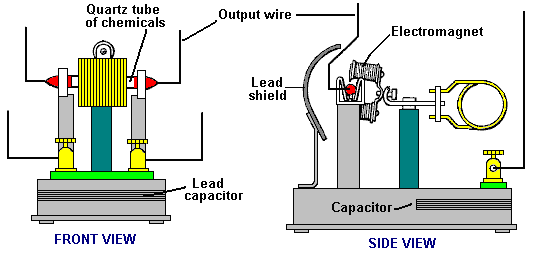 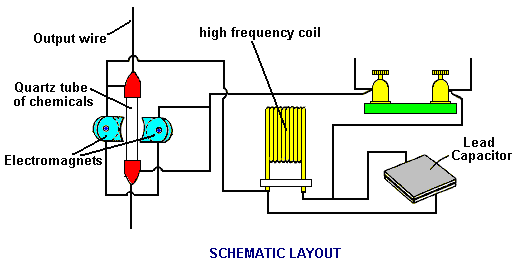 The transmitter unit is of any suitable conventional type for producing ultra shortwaves and may be crystal controlled to ensure that it operates at the desired frequency with the necessity of tuning. The quartz tube containing the chemical mixture, works best if made up of a number of small cells in series. In other words, considering the cartridge from one end to the other, at one end and in contact with the brass cap, there would be a layer of powdered copper, then a layer of the chemical mixture, then a layer of powdered zinc, a layer of powdered copper, etc. with a layer of powdered zinc in contact with the brass cap at the other end of the cartridge. With a cartridge some forty five millimetres long and five millimetres diameter, some fourteen cells may be included.  Hans Coler. Hans Coler developed a device which he named the “Stromerzeuger” which consisted of an arrangement of magnets, flat coils and copper plates with a primary circuit powered by a small battery. The output from the secondary circuit was used to light a bank of lamps and it was claimed that the output power was many times the input power and to continue indefinitely. The apparatus principally consists of two parallel connected spools which being bi-filarly wound in a special way, are magnetically linked together. One of these spools is composed of copper sheets (the spool is called the ‘plate spool’). The other one is made of a number of thin parallel connected isolated wires (called ‘spool winding’), running parallel to the plates, at small intervals. Both spools can be fed by separate batteries (6 Volt, 6.5 AHr were used). At least two batteries are needed to get the apparatus operating, but subsequently, one battery can be removed. The spools are arranged in two halves each by the bi-filar windings. The plate spool also contains iron rods with silver wire connections. These rods are magnetised by a special battery through exciter windings. Electrically, the exciter winding is completely isolated from the other windings. Hans said that the production of energy takes place principally in these iron rods and the winding of the spools plays an essential part in the process. It should be mentioned that the spool circuit is powered up first. Initially, it took a current of 104 mA. The plates and exciter circuits are then switched on simultaneously. When this is done, the current in the spool circuit dropped from 104 mA to about 27 mA. It is suggested that an electron be not only regarded as a negatively charged particle but also as a South magnetic pole. The basic Stromerzeuger element is that of an open secondary circuit, capacity loaded, inductively coupled to a primary circuit. The novel feature is that the capacities are connected to the secondary core through permanent magnets as shown here:  It is claimed that on switching on the primary circuit, “separation of charges” takes place with M1 becoming positively charged and M2 becoming negatively charged and that these charges are “magnetically polarised” when they formed, owing to the presence of the magnets. When the primary circuit is switched off, a “reversing current” flows in the secondary but the magnets “do not exert a polarising effect on this reversal”. Two of the basic elements shown above are placed together making a double stage arrangement with the copper plates close together (presumably as capacitor plates):  The secondary windings are both exactly equal and wound in a direction such that, on switching the primary coil on, the electrons in the secondary coil flow from P1 to P2 and from F1 to F2. This is the basic working arrangement. More of these double stages can be added to provide higher outputs.  Don Smith. One free-energy developer who had most impressive claims for his devices is the late Don Smith who produced many spectacular devices, generally with major power output. Don says that his understanding comes from the work of Nikola Tesla as recorded in Thomas C. Martin's book "The Inventions, Researches, and Writings of Nikola Tesla" ISBN 0-7873-0582-0 available from http://www.healthresearchbooks.com and various other book companies. This book can be downloaded from http://www.free-energy-info.tuks.nl as a pdf file, but a paper copy is much better quality and easier to work from. Many experimenters have spent considerable time and effort in attempts to replicate the work which Don reports and while COP>1 has definitely been achieved, high power has not yet been reached. If you want more detail then it can be found here as a free download. Mohamed assesses Don Smith’s Devices Late in 2014, Mohamed released the following document after two years of examining and testing Don Smith’s main design. If preferred, his document can be downloaded as a separate pdf file: Mohamed.pdf. In the name of Allah, most gracious, most merciful The Resonance Energy Device Explained Preface This presentation is a favour from Allah (God), the Thanks is to HIM even though it’s the result of more than two years of deep thinking about the resonance energy device invented by Donald Lee Smith. I was interested in this device due to the huge amount of power which it is able to provide. The device has no moving parts and is small in size. This presentation is an attempt to explain two important sources of information about the resonance energy device; they are a document and a video: The document is located here: Smith.pdf The video can be seen here: YouTube video The information contained in the document is free and open to the public. I think that it is time for such information to become widely known - free energy is free because it’s for everyone. Energy is everywhere in an unlimited quantity, ready to be taken with minimum effort, the resonance energy device described here is one of the most attractive free energy devices, it depends on a multidimensional transformer which makes possible a harmonic exchange between the positive energy reality and the unseen negative sea of energy. This is possible using a spark-gap arrangement, the energetic symmetry between the positive and negative energy oceans make it preferable to use the term ambient background energy rather than the name zero point energy. The video pointed to above, is an excellent source that can be viewed in parallel with this work, and when considered together, the reader will understand both the video and this presentation. At the start of the above video, the inventor explains the importance of the magnetic field in generating electricity. The magnetic energy upsets the background energy and that results in a separation of electrons between the two ends of a coil, this separation of electrons is a source of electric power. The resonance energy device is based on a very important idea, namely, that magnetism and electricity are two sides of a single entity! Matter and energy are two aspects of the same thing as Oliver Heaviside expressed in his famous energy equation E = MC2. The electrical equivalent of this in our Resonance Energy Device is: In this presentation, we will learn together how the device works but before any attempt to use this information, please pay attention to the following caution: 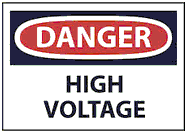 You need to read this document again and again to understand the power behind this device; this device is a power producer! You are near a power production factory but in a small size, this special coil only needs voltage and when we oscillate that voltage, the voltage turns into real current ‼ This means that even a short-circuit isn’t permitted in the collection system if you plan to use HV capacitors. This is not the place for amateurs, please do not attempt to implements or use the information shown here unless you are experienced and skilled. Neither the publisher nor the author makes any representations as for the completeness or the accuracy of the information contained here and disclaims any liability for damages or injuries resulting from your actions. Algeria, August 2014 hopehope3012 (at) gmail (dot)com Let’s examine how a magnetic field generates a voltage in an ordinary coil and why our coils lack the energy key that Donald Smith has found 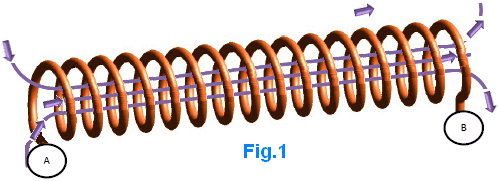 When a magnetic field penetrates a coil, the induced rotating electric field generates additive elementary voltages along the coil. Every turn in the coil receives the same voltage, we extract the power along the length of the coil, but we miss the power available in the area inside the coil !! To understand this, let’s examine the induced electric field: 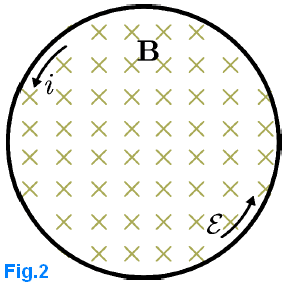 If we examine Fig.2, which represents a single turn of the coil shown in Fig.1, we see that the magnetic field penetrates all of the area inside that ring. This magnetic field will be transformed to a voltage because it will drive a rotating electric field, this field is able to induce a voltage and this induced voltage will cause the current to flow due to the different of voltage between the two points A and B in Fig.1. The important, generally forgotten thing about the induced electric field, is its availability inside our coil as shown in Fig.3:  The induced electric field exists independent of the conducting loop. In other words, an induced electric field permeates all of the space within the region of the changing magnetic field, as indicated by the red field lines in Fig 3. What about this field? It is wasted power. It is wasted power at point A, as well as all of the distance between the two points A and B. If we want to achieve power amplification we have to combine the magnetic field with the induced electric field in such a way as to conserve the non-conservative electric field! The induced rotating electric field will remain non-conservative but we could play with the induced voltage created by that field using a Tesla Bi-filar Coil (“TBC”). We need to extend the capacitive side of a Tesla bi-filar coil in order to benefit from the induced E field to a reasonable degree, if we try to use a flat TBC we will face the same problem in our solenoid coils where we concentrate between two points. The heart of the Resonance Energy device is based on an extended Tesla bi-filar coil (Fig.4) 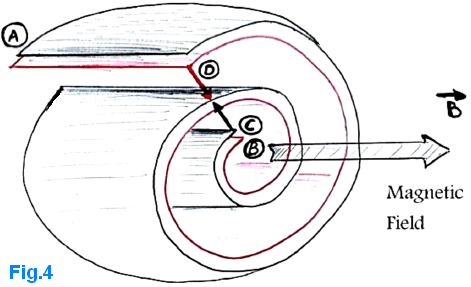 During my search for the specification of Tesla bi-filar coil I wasn’t able to find a lot of information such as the resonance frequency of this special coil as if it has been forgotten, although it has been known since 1894! I felt it’s without advantage; fortunately at that time I successfully built a new type of asymmetrical capacitor that has four plates rather than three plates, I was able to replicate my source voltage, I gave it the name C1/C2 system, when I fed C1 with high voltage I was able to take the voltage from C2 without direct contact, the device is based on the electric field interaction between C1 and C2. The C1/C2 system opened my mind to the possibility of charging a capacitor without the need of direct contact; with the device. I began thinking in a different way, wondering how I could combine the two side of electricity in just one device. The device shown in Fig.4 can be simplified as shown in Fig.5:  The magnetic side is the path from A to B, it is the path which the current will follow, and then the magnetic energy will be formed and concentrated inside our coil, the magnetic side is the hidden side of electricity because we can't conserve this state for a long time as we do in the capacitors. This side is directly related to the ambient background energy or zero point energy. (Later we will see why Donald Smith prefers the name of ambient background energy as opposed to ZPE) To make things easier we could take the permanent magnet as an example, the permanent magnet appears to create the magnetic field all the time without requiring us to provide any visible power for which we have to pay. The electric side of this amazing coil is the most difficult thing to understand. The capacitor in our extended Tesla bi-filar coil is just one point! It’s the point “X” but from a static perspective, we say that it is between points C and D. The path from C to D is the way to conserve the direction of current needed to build the coil and ensure the maximum voltage is generated between the two plates of the capacitor. This capacitor is a dynamic capacitor and not a static capacitor. In this capacitor the displacement current is absent... because it gathers the two polarities of electricity in one device. The magnetic side is the current side where the current starts from point A and flows to point B. The electric side is the point at which the maximum voltage between the two plates exists. I think that this is the most difficult point to understand in the Tesla Bi-filar Coil, because we see it as just a coil and not a coil with a built-in capacitor! Back to 1894 and take a look at what Mr. Nikola Tesla said about his bi-filar coil: My present invention has for its object to avoid the employment of condensers which are expensive, cumbersome and difficult to maintain in perfect condition, and to so construct the coils themselves as to accomplish the same ultimate object. Let us start by analysing how the extended Tesla bi-filar coil works. Imagine that the following drawing is a charged, extended Tesla coil with the positive and negative parts, shown as red and black plates respectively  When we connect these two plates by their points C and D, an electric current will flow from point A to point B as shown by the red arrows. When the induced electric field finds a coil which is wound counter-clockwise (“CCW”) – the red plate - versus another coil wound clockwise (“CW”) – the black plate - this electric field will generate an induced voltage which will tend to recharge the capacitor again! The rotating electric field will start to build an induced electric voltage from point B which will be 0V in this case because the induced electric fields rotate in a clockwise direction. When the magnetic field increases, the electric current will flow counter-clockwise and so the direction of the magnetic field will be out the screen as indicated in Fig.6. In this case we achieve a cost-free voltage difference between adjacent plates. This situation attracts electrons which were not previously available, to become incorporated and produce a very large net gain in potential, this gain is real !! The induced rotating electric field flows in closed loops but this design causes it to build a voltage difference between adjacent plates. This fact prevents the voltage difference between the adjacent plates from dropping and it makes the replication of electric power with radio frequency a practical operation. Because of this, we can understand why resonance can't produce the power but it replicates the power with radio frequency and this is the secret of the huge power which this device is able to give with the equation which Don Smith gave us:  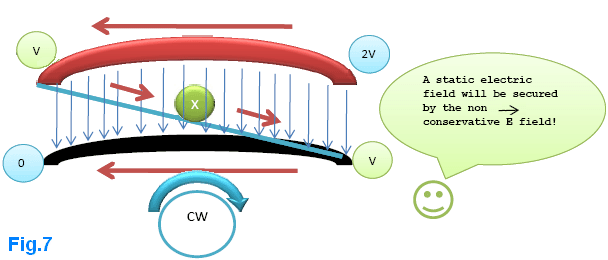 The induced rotating electric field will build induced elementary voltages; B is the starting point for that field, so it will have 0V but when we arrive at point D it will have V volts, which same voltage will be available at point C. The induced rotating electric field will continue it’s rotation producing a value of 2V at point A !! (Fig.7). A question arises: where is the capacitor if C and D both have the same voltage? The capacitor in our extended Tesla bi-filar coil (TBC) is a dynamic capacitor, it will be formed only when the coil oscillates. When that happens, the induced electric field will give C and D the same value of voltage but every adjacent turn will receive the same difference of voltage needed for attracting ambient electrons which weren’t originally in the system but now are incorporated in large numbers, providing the excess power. This capacitor appears due to the junction CD, and from a dynamic point of view, it is the point X. This device treats the magnetism and electricity as if they are the same thing. When this happens both sides help the other side. The displacement current is absent here because it appears when we separate electricity and magnetism. When we do that, we fill the gap by introducing something isn’t real. The displacement current does not exist !! When you move a permanent magnet in the air, an induced electric field will appear regardless of the presence of a coil. The electricity is there, it comes from the background energy and returns to its background level, both electricity and magnetism have the same origin, the magnetism is the energy side (magnetic field), the electricity is the physical side (electrons). The physical side appears when we place a conducting coil in an area where there is a changing magnetic field. The magnetic field causes the electrons to rotate CCW and produce voltage and rotate CW and produce current, voltage electrons appear to be more negative because they are more active, current electrons appear to be less negative. We seek the number of electrons separated by the changing magnetic field. The current (I) is the energy killer because it absorbs the power of the voltage electrons! In this system, the magnetic field penetrates inside a special capacitor coil where both sides of electric power are found in a unified state. We discussed the phase when the capacitor discharges across itself, and now it is time to see how the coil will charge the capacitor with a reversed polarity. It’s important to review the resonance in a normal L/C circuit to understand the work of the extended TBC. Imagine that you have a charged capacitor, when connected to a coil a current starts to flow, when the current reaches its maximum value, this means that the capacitor was totally discharged, the magnetic field will have the greater value and start to decrease and induce a voltage which will charge the capacitor again with the opposite polarity. The same will happen in our extended TBC, when the magnetic field reaches its maximum value it will then decrease and induce a voltage which will charge the capacitor again, the complexity here is to understand the positions of coil and capacitor. 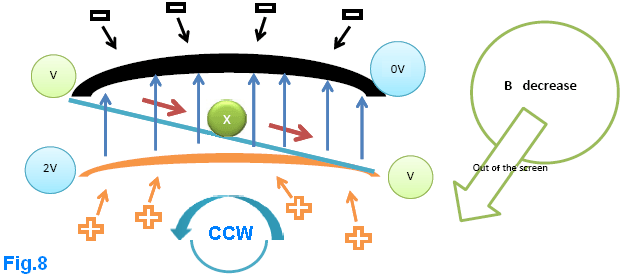 In a dynamic perspective the coil sees the capacitor in the X position, the coil situated between A and B, comparing this to what happens in a normal L/C circuit at this phase the coil has to drive a current outside its region, the outside region between A and B has to be position X. when the magnetic field induces a current to recharge the capacitor between C and D, the induced electric field will do this job because it will change the direction of rotation to be CCW (Fig.8), and this behaviour will tend to keep the current at a high value while the voltage increases! The position of the capacitor in this device has to be the position of a spark gap. A spark gap in this position will improve the performance dramatically and amplify the power gain. The Resonance Energy device works with radio speeds above 20 kHz. The ambient background electrons are usually found in a dormant or inactive state and this makes the drawing-in of ambient electrons a difficult operation. For this reason, we need an earth connection to improve the performance of this system, later in the video, Don Smith talks about something new, the earth connection isn’t needed because there is something called air grounding.  To activate air electrons effectively we need another source of power, actually this source of power exists as a negative energy but before we go further, we have to see the symmetry between the electric and magnetic sides. When we start from A to C we have half coil-capacitor while from D to B we have capacitor-half coil. To understand how our extended TBC receives negative energy, it is better to see the way in which the device oscillates. There are two methods of feeding this coil: The direct method Here we have to know the resonant frequency of this coil or alternatively, we need to have the resonant frequency covered by our feeding circuit. This method is the best because we don’t need lots of power, because when we achieve resonance our extended TBC will have a very high impedance, and so, a maximum voltage will be available between A and B, and fewer turns will be needed in the reactant coil L2. The indirect method Here we don’t have to know the resonant frequency, if we feed this coil from A and B the capacitor will charge. The spark gap has a very high resistance and it will not fire until there is a voltage difference between points C and D, at that moment a spark will occur, and when that happens, the resistance of the spark gap drops from a very high value to very low value and that short-circuits any power coming from the power source until the natural coil resonance finishes! When the capacitor is fully charged, the maximum voltage appears between points A and B which is the coil side, when the spark occurs the capacitor will transform into a coil which has a capacitor built into it! This operation provides the natural resonance needed without causing any problems. Caution! When we feed this coil from point A to point B and then disconnect it from the power source, you would then expect to discharge it by short-circuiting point C to point D (usually from the location of spark gap). If you do this and then touch the coil you will definitely receive a substantial high voltage shock! Even if you see the spark, the spark will not discharge this capacitor immediately but it will cause the coil to oscillate again and recharge itself. This device isn’t a simple capacitor because when you short-circuit the spark gap it will transform the electrical energy into electromagnetic energy capable of recharging the capacitor again. If you try to short-circuit points A and B in an attempt to discharge the extended TBC, then these two points will transform into electric points (due to the symmetry). From a static perspective, the capacitor can take an AB position as well! The solution is to short circuit C to D permanently and then short circuit A to B at the same time. As I mentioned before, there is a need for extra energy in order to activate air electrons effectively. In reality, this is not exactly what will happen as the arrangement is complicated. The negative energy enters this device in an unusual way. The extended Tesla Bi-filar Coil will supply reactive energy in enormous amounts because there are common characteristics between reactive energy and negative energy. Reactive power is a kind of electrical power, measured in volts-amps-reactive (“vars”) which cannot do work in its present form. For sinusoidal waveforms, the formula for reactive power is The reactor coil in our system is a shortened version of a normal parallel L/C circuit. The output energy received in the reactant coil has to be a reactive energy because of the presence a coil in parallel with a capacitor. The phase angle between current and voltage is 90 degrees, and so, the active energy in this case will be zero. The system acts like a negative resistor, it’s a non-dissipative system because it’s an energy absorbing system: 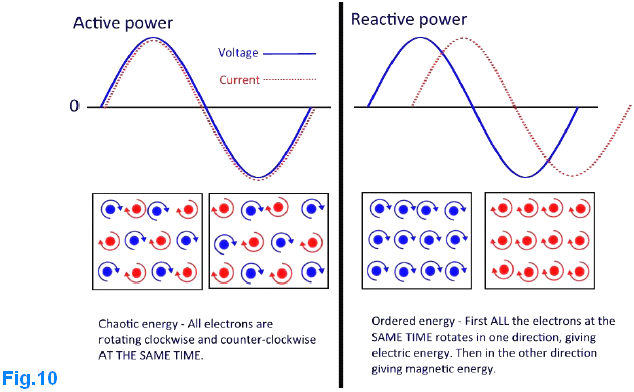 The reactive energy in this system is an advantage. The energy is ordered and so we can easily achieve super-conductivity at room temperature! As shown in Fig.10, active energy is a chaotic energy and so it is not easy to get rid of resistance. The important point where we need to focus our attention is where the voltage has a maximum value the current will be totally absent. Negative energy is a kind of electric power obtained when sparking (on-off) from a high voltage direct current (Fig.11).  This is why we need a high-voltage diode in our power supply circuit. The resonance in a normal parallel L/C circuit does not require this. If we connect a spark-gap between point C and point D, then the negative energy will be drawn into our system with the same speed as positive energy! The symmetry between the magnetic and electric sides in our positive energy reality will open the correct door for the undetectable negative energy reality! Initially, when the capacitor starts to discharge, the current increases but the induced rotating electric field will tend to keep the voltage at a high value. The capacitor discharge through the spark-gap (which requires a large amount of voltage), the current flow does not start immediately. Initially, the current increases but the spark does not occur. This pushes the voltage up higher (behaviour which is known in parallel L/C circuits), then the current increases to a high value very quickly, while the voltage is drawn down to a level which cannot sustain the spark. When the capacitor is totally discharged the current flow through the spark-gap is at its maximum value. Consequently, the extended Tesla Bi-filar Coil produces a square wave rather than the expected sine-wave which is produced by an ordinary parallel LC circuit. The square wave produced when the spark occurs, contains waves of all frequencies and so, even if the time during the spark is short, there will still be thousands of oscillations in that time. I know that it is not easy to visualise this, but it is what actually happens. This special genius design solves the most difficult problems in cold electricity, due to it's reversed behaviour compared to hot electricity. Cold electricity prefers to flow along materials which we consider to be insulators while hot electricity prefers to flow along materials which we consider to be conductors. According Tom Bearden, with negative electricity the capacitor performs in the way that a coil does with hot electricity, and the coil will perform like a hot electricity capacitor (Fig.12) 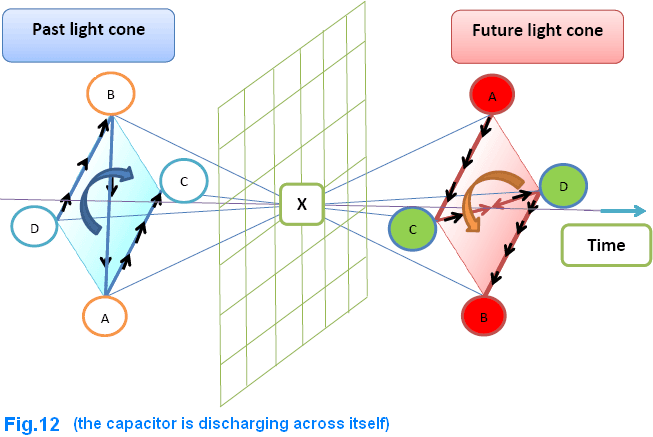 the above illustration is an attempt to understand how cold electricity work but it's better to take a look at Floyd sweet explanation of his VTA device in the Appendix (page A-1209) : it is important to note that so long as positive energy is present in a positively-flowing time regime, then unity and over-unity power gains are not possible. The summation of the losses due to resistance, impedance, friction, magnetic hysteresis, eddy currents and windage losses of rotating machinery will always reduce overall efficiency below unity for a closed system. The laws of conservation of energy always apply to all systems. However, the induced motional E-field changes the system upon which those laws need to be applied. Since the vacuum triode operates in more than four dimensions and provides a link between the multi-dimensional reality of the quantum state and the Dirac Sea, we are now dealing with an open-ended system and not the "closed system" within which all conservation and thermodynamic laws were developed. To achieve unity, the summation of all magnetic and ohmic losses must equal zero. To achieve this state, negative energy and negative time need to be created. When this is achieved, all ohmic resistance becomes zero and all energy then flows along the outside of conductors in the form of a special space field. The above explanation describes the VTA device but also demonstrates the work of the Resonance Energy device of Don Smith !! The correct model of capacitor is the extended Tesla Bi-filar Coil because it provides a link between the multi-dimensional reality of the quantum state and the Dirac Sea of negative energy. From a positive energy perspective, AB describes the coil while CD describes the capacitor, but the coil will transform into capacitor AB in the region of negative energy; and in the same area the capacitor will transform into the coil !! How can we explain this physically!? The energy equation and Dirac’s equation call for both positive and negative energy. Thus they are symmetrical with respect to energy, as are the forces of physics positive repulsive forces increase positive energy, while negative attractive forces increase negative energy. According to the modern kinetic theory of mass-energy, negative energy would merely be a vibration of charges at right angles to our ordinary dimensions in an “imaginary” direction. (Fig.13). 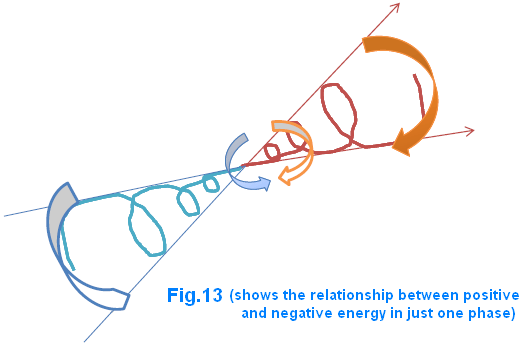 To understand Fig.13 correctly, we need to remember that we are confined by our positive energy reality; in our extended Tesla Bi-filar Coil we need the negative energy in our positive side, the spark gap in CD position is the flexible place for both positive and negative energy to be combined. Tom Bearden has an important book entitled “Energy from the Vacuum”. The following text is on page 236 where he explains the specification of a true negative resistor: The true negative resistor is an open dissipative system a priori, and equilibrium thermodynamics therefore does not apply. Instead, the thermodynamics of open systems far from equilibrium applies. The negative resistor freely receives energy from outside the system (from the environment), and “dissipates” it in interception and collection actions inside the system, to freely increase the available potential energy in the system. In circuits, the main characteristic of a negative resistor is that the environment freely furnishes some excess energy to (i) power the load, and/or (ii) move the current back against the voltage, particularly when shunted across the back emf region of the source dipole. The operator does not have to furnish this excess energy dissipated to propel the current backwards or dissipated to power the load! The true negative resistor in our system is the blue extended TBC where negative energy moves the current back against the voltage; this power will charge the coil electrically if it’s acting as a capacitor! The electric current in the negative energy region (past light cone) works in a reverse manner compared to the electric current in positive energy region (future light cone), the symmetry between the magnetic energetic side and the physical electrical side will curve space for the negative energy power to enter our device through our flexible spark-gap zone which represent a one dimensional capacitor X, the negative energy which can be represented by attraction forces will find its way through the spark-gap to increase the electric energy through AB, the system will continue its divergence and the clockwise rotation of the negative energy current will increase the counter clockwise rotation of the hot electric current (potential energy), this tends to amplify the power between point A and point B which represents the voltage gained by this virtual current! We are examining the first instant when the capacitor discharges across itself (transform into coil), the curved AB space will transform into one point in the negative energy sea which is the capacitor in our imaginary extended TBC. Similarly, when the magnetic field collapses and charges the capacitor across CD, the magnetic field returns to its background level, the space-time continuum is reversed by the fields which are produced in the presence of excited coherent space flux. These quanta have been attracted from, and ultimately extracted from, the virtual vacuum, the infinitely inexhaustible Diac Sea (from Floyd Sweet papers in the Appendix). Like charges have repulsion behaviour on the positive energy side, while they attract each other in the negative energy region. This information is essential for an understanding of the nature of the negative energy sea. When the turn comes (second time period) for our capacitor to be charged again with opposite polarity, the system will diverge toward negative energy space to close the loop in that space !! The current passes from C to D to charge the capacitor but in the virtual dimension it starts from D and finishes in C. This power will charge the capacitor magnetically if it's a coil. As you see there is positive real energy and undetectable negative real energy. I think that Don Smith preferred the name ambient background energy as opposed to Zero Point Energy because there are two regions from which we can take power, namely, over ambient background energy and below ambient background energy. At this point, we can understand why cold electricity prefers insulators rather than conductors. This kind of power is capable of running in an imaginary dimension parallel and reversed relative to our ordinary, familiar dimension. But… according to Floyd Sweet; when run in parallel with positive energy however, cancellation (annihilation) of opposing power types occurs. This has been fully tested in the laboratory. This applies to the chaotic positive energy flowing regime time when voltage electrons (ccw rotation) and current electrons (cw rotation) run together at the same time, our Reactive Energy resonance system works in harmony with negative energy, our previous study allows us to draw us some important conclusions: For the first time period, we have (C discharging across L); + energy increase magnetic energy ---- I - energy increase electric energy ---- V For the second time period we have (L charging C); + energy increase electric energy ---- V - energy increase magnetic energy ---- I since magnetic energy is the current and electrical energy is the voltage and because they are out of phase (reactive energy), positive energy will work in harmony with negative energy and no cancellation will appear. Our extended TBC is a very important device not only because it can supply unlimited electric power but it give us an exceptional opportunity to understand the way that energy flows inside our universe! When the device oscillates it produces cold electricity and hot electricity, this means that the device is able to relate to both positive and negative energy. The flow of energy has two directions; from positive to negative and vice versa. Let’s think about the physical way in which things work. In this analysis I’m trying to explain some deep physical aspects about positive and negative energy. As illustrated in Fig.12 and Fig’13, it is important to consider energy flow in relation to time. These two pictures just represent my thoughts and understanding of the subject. Cold electricity has the ability to produce an electric response when it interacts with metal surfaces. This can also be seen in the Casimir Effect where two non-magnetic metal plates, which are not carrying an electrostatic charge, are suspended very close to each other. The plates do not hang straight down but move towards each other. Cold electricity has the ability to produce an electric response when contacting metal surfaces because it’s able to ionise empty space. In our extended TBC, when the spark occurs, we are actually colliding the space-time field through one point (the spark-gap). The space-time field is, in my opinion, the space where negative and positive energy exist together, they exist together but cancel each other out due to a constant ratio. If we take a mass with a gravity field around it, and we move the mass and create a mass current, a new field is also created. It is a different kind of gravity field with no source and no sink, when the speed of the mass increases, then the created gravity field increases also. If the mass reaches the speed of light, then this means that it has the value E = mC2 as a positive energy. mC2 is the maximum value exchange between positive and negative energy admissible by zero point fluctuation (ZPF) for that mass to exist the way it does in its time-space field, the mass has two options to reach the speed of light: 1. It will transform into exotic matter. 2. It will break the time-space structure. The only places which provide these two conditions are black holes. Black holes exist in the centre of galaxies which provide the rotational energetic symmetry between the mass and gravity field - see Fig.14, Fig.15 and Fig.16. 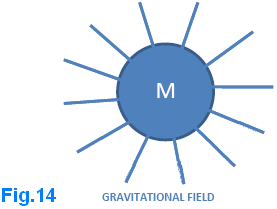 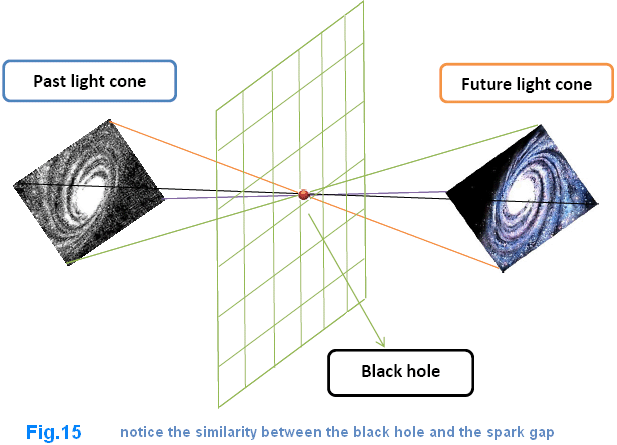  For a spiral galaxy to maintain its shape with cosmic dimensions (the diameter of galaxy may exceed 100,000 light years) there is a need for a negative energy to be the underlying energy for space-time throughout all of that galaxy. That negative energy has to transport virtual particle instantly! The transformed physical matter (including space-time!) provided by black holes furnishes an excess of positive energy in the galaxy, providing stability and symmetry. Black holes are not a fracture in space-time but they are essential. The above explanation will help to clear the way for a better understanding of the nature of electric energy. This explains why a sharp positive-going DC electric pulse interacts with negative energy to produce cold electricity which is an instant response from the negative energy sea. This response does not start from the spark-gap, but it ends in it! The negative energy will rotate to finish in the spark gap, this will squeeze the space-time to provide excited coherent virtual particles which in turn produce electronic responses when contacting a metal surface. From my point of view, the electronic responses created in metal surfaces have a magnetic angular momentum. Cold electricity is able to charge a capacitor to a much higher voltage than the capacitor’s voltage rating, even if the capacitor’s rated voltage is low. The question which springs to mind is; do electric fields inside a capacitor charged with cold electricity really exist? If the answer is yes, then why isn’t the capacitor destroyed? In my opinion, it is because the electronic responses caused by cold electricity have magnetic angular momentum instead of electric field lines. I suggest that the presence of magnetic field lines between the positive and negative plates of a capacitor charged with cold electricity are actually as shown in Fig.17. 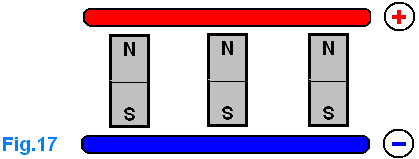 When the spark gap impacts on space-time (that is, when the spark occurs) the response from the negative energy sea looks as if it should neutralise the excititation created in the positive energy side (Fig.18). We can’t detect the movement of negative energy, and so we only see the impact which it has in our positive energy reality. 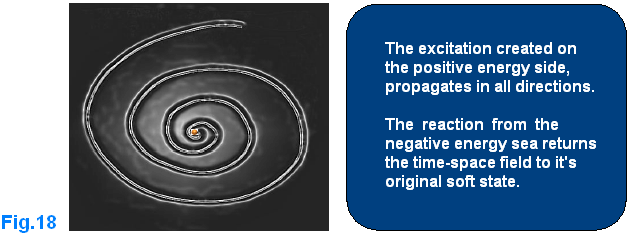 The small red ball in the above drawing, is the spark gap which is the door for negative energy to enter our positive energy reality; the negative energy sea will react both before and after the spark occurs. Referring back to Fig.14, before the spark-gap fires the negative energy will rotate starting from the spark-gap to neutralise the excitation created in the positive energy side (Fig.19a) and when the spark-gap finishes firing, the negative energy will end in the position of the spark gap (Fig.19b). 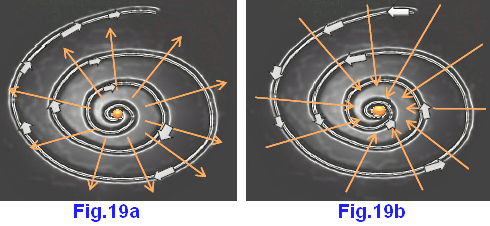 The Bloch wall area in an ordinary permanent magnet, is the area of electron separation. Let’s see how this happens in our extended Tesla Bi-filar Coil. During the first time period, when the capacitor starts discharging across itself to become a parallel L/C circuit, point A will provide a maximum voltage while point B is the maximum current. The current flow starts from point A and finishes at point B. The system is now producing magnetic energy and because of the magnetic field increase, the electrons will start from point B and flow to point A which causes clockwise rotation to neutralise the counter clockwise spin of the voltage electrons, and cold electricity will charge the coil electrically if it is acting as a capacitor, and it will push the current to go back against the voltage by providing a magnetic angular momentum (the clockwise rotation shown in Fig.19a) at point X the result is to turn back the voltage electrons, causing strong initial potential electrical energy which increases the electrical energy. Current in cold electricity is the equivalent of voltage in hot electricity. The Bloch wall is the place where negative energy interacts with our E-TBC, in other words when the spark-gap fires, the current will not start immediately because the negative energy will supply a virtual current by providing a CW rotation in the Bloch wall area X. This virtual current is a compensator of the real current but it will not absorb the power from the voltage electrons which increase the available potential electrical energy. All this happens before the real current increases to provide the magnetic energy. Caution: Please be aware that high voltage capacitors have dielectric recovery which stores the electric field for a long time. High voltage capacitors need 5 minutes or more to discharge completely. Energy is everywhere and in enormous amounts ready to be taken for free. When we do that, we do not reduce the available power because the universe is full of energy, the energy in our universe is the source, physical matter is the energy in a visible form and the energy is in invisible matter form. The presence of the negative energy sea beside our positive energy reality, raises an important question, namely, why they are separated when they could be united? They are separated to let our universe exist in the way that it does. Negative energy serves our existence because it's designed to be the under background energy level for our foreground positive energy reality. Our existence is a thin part between those two energetic oceans. Negative energy is extremely active until the point when it appear to be nothing! We now need to explain another important behaviour of our extended Tesla bifilar coil, namely, it’s super conductivity at room temperature. One of the puzzles in this device is its capability to equal the voltage with the current. The wire of the coil AB can receive ambient electrons because it’s the surface for the capacitor CD; let’s examine this surface in Fig.20:  When the capacitor discharges across itself to become a parallel L/C circuit, the induced rotating electric field (with the help of negative energy) creates a difference of voltage between adjacent plates, this voltage according the Gauss law causes new electrons to be present in the system.  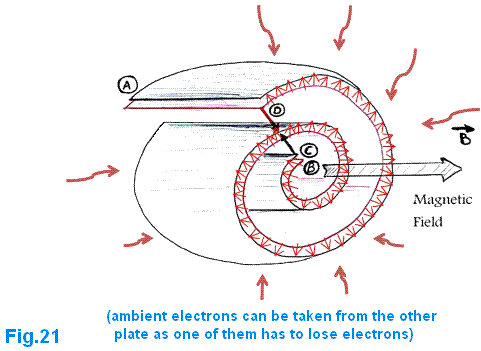 When ambient electrons enter our system (Fig.21), they increase the power gain across the Y axis (Fig.20). When the current flows inside the extended TBC, parallel currents will be added while parallel voltage will be the same in the Y axis, while in the X axis serial voltage will be added while serial currents will be the same!! On the X-axis: sum (V) equals (I) This system treats the voltages and currents in the same way, the voltages and the currents are physically equal. When this happens the device squares the electromagnetic flux and becomes a near-unity system in every process which will replicate the electric power according to the working frequency. This is a near-unity system due to the super conductivity at room temperature where the electrons don’t face the usual reduction encountered in an ordinary parallel L/C circuit. A normal L/C circuit cannot produce the super conductivity at room temperature because the exchange between the electric power and the magnetic power must lower one of them in each process. In our extended TBC they are combined in such a way so as to amplify the power in every process, and so the total available electrical energy in each cycle is twice the power available in a charged capacitor which can be seen from the following relationship: (consider the similarity between the magnetic and electrical energy in a resonating parallel L/C circuit) Here, I need to explain the importance of the reactive electric power in the Resonance Energy device, in an alternating electric system where the voltage and current go up and down at the same time (Fig.10). Only active, real power is transmitted and when there is a time shift between current and voltage both reactive and active power are transmitted. When this time shift is 90 degrees (π/2 degrees) the transmitted real power will be zero as discussed above. This does not mean that there is no power, but it does mean that we cannot use this power in this alternating form, we have to transform it into Direct Current so that both current and voltage are united. Reactive power looks like a skipping rope (Fig.22): 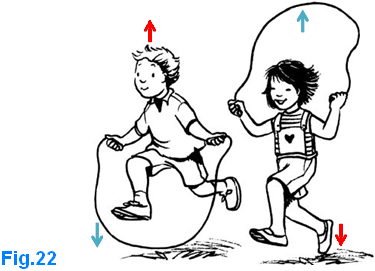 Imagine the voltage to be the rope and the children's bodies are the current. Reactive power looks like a skipping rope, the active power will not let the kids’ bodies move correctly. Reactive power is an essential part of the Resonance Energy device, and a skipping rope is good example which shows how kids go up and down without any problem. This sort of movement exists in our device. The separation between voltage and current in the Resonance Energy device is crucial for producing and cloning electric power at radio frequency speed. A proper method of collecting and converting the huge available electric energy is needed. The example given in Fig.22 is important when planning to collect and convert the available electric power. If we simply use a step-down transformer it is highly likely that we will alter the current which will reduce the gained power. With reactive energy, when the voltage is high the current is low. A step-down transformer will lower the voltage but it can’t amplify the current as expected! In a normal transformer we amplify the current depending on the available active power (V x I):  Physically (Fig.23) the electromagnetic flux inside the transformer has two components, the electrical component V and the magnetic component I, for successful transfer of electric power from the primary to the secondary, both of them are needed at the same time. In our case, when V is high the product (V x I) is low due to the time shift, even if the available power could achieve megawatts! Another factor which we have to take into consideration, is the high-speed needed to replicate the power, using a transformer to lower the voltage imposes the need for a special transformer core which is able to respond at radio frequencies. These facts have to be taken seriously if we want to collect the available energy effectively. 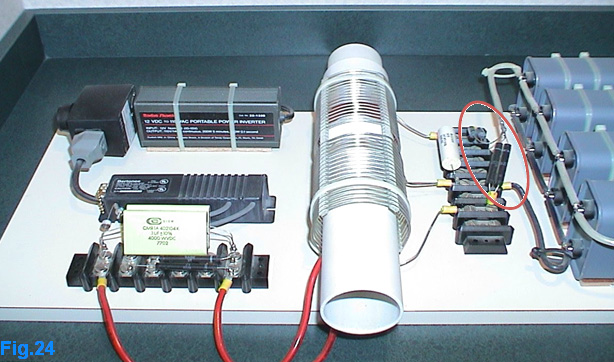 Personally, I prefer to improve on the use of high-voltage diodes as shown in Fig.24. It is better to use a diode bridge constructed with fast recovery high-voltage diodes. Fast recovery diodes have the ability to return to their blocking state very quickly, making it possible for the other half-oscillation to be accumulated in the high-voltage capacitors, each cycle (up and down in Fig.25) will give power similar to the power available in a charged capacitor given by the following equation ½ C V2  The amazing, energetic behaviour of the extended Tesla Bi-filar Coil make it totally different from an ordinary parallel L/C circuit. Our extended TBC gives twice the frequency of an equivalent parallel L/C circuit. This means that if you form the same inductance with the same capacitance in an ordinary parallel L/C circuit, then that will produce only half the frequency that the same combination produces with an extended Tesla bifilar coil form! I have not been able to verify this because I don’t have an oscilloscope or a frequency meter. That, of course, is no excuse for not thinking about how the device will act, so the following analysis is an attempt to imagine the energy equation given by Mr. Donald Smith as: To simplify things, let us analyse only the voltage. When the capacitor discharges across itself to become a complete parallel LC circuit, at that instant, the magnetic field reaches it’s maximum value. What makes this system different, is the induced rotating electric field. This field will instantly charge the capacitor with the opposite polarity before the induced current resulting from the collapsing magnetic field can do it. As we learned before, this is the key to energy amplification. Resonance is the key for energy multiplication, our extended TBC acts like one device, so the passage from the positive cycle to the negative cycle takes no time. In other words, the device has the ability to change it’s direction of charge instantly. The yellow zone in Fig.26 is absent (compared to a normal parallel L/C circuit), when the energy cycles up and down (Fig.25) the device gives twice the power available in the capacitive side of the extended TBC.  The power is each cycle will be given by: Since the frequency will affect both the voltage and the current we will examine the equation number 1 as follows: CV x V, the product CV is the quantity of charge available in a charged capacitor, if we divide it by 1 second this will give us the current since Q/T is the current in one second. Let us suppose that the frequency is 3 Hz. 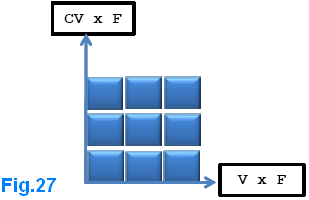 From Fig.27 we can see that the total available power is proportional to 9 which is the square of the given frequency. Each cycle has the power of C V2, the number of cycles in one second gives us the frequency; the frequency will replicate CV which is the current and this will give us CV x F and replicate the voltage by the product V x F, this analysis is the best explanation of why the voltage equals the current in this system, because CV x F is the available current and V x F is the available voltage! This seems strange; how could the product V x F be the available voltage since the result is very high since we are working with radio frequencies above 20 KHz? The example given in Fig.23 will help us understand this. The energy formula gives the available DC power when converted from its alternating state; the electromagnetic flux will be squared causing amplification of both current and voltage. In each second, the available power is CV x F x V x F, the power obtained depends on the number of turns in coil L2, and the limiting factor is the product V x F which is a very high number in practical systems. Below this factor, the current is very high being the product CV x F !! This explains why a megawatt sized unit can fit quite easily on a breakfast table and it explains why this device is able to give any required level of energy. The energetic formula of our extended TBC can now be written as follows: This equation gives the available power in watts when converted into high-voltage Direct Current. When the device oscillates the power obtained is pure reactive energy, Volt-Ampere-Reactive (VAR) is present while active electric power (W) is absent in this dynamic state, Fig.28:  In practical terms, the extended TBC is just a high-voltage capacitor which has the ability to let the current penetrate inside itself, so it has both magnetic and electric specifications. Practical section A free-energy device is something which is fascinating, being hasty in wanting to build and test one is common, but that is not good. High-voltage with high current isn’t a game !, your first mistake may well be your last. If you decide to build this device in your house it is a good idea to use locks and keys and sticking a high-voltage warning symbol on the device is a sensible action.  I am not encouraging you to actually construct the device described here; the above theoretical information provided is the most important section. When the device is fully understood, then taking care when near it will be automatic. This device is a very special Tesla coil, when increasing the voltage in a normal transformer the current drops, but here the current increases in the same manner as the voltage does! This device has current equal to the voltage. Resonance will impact both the voltage and the current. The special geometrical design of the extended Tesla Bi-filar Coil, including the flexible position of the spark-gap, produces the needed rotational energetic symmetry between positive and negative energy. As we have already seen, the spark gap opens the door for a massive inflow of electrical energy to be present. I personally got shocked indirectly from the L2 coil and I certify the risk of this device. For construction, the first thing we need is a source of high-voltage. The device can be fed using two different methods as described here. The first is the direct method where the high-voltage power source has the same frequency as the natural resonant frequency of the extended Tesla Bi-filar Coil. The second method is the indirect method; where there is no need to know the frequency of the reactor (active) coil. The high-voltage power source is needed to feed the extended TBC which is the reactor coil (active coil), Fig.29 shows an easy to build oscillator: 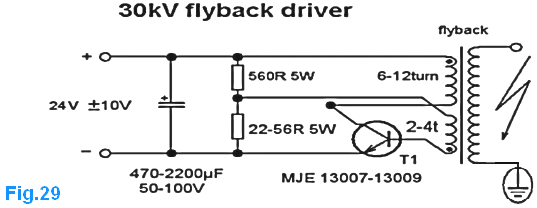 It’s better to use a flyback transformer which has a high-voltage diode built into it. Flyback transformers are readily available and cheap. The above circuit diagram is for a flyback transformer, where a high-voltage power source enter our reactor coil via points A and B (Fig.30): 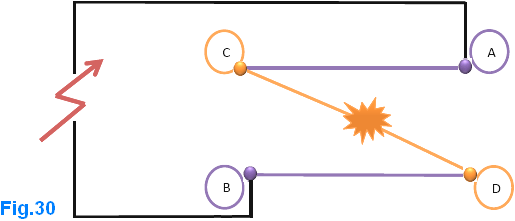 Initially, the capacitor charges up to the value needed by the spark-gap. When the voltage across the electrodes of the spark-gap reaches a high enough value, a spark occurs causing the resistance of the spark-gap to jump from a very high value to a very small value, short-circuiting any power coming from the power source until the natural resonance finishes. The capacitor transforms into a complete coil which has its capacitor built into it. The natural resonance of the TBC is assured when using this method, but it does have some disadvantages. The frequency produced by power supply/spark-gap combination has to be high enough to allow more power to be produced and this calls for a powerful power source. On the other hand, the voltage between the reactor coil AB will be limited by the distance between the electrodes of the spark-gap. This imposes the need for a large number of turns in the L2 coil. The output current obtained is directly related to the available voltage between the capacitor plates which form the device between A and B. We need to bear in mind that the capacitor incorporated inside our extended TBC operates in a dynamic fashion where no displacement current exists. The direct method of feeding the reactor coil with its own exact natural frequency is the best way to get the most available power, but this creates a real problem as it is not at all easy to find a high-voltage power supply adjustable over the range of frequencies which we want, especially frequencies above 200 KHz. We may require our extended TBC to work above 200 KHz, and for that, we may need impedance-matching capacitors (Fig.31). 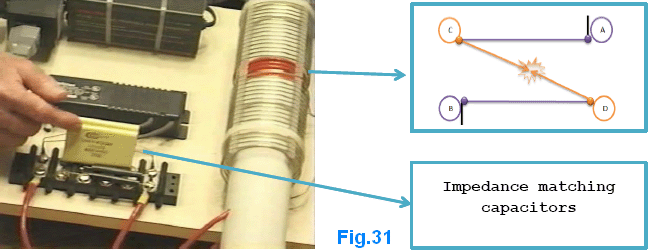 The two yellow capacitors seen above are for impedance matching since the working frequency in Don Smith’s device was very high, requiring a neon-tube driver to supply it.  Impedance matching is simply the process of making one impedance look like another; in our situation it is necessary to match the load impedance to the source. For example, if the extended TBC resonates at 2.4 MHz, (this is the load), and the neon-tube driver operates at 35.1 KHz (this is the source) we need to add parallel capacitors to our extended TBC in order to make it resonate at 35.1 KHz. In practice, you need to short-circuit the points C and D and measure the inductance of the E-TBC (L2 has to be in place for this measurement). After that, remove the short-circuit and measure the capacitance of the E-TBC. This gives you two values “C” and “L”. The resonance of the Extended –Tesla Bi-filar Coil is given by: When you add a capacitor for impedance matching to the extended TBC, the resonance frequency will decrease with the following relationship I believe that we can use the above equation to calculate the value of c* which needs to be added in order to achieve resonance. From equation (b) we could write  Using equation (c), we will be able to calculate the needed capacitor for impedance matching; the value obtained is in Farads, and that equation the frequency is in Hz and the inductance in Henries. When you have the correct C* value and you power your device up (Fig.33), resonance will not be achieved instantly because the spark gap forms the full L/C parallel circuit only when it fires!! 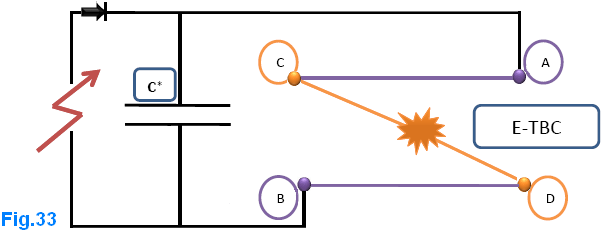 The first thing which happens is the charging of capacitor C*, after that the capacitor “C” of the extended TBC will be charged until it reaches the voltage needed to make the spark-gap fire. When that happens, the spark-gap has a very low resistance value, making the E-TBC fully formed. At this point, the incoming electric energy from the high-voltage power supply will find a load whose impedance matches it’s resonant frequency. This, in turn, produces the maximum possible voltage across inductance L of the E-TBC. Further, the resulting electromagnetic field will increase cycle by cycle causing the device to resonate fully after a very short time. 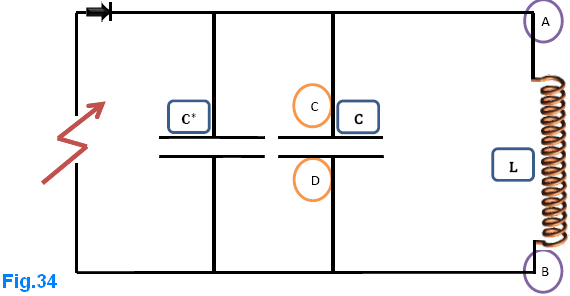 Constructing the extended TBC The extended Tesla Bi-filar Coil is just a high-voltage capacitor which has a magnetic behaviour. So, it is both a capacitor and coil at the same time. Constructing this device is relatively simple. You need two lengths of aluminium foil, each 1.2 meters long (later I will explain the possibilities of modifying the characteristics of an extended TBC). Because it is a capacitor, you need 3 pieces of polyethylene sheet, each 1.3 meters long. To construct a high voltage capacitor usually you need 2 pieces of polyethylene sheet but it's better to use 3 pieces since we are working with a high voltage (Fig.35), this will depend on your skills in constructing a high voltage capacitor. You need welding rods to insure the electrical conductivity of the aluminium foils, Fig.36 indicates how to do that. Actually the best length and width of aluminium foil need some experimentation; you have to establish the positions of the magnetic and electrical points (Fig.37). A and B are the magnetic points (coil) while C and D are the electric points (capacitor). 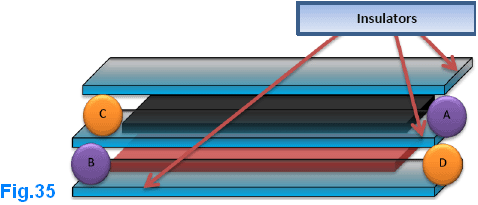 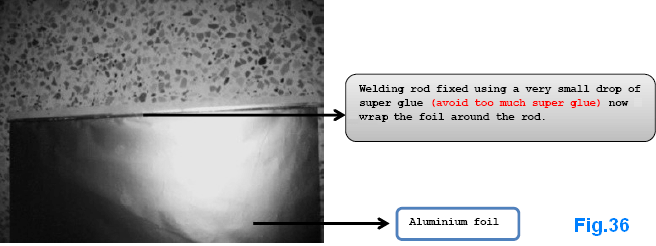 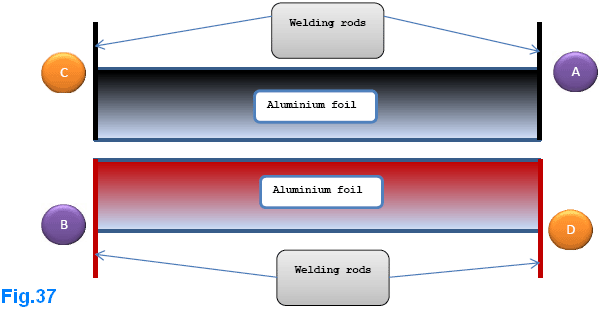 The E-TBC need a coil former for it to be wound on it (Figure 38) 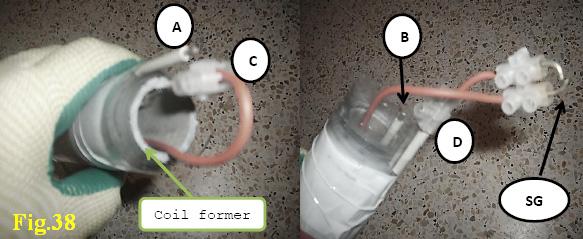 The following photo shows the dimensions used in the prototype (Fig.39)  Internal arcing is a common problem with high-voltage capacitors (Fig.40) 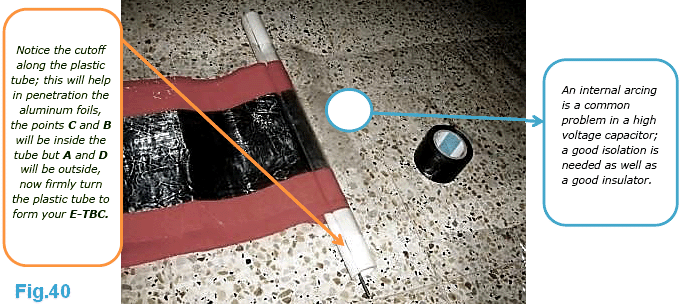 The best combination between the length and the width of an extended TBC has a major influence on the electric energy obtained at the L2 coil (the reactant coil). For example, the electric arcing experienced at the L2 coil using the E-TBC shown in Fig.41, was very weak, the length shown by the black arrow is very much greater than the width (orange arrow), this give a weak magnetic flux due to the small coil inductance, the coil inductance is very important because it will transform the replicated power into electromagnetic flux.  The reactant coil (L2): 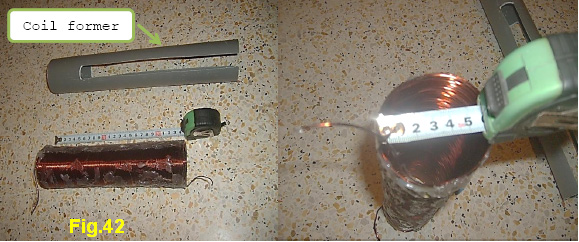 The coil length is about 25cm as shown in Figure 42, the diameter is 6 cm, and the thickness of the wire is 1.18 mm (AWG #17 or swg 18) and the number of turns is about 200. Fig.43 shows some nice sparks from L2 coil:  The spark shown above is very strong but it can't burn through thin paper! This proves that the electric energy obtained is reactive, and so it can't do work as it is. Converting a high-voltage reactive electric power into Direct Current isn't easy to achieve. Working with a voltage over 10KV is really dangerous, in my device I had about 40KV of reactive power which to be converted. Ideas: To solve this problem let's think again about the energy equation of our extended TBC. The idea is to work with a step-down method rather than using the step-up technique. The energy equation can be written like this: Power in one second = CVF x VF CVF is the available current in one second since C is the capacitance value of the E-TBC, V is the voltage used, and F is the resonance frequency. VF is the limit value when stepping up the voltage across the L2 coil, the gained electric power goes up proportional to the voltage value across L2, when achieving VF the total obtained power will be exactly: C V2 F2 which is a very high power level. I know that this can be confusing, but this system has equal voltage and current. When stepping up the voltage, the current remains constant because it depends on the product CVF. We could increase the voltage by adding more turns to the L2 coil, when doing this the current is the same but the available electric energy will be given by: Power in one second = CVF x V* Where V* is the voltage across L2. Using this new equation will help us a great deal in determining the voltage needed across the L2 coil in order to achieve the required electric power. Example: Imagine you have the following working conditions: C = 10 nF V = 30 KV F = 100 KHz You need a power of 30 KW, what L2 voltage is needed to achieve this power level? Using the previous relation will give us: 30,000 = CVF x V* 30,000 = 10 x 10-9 x 30 x 103 x 100 x 103 x V* 30,000 = 30 x V* =======>V* =1,000 volts to obtain 30 KW you only need 1000 volts across the L2 coil. To achieve this power level you need direct resonance, feeding the E-TBC with a high-voltage only, without direct resonance, will not give this result since the voltage across the coil of the E-TBC will be limited by the electrode separation of the spark gap. The voltage V across the E-TBC is very important here because the product CVF is the current obtained using the reactant coil (L2). The working frequency F is important too. Similar to an ordinary transformer, if we want to use the step-down method effectively, we have to think about using too many turns when winding the E-TBC. When designing an E-TBC, it is important to think about the length of the capacitor plates because the length between B and D will give the total value of the induced voltage between the capacitor plates which increase the electromagnetic flux (Figure 44).  A simple diagram of the resonance energy device can be like the following drawing (Fig.45):  When converting the reactive electric power from the L2 coil to Direct Current and stepping down the energy obtained to the mains voltage and frequency (for example, 220V, 50Hz), the current will be boosted yet again. Some applications may not need an inverter. An electric heater can be fed directly from the capacitors banks but we have to prevent the Alternating Current coming from L2 to enter the heater by using another high inductance coil. Another idea about increasing the capacitive side of the extended TBC is to use etched aluminium foil to increase the surface area. The foil can be treated chemically using high-voltage. The result is shown in Fig.46: 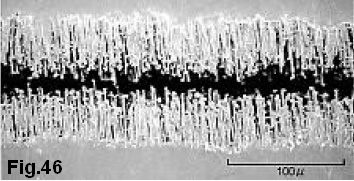 Maybe this is the technique used by Donald Smith to avoid the need for an earth connection. I have already mentioned about using negative energy to avoid the earth connection requirement in the Resonance Energy device but I can't guarantee that this is the method used by Donald Smith. Any questions, or suggestions are welcome via my e-mail: hopehope3012 (at) gmail (dot) com Ming Cao, a developer in mainland China, comments on the designs of Don Smith, and Tariel Kapanadze. He says: None of these things originate from me, they come from Tesla and God.
I get all these by low voltage from a signal generator, as I haven't finished building a high voltage device yet, although I'm already working on it. But I think it's safe for me to believe that these results are solid and good enough to share. Here is a image from Tesla's patent 593,138 Electrical Transformer. 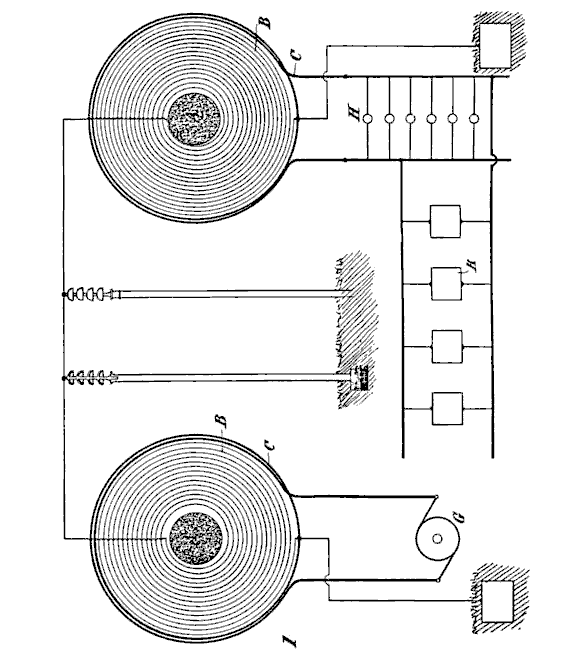 We can see it's exactly the same as Nick Giannopoulos' setup, except that Tesla is using a generator in this diagram, I believe for simplicity. As long as the generator is generating the exact frequency of current, it will work fine. The secondary at the energising side is a quarter-wave coil, and at the pick-up side is another quarter-wave coil. The highest voltage is at the far end of these two secondary coils and their connecting wire, and zero voltage is at the very outside turn of each of the coils. Now if we change the spiral form coil to helical, it becomes Nick's set-up. And let's take this further, we can shorten the connecting wire until the two solenoid secondary coils actually become one big coil, then, when combined it is a half-wave coil, and the highest voltage is at the middle point of it. Now it becomes Don Smith’s and Tariel Kapanadze’s device, like this: 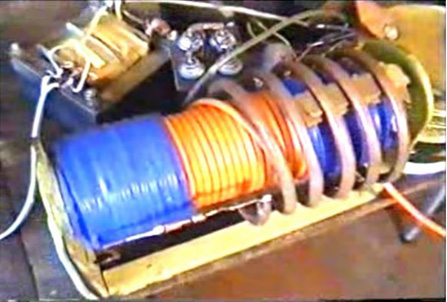 Because the energy is also coming back from the energising side, Kapanadze adds another pick-up coil right underneath the primary energising coil. This arrangement, I think, is very hard to replicate, because it is so very hard to tune, for several reasons:
Don Smith did indeed say something useful. He said that we can make the secondary coil a fixed size, and then slide the primary coil inside it. Well based on experimental results, this sliding process is altering the actual effective length of the secondary coil. In general, we should assess coil size by counting the turns from the turn right underneath the primary energising coil, to the turn right underneath the pick-up coil, this section is the actual secondary, and this section should be a half-wave resonate coil, the rest of the coil just sits there doing nothing. But it's not that simple, the terminals of the secondary coil should connect to the earth or to a large sphere, or a typical Tesla Coil secondary with the same quarter-wave resonant frequency. Otherwise the signal will bounce backwards and forwards in the coil producing a mess, or generating an arc, and this is bad for performance, and this is why a solid ground connection is desirable. And this is the true meaning when Don says "slide the primary coil to do the fine tuning". So, returning to the Kapanadze device, the energising coil covers a large area of the secondary coil, making the effective length of the secondary coil very much shorter, again, boosting the working frequency of the device even higher. For such a device, it is impossible to tune it without a 20Mhz signal generator, an oscilloscope and complete understanding of how a longitudinal wave behaves. For a start, I don't even know where to connect the oscilloscope probe or which terminal should connect to the ground, I'm so lucky to be able to watch Eric Dollard's old video, and I recommend everybody to watch that video, watch it over and over again, also many other educational videos from Eric. A lot of fundamental stuff about how a longitudinal wave behaves are explained there, it's like a treasure map covered in dust in a quiet corner of an open library. Ming’s video demonstrates what he is saying here. For the video he uses an input coil, a monitoring coil and a secondary coil, each end of which is earthed using separate earth connections:  Ming also remarks: For the set-up in the video, the secondary coil is wound using 1mm diameter enamelled copper wire, 365 turns around a 160mm diameter PVC pipe. The total coil length is 39.5cm. The total wire length of the secondary is approximately 182m. The white material is several layers of insulating glue to prevent arcing between adjacent turns when working with high voltage. The primary coil and the pick-up coil are wound with audio cable which is more than 4 square millimetres in cross section. The primary coil has 2 strands, 2 turns. The pick-up coil has 4 strands and only one turn. I use this thick wire, because I am going to use these coils for my high voltage project. For a low voltage experiment like shown in the video, it would be quite adequate to use ordinary copper wire of 1 square millimetre cross section (swg 18 or AWG 17). If the secondary wire length is reduced, then the resonant frequency will be higher, but the principle is the same. If only low voltage is going to be used - perhaps just to study the nature of longitudinal waves, then the secondary coil can be made using very thin wire of 0.3 to 0.4mm diameter (swg 30 to swg 27) enamelled copper wire, this will cost much less. I made my coils with thick wire because I intend to continue using high voltages. It's been a long time, but I've got some more understanding about harnessing radiant energy. I have made two additional videos: video 1 and video 2 In these two videos, I explain the method of converting Tesla's ‘cold’ electricity to normal ‘hot’ electricity by storing it in a capacitor. I strongly believe that, the method shown in the second video is exactly what Don is doing with his famous device, which has no pick-up coil, just a two-part secondary. In the first video, I replace the pick-up coil with an uncoated sheet of copper, to show people that, this is not a transformer, and so, is not based on electromagnetic induction. The pick-up coil is fundamentally, a piece of metal which can be electrified by a longitudinal wave. I can remove the diode and the capacitor, and just let the copper sheet discharge to ground through a spark gap and two ordinary 200-watt incandescent light bulbs connected in series, the light bulbs are pretty bright although not fully lit, but pretty bright in spite of this being a non-resonant situation. They look like this: 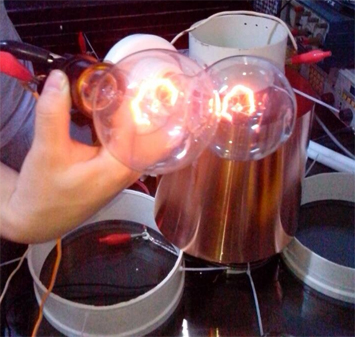 The copper sheet is electrified, and it’s charge is flowing to ground, and it is this very process which forms the current. So if we consider it as a transformer, and consider the pick-up coil as a inductor, and add a load to this "inductor" to form a closed loop, then we are going in the wrong direction. Then I re-read about Nick Giannopoulos' device, and I noticed that he said that the light coming from his bulb is blue and white. Following his circuit diagram, I believe that it is like this: 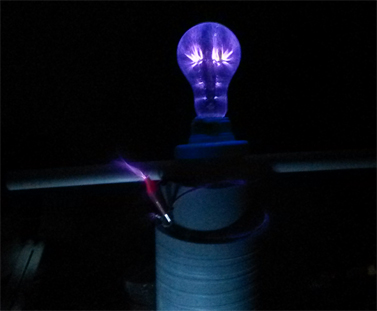 I get this kind of light when I attach the light bulb directly to the sheet copper without an earth connection or any other additional wire. Here at this stage, we have no ‘hot’ electricity. The blue-white light is caused by the high voltage of the metal, to which the bulb is attached. The high voltage is not caused by induction, it is purely static charge on the metal surface, caused by longitudinal wave electrification. If we use Tesla's specially made bulbs as shown in his lectures, we have his single-wire lighting system, and we will have a very bright light suitable for general-purpose lighting instead of this kind of blue-white light. Generally speaking, my bare copper sheet is the equivalent of Nick's pick-up coil plus his step-down transformer, which, of course, is not a transformer at all. Note: As will be seen in the videos, Ming uses two separate earth connections. One is the earthing wire of his mains electricity and the other is a connection to his cold water pipes. A Russian developer has lit a large light bulb with a self-powered Kapandze-style circuit: 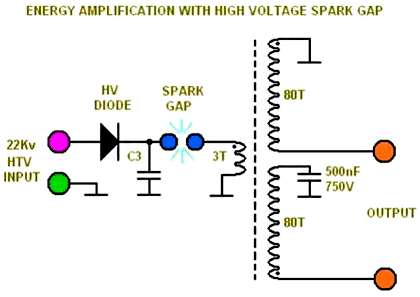 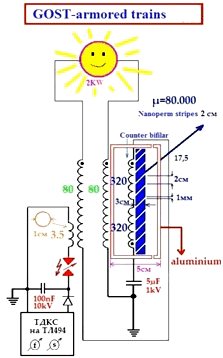 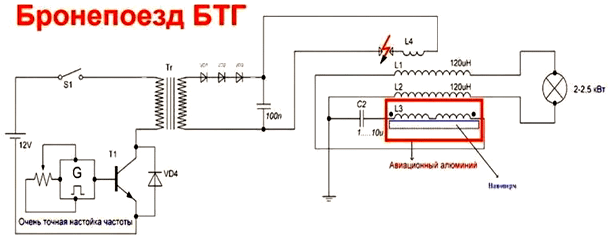 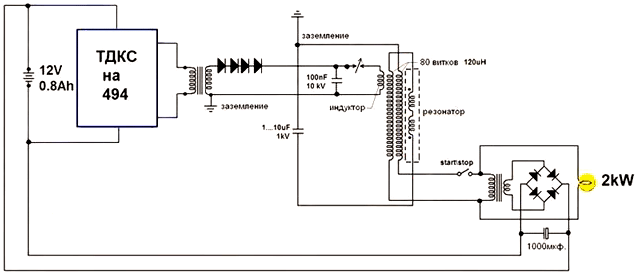   Video here shows self-powered bulb (needs an earth connection): 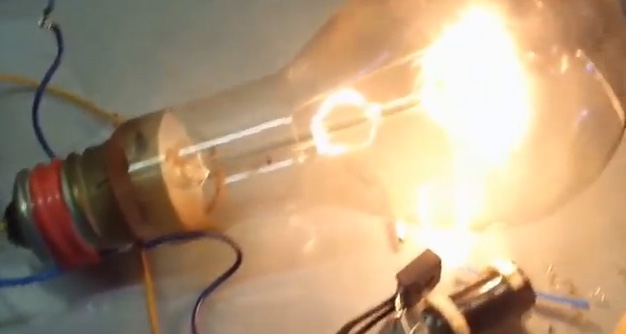 A Chinese developer has replicated Don Smith’s main device very successfully. Using an input of 12V at 1A to 2A (24 watts) he is lighting ten 100-watt light bulbs to a high level of brightness. The Chinese language video relating to this can be seen here. Here are some of the frames from that video: 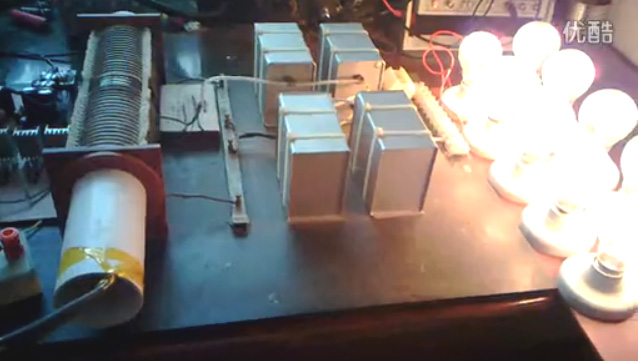   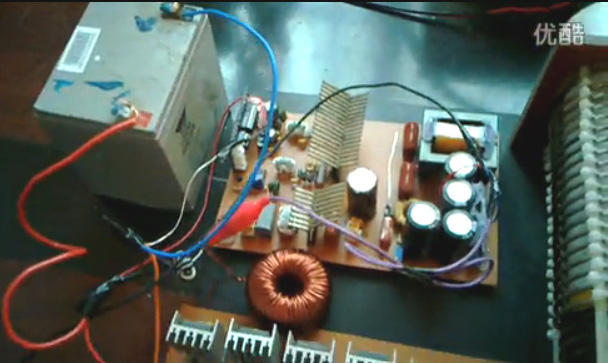 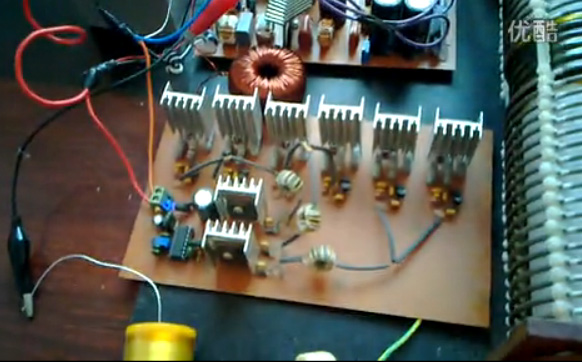 The circuitry used is shown here: 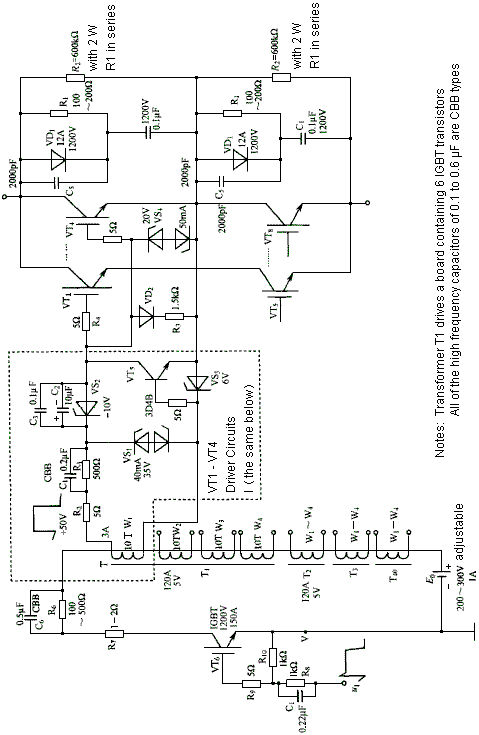 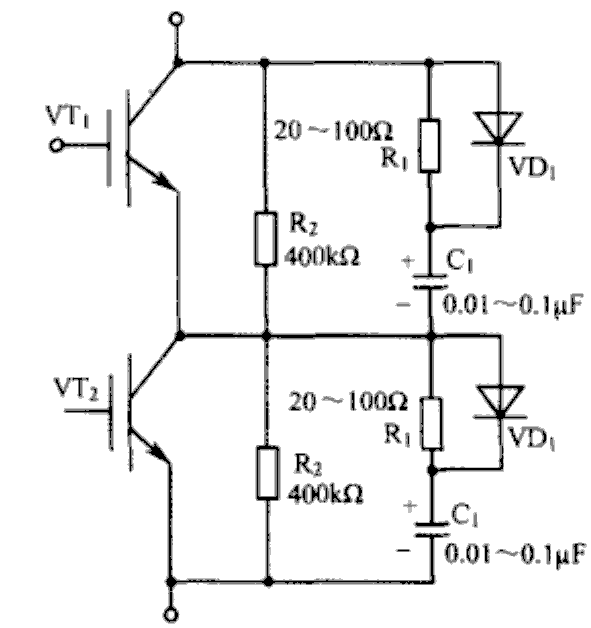 Subsequently, a forum post by a Mexican man says: Hello ‘Salty Citrus’, I love your video!!!! I can really appreciate the amount of work you and your group have spent to develop and perfect the Don Smith / Tesla free-energy device. Thank you for pursuing such a noble cause. I am intrigued by your switching network using the CREE CMF20120. How did you wire the MOSFET's? You used a UCC3825A Pulse-Width Modulator to clock the signal --> MOSFETS --> Gate Drive Transformers (x3) --> push-pull transistors --> CMF20120? Did you run the CMF20120 in series? Sorry about so many questions, but I am totally impressed by your ingenuity, and completely agree that your solid-state solution has undoubted benefits over Tesla's conventional spark gap. I would be honoured if you could take the time to answer my questions. I would love to replicate your circuits. I wish you the best of luck with your endeavours. Sincerely, ‘Lost_bro’ (half a world away) Re: ‘Lost_bro’ Thanks for the compliment. The success does credit to my team. Thanks to my team. Yes, the CMF20120 run in series in this solution. The voltage balancing between each MOSFET is critical as is the balancing between RC and DC voltage created by R. Welcome to our forum for the exchange of information. China is an hospitable country. If you have any information or ideas, please don’t hesitate to share them with us. ‘Half a world away’ is not a great distance. All the best, Sincerely ‘Salty Citrus’ An earlier entry on the Chinese forum translates as: Here is an earlier build. It is simple and has no step-down section and so cannot be self-powered:   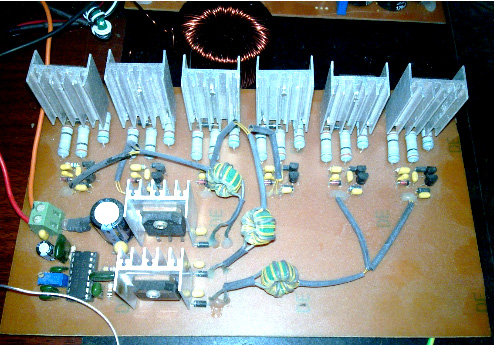   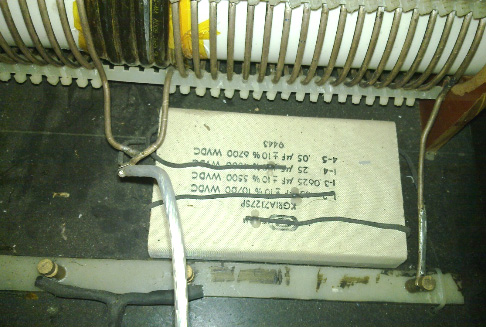 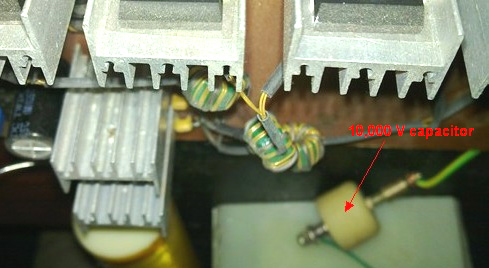 Each bulb is 100 watts. The first board has a 12-volt input and an adjustable output which can be varied from 500V to 1600V (any higher voltage would damage the four 450V 20 microfarad capacitors). In the video, the variable resistor is used to set the voltage level of the FBT after boost as the voltage step-up circuit can go up as high as 3,000 volts. The L2 coil is wound in a single direction and has just one tap at the centre. The idea is from Tesla’s Colorado Springs Notes, in which Tesla disclosed the best method for a resonant driver. The frequency used in this circuit is about 230 kHz. Question: There is nothing to do with quarter-wavelength, but is there anything with the length of the L1 and L2 coils on quarter-wavelength? Answer: I think that the phase is more important. Question: Do you need a Phase-Locked Loop circuit with a certain phase difference? Answer: Basically, I use a fixed frequency, I have tried a Phase-Locked Loop and the effect is the same. Question: Do you use direct drive with the spark gap only being used to limit voltage? Answer: You can use a vacuum tube to drive it. Question: If you drive it directly, then the loading will be very big and the current will increase, whereas if you use a spark gap, then the spark will become smaller and the current will be steady. Answer: If the load affects the input, then you cannot drive it even with a spark gap. If you trigger with a spark gap, then the load will not increase the input. The spark gap is just a switch. Question: Is there any direct Lenz relationship between the load and the primary? Answer: Once the phase has been adjusted, the primary has no adverse effect on the secondary. Commenting on his circuitry, ‘Salty Citrus’ states: The diode symbols with a tick indicate a Zener diode (or bidirectional TVS-Transient Voltage Suppressor or “varistor”). For example, in this circuit, they are used to suppress the Grid voltage of the MOSFET, to maintain the gate voltage within the range of +20V to -20V. The above circuit is just a description of the structure of the MOS series method. Specific components will be needed for your own requirements considering the MOSFETs being used in your construction. The voltage E0 can be adjusted. The source can be made using a TL494 IC operating at 12V, or alternatively, an adjustable, voltage-stabilised inverter can be used. The voltage setting depends on the numbers of MOSFETs which are being used in series and the parameters of Grid voltage and the turns ratio of the isolation transformer. The circuit is arranged so that each MOSFET has its own separate isolation transformer, and all of the primary windings of those transformers are connected in series to form a single current path. The number of turns in the primary of each isolation transformer is exactly the same. To drive an IGBT(or MOSFET), VT6 provides a high-frequency pulse current to drive the Gates of the MOSFETs, so as to achieve consistent switching. In my circuit, the frequency used is 220 kHz, for this frequency, I use six MOSFETs type CMF2012 (1200V, 37A, Resistance Drain-to-Source of just 80 milliohms). This MOSFET from CREE has excellent performance, but you have to design the drive circuit carefully, 2V to 22V for the Gate voltage will be best. I particularly stress that it is very important that MOSFETs operated in series, require voltage balancing and an accurate drive. Especially important is having synchronized drive signals and the rise and fall time of the drive signal should be as short as possible, so that the switching time difference between the MOSFETs will be short, and that improves the high frequency operation. Another Russian Development At www.youtube.com there is a video which shows a self-powered motionless generator with an output of 105 watts: 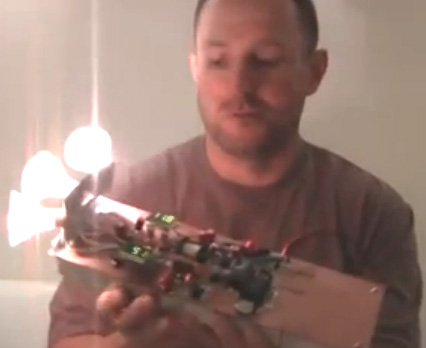 Thanks are due to Wesley for his translation of the Russian soundtrack. No circuit details are available that this time, but the video has “Part 1” in the title and so further details may be provided at a later time. Tesla Coils Back-to-Back I have been told of one man who used his common sense and produced an impressive result. He used a Tesla Coil as the driving force, and then used a second Tesla Coil back-to-back with the first one, to step the high voltage back down again. Doing that, he was able to light a series of powerful light bulbs from the “L1” output coils. He also confirmed that doubling the voltage, quadrupled the power output, verifying what Don said. He also found that adding additional coils with bulbs to the output Tesla Coil, did not increase the input power at all, did not cause any of the existing light bulbs to shine any less brightly, and yet lit the additional bulbs. That would appear to be confirmation of Don’s statement that any number of magnetic copies of the original oscillating magnetic field of the first Tesla Coil, can provide a full-power electrical output without requiring any additional input power. I’m no expert, but my understanding of the arrangement is:  As the large diameter coil is exactly one quarter the length of the smaller diameter coil, there is an automatic resonance of both when the applied frequency is just right. As the first narrow coil is identical to the second narrow coil, they are also automatically resonant together. Again, as the large coils which feed the loads are exactly one quarter the wire length of the narrow coils, they also resonate at the common frequency and at that frequency, the input power is at its minimum while the output power is at its maximum. The spike at the top of each of the narrow coils is connected with a wire to channel the generated power from the first Tesla Coil to the second one. This arrangement may seem too simple to be effective, but with Tesla technology “too simple” just does not apply. This can be seen clearly from the work of Nikanor “Nick” Giannopoulos. Before he ever learned anything about electronics, Nick read and understood Nikola Tesla’s “Colorado Spring Notes” (pdf 60Mb) and this helped with his present level of understanding. Interestingly, and perhaps not surprisingly, Nick had difficulty with conventional electronics after becoming familiar with Tesla’s technology. Nick used a square wave signal generator adjustable from 50 kHz downwards and with a fully adjustable Mark/Space ratio. This was used to drive an oil-filled car ignition coil, which, as he points out is not a Tesla Coil in spite of the frequently held view that it is. Ignition coils only operate at low frequency due to the limitations of their core material. However, John Stone points out that certain coil designs, such as those for the Fiat ‘Punto’ car, are built in such a way that replacing the core with ferrite should be possible, and that would allow high frequency operation. Anyway, Nick uses a standard car ignition coil at lower frequency and uses it to feed a spark gap like this which is constructed from two chipboard screws:  His circuit is:  Nick has had very impressive results from his circuit, although it is still very much a work in progress with more development and testing still to be done. The 24 watt input of 12V at 2A is producing two very brightly lit 220V light bulbs. This does not tell us very much about the actual output power as bulbs are notorious for lighting brightly at low power levels, especially if the frequency is high. But, a very important point is the quality of the light which is an unusual, blue-white colour, quite unlike the colour produced when connected to the 220V mains supply. This is generally a sign of the power being ‘cold’ electricity. While he has not yet had the opportunity to test it, Nick believes that the circuit as it stands now is quite capable of powering much higher loads, and considering the colour of the light, I would be inclined to agree with him, although anything like that has to be tested and proven before any solid conclusions can be drawn from what is already known about the performance. The circuit performance is much improved if two separate physical earth ground connections are made.  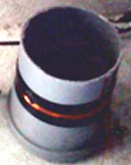 Please don’t fall into the trap of thinking that because the sparks are occurring at less than 5 kHz, that the Tesla coils also operate at that frequency. If you strike a bell which vibrates at 400 Hz, does that mean that you have to hit it 400 times every second in order to hear it? Actually, no, you don’t, and the same thing applies here where the resonant frequency of the Tesla coils is approximately 650 kHz. The primaries are wound on 100 mm diameter PVC pipe sections and 19 turns of 1.02 mm diameter enamelled copper wire is used for them (19 swg or #18 AWG). The secondary coils are wound on 70 mm diameter PVC pipe using 0.41 mm diameter enamelled copper wire (27 swg or #26 AWG) with a total length of four time the primary winding wire length. As you will see later on in this chapter, resonance in a coil involves a standing wave inside the wire. That standing wave is created by the signal bouncing off the end of the wire and being reflected back. At frequencies other than the resonant frequency, this results in a constantly changing set of many different waves travelling in both directions and at different intensities (what could reasonably be described as a total mess). When the resonant frequency is fed to the coil, then all of that mess disappears and just one waveform remains, and at any point along the wire, that waveform appears to be stationary although, of course, it is not actually stationary, just the effect of the peaks always occurring at exactly the same spot and the troughs occurring at exactly the same spot, making successive waves look exactly the same as the previous one. This feature has one very practical aspect, namely that if you run the same wire away from the coil turns to connect to whatever the next circuit component happens to be, then the wave inside the wire will not bounce back at the end of the coil turns but will continue on to the end of the wire before bouncing back. So, the connecting wire length has to be included when reckoning the wire length in the turns of the coil. On the other hand, if the wire in the coil turns is terminated at the ends of the coil and wire of a very different diameter is used for connecting to the next component in the circuit, then the signal inside the wire will bounce back from the sudden change in wire diameter and so the connecting wire length will not be part of the wire length in the turns of the coil. This is an important feature if you are aiming for an exact 4:1 wire length ratio (and 4:1 wire weight) between the Tesla Coil windings in order to impose an automatic resonance between the two windings. It should be noted that PVC (especially non-white PVC) has a very restrictive effect on high frequency coils. At low frequencies, PVC is ok, but it drags down the coil performance as the frequency rises, lowering the “Q” (for “Quality”) factor of the coil. Using acrylic instead of PVC overcomes this. Alternatively, coating the PVC with a high-voltage insulating material such as shellac or one of the proprietary coating agents, will improve matters considerably. The ideal, of course, is to have no former at all and have the coil standing unaided because of it’s own strength. The method of making that style of coils shown later on in this chapter. The Screened Transformer of Joseph Boyd. It is not at all clear if the Boyd power system should be located here or in chapter 7 which deals with aerials. Joseph talks about the way that radio circuits operate and why only very limited power appears to be the limit of radio receivers. He explains a method of extracting serious levels of power from a transmitting coil and a receiving coil, but the higher power levels require an input oscillator, and so, while an aerial and earth can be used for lower power levels, input power is needed for optimum performance. Here is part of Joseph’s patent application: ELECTROMAGNETIC ELECTRIC GENERATOR Abstract: An electrical generator that uses a high frequency oscillator in a tuned circuit, set to resonate with the transmitter coil of a full-length high frequency transformer unit, to generate electromagnetic energy, to transform this energy to electrical energy and to collect this energy. 1. Field of the Invention The present invention is an electrical generator that uses a high frequency oscillator in a tuned circuit, set to resonate with the transmitter coil of a full-length high frequency transformer unit, to generate electromagnetic energy, to transform this energy to electrical energy and to collect this energy. 2. Description of the Related Art If an oscillator circuit is properly connected to a tuned antenna so that it resonates, a current will flow between the aerial and the ground, and this produces the high frequency electromagnetic air waves and ground waves of our radios and other electronic equipment. An oscillator of the same type used in electromagnetic wave transmission equipment is used to generate the electromagnetic energy used in this patent. These electromagnetic transmitters are well developed and are used world wide, and broadcast at frequencies that extend from the longest radio waves to the very short ones. Certain radios send their signals great distances, some even travelling around the world. Although these high frequency electromagnetic energy waves are all around us, this energy has long been considered impossible to collect on a large scale due to the induction characteristics of the electromagnetic wave as it passes a metallic object. As the wave goes by a wire tuned to resonate at the frequency of the wave, it induces an electrical charge in the wire, but to use this charge, we need another wire to close the circuit and let the charge flow. If we use another wire alongside the first wire and connected to it, the wave induces a charge in it exactly like in the first wire and no current will circulate in the two wires. This problem of collecting the energy of the wave was solved by the invention of the half-length electromagnetic transformer, but the half-length electromagnetic transformer applies only to the means of collecting the atmospheric energy. The invention of the full-length electromagnetic transformer of this invention, however, allows us to combine the generation of the electromagnetic wave and the electrical converter into one compact unit. BRIEF SUMMARY OF THE INVENTION Basically, this unit uses an oscillating electric current to generate an electromagnetic wave, which releases a much greater electric current, and the total electrical energy derived in this manner, is over and above the amount of energy needed to operate the equipment. It has long been assumed that the only energy involved in high frequency electromagnetic transmission is that supplied by the operator to drive his equipment. The actual energy of the electromagnetic wave is often over a hundred times greater than this since the amount of electromagnetic energy in the earth is practically unlimited, there appears to be no limit to the size of the electromagnetic generators, or to the size of the power plants based on this energy source. This energy is available, world wide, free for the taking. This energy is related to the light waves and is probably a variation of the light waves, however, the radio type waves are longer than light waves and are vibrating at a lower frequency. Light waves are a source of high energy just for the taking, also. Anything that is brought up to a high heat, will give off light energy. A very small wire in a light bulb, when brought to a high heat will release a light ray of such power that it will go all the way to the moon. This is natural energy, produced by the speed of the earth through space. Using the math of Dynetics, the speed of the earth necessary to give any pound of earth the atomic energy of one pound of uranium, came out exactly the same as the speed of light (186,300 miles per second). The fact that the math came out exactly at this speed leaves little doubt that the speed of the earth through space is the speed of light, and that every pound of material on earth has the energy of one pound of uranium, due to this speed. The electromagnetic energy in the low frequency range differs from other types of energy, in many ways, but of interest to us is that it is propagated by electrical currents, travels through the air like the light waves, and is detected and may be collected, when it induces an electric charge in a wire. This is an ideal source of energy. The generators may be hand-held or large enough to replace the biggest power plants. They may be used to drive motor cycles, sleds, autos, trucks, trains, ships and planes. The fact that the output is in the form of electrical energy is, in itself, a great benefit, but the fact that the generating equipment is light and compact is a real plus for all types of mobile equipment. It is possible that this invention will supply all of the electrical energy needed in the homes making the distribution lines unnecessary, and if used to drive automobiles, our dependence on oil will be a thing of the past. This invention makes possible an abundance of energy, available to mankind any where in the world. Even the poorest nations will have an abundance of energy. The oscillating equipment that generates the electromagnetic wave used in this invention includes an oscillator, of some type driving a tuned transmitter coil that resonates with a tuned collector coil in a full-length electromagnetic transformer. The induced current is collected in the collector coil and may be rectified and stored in a battery or used to do work. The oscillator circuit is an ordinary oscillator circuit, driven by a tube, crystal or even an electoral arc, and the tuning means and rectification set-up are standard. The basic element that is novel to this invention is the full-length electromagnetic transformer unit that is made up of two or more metallic pipe like sheaths side by side. The sheaths are not connected together, electrically. Two or more coils are wound in the sheaths. The transmitter coil uses an insulated wire, which is threaded up through one sheath, and down through another sheath a number of times forming a long flat continuous circuit of wire inside of the pipe like sheaths. And then the collector coil is threaded up through the sheaths, and wound the same way. The two coils may have a different number of turns. The coils are tuned to resonate at the oscillator frequency and an electromagnetic wave is generated in the transmission coil. The wave induces a charge in that part of the collector coil that is in the same sheath, and next to it, and if the wave is moving up in the sheath, the charges of all of the collector wires in that sheath are moving up, and if the wave is moving down, the charges of all of the collector wires are moving down. But the transmitter wave in one sheath does not induce a current in the wires of another sheath, nor does it induce a current in a wire outside of that sheath. This allows a current induced in one sheath to freely circulate in the other sheaths or on an outside wire. When the transmitter coil is brought up to resonance and broadcasts its electromagnetic wave inside of the sheaths, it benefits us in two ways. It keeps the wave inside of the sheaths and prevents it from spreading far and wide, and it concentrates the wave on that part of the collector coil in the same sheath. Since each of the collector wires are of the same length, say ½ wave length of the electromagnetic wave, and since they are parallel and side by side, a resonant electromagnetic wave induces equal charges in all of the collector wires within the sheath. These induced currents are exactly in phase and are connected in series, so that the voltages add up to an amount proportional to the number of turns. More than two sheaths may be used with the coils wound inside, or the ff11 length-transformer may be combined with the half-length transformer where the winding is part inside the sheath and part outside of the sheaths. The oscillator may be replaced by an aerial in cases where low power is needed. The inductance coil may be left entirely outside of the transformer, and the coupling made to the transmission coil by magnetic induction. These and other objects, features and advantages of the present invention will become more apparent upon reading the following specification in conjunction with the accompanying drawing figure. BRIEF DESCRIPTION OF THE FIGURES  Fig.1 is a view of an electromagnetic wave, due to resonance, passing two side by side wires tuned to the same frequency. The wave generates equal alternating charges in each wire, and no current flows when the wires are connected. 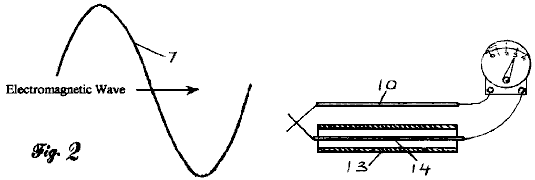     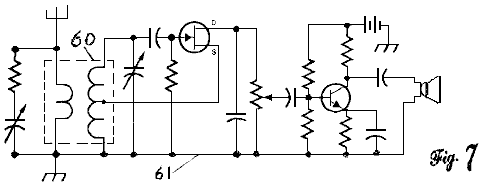 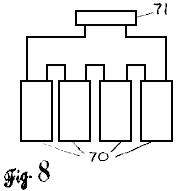 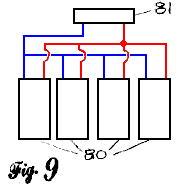 DETAILED DESCRIPTION OF THE PREFERRED EMBODIMENTS When a circuit is made to resonate at some frequency, it generates an electromagnetic wave. These waves move at the speed of light and travel great distances, and this makes possible our radios, televisions and cell phones. These waves, in passing a wire suspended in the air, set up alternating charges in the wire, varying at the frequency of the wave. If we put an inductance, that is tuned to the frequency of the wave, between the wire and the ground the circuit will resonate and charges will flow back and forth on the wire. This allows us to pick out the wave we are interested in, amplify it and read its message. We have long known that the voltage of the wave we choose to receive is greatly amplified when we make our circuit resonate at that wave's frequency, but we have been unable to accumulate this additional energy from the wave because we are limited to what energy we can pick up by the equipment that we use.  Fig.1 shows why this is so. The passing electromagnetic wave 6 generates an alternating electric charge in the wire 10, tuned to the wave frequency to close the circuit so that the induced charge can circulate, we have added a second wire 11, but if we connect the ends of the wires together, the electromagnetic wave 6 induces a charge in the second wire exactly like the one in the first wire, and no current will flow. Any effort to circulate the charge induced in wire 10 is blocked by an equal opposing charge in 11.  In Fig.2 we have replaced the wire 11 with a metallic, pipe like sheath 13 having an insulated wire 14 inside when an electromagnetic wave 7 passes, the wave is stopped at the sheath 14 and does not induce any charges in the inner wire 14. This allows the inside wire 14 to conduct the charge induced in the wire 12.  In Fig 3 we see two sheaths 20 and 21, parallel and insulated from each other. Two separate coils 22 and 23 are wound inside the sheaths. The coil 22 is the transmitter coil and it is tuned to resonate at the frequency of the oscillator circuit 24, and this generates an electromagnetic wave that induces a current in the collector coil 23, which is adapted and used in the tuned collector circuit 25.  Fig4 is a view of a full-length electromagnetic electric generator using two separate sheaths 30 and 31, where the electromagnetic wave is almost completely contained within the sheaths. The sheaths are parallel and insulated from each other by insulators 34 and 35. The transmitter coil 32 and the collector coil 33 are shown in the cut-away, and are wound completely inside the sheaths. Additional coils may be added as needed. The transmitter coil 32 is tuned to resonate at the frequency of the oscillator circuit, which connects in at 36. And this generates an electromagnetic wave that is contained within the sheaths and induces a current in the collector coil 33, which is tuned to resonate at the wave frequency and is coupled to the collector circuit at the terminal 37. The insulating separators 34 and 35 are necessary to prevent induced current from flowing in the sheaths 30 and 31.  A number of sheaths may be combined, as is shown in Fig5. In this case four sheaths 40, 41, 42 and 43 are combined, so that the coils wound inside the sheaths are in series, and the sheaths are electrically separated by the insulators 44, 45, 46 and 47. The tuned circuit for the transmitter coil is hooked up at connectors 48, and the collector circuit connects to the collector coil at 49.  A simple circuit for operating the full-length electromagnetic transformer is shown in Fig.6. The two sheaths 50 and 51 are shown with the transmitter coil 52 and collector coil 53. The transmitter coil is connected to the tuned circuit 55, which is driven by the oscillator 54. The oscillator 54 is tuned to oscillate at some frequency and the transformer circuit 55 and collector circuit 56 are tuned to resonate with it. At resonance the transmitter coil 52 emits an electromagnetic wave which induces a current in the collector coil 53. Shown here is a half-wave rectifier 57 and capacitor 58 connected to the load 59. The rectifier is necessary on each collector unit, because we can add the direct currents of the separate units, but the alternating currents of the units might be out of phase and without the rectifier they would cancel out.  Fig.7 shows the transmitter coil connected between an aerial and the ground, where the aerial circuit and collector circuit are tuned to resonate at a desired frequency to greatly boost the sensitivity and to amplify the signal. This type application will work equally well with transmitters. Also, using the half-length transformer as an aerial and the full-length transformer as the radio frequency transformer works the same with both receivers and transmitters. The oscillator circuit can use a high frequency magnetic inductance and the full-length transformer unit to resonate with a half-length transformer which acts as an aerial. A unit such as this would greatly add to the power of a radar system.   The full-length units, when combined with rectifiers, may be connected in series as in Fig.8, or in parallel as in Fig.9. While the invention has been disclosed in it’s preferred forms, it will be apparent to those skilled in the art that many modifications, additions, and deletions can be made therein without departing from the spirit and scope of the invention and its equivalents as set forth in the following claims. Claims: 1. An electric generator that uses an oscillating circuit to resonate with inductances enclosed in a full-length electromagnetic transformer unit, comprising: two or more parallel, metallic, pipe-like sheaths, insulated from each other; an electromagnetic transmitter coil, which is wound inside the sheaths, using an insulated wire, threaded up through the inside opening of one of the sheaths and down on the inside of a second sheath, one or more times, to form a continuous coil; a means of tuning the transmitter coil to the frequency of the oscillating circuit, so that the transmitter coil resonates and generates an electromagnetic wave that is contained within the sheaths; a collector coil composed of an insulated wire, threaded up through the inside opening of one of the sheaths and down on the inside of a second sheath, one or more times, to form a continuous coil, wherein the electromagnetic wave of the transmitter coil induces an electric charge in the collector coil; and a means of tuning the collector coil to resonate at the frequency of the oscillating circuit; so that the electromagnetic wave induces a current in the collector coil, and since the coil is contained within the sheaths, the current is free to flow, and the high frequency alternating current, so generated, can be used elsewhere in an electronic circuit, or altered and used as a power source. 2. The full-length electromagnetic transformer unit of claim 1, where the collected current is rectified, and the DC current is stored in capacitors and used to do work. 3. The full-length electromagnetic transformer unit of claim 1, where the transmitter coil acts as a tuned inductance, in a receiver, between the aerial and the ground, and a tuned collector coil resonates to increase the sensitivity and the amplitude of the signal. 4. The full-length electromagnetic transformer unit of claim 3, where the tuned transmitter coil resonates with an oscillator and an aerial to act as a transmitter for radios, televisions, cell phones, radars and computers. 5. The full-length electromagnetic transformer unit of claim 1, where the lengths of the sheaths are some multiple of the wave length of a particular electromagnetic frequency. 6. The full-length electromagnetic transformer unit of claim 5, where a number of the units are connected in parallel to increase the current. 7. The full-length electromagnetic transformer unit of claim 5, where a number of the units are connected in series to increase the voltage. 8. The full-length electromagnetic transformer unit of claim 5, where the parts are reduced to a size small enough to fit in, and supply power to, a cell phone, a lap-top computer, or other electrical appliance. 9. The full-length electromagnetic transformer unit of claim 1 further comprising three or more, metallic, parallel, side by side, pipe like sheaths, where the sheaths are not electrically connected, and have two or more coils wound inside the sheaths. Up to the present time (June 2013), I have not heard of anyone attempting to replicate the design shown in this patent, and so it is just being put forward here in case somebody wants to try it. It appears to be a clever technique. The power gain is maximised by tuning the transmitting and receiving coils to the frequency of the oscillator, although in practice, it is highly likely that the oscillator frequency would be adjusted to the transmitter coil as it is so easy to adjust the frequency of an oscillator. Boyd does not go into great detail about attaining resonance, and that is generally a major difficulty in any design which does not have automatic tuning. It needs to be borne in mind that the length of wire in each coil (and possibly its weight) is a key factor. Boyd talks about the coils possibly having the same number of turns, and that is fine provided that the coils are identical in size, that is, having the same shape when viewed from the top and the same depth of turns when viewed from the side, and exactly the same number of turns with each coil having exactly the same wire length. Resonance in a length of wire, whether it is laid out straight or wound into a coil, tends to confuse many people. Richard Quick’s very clear explanation of resonance in any length of wire, in his US patent 7,973,296 of 5th July 2011 is very helpful. He says: “Quarter-Wave” Resonance; Standing Electromagnetic Waves” One of the two main types is electrical resonance is referred to here as quarter-wave resonance. This type of resonance depends almost entirely on the length of a wire element For reasons described below, if a segment or length of wire is one quarter as long as the “voltage waves” which are travelling through the wire, then a set of “reflected” waves will be added to the emitted waves, in a synchronised alignment which creates stronger “superimposed waves”. Accordingly, an understanding of the “quarter-wave” phenomenon will help a reader understand how a straightforward and easily-controlled factor (i.e., the length of a wire ribbon which will be used to form a spiral coil) can help create a “quarter-wave” resonant response, which will create the types of electromagnetic pulses and fields referred to as “standing waves”. The speed at which a voltage impulse is transmitted through a metal wire is extremely fast. It is essentially the same as the speed of light, which travels 300 million meters (186,000 miles) in a single second (that distance would circle the earth more than 7 times). If wavelength (in meters) is multiplied by frequency (cycles per second), the result will be the speed of light, 300 million meters/second. Therefore, the wavelength of an “alternating current” (AC) voltage, at some particular frequency, will be the speed of light, divided by which frequency. Therefore, using simple division, if an alternating voltage operates at a frequency of 1 megahertz (MHz), which is a million cycles per second, then the “wavelength” at that frequency will be 300 meters. If the frequency halves become 500 kilohertz, the wavelength becomes twice as long (600 meters); and, if the frequency were to increase to 2 megahertz, the wavelength drops to 150 meters. It should be noted which the term “cycles” is what scientists call “a dimensionless unit”, which drops out and becomes silent when other physical terms are multiplied or divided. At AC frequencies of 10 kilohertz or greater, the common references to “alternating current” (AC) voltage begin using a different term, which is “radio-frequency” (RF) voltage. Accordingly, RF voltage is a form (or subset) of AC voltage, which operates at frequencies higher than 10 kilohertz. RF power generators are readily available, and are sold by numerous companies which can be easily located by an Internet search, using the term “RF power generator”. For example, Hotek Technologies Inc. (hotektech.com) sells two RF power generators, called the AG 1024 and AG 1012 models, which can provide output power at frequencies ranging from 20 kHz to 1 MHz; the 1012 model has a power output of 1000 watts, while the 1024 model has a power output of 2000 watts. The output frequency of any such RF power supply can be adjusted and “tuned” across the entire range of operating frequencies, merely by turning knobs or manipulating other controls in a power supply of this type. In a wire having a fixed and unchanging length, the easiest way to create a “standing wave” is to adjust the RF frequency emitted by a power supply with an adjustable frequency, until the “tuned” frequency creates a wavelength which is 4 times as long as the wire. This principle is well-known to physicists, and it is commonly referred to as “quarter-wave” behaviour, since the length of the wire segment must be one quarter as long as the wavelength. Since it is important to this invention, the principles behind it are illustrated in a series of drawings provided in Fig.1 to Fig.4, all of which are well-known prior art. 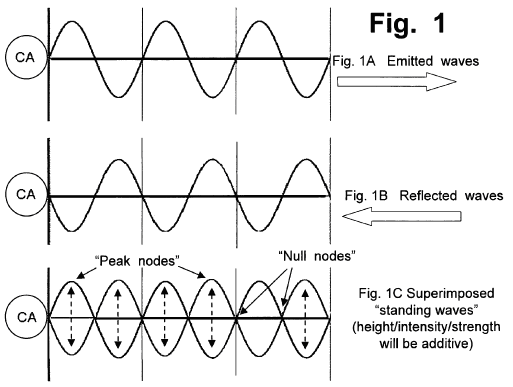 Fig.1A indicates an idealized wavelength of an alternating voltage, depicted by a sine wave which is being sent from an AC power supply (shown by a circle at the left end of a horizontal straight wire) into the “input” end of the wire. The voltage waves travel through the wire towards the right, as indicated by the block arrow in Fig.1A. When the waves reach the end of the wire, they cannot leave the wire (at least, not in a simplified and “ideal” system, which is being assumed and used here to explain the principle of how a simple straight wire can create a standing wave). Therefore, the voltage wave will effectively “bounce” or “reflect” back from the tip of the wire, and the “reflected wave” will begin travelling back through the wire, going in the opposite direction, as indicated by the left-pointing block arrow in Fig.1B. Because of the laws of conservation of energy, the reflection and “return travel” of these types of waves, when they bounce off the tip of a wire, is actually quite good, and rather efficient, as discussed below, provided which the wire tip does not emit sparks, arc discharges, or other forms of “escaping” electrical energy. Accordingly, Fig.1A depicts a set of “emitted waves” travelling towards the right, while Fig.1B depicts an idealised set of “reflected waves” travelling toward the left along the same wire. Fig.1C illustrates what happens when both sets of waves (emitted and reflected) are superimposed on each other. Since the two sets of waves are travelling at exactly the same speed, and since they have exactly the same wavelength, they will create a “standing wave” pattern when they are added together. As can be visualised from Fig.1C, there will be a set of locations, along the length of the wire, which can be referred to as “peak nodes”, where the AC voltage reaches it’s maximum. At a location halfway between a pair of adjacent “peak nodes”, there will be a spot which can be called a “null node”, a “zero node”, a trough or valley node, or similar terms. At each “null node” location, the AC voltage will appear to be not fluctuating at all. Those are the sites, along the length of the wire, where each “positive” hump (created by a sine wave travelling toward the right) will be counter-balanced and offset by a “negative hump” with exactly the same height, travelling at an identical speed toward the left. As a result, this type of response within a wire creates a “standing wave”. If the instantaneous voltage is measured at a “null node”, it would appear that nothing is happening, in terms of fluctuating voltage. Furthermore, the “null node” will not be moving, along the length of the wire; instead, it will appear to be standing still. This can be demonstrated, in a coil, by using a “grounded lead” to test for voltages along the length of a coil. If a “grounded lead” coupled to a volt meter is used to touch the surfaces of a series of strands in a non-insulated coil (such as a coil made of thin copper tubing, wrapped around a plastic cylindrical shape, as used in the types of large transformers used by hobbyists to create “Tesla coils” which will emit large and visually impressive electrical arcs), the “test lead” will detect no apparent voltage at a null node, which will occur at some particular strand in the coil. At a different strand of the coil, the “test lead” will detect an alternating voltage which has twice the strength and intensity of the voltage being emitted by the power supply. If voltage is measured at a “peak node”, the voltage will be doing something which can be called, using vernacular or laymen's terms, “the full-tilt boogie”. The AC voltage levels will be moving back and forth, between: (i) a very high and intense positive voltage, to (ii) an equally intense negative voltage. This is indicated by the “bubble” shapes shown along the wire in Fig.1C. The “bubbles” which are shown in Fig.1C can help someone understand how standing waves are created, and how they act in a synchronised manner. However, which drawing fails to show another result which is very important in what actually happens in a standing wave. For purposes of description and analysis at this introductory level, the system can be assumed to be “ideal”, which implies a perfect “mirror-image” reflection of each wave from the right end of the wire. An “ideal” system also implies that no reflections occur at the left hand end of the wire where the power supply is located, and all “reflected” wave activity simply ceases. In real circuits and wires of this type, second and third order reflections do in fact occur, and they are used to further increase the strength and power output of these types of systems; however, those additional factors and “harmonics” should be ignored until after the basic principles of this type of system have been grasped and understood. In an ideal system, when the reflected waves (which are travelling toward the left, in the wire segments illustrated in Fig.1) are “superimposed” on the emitted waves (travelling toward the right), the “peak” positive voltage which will be instantaneously reached, at the highest point of each “bubble” shown in Fig.1C, will occur when the positive peak of an emitted wave crosses a mirror-image positive peak of a reflected wave, travelling in the opposite direction. Accordingly, when those two “positive peak” values are added to each other, the instantaneous positive peak voltage which will occur, in the wire, will actually be twice as intense as the “positive peak” voltage being emitted by the AC power supply. An instant later, at that exact point on that segment of wire, a negative peak voltage will be created, which will be the sum of (i) the negative peak voltage emitted by the power supply, and (ii) the negative peak voltage of a reflected wave also will pass through, travelling toward the left. At which instant, when those two negative peak voltages are added to each other, the instantaneous negative voltage which will occur, in the wire, will be twice as intense as the “negative peak” voltage being generated by the AC power supply. A more accurate and representative visual depiction of a “standing wave” in a wire would actually show the heights of the peaks as being twice as tall as the peaks of the emitted voltage waves, and the reflected voltage waves. However, which depiction might confuse people, so it usually is not shown in drawings of “standing waves”. Accordingly, the instantaneous response in the wire, at a location halfway between two “null nodes”, is doing something which can fairly and properly be called “the full-tilt double double boogie”. The “double double” phrase (note which it contains not just one but two “doubles”) was added to that phrase, for two reasons: (i) To emphasise the fact that each and every voltage peak (maximum positive, and maximum negative) will be twice as strong, and twice as intense, as the maximum positive and negative peak voltages emitted by the power supply; and, (ii) to point out that the frequency of the superimposed “bubbles”, shown in Fig.1C, is actually twice as fast as the frequency of the AC cycle which is emitted by the power supply, as discussed below. The “twice the intensity” result is directly comparable to what an observer will see, if a large mirror is placed behind a light bulb in an otherwise dark room. The mirror effectively keeps the room dark, everywhere behind the mirror, so there is no “magical doubling” of the light in the room; which would violate the basic law of conservation of energy. Instead, what the mirror does is to shift light away from the backside of the mirror, and keep that light energy on the reflective side of the mirror. Anyone standing in front of the mirror will see two apparent light bulbs. Both of those light bulbs (the original bulb, and the reflected image) will have the same brightness (if the mirror is perfect). Therefore, the mirror will double the intensity of the light energy reaching the observer. That same effect, in a circuit, will happen if the end of a wire acts like a mirror. If a wire does not have any components which will cause it to become an active “emission source” (which is the behaviour of transmission antennas and certain other components), in a way which efficiently releases voltage-created energy into the atmosphere, then the basic rules which require conservation of energy will prevent that energy from simply disappearing and ceasing to exist. As a result, even if the end of a wire is not designed to be a perfect reflector, a large portion of the voltage wave will indeed reflect off the wire tip, and travel back through the same wire, in a “second pass”. To understand adequately, the type and amount of “wave reflection” which occurs at a wire tip, consider what happens if a light bulb is shining in a room which has shiny, glossy white paint on all the walls and ceilings; then, consider how it would look if the same light bulb were located in a room with all of the walls and ceilings painted “matt black”. The total amount of light which would be available, to carry out a task such as reading a newspaper, clearly would be much greater in the white room, because light reflects off white paint, even though white paint does not even begin to approach the type of “reflection quality or clarity” which a mirror creates. The difference in what happens, when light intensity in a room painted matt black is compared to a room painted a glossy white, does not arise from the presence or absence of “reflection quality or clarity”; instead, it is governed by the laws of conservation of energy. When light shines on to a surface which is painted matt black, the light energy is absorbed by the paint, and it literally warms the paint up. In contrast to that, glossy white paint will not absorb light energy, so it reflects the light back out, for a “second pass” through the air which fills a room. Because of the laws of conservation of energy, and without depending on any “quality of reflectance” characteristic of wire tips, electrical energy cannot simply disappear, when it reaches the end of a wire. Instead, there are only two things which can happen to that energy: (i) the electrical energy can be emitted into the surroundings, such as by emitting sparks, arcs, or radio-frequency signals which will carry energy; or (ii) if the energy is not emitted by the tip of the wire, then, by simple necessity and because of the basic law of conservation of energy, it must be reflected back into the wire, and it will be forced to travel back through the wire again. If a wire has a long and tapered tip, then the reflected wave might become somewhat diffused, and it might lose some portion of the “clarity” of the wave. However, since wavelengths in the frequencies of interest here are hundreds of meters long, the type of tip created by a conventional wire cutter will not create any significant diffusion, in a reflected wave. And, unlike the white-painted walls of a room, there is not a large area which is available, at the tip of a wire, which can create scatter, spread, or diffusion. As a result, the tip of a wire will be a relatively efficient mirror-type reflector, when an AC voltage is “pumped” into one end of the wire. The second factor mentioned above, when the “double-double” boogie phrase was mentioned, relates to a doubling of the frequency of a standing wave. When a standing wave is created in a wire by reflection of an emitted AC voltage wave, the frequency of the standing wave is, quite literally, double the frequency of the emitted wave. This can be seen, visually, by noting that in the emitted AC voltage, shown in Fig.1A, a single complete wavelength contains both a “positive hump” and a “negative hump”. Accordingly, three complete sine waves, divided into three segments by the imaginary vertical lines, are shown in Fig.1A. By contrast, each and every “bubble” shown in Fig.1C depicts a complete and total “wavelength”, in a standing wave. Six of those standing wave “bubbles” fit into exactly the same length of wire which holds only 3 emitted wavelengths from the power supply. The “frequency doubling” effect of standing waves is important, because AC systems can convey and release energy in a manner which increases, as the frequency of the AC voltage supply increases. To some extent, this is analogous to saying that, if a motor can be run at twice the speed (while still generating the same torque), then the work output of that motor can be twice as great, at the higher speed. That analogy is not entirely accurate, since work output from an electric device which uses AC power depends on “area of the curve” functions which occur when sine waves are involved. Nevertheless, as a general principle, if the frequency of the voltage peaks increases, then power output will also increase, in many types of electric circuit components. In the three panels of Fig.1, the wire length is three times as long as the wavelength of the voltage from the power supply. However, to create standing waves, a wire length does not need to be any particular multiple of the wavelength of an AC voltage. As can be seen by considering Fig.1C, the same types of “bubbles” would be created: (i) if the wire length were exactly twice as long as the wavelength; or, (ii) if the wire length were the same length as the wavelength. 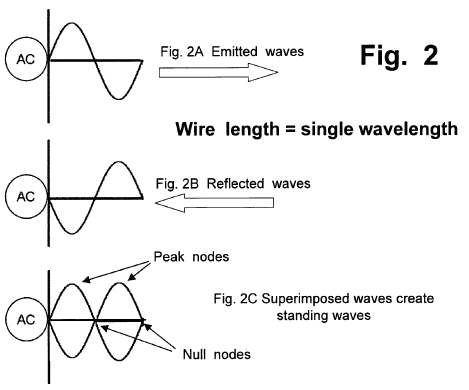 Accordingly, Fig.2 (which includes Fig.2A showing an emitted wave, Fig.2B showing a reflected wave, and Fig.2C showing the superimposed “bubbles”) shows what happens in a wire segment which has a length which is equal to a single wavelength from an AC voltage at a fixed frequency. A resonant standing wave will be formed, with a frequency which is double the frequency of the input AC voltage. which same result will apply, in a wire having any length which is an exact (integer) multiple (such as 1x, 2x, 3x, etc.) of the wavelength of the AC voltage being pushed (or forced, driven, pumped, etc.) into the wire segment. 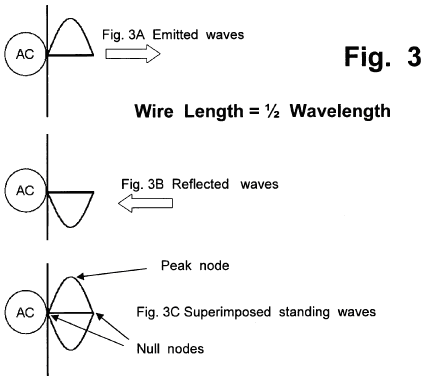 Moving to still shorter wires, the same principle also applies to any wire with a length equal to one half of an AC voltage wavelength. As shown in Fig.3 (which includes Fig. 3A showing an emitted wave, Fig. 3B showing a reflected wave, and Fig. 3C showing the superimposed “bubbles”), if the wire length is one half of the wavelength, a natural and resonant standing wave will still form, with a frequency which is double the frequency of the input AC voltage. 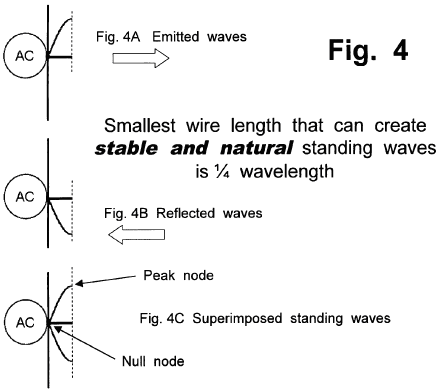 Finally, moving to a still shorter wire, the same principle also applies to any wire which has a length equal to one quarter of an AC voltage wavelength, as shown in Fig.4A, Fig.4B, and Fig.4C Even though it does not stretch across or cover a complete “bubble”, the standing wave shown in Fig.4C is nevertheless a stable, natural, and resonant “standing wave”, with a frequency which is exactly twice the frequency of the input AC voltage. It is possible to create partially stable and semi-resonant responses, using one eighth, one sixteenth, or shorter lengths of wire, by using additional devices which can remove electrical power from the system, or which can generate effects which are usually called “harmonics”. However, those are not the types of natural and stable responses which can be created by a simple, basic system consisting of nothing more than: (i) a wire having a fixed length and a “reflective” tip; and (ii) an AC power source with a frequency which can be “tuned” until it creates a resonant response in any wire segment having a suitable length. Therefore, since quarter-wave wire lengths are the shortest lengths which can create natural and stable standing waves, the conventional term which is commonly used, to describe what happens when a wire creates a resonant standing-wave response, is a “quarter-wave” response. In some devices, telescoping components (or other elements which can alter the effective length of a wire-type element) can be used to alter the ability of the element to respond to a fixed wavelength. Many types of antennas use this approach, if they need to process signals which are being transmitted on fixed and known frequencies. However, those examples are not relevant to spiral coil reactors, which will use an approach which involves tuning and adjusting the frequency of the voltage which is being supplied to a reactor, until a resonant response is observed in coils with fixed and unchanging lengths. It should also be noted that certain types of “tuning” elements (such as capacitors, which can have either fixed or adjustable capacitance levels) can also be coupled electrically to a wire, in a manner which “emulates” adding more length to that wire. This approach can be used to alter (or increase the range of) the frequencies to which a wire circuit will respond resonantly. The ‘Gegene’ Magnetic Arrangement. As we have seen from what Don Smith has said, a very effective method of gaining additional power is to make a high frequency magnetic transmitter as that allows several outputs to be taken from the transmitter without increasing the input power in any way. Recently, a clever idea for a simplified version of this has been shared on the web. As far as I am aware, this device was first presented by the Lithuanian ‘FreeEnergyLT’ whose website is at freeenergylt.narod2.ru.  and the information then replicated and documented by J L Naudin on his website jnaudin.free.fr and named ‘Gegene’ being short for ‘Great Efficiency Generator’. The clever idea is to use a commercial induction hot-plate as the transmitter. These have recently become available at low cost, this one: 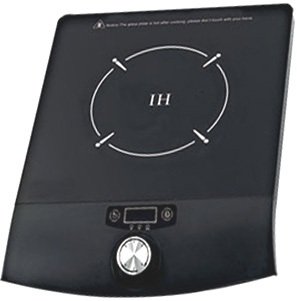 Sold in the UK by Maplin, has power levels adjustable from 300 watts to 2000 watts, and costs only £30 delivered to your address. These devices operate by generating a powerful high frequency oscillating magnetic field which induces eddy currents in any magnetic material placed on the surface of the cooker. That is, cookware which is made of cast iron or steel (not stainless steel which is supposedly non-magnetic). The heating is very rapid and completely uniform across the item of cookware which is very helpful when cooking. The hot plate is controlled by sophisticated electronics which will not switch on unless there is an iron object on the plate and which varies the frequency and current in a way chosen by the designer. The circuitry produces the magnetic field by pulsing current through a large, flat coil in the centre of the case as can be seen in this photograph of a typical induction plate with the case opened: 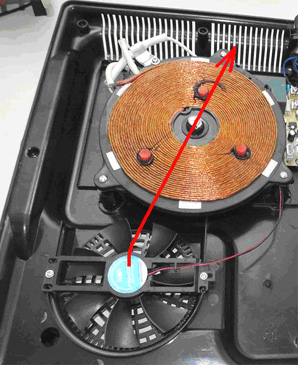 The brown coil gets hot, and so there are spacers on it to prevent the cool outer casing form picking up the heat of the coil. There is also a fan which draws air in from underneath the case and blows it across the coil in order to keep the heat down. In order to use this magnetic transmitter, we need to place a suitable output coil on the plate, and power a load from the energy collected by that coil. This is a fairly recent idea and so there is still a good deal of experimentation going on, testing different coils, and various loads. It is generally agreed that the best load is a non-inductive load with halogen lamps and ordinary filament light bulbs being recommended. Halogen lamps are used in some low-cost commercial heaters, and they are very effective method of radiant heating. In his video at http://www.youtube.com/watch?v=LbAhUwHvJCE, Laurent powers seven separate 400-watt halogen lamps using a small 800-watt maximum plate which has a small 120 mm diameter transmitter coil:  No particular power output is claimed by Laurent, but as you can see, the 2800 watts of halogen lamps are brightly lit while a wattmeter on the input to the plate reads just 758 watts. It seems to be fairly clear that there is a significant power gain with this arrangement. Then, Laurent places an additional coil on top of the first one and shows it lighting a 100-watt filament light bulb very brightly:  It is actually quite difficult to see the brightness of lamps shown in a video as the video camera automatically turns down the brightness of the recording. The important point here is that there is significant power output from a second coil, without there being any increase in the power input to the transmitter coil in the induction plate. There are many different designs of electronics in commercial induction plates. Most will not start operating until a magnetic object is placed on top of the plate. If that is done, then the object needs to be removed very promptly as it heats up very rapidly. Fortunately, most plate designs keep operating as soon as the induction process is started and so there in no problem with removing the metal cookware (or whatever is used to start the process). Laurent’s very small induction plate does not have that protection circuitry and so starts up as soon as it is switched on. Jean-Louis Naudin uses a 2000-watt induction plate turned down to its 1000-watt setting. It has a 180 mm diameter pick-up coil. He says that for him, it is essential to have at least 1500-watts of load or else the induction plate will shut down with an error code indicating that no cookware is present. The coils used are Tesla bi-filar pancake types, typically, attached to a thin sheet of MDF or plywood, say 2 mm thick, with superglue. Laurent’s 120 mm coil has ten turns and Jean-Louis’ 160 mm coil has sixteen turns, needing about 5 metres of twin-core wire, and Laurent’s about 2.5 metres of wire. I suggest that the wire should be rated for mains voltage and have, perhaps 1 sq. mm cross-sectional area of copper wire in each conductor. A Tesla pancake coil is wound like this:  Please remember that this arrangement involves high voltages and so is not suitable for newcomers to electronics. This presentation is strictly for information purposes only and it is not a recommendation that you attempt to implement anything shown here, and if you choose to do so, then the responsibility is yours and yours alone. An interesting video is here. Making a Solid-state Tesla Coil As some readers may feel that there is some "black magic" about the neon-driver circuit used by Don to drive the Tesla Coil section of his circuitry and that if a suitable unit could not be purchased then the circuit could not be reproduced or tested, it seems reasonable to show how it operates and how it can be constructed from scratch: The circuit itself is made up of an oscillator to convert the 12-volt DC supply into a pulsating current which is then stepped up to a high voltage by a transformer. Here is a circuit which has been used for this: 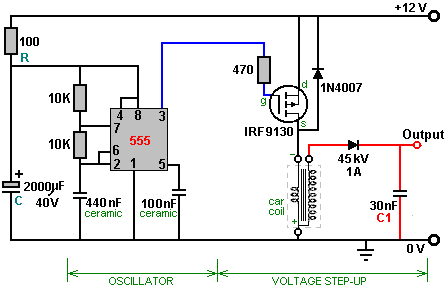 The supply for the 555 timer chip is protected against spikes and dips by the resistor "R" and the capacitor "C". The 555 timer chip acts as an oscillator or "clock" whose speed is governed by the two 10K resistors feeding the 440 nF capacitor. The step-up transformer is an ordinary (Model T Ford) car coil and the drive power to it is boosted by the IRF9130 FET transistor which is driven by the 555 chip output coming from it's pin 3. The output from the car coil is rectified by the diode, which needs to have a very high voltage rating as the voltage at this point is now very high. The rectified voltage pulses are stored in a very high-voltage capacitor before being used to drive a Tesla Coil. As a powerful output is wanted, two car coils are used and their outputs combined as shown here: 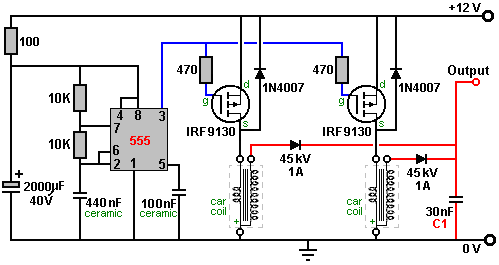 You will notice that the car coil has only three terminals and the terminal marked "+" is the one with the connection common to both of the coils inside the housing. The coil may look like this: 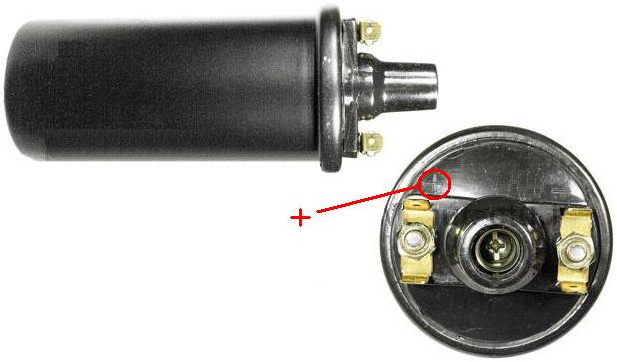 and the "+" is generally marked on the top beside the terminal with the two internal connections running to it. The circuit described so far is very close to that provided by a neon-tube driver circuit and it is certainly capable of driving a Tesla Coil. There are several different way of constructing a Tesla Coil. It is not unusual to have several spark gaps connected in a chain. This arrangement is called a "series spark gap" because the spark gaps are connected "in series" which is just a technical way of saying "connected in a row". In the chapter on aerial systems, you will see that Hermann Plauston uses that style of spark gap with the very high voltages which he gets from his powerful aerial systems. One of the possible Tesla Coil designs uses a pancake coil as the "L1" coil as shown here: 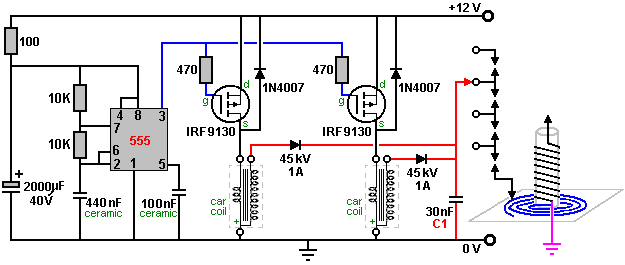 The connection to the pancake coil is by a moveable clamp and the two coils are tuned to resonance by careful and gradual adjustment of that connection, 10 mm at a time (after powering down and discharging the “C1” capacitor). It has been found recently, that connecting two of these (non-ballast resistor) car coils back to back with the plus and minus connections switched over, that the performance is very much improved. It has been suggested that the small self-capacitance of each coil when connected across the other coil, causes a very much higher frequency of operation, giving much sharper voltage spikes which is a very desirable situation in a circuit of this type. This arrangement might be connected like this: 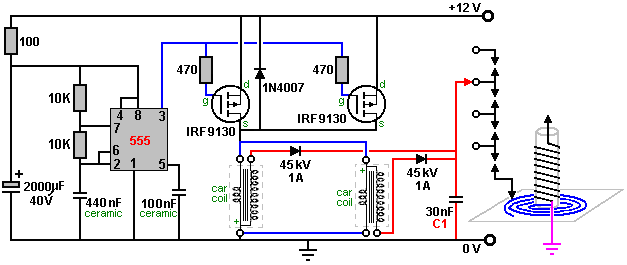 The series spark gap can be constructed in various ways, including using car spark plugs, gas-discharge tubes or neon lamps. The one shown here uses nuts and bolts projecting through two strips of a stiff, non-conducting material, as that is much easier to adjust than the gaps of several spark plugs: 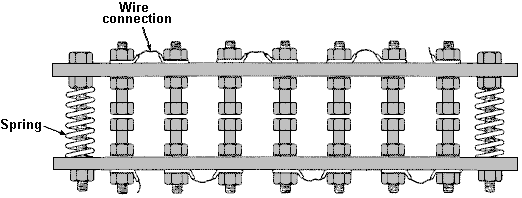 Tightening the bolts which compress the springs moves the bolt heads closer together and reduces the spark gaps. The electrical connections can be made to the end tags or to any of the intermediate wire connection straps if fewer spark gaps are required in the chain. Let me remind you again that this is not a toy and very high voltages will be produced. Also, let me stress again that if you decide to construct anything, then you do so entire on your own responsibility. This document is only provided for information purposes and must not be seen as an encouragement to build any such device nor is any guarantee given that any of the devices described in this eBook will work as described should you decide to attempt to construct a replication prototype of your own. Generally, it takes skill and patience to achieve success with any free-energy device and Don Smith's devices are some of the most difficult, especially since he admits quite freely that he does not disclose all of the details. The output capacitor marked "C1" in the circuit diagram above has to be able to handle very high voltages. There are various ways of dealing with this. Don dealt with it by getting very expensive capacitors manufactured by a specialist company. Some home-based constructors have had success using glass beer bottles filled with a salt solution. The outside of the bottles are wrapped in aluminium foil to form one of the contacts of the capacitor and bare wires are looped from deep inside each bottle on to the next one, looping from the inside of one bottle to the inside of the next one, and eventually forming the other contact of the capacitor. While that appears to work well, it is not a very convenient thing to carry around. One method which has been popular in the past is to use two complete rolls of aluminium foil, sometimes called "baking foil", laying them one flat, covering it with one or more layers of plastic cling film and laying the second roll of foil on top of the plastic. The three layers are then rolled up to form the capacitor. Obviously, several of these can be connected together in parallel in order to increase the capacitance of the set. The thicker the plastic, the lower the capacitance but the higher the voltage which can be handled. The November 1999 issue of Popular Electronics suggests using 33 sheets of the thin aluminium used as a flashing material by house builders. At that time it was supplied in rolls which were ten inches (250 mm) wide, so their design uses 14" (355 mm) lengths of the aluminium. The plastic chosen to separate the plates was polythene sheet 0.062 inch (1.6 mm) thick which is also available from a builders merchants outlet. The plastic is cut to 11 inch (280 mm) by 13 inch (330 mm) and assembly is as follows: 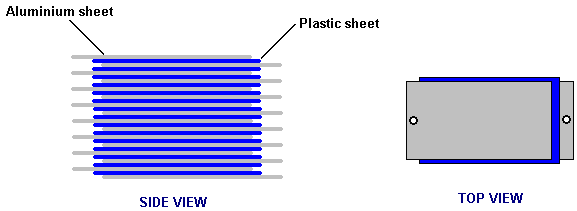 The sandwich stack of sheets is then clamped together between two rigid timber sheets. The tighter that they are clamped, the closer the plates and the higher the capacitance. The electrical connections are made by running a bolt through the projecting ends of the plates. With two thicknesses of plastic sheet and one of aluminium, there should be room for a washer between each pair of plates at each end and that would improve the clamping and the electrical connection. An alternative is to cut a corner off each plate and position them alternatively so that almost no plate area is ineffective. As Don Smith has demonstrated in one of his video presentations, Nikola Tesla was perfectly correct when he stated that directing the discharge from a Tesla Coil on to a metal plate (or in Don's case, one of the two metal plates of a two-plate capacitor where a plastic sheet separates the plates just as shown above), produces a very powerful current flow onwards through a good earth connection. Obviously, if an electrical load is positioned between the plates and the earth connection, then the load can be powered to a high level of current, giving a very considerable power gain. Coil Construction: The Barker & Williamson coils used by Don in his constructions are expensive to purchase. Some years ago, in an article in the “QST” amateur radio publication, Robert H. Johns shows how similar (if not superior) coils can be constructed without any great difficulty. 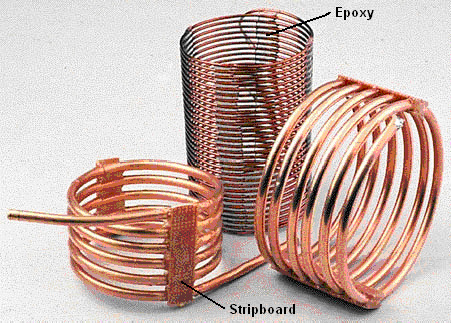 These home-made coils have excellent “Q” Quality factors, some even better than the tinned copper wire coils of Barker & Williamson because the majority of electrical flow is at the surface of the wire and copper is a better conductor of electricity than the silver tinning material. The inductance of a coil increases if the turns are close together. The capacitance of a coil decreases if the turns are spread out. A good compromise is to space the turns so that there is a gap between the turns of one wire thickness. A common construction method with Tesla Coil builders is to use nylon fishing line or plastic strimmer cord between the turns to create the gap. The method used by Mr Johns allows for even spacing without using any additional material. The key feature is to use a collapsible former and wind the coil on the former, space the turns out evenly and then clamp them in position with strips of epoxy resin, removing the former when the resin has set and cured. Mr Johns has difficulty with his epoxy being difficult to keep in place, but when mixed with the West System micro fibres, epoxy can be made any consistency and it can be applied as a stiff paste without any loss of it’s properties. The epoxy is kept from sticking to the former by placing a strip of electrical tape on each side of the former. 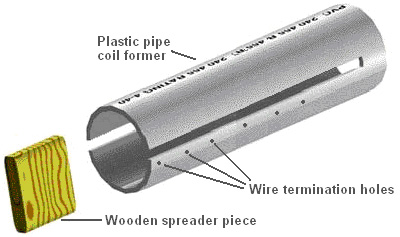 I suggest that the plastic pipe used as the coil former is twice the length of the coil to be wound as that allows a good degree of flexing in the former when the coil is being removed. Before the two slots are cut in the plastic pipe, a wooden spreader piece is cut and it’s ends rounded so that it is a push-fit in the pipe. This spreader piece is used to hold the sides of the cut end exactly in position when the wire is being wrapped tightly around the pipe. Two or more small holes are drilled in the pipe beside where the slots are to be cut. These holes are used to anchor the ends of the wire by passing them through the hole and bending them. Those ends have to be cut off before the finished coil is slid off the former, but they are very useful while the epoxy is being applied and hardening. The pipe slots are cut to a generous width, typically 10 mm or more. The technique is then to wedge the wooden spreader piece in the slotted end of the pipe. Then anchor the end of the solid copper wire using the first of the drilled holes. The wire, which can be bare or insulated, is then wrapped tightly around the former for the required number of turns, and the other end of the wire secured in one of the other drilled holes. It is common practice to make the turns by rotating the former. When the winding is completed, the turns can be spaced out more evenly if necessary, and then a strip of epoxy paste applied all along one side of the coil. When that has hardened, (or immediately if the epoxy paste is stiff enough), the pipe is turned over and a second epoxy strip applied to the opposite side of the coil. A strip of paxolin board or strip-board can be made part of the epoxy strip. Alternatively, an L-shaped plastic mounting bracket or a plastic mounting bolt can be embedded in the epoxy ready for the coil installation later on. When the epoxy has hardened, typically 24 hours later, the coil ends are snipped off, the spreader piece is tapped out with a dowel and the sides of the pipe pressed inwards to make it easy to slide the finished coil off the former. Larger diameter coils can be wound with small-diameter copper pipe. The coil inductance can be calculated from: Inductance in microhenrys L = d2n2 / (18d + 40l) Where: d is the coil diameter in inches measured from wire centre to wire centre n is the number of turns in the coil l is coil length in inches (1 inch = 25.4 mm) Using this equation for working out the number of turns for a given inductance in microhenrys:  Tariel Kapanadze Tariel appears to have based his work on that of Nikola Tesla. There has been a video on the web, of one of his devices in operation, but it appears that the video has been removed. However, part of it can be seen here. The video commentary was not in English and so the information gathered from it is not as complete as it might be. However, in spite of that, a number of useful things can be learned from it.  The video shows a demonstration being staged in a back garden, I believe, in Turkey. Strong sunshine was casting dense shadows which made video detail less than perfect. Essentially, Tariel demonstrated one of his builds of a Tesla-style free-energy device, powering both itself and a row of five light bulbs. One of the most encouraging things about this video is that the construction and operation was of the most basic kind, with not the slightest suggestion of expensive laboratory work or anything high-precision. This is most definitely a backyard construction within the scope of any knowledgeable person. Electrical connections were made by twisting bare wires together:  and where necessary, tightening the twist with a pair of pliars:  This shows clearly that a high-power and very useful free-energy device can be made with the most simple of construction methods - no expensive connectors here, just a zero-cost twisted connection. 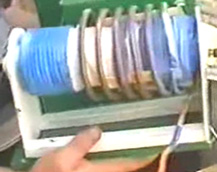 The device being displayed is a Tesla Coil powered, earth-connected system of the type already described. You will notice that the thick primary winding is not placed at one end of the central secondary winding but is much closer to the centre of the coil. Remember that Don Smith states that if the primary coil is placed centrally, then the amount of current which the coil can deliver is very large, in spite of the fact that most people think that a Tesla Coil can only produce trivial currents. Notice also that this Tesla Coil appears to be mounted on a cheap kitchen-roll holder. I have seen it said that Tariel makes a new device for each demonstration and takes it apart afterwards, so if that is correct, then it is likely that there is no great effort or expense involved in making one of these systems. 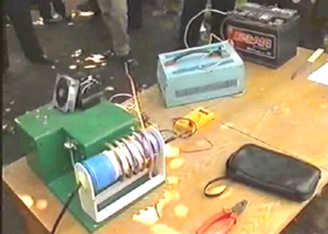 The main operational components are shown here, placed on one small table. There is a lead-acid battery (which is removed later in the demonstration), what appears to be an inverter to produce mains AC voltage from the battery, a high-voltage step-up system housed in a green box for safety reasons, a Tesla Coil, a spark gap mounted on the box and a fan-cooled component, probably a solid-state oscillator system driving the Tesla Coil. Not seen in this picture, is an item contained in a small box which might well be a high-voltage capacitor. Two earth connections are organised. The first one is an old car radiator buried in the ground:  and the second is a bare wire wrapped around a garden tap's metal pipe and twisted tight as shown above. It is distinctly possible that the circuit is based on this circuit of Tesla's:  Perhaps, the battery powers the inverter which produces mains voltage, which is then stepped up to a high voltage level by the enclosed electronics. This then drives the Tesla Coil, producing both very high voltage and current with the capacitor storing the energy as a reservoir. The spark gap then pulses this energy, driving the primary winding of the isolation transformer which produces a lower voltage at substantial current (depending on the current-handling capacity of the transformer itself) powering the load, which in this case, is a row of light bulbs. The load is a row of five light bulbs hung from a broom placed across the backs of two chairs: 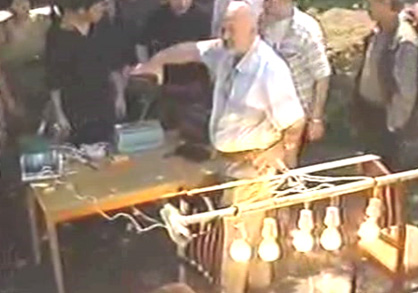 As you can see, this is not exactly high-tech, high-cost construction here, with all of the materials being used for other things afterwards. Initially, the battery is used to power the inverter and it is demonstrated that the current being drawn from the inverter is substantially less than the power entering the load. In conventional terms, this appears impossible, which is an indication that the conventional terms are out of date and need to be updated to include the observed facts from demonstrations such as this. As the system is putting out a good deal more power than is required to drive it, might it not be possible to use part of the output power to provide the input power. This is often called "closing the loop" and it is demonstrated in this video as the next step. First, the circuit is altered so that the input power connection to the inverter is taken from the output. Then the circuit is powered up using the battery as before. The battery is then disconnected and removed altogether, and the people helping with the demonstration pick up all of the active items and hold them up in the air so as to show that there are no hidden wires providing the extra power from some hidden source. The items on the table are not part of the circuit: 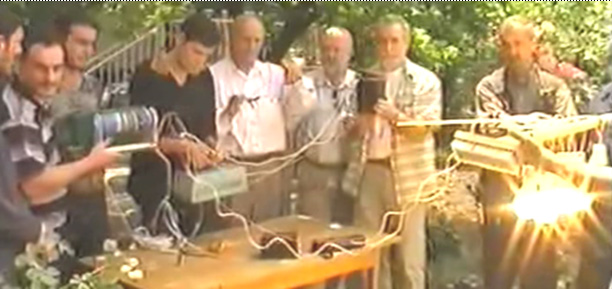 There is some additional information on Tariel including videos of some of his more powerful, newer designs at this website although it has to be said that there does not appear to be very much on him or his work available at this time. In December 2009 an anonymous contributor e-mailed to say that Kapanadze returned to the ex-USSR republic of Georgia and that the video soundtrack is in the Georgian language and after the demonstration, the interview is in Russian. He has kindly translated the parts which relate to the device, as follows: Question: What are you showing us today? Answer: This is a device which draws energy from the environment. It draws 40 watts as it starts up, but then it can power itself and provide an output of 5 kilowatts. We don't know how much energy can be drawn from the environment, but in an earlier test, we drew 200 kilowatts of power. Question: Is it possible to solve the energy problems of Georgia? Answer: We consider that they have already been solved. Question: Please tell us in simple terms, how your device works. Answer: (1) Power is drawn from the battery to get the device running (2) If we want, we can use part of the output power to drive a charger and charge the battery (3) When the device is running, we can remove the battery and it then operates self-powered. This particular unit can deliver 5 kilowatts of power which is enough for a family. We can easily make a version which supplies 10 kilowatts. We don't know what the practical power limit is for a unit like this. With this particular device we have here, we do not draw more than 5 kilowatts as we don't want to burn out the components which we used in this build. Question: Does your invention pick up current from mains wires? Answer: The mains has nothing to do with this device. The energy produced comes directly from the environment. Question: What do you call your device and do you dedicate it to anyone? Answer: I would not dream of claiming this device to be my invention, I just found something which works. This is an invention of Nikola Tesla and all the credit is his. Tesla has done so much for mankind but today he is just forgotten. This device is his invention, his work. Question: Why are you so sure that this is a design of Nikola Tesla's? Answer: Because I worked from his invention - his design. I discovered how to get automatic resonance between the primary and secondary windings. The most important thing is to achieve resonance. Melnichenko came close to solving this problem. The government of Georgia refuses to take this invention seriously. Question: You said that resonance must be maintained. Which parts resonate? Answer: Here (pointing to the green box) and here (pointing to the Tesla Coil mounted on the top of the green box). The resonator is inside the green box and at present, it is secret until patented. Question: How much would one of these units cost? Answer: When mass produced, it would cost between 300 and 400 US dollars for a unit which has an output of 5 or 6 kilowatts. Question:How much did it cost you to build this demonstration device? Answer: About eight thousand (currency not specified, but the previous question was US dollars). Parts had to be got in from twenty different places. Question: Is this your house? Answer: No, I rent this place because we have sold all that we have to make these devices. And, having done it, the government and many scientists say "We are not interested because a device like that is impossible and can't possibly exist!". I have not been allowed to make a presentation to them, but people who understand the Tesla Coil understand how this device works. Kapanadze is an architect by profession and has not had any training in either physics or Electrical Engineering. The information on which this design was based was downloaded free from the internet. One of the most important aspects of this video is the confirmation it gives for the work of Tesla and of Don Smith, in that it shows clearly, yet again, that large amounts of energy can be drawn from the local environment, without the need to burn a fuel. Another video can be seen here. People frequently ask for construction drawings or alternatively, outlets where they can buy one of his devices. Unfortunately, Tariel is not willing to share the details of his designs and so they will probably never be manufactured. Many people have tried to analyse and replicate his design. Kapanadze Analysis by William McFreey Shown below are two analysis papers on Tariel Kapanadze’s designs. These papers by William McFreey are written primarily for physiscts, and so they may not be easily understood by you if you are not familiar with scientific symbols and notation. While William McFreey’s paper is highly technical, the designs disclosed in it have been prototyped and proved to be fully functional. However, it needs to be understood that there are several ways of extracting free-energy from our local environment. For example:
The Cold Electricity Coil of ‘UFOpolitics’. A man who uses the forum ID of ‘UFOpolitics’ has been sharing his insights and experiences on various different forums, such as the one dealing directly with the production and use of cold electricity in solid-state circuits: forum His insights are unusual and very important. His basic statement is that if a coil is pulsed, using a circuit like this: 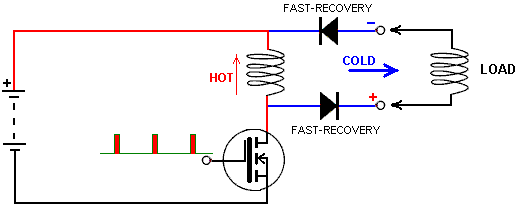 then conventional hot electricity pulses the coil when the transistor is switched ON, but if that current is switched OFF rapidly, then there is an inflow of cold electricity into the coil from the surrounding environment. That inflow of energy can be collected and diverted to power a load through the use of two high-speed diodes which can carry considerable current as the power inflow is substantial. The inflow of energy occurs when the transistor is switched OFF and so it is desirable to have the transistor switched off for most of the time, in other words, a low percentage Duty Cycle for the transistor. There MUST be a significant load on the cold electricity output. If there is not, then the cold electricity will flow back into the hot electricity section of the circuit and it may damage the transistors. Tom Bearden states that resistors boost cold electricity rather than hindering it’s flow, so the load should be a coil, a DC motor with brushes or a fluorescent light bulb. It has been observed that the incoming energy tends to flow inwards towards the centre of the coil, so an additional method of collecting this extra energy is to place a second coil inside the main coil, and wound in the same direction as it, like this: 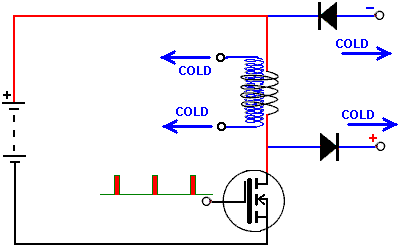 This provides two separate, independent cold electricity power outputs. Diodes are not needed for the inner ‘secondary’ coil. This inner coil is a pick-up coil and is not related in any way to the number of turns in the hot electricity pulsing coil. Instead, this coil collects inflowing cold electricity during the period when the pulsing coil is switched OFF. The hot electricity pulsing coil can be wound directly on top of the extra pick-up coil or the extra coil can be wound separately and placed inside the main coil spool. Very surprisingly, it is recommended that the powerful high-speed diode used to channel the cold electricity out of the circuit, be followed by a small 1N4148 silicon epitaxial planar high-speed diode (75V 0.45A) as this is said to clean up the cold electricity output even more. It is important that the cold electricity has to encounter the more powerful silicon diodes before reaching the 1N4148 diodes, so the order of the diodes is very important, and should be as shown here: 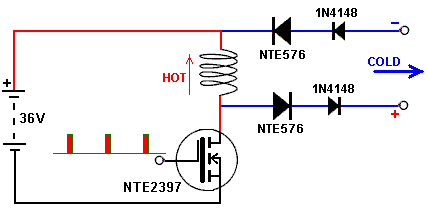 Alternative diodes for the NTE576 (6A, 35nS, 400V) are the NTE577 (5A, 70nS, 1000V) and the HFA16PB (16A, 19nS, 600V). The main requirement is high-speed operation, voltage rating of at least 400V and current rating of at least 5 amps.. There is one additional thing to be done with this circuit when a DC output is required and that is to apply filtering to the output. First, when the energy has passed through the NTE576 (or equivalent) power diodes, it encounters a high-frequency (low capacity) high quality film capacitor placed across the output in order to siphon off any high-frequency voltage ripple before it is passed through the small 1N4148 diodes and into a smoothing and storage electrolytic capacitor. Storing the cold electricity in the electrolytic capacitor converts it into conventional hot electricity. 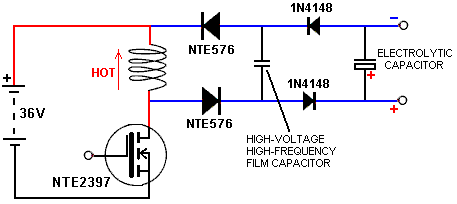 While this circuit looks like something which you just switch on and it works, that is not the case as there is an essential start-up procedure where the signal applied to the transistor is started at just a few cycles per second and 50% duty cycle and that input is then adjusted carefully and slowly while monitoring the voltages and currents produced by the circuit. This is a seriously powerful system with the capability of producing a major power output. 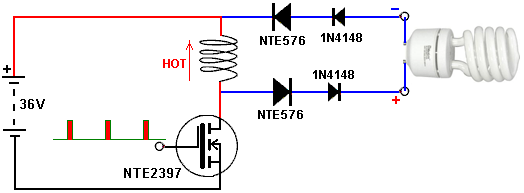 It is very important that the circuit is not powered up without a suitable load on the cold electricity output. A suitable load is a self-ballasted 230-volt fluorescent light. It must be understood that just flipping the power switch to it’s ON position is not sufficient to get an inflow of cold electricity. Instead, it is necessary to progress the start-up sequence carefully, and a fluorescent light is particularly helpful for doing this although a neon bulb is also a popular choice of temporary load, because these devices allow the current flow in the load to be assessed visually. Before switch-on, the input oscillator is set to 50% duty cycle and minimum frequency. Then the frequency is raised very slowly, causing the lamp to start flashing. As the frequency is raised, the current drawn from the battery needs to be monitored as it is the current flowing through the transistor, and the current is kept down by lowering the duty cycle progressively. This process is continued carefully and if successful, the colour of the light produced will initially be purple or green before reaching continuous bright white light. Videos showing the light produced and the fact that it is not dangerous to life or affected by water can be seen here. The driving force is a series of powerful magnetic pulses, and implementing the physical circuit to achieve that requires careful construction. The battery driving the circuit is a 36 volt combination of cells. The coil is wound as an air-core construction on a 2-inch (50 mm) diameter spool and the DC resistance is arranged to be about 1.4 or 1.5 ohms. This, in turn, requires a substantial drive from the transistor and so it is normal to connect six powerful output transistors in parallel in order to spread the current flow between them as well as dissipating the heat generated across several transistors bolted to a common heat-sink of generous area. How the coil is wound is something to consider. The objective is to have a coil of about 1.5 ohm resistance and which has the maximum magnetic effect for the current passed through it. Copper wire has become very expensive and so it would be very costly to wind the coil with vast lengths of thick wire, not to mention the very large size and great weight which would be produced by doing that. The copper wire options in Europe are typically to work with half-kilogram reels of wire. The details of some of these are as follows:  We can see from this that a 500 gram reel of 14 swg wire has a total resistance of just 0.09 ohms and so it would take sixteen reels (weighing 8 kilograms and costing a lot of money) to wind just a one-strand coil using that wire, producing a coil which cold carry a current of 9.3 amps. As opposed to that, a single reel of 28 swg could provide 52 separate windings, which when connected in parallel, could carry 15 amps as well as costing and weighing far less. It would be tedious, but not impossible, to wind a 52-strand coil, so a more reasonable number of strands connected in parallel might be used. We are aiming at a DC resistance of about 1.45 ohms in any coil arrangement which we select. The magnetic field produced by a single strand is generally less than the magnetic field produced by two strands carrying the same total current. So, if we were to pick 22 swg wire, then we could measure out four 133.5 metre lengths, joint them at the start, and wind the four strands simultaneously, side-by-side to form a coil with a DC resistance of 1.45 ohms. It is important that the strands are exactly the same length so that they carry exactly the same current and no one strand gets overloaded with current due to it having a lower resistance than the other strands. It should be realised that as the maximum current which the wire can carry is 4.8 amps and the resistance is only 1.45 ohms, the maximum continuous DC voltage which can be sustained by the coil is only 7 volts, and so as a 36-volt battery is being used, we must adjust the frequency and duty cycle very carefully, especially since we are starting at very low frequencies. If the full battery voltage is applied continuously to the coil, then the coil will be destroyed. Various members of the forum have suggested, built and tested different circuits for feeding a variable-frequency variable-duty-cycle drive signal to the output transistor. However, ‘UFOpolitics’ recommends a simple 555 timer circuit. If you are not familiar with electronic circuits, then read chapter 12 which explains them in some detail, including the 555 timer family of circuits. The point stressed by ‘UFOpolitics’ is that the output taken from pin 3 of the 555 chip passes first through a 100 ohm resistor and then, every transistor gets a separate feed via a two resistor voltage divider pair. The 47K Gate-to-Ground resistor is to ensure that the FET turns off properly. It my be possible to increase the value of these resistors but they should never be less than 47K.  The thick lines in this diagram indicate heavy-duty wiring which can carry high currents without generating any real heat when doing so. It is also recommended that although the FET has an internal diode, an extra external high-speed diode (NTE576 or similar), be connected across each FET in order to boost the switching speed:  A FET has a gate capacitance of about 1 nF. The faster it can be charged / discharged the faster the FET will switch (and stay cool). What determines the speed of charge / discharge for the gate capacitance is the length of wire from driver to gate or gates = inductance (where one metre of wire produces 0.05µH. In addition to that, different lengths of Gate connection wire will create different switching delays and the different inductances can then initiate High Frequency oscillations with repetitive ON/OFF/ON/OFF switching actions. The result might be burned FETS and lack of cold electricity activities. Another point made by ‘UFOpolitics’ is that the physical layout should have the connecting wires or tracks kept as short as possible and he suggests this layout: 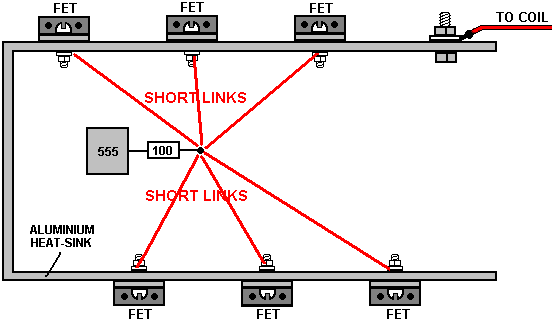 There are two things to note here. Firstly, the 100 ohm resistor coming from pin 3 of the 555 timer IC is positioned centrally around the six FET transistors mounted on the aluminium heat-sink, and that point is carried closer to each FET with a low-resistance conductor to give a good-quality link for the resistors feeding the Gate of each FET. Secondly, the heat-sink itself is also used to provide a low-resistance electrical connection to the coil which the FETs are driving. The connection to the heat-sink is via a nut and bolt clamping a solder tag firmly to a cleaned area of the heat-sink. Each FET is electrically connected to the heat sink through it’s mounting tag which forms it’s heat-sink connection as well as connecting to the Drain of the Transistor. However, if the aluminium heat sink is a black anodised type, then, apart from cleaning between each FET and the heat-sink contact area, it is worth running a thick wire also linking the central FET pins to the output wire connection point. The transistors used in the prototype, and recommended for replications is the NTE2397. This is not a very common transistor in Europe at this time and so the popular IRF740 might perhaps be used as it appears to have all of the main characteristics of the NTE2397 transistor. ‘UFOpolitics’ suggests the 2SK2837 (500V, 20A, 80A pulsed), or the IRFP460 (500V, 0.27 Ohm, 20A and 80A pulsed) As the 555 timer has a maximum supply voltage of 15 volts, an LM317N voltage-stabiliser chip is used to create a 12-volt supply from the 36-volt battery (a 24V battery could be used): 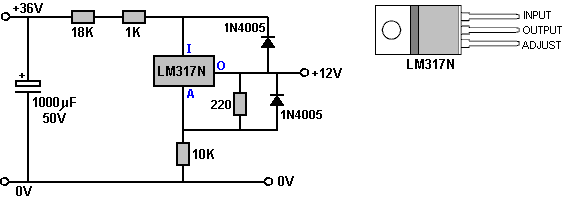 The LM317N integrated circuit should be attached to a good heat sink as it is dropping off 24 of the 36 volts powering the circuit, and so, has to dissipate twice the power that the NE555 chip uses:  There are various pulsing circuits which have been used successfully with this system. ‘UFOpolitics’ considers the NE555 chip to be the most straightforward, so perhaps my suggestion for this arrangement might be a suitable choice: 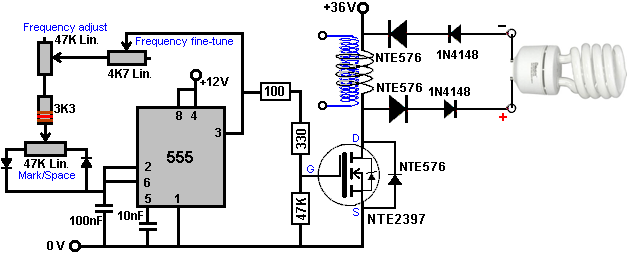 This gives fine control of the frequency and independent adjustment of the Mark/Space ratio or ‘Duty Cycle’ and it needs only three very cheap components other than the controls. If the expensive multi-turn high quality variable resistors are available, then the 4.7K ‘fine-tune’ variable resistor can be omitted as those variable resistors make the adjustments easier to control. The ‘Lin.’ In the diagram stands for ‘Linear’ which means that the resistance varies steadily at a constant rate as the shaft of the variable resistor is rotated. In the ‘UFOpolitics’ circuit, it is important to turn the frequency down to it’s minimum value and set the Mark/Space ratio to 50%, before powering the circuit down. Otherwise it would be easy to power the circuit up with a much higher frequency than is advisable and so, causing damage to some of the circuit components. There are ways to boost the performance over what has already been described. One way is to insert a stainless steel core inside the coil. Stainless steel is supposed to be non-magnetic but in practice, that is not always the case. However, ideally, this steel core is improved by altering it’s crystalline structure by heating it up and then quenching it by submerging it in cold water. Another improvement is to isolate the coil better at switch-off through the use of a second transistor. Having a ‘switched-off’ transistor at each end of the coil certainly blocks the flow of hot electricity, but if Tom Bearden is correct, the resistance of the transistors in their OFF state will actually boost the flow of cold electricity as it reacts in the reverse way to how hot electricity reacts. The arrangement is like this: 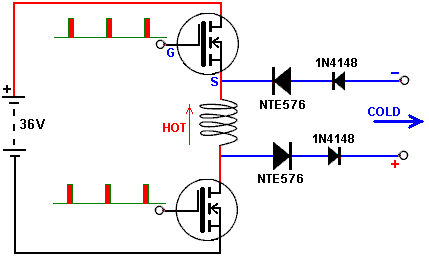 While this looks like a very simple circuit to implement, that is not the case. The upper transistor is switched ON by the voltage difference between it’s Gate “G” and it‘s Source “S”. But, the voltage at it’s Source is not fixed but varies rapidly due to the changing current in the coil, and that does not help when solid and reliable switching of the upper transistor is needed. A P-channel FET could be used instead and that would have it’s Source connected to the fixed voltage of the Plus of the 36V battery. That would help the switching enormously, but there would still be timing issues between the two transistors switching ON and OFF at exactly the same time. Other circuits have been suggested for doing that type of switching, but in the early stages, ‘UFOpolitics’ recommends that things be kept as simple as possible, so using just one transistor (although, perhaps, a bank of six in parallel to boost the current handling) is the best option. Switching speed is an item of major importance, even to the extent that the reduction in the speed of switching caused by using more than one transistor in parallel has caused the suggestion to be made that it might actually be a better option to use just one FET since these high-performance FETs are capable of carrying the whole of the switching current, and it is mainly to lower the FET operating temperature that multiple FET use is suggested. Every extra FET used in parallel, slows the switching down. However, it should be realised that there is a somewhat greater risk of burning the FET out if just one is used. The coil dimensions recommended are two-inch (50 mm) diameter and 2-inch length. The wound coil is likely to be about three-inches (75 mm) so making the flange diameter 4-inches (100 mm) is realistic: 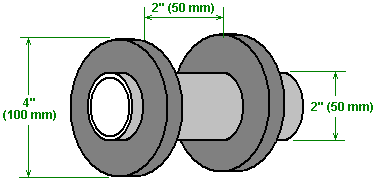  The recommended material is fibreglass which has high heat-resisting properties as well as being easy to work, the personal choice of ‘UFOpolitics’ is Polyester Resin with Methyl Ethyl Kethol (MEK) Hardener. A suggested alternative is acrylic, which is not as heat resistant. Acrylic is excellent for high-frequency applications but this circuitry does not operate at high frequencies. Whatever spool material is chosen, it needs to be non-magnetic. When connected in the circuit, the start of the coil winding wire goes to the battery positive. Here is another coil wound on acrylic tube and with all four diodes connected to the ends of the coil: 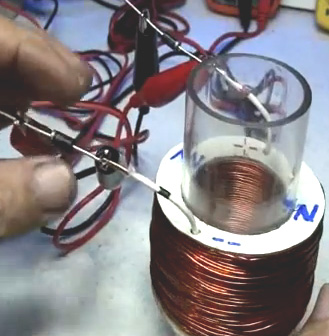 It should be understood that cold electricity provides almost unlimited power and it has uses which are not readily understood by many people. ‘UFOpolitics’ suggests that the hot electricity drive circuitry be tested initially using just a resistive load. If everything checks out correctly, then test with a lesser value resistor in series with the coil, and if that checks out satisfactorily, then testing cautiously with the coil on it’s own. Cold electricity can charge batteries rapidly and after a series of charge and discharge cycles, batteries become ‘conditioned’ to cold electricity and the experiences of Electrodyne Corp. staff show that large conditioned batteries which are fully discharged, can be recharged in under one minute. A member of the present forum has tried this with the ‘UFOpolitics’ circuit and he reports: Yesterday a friend and I took 6 identical, old, 12V, 115Ah batteries and made two 36V banks. We set up bank “A” (the better three) to power the device to charge bank “B”. Bank A was 37.00v at rest and Bank B was 34.94V. My lowest frequency was 133Hz (I need to change my cap and add another 100k pot with the one which is controlling the frequency) and the duty cycle was at 13%. We started at 2A draw on the Primary circuit. As I raised the frequency, the batteries on charge jumped up to 38.4V then dropped evenly to 36.27V and started up again (at about 0.01V every 2 seconds). After 2 and a half hours, they were up to 39.94V. At this point we stopped the charging and let everything rest for 10 minutes. So far everything seems very normal for this kind of charging, except that the device appears to be very stable and powerful...pushing the batteries right on up continuously. The Primary battery voltage dropped initially to 36.20V and stayed there the whole time, then recovered to 36.98V during the 10 minute rest. Then we switched battery banks A and B and charged the opposite way for about 20 minutes. We stopped and rested things again, swapped the banks back and started charging bank B again for another 20 minutes and stopped. After letting the batteries rest for a few hours in order to get truer readings, bank A was at. 37.07 and bank B was at 38.32V. Both battery banks had gained power. These were not very good batteries, either. One of the bank B batteries was at 10.69V at the start. Another interesting note: The amp draw on the Primary dropped from 2A to 1.5A as the frequency was raised from 133Hz to about 550Hz. This was with the very first use of cold electricity with these low-grade batteries and a major improvement can be expected after many additional charge/discharge cycles. This completely overcomes the factors which make a battery bank unsuitable for household power. If an entire battery bank can be recharged in just minutes, then it opens the way for serious household power using a battery bank. Cold electricity can also run motors very powerfully. Forum member ‘Netica’ found that putting a capacitor across the motor terminals improved the running very substantially, giving impressive performance. His video of this is here and the motor, running off an air-core coil with no steel insert. His set-up looks like this:  It is also possible to submerge cold electricity circuits in water without causing any harm: 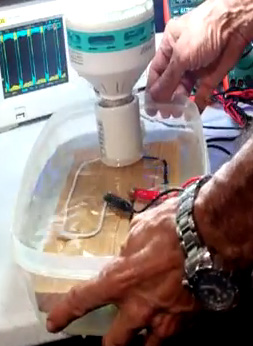 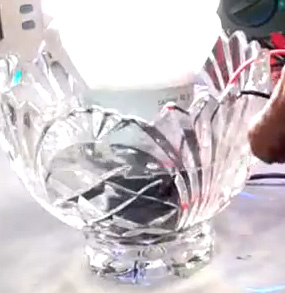 A video of this is located here including demonstrating the use of very powerful light bulbs. A general running demonstration is here. Stanley Meyer. Stan, who is famous for his water-splitting and related automotive achievements, actually held about forty patents on a wide range of inventions. Here is one of his patents which circulates magnetic particles in a fluid, and while the fluid does move, none of the other components in the device move and a high level of constructional skills is not called for: Please note that this is a re-worded excerpt from this Stan Meyer patent. Although it does not state it in the patent, Stan appears to make it understood that this system produces a significant power gain – something with Patent Offices find very difficult to accept. ELECTRICAL PARTICLE GENERATOR An electrical particle generator comprising a non-magnetic pipe in a closed loop having a substantial amount of magnetised particles encapsulated inside it. A magnetic accelerator assembly is positioned on the pipe, which has an inductive primary winding and a low-voltage input to the winding. A secondary winding is positioned on the pipe opposite to the primary winding. Upon voltage being applied to the primary winding, the magnetised particles are passed through the magnetic accelerator assembly with increased velocity. These accelerated particles passing through the pipe, induce an electrical voltage/current potential as they pass through the secondary winding. The increased secondary voltage is utilised in an amplifier arrangement. BACKGROUND AND PRIOR ART The prior art teachings expound the fundamental principle tat a magnetic field passing through inductive windings will generate a voltage/current or enhance the voltage across it if the winding is a secondary winding. It is also taught by the prior art, that a magnetic element in a primary inductive field will be attracted at one end of the coil and repelled at the other end. That is, a moving magnetic element will be accelerated in motion by the attraction and repulsion of the magnetic field of the primary inductive winding. In the conventional step-up transfer, the voltage across the secondary is a function of the number of turns in the secondary relative to the number of turns in the primary winding. Other factors are the diameter of the wire and whether the core is air or a magnetic material. SUMMARY OF THE INVENTION The present invention utilises the basic principle of the particle accelerator and the principle of inducing a voltage in a secondary winding by passing a magnetic element through it. The structure comprises a primary voltage inductive winding having a magnetic core, plus a low-voltage input. There is a secondary winding with a greater number of turns than the turns in the primary winding, plus an output for using the voltage induced in that winding. The primary winding and core are positioned on one side of an endless, closed-loop, non-magnetic pipe. The secondary windings are positioned on the opposite side of the endless pipe. The pipe is filled with discrete magnetic particles, preferably of a gas, and each particle has a magnetic polarised charge placed on it. Due to their magnetic polarisation charges, the particles will sustain some motion. As the particles approach the accelerator assembly, which is the primary coil, the magnetic field generated by the coil attracts the particles and accelerates them through the coil. As each particles passes through the coil, the repulsion end of the coil boosts the particle on it’s way. This causes each particle to exit from the coil with an increased velocity. As the magnetic particles pass through the secondary coil winding, they induce a voltage across the ends of that coil. Due to the larger number of turns, this induced voltage is much higher than the voltage across the primary coil. The main objective of this invention is to provide an electrical generator which is capable of producing a voltage/current of much greater magnitude than has been possible previously. Another objective is to provide a generator which uses magnetic particles and a magnetic accelerator. Another object is to provide a generator which can control the amplitude of the output. Another objective is to provide a generator which can be used with DC, AC, pulsed or other configurations of waveforms. Another objective is to provide a generator which can be used in either a single-phase or a 3-phase electrical system. Another objective is to provide a generator for developing magnetised particles for use in an electrical particle generator. Another objective is to provide an electrical generator which uses readily available components to construct a simple embodiment of this invention. BRIEF DESCRIPTION OF THE DRAWINGS 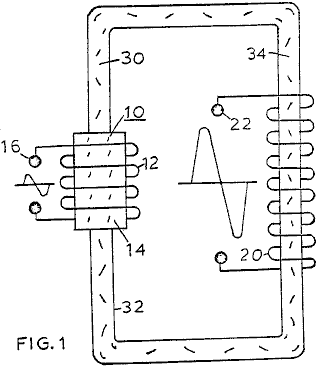 Fig.1 is a simplified illustration of the principles of the invention, shown partially in cross-section and partially pictorially.  Fig.2 is an electrical schematic illustration of the embodiment shown in Fig.1. 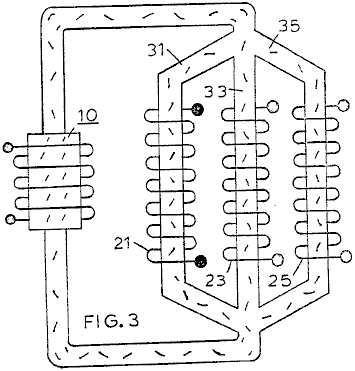 Fig.3 is an illustration similar to Fig.2 but which is adaptable to 3-phase use. 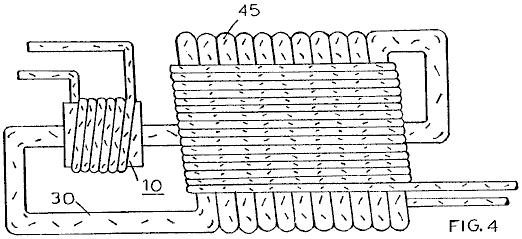 Fig.4 is a first alternative arrangement of a preferred implementation of the invention. 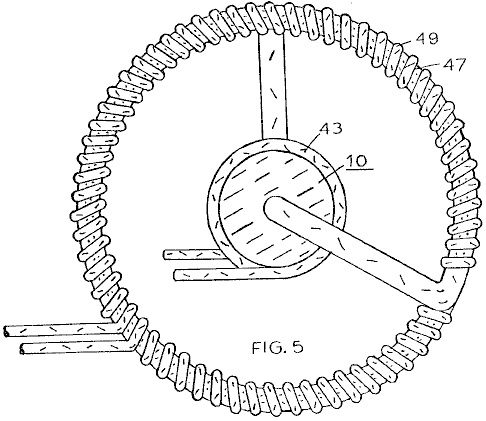 Fig.5 is another alternative arrangement of a preferred embodiment of the invention.  Fig.6 is another alternative arrangement of a preferred embodiment of this invention. 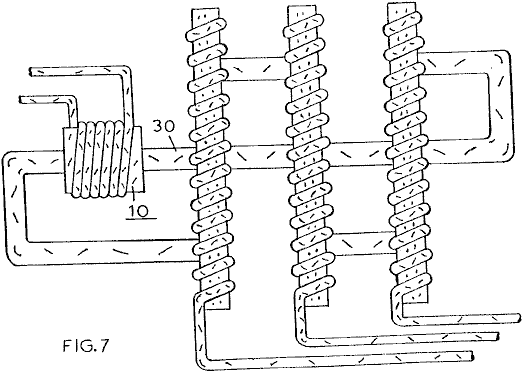 Fig.7 is another alternative arrangement of a preferred embodiment of this invention. 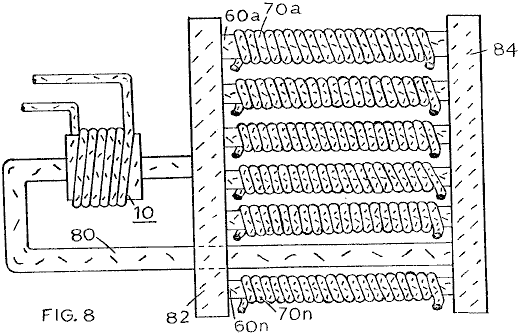 Fig.8 is another alternative arrangement of a preferred embodiment of this invention. 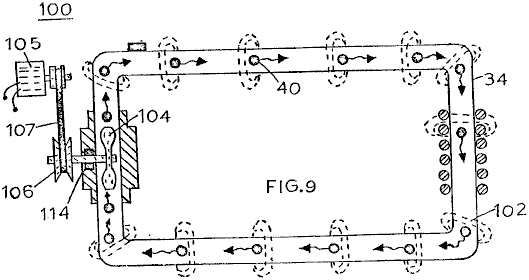 Fig.9 is an alternative arrangement for a magnetic drive particle accelerator assembly. 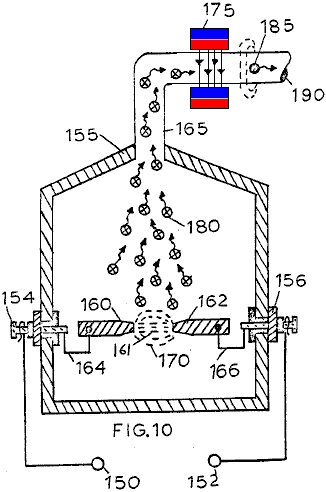 Fig.10 is an illustration of an alternative method of producing the magnetised particles used in this invention. DETAILED DESCRIPTION Fig.1 and Fig.2 show the invention in it’s most simplified schematic form: 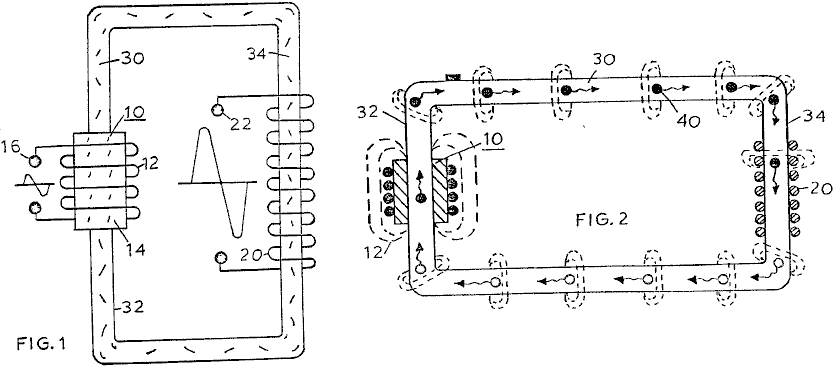 It comprises a primary coil magnetic accelerator assembly 10, a closed-loop non-magnetic pipe 30, and a secondary winding 20. The magnetic accelerator assembly is comprised of primary windings 12, a magnetic core 14, and voltage taps 16. The primary windings are positioned around end 32 of the closed-loop pipe 30 which is made from non-magnetic tubing. At the opposite end 34 of the closed-loop pipe 30, are the secondary windings 20. The end terminals 22 of the secondary winding 20, allow the voltage generated in the winding to be used. Contained inside pipe 30, there is a substantial number of magnetic particles 40 as shown in Fig.2. The particles 40 must be light enough to be freely mobile and so may be particles suspended in a fluid medium such as gas, liquid or light-weight movable solid particles. Of these options, the use of a gas is preferred. If solid particles are used as the transporting medium, then it may be desirable to remove all air from inside the pipe in order to reduce the resistance to the flowing particles. Each of the particles 40 is magnetised and the following description refers to one individual particle and not to the mass of particles as a whole. The voltage applied to terminals 16 of primary winding 12, is a low voltage, and it’s magnitude may be used as an input signal control. By varying the input voltage, the accelerator will vary the speed of the circulating particles, which will, in turn, vary the magnitude of the voltage/current output of the secondary winding 20. The output 22 of the secondary transformer winding 20, is a high voltage/current output.  It can be appreciated that the system shown in Fig.1 and Fig.2 where there is just one closed loop, provides a single-phase output in the secondary winding 20. Fig.3 shows a closed-loop arrangement with three parallel non-magnetic tubes 31, 33 and 35, each with it’s own output winding 21, 23 and 25. Each of these three windings are a single-phase output, and as their three pipes share a common input junction and a common output junction, these three output windings provide a balanced 3-phase electrical system.  Fig.4 shows an electrical power generator which operates exactly the same as those shown in Fig.1 and Fig.2. Here, the arrangement is for use in an environment where there is a high moisture content. An insulating coating 45, completely covers pipe 30 as well as all of the electrical windings. Fig.4 also illustrates the fact that increasing the number of turns for any given wire diameter increases the voltage/current output of the device. In this physical configuration, both vertical and horizontal directions are used which allows a large-diameter pipe to be used with a substantial number of turns of heavy-gauge high-current wire.  Fig.5 shows a coil arrangement 49, which uses the entire magnetic flux in the closed-loop tubing 47. This is a co-axial arrangement with the primary winding 43 as a central core.  Fig.6 illustrates a concentric spiral configuration of the tubing 50, with the secondary windings 53 covering it completely.  Fig.7 shows an arrangement where the particle accelerator 10 is wound over the tubing 30 in much the same way as in Fig.1 and Fig.2. However, in this arrangement, the tubing 30 is a continuous closed loop arranged in a series-parallel configuration where there are three secondary windings providing three separate outputs while the tubing 30 runs in series through those three windings.  Fig.8 shows a configuration which is the reverse of that shown in Fig.7. Here, there are several pick-up coils wound in series and unlike the earlier configurations, the tubing 80 is not continuous. In this arrangement, there is an input manifold 82, and an output manifold 84, and several separate tubes 60a, 60b, 60c, ….. 60n interconnecting those two manifolds. Each of those separate tubes has it’s own separate secondary coil 70a, 70b, 70c, ….. 70n wound on it.  The magnetic particle accelerator 10, can be different in design to that shown in Fig.1. Fig.9 shows a mechanical particle accelerator 100. In this arrangement, the magnetic particles 102 are permanently magnetised prior to being encapsulated in the non-magnetic pipe 110. The particles 102 are accelerated by fan blade or pump 104 rotated by mechanical drive assembly 106. The mechanical drive for assembly 106 may be a belt-drive pulley 112, or similar device driven by an electric motor. A sealing bearing 114 keeps the particles 102 inside the pipe 110. It has been stated that the magnetic particles traversing the secondary coils, generate a voltage/current in them. It must be understood, however, that that the particles are actually traversing the magnetic field of those coils. Also, the pipe 30 has been described as a non-magnetic pipe. There are certain non-magnetic pipes which would not work with this invention. Pipe 30 must be capable of passing magnetic lines of force. A significant feature of each of the various embodiments already described, is the generation of the magnetic particles which are encapsulated within the tubing.  Fig.10 shows an apparatus for carrying out the process of vapourising material to produce suitable particles which are then magnetised by being subjected to a magnetic field. The chamber 155 is an evacuated chamber having electrodes, made from magnetisable metal, 160 and 162. A voltage is applied between terminals 150 and 152, and this drives a current through terminals 154 and 156, to spark-gap electrodes 160 and 162, generating an arc which vapourises the tip material of the electrodes, producing particles 180. These particles rise and enter tube 190, passing through a magnetic field generator 175. This gives each particle a magnetic charge and they continue on their way as magnetically-charged particles 185, passing through port 190 to reach the electrical particle generator described above. In the simplified embodiment shown in Fig.1 and Fig.2, as well as the other preferred embodiments mentioned, it was indicated that a low voltage was applied to the particle accelerator 10. Upon acceleration, a high voltage/current would be induced in the secondary pick-up coil 20. A most significant advantage of the present invention is that the voltage amplification is not related to the shape of the waveform of the input voltage. Specifically, if the input is DC a DC voltage will be output. An AC input will produce an AC output. A pulsed voltage input will produce a pulsed voltage output and an input voltage of any other configuration will produce an output having that same configuration. Russ Gries Russ has produced a video presentation and analysis of the above Stan Meyer patent. This is a large download file which takes a considerable time to receive (some hours in my case). The download link is 1: Video 1 2: Video 2 3: Video 3 ……. 8: Video 8 And in particular, video 8, where Stan discusses the design and use of the generator. It is easy to get somewhat confused as Stan talks about both the Electrical Particle Generator and it’s use in combination with HHO production as a large-scale power generation source. The very experienced Alex Petty is joining with Russ in working on replicating Stan’s system and Alex’s web site is www.alexpetty.com. A discussion forum linked to this is here and there is information here at www.overunity.com and high-resolution pictures can also be seen in Russ’ video here. Russ’ own website is here and an additional video of the most recent developmental work being undertaken is here. There are various important things which are commented on and Russ is to be commended for drawing attention to them. For the moment, please forget about HHO as that is a separate issue. As far as I can see, the patent does not claim that the device is COP>1 but instead that the device is a power transformer which potentially has a greater power output than conventional transformers since there is no Lenz Law reverse magnetic path from the output coil winding to affect the input power. Having said that, Stan in his video points out ways to boost the power of the device, namely: 1. Increase the strength of the magnetic particles 2. Increase the speed of the magnetic particles 3. Lower the distance between the magnetic particles and the output winding. The magnetic particles can be produced in various ways, but the most effective appears to be by filling the arcing chamber with argon gas and using iron, nickel or cobalt electrodes. The reason for this is that the electric arc does not only generate minute particles of the electrode material, but it also interacts with the argon, stripping off electrons and causing some of the metal particles to combine with the modified argon gas molecules to form a magnetic gas. That gas will always remain a magnetic gas due to the atomic bonding as it is not just minute particles of metal physically suspended in a gas due to their tiny size. You will recall from chapter 1, that the very successful ShenHe Wang magnet motor/generator has a magnetic liquid as a key component. Here, Stan is producing a much lighter magnetic gas and the advantage of that lightness is that it can be boosted to very high speeds without any danger. The larger the number of modified argon molecules, the greater the magnetic effect when they pass through a coil of wire. The argon gas can be passed through the arc chamber over and over again so that a very high percentage of the gas is magnetic. Alternatively, if you are sophisticated in the design of the particle generator, you can arrange for the molecules which have become magnetic, to be pulled off into storage by a magnetic field. Stan talks about pumping the magnetic gas through whatever pipe loop arrangement you decide to use, by a pump, but he promptly moves on to using a magnetic coil to boost the gas forward as the coil has no moving parts and so, no mechanical wear. This is only one reason. The main reason is that with magnetic acceleration, the gas speed can become very high indeed and in his video he talks about the speed of light. However, I personally do not believe that anything remotely like a speed that great could be achieved inside a pipe loop of small diameter. Nevertheless, speeds well in excess of what a mechanical pump can achieve are likely to be produced by magnetic acceleration. Russ, in his discussion, points out that on most of Stan’s surviving prototypes, the coil which is used for the acceleration is constructed using several apparently separate coils, and he speculates that each coil section is powered sequentially, causing a rippling magnetic field. While that is definitely possible, I don’t see that a style of coil powering would have any advantage as opposed to powering all of the coils continuously. However, if sequential powering is believed to be an advantage, then the ‘Divide-by-N’ circuitry of chapter 12 can be used to provide the sequential powering or any more complex sequence. Stan then points out that the output voltage can be increased by increasing the number of turns on the output coil and/or having additional output coils. This is easily understood conventional electrics. But, he then goes on to point out that the output will also be increased if the electrons of the modified argon molecules are raised to a high orbital level. This places the electromagnetic electrons (as described in chapter 11) closer to the output coils and presumably also allows the gas to be accelerated to a greater speed by the driving magnetic field. This power boosting of the gas is achieved using Stan’s “Gas Processor” described in chapter 10. The Gas Processor pumps electromagnetic energy into the gas through the use of banks of Light-Emitting Diodes which produce light of the correct wavelength to add energy to that particular gas. If you check on the internet for the wavelength of argon, you find conflicting information, with some sites saying that the wavelength is 1090 nanometres (“nm”) and most others saying both 488 nm and 514.5 nm. Most LEDs produce a band of frequencies, so it would be a case of picking LEDs whose band of frequencies include the wanted wavelength. The Gas Processor itself, consists of a central tube which is polished to a mirror finish on the outside, surrounded by a larger tube which is highly polished on the inside. The LED light is then bounced between these polished surfaces until it is absorbed by the gas which is passed through the gap between the two tubes. This is not easy to illustrate, but it might be shown like this: 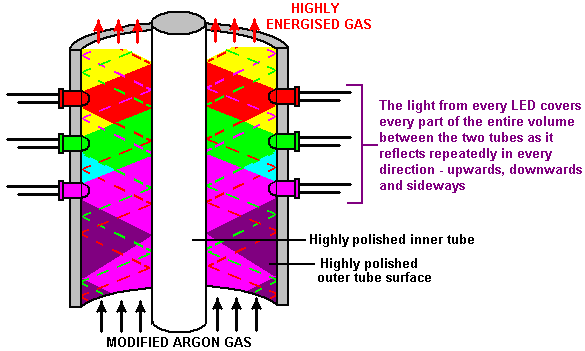 In Stan’s design, he uses six columns of sixteen LEDs, with each column of LEDs spaced out evenly around the outer tube. So, to boost the Magnetic Particle Generator to greater power levels, a Gas Processor is placed in the loop of tubing: 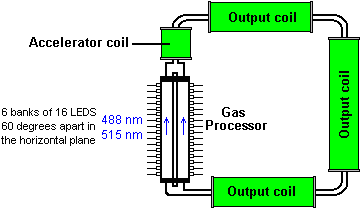 The Gas Processor normally has a coil mounted at each end and it may be convenient to use coils in those positions as accelerator coils. It may also be an advantage to apply a pulsed high-voltage between the inner and outer tubes of the Gas Processor. As it stands, this looks as if it has a high possibility of being a COP>1 electrical device. The E-Stress Power Generation System On the seventh of September 2013 a man with the ID of ‘harisingh’ published the following information. I have tried to contact him to ask his permission to publish his work, but without any success. I have no information on it other than what is shown here. What he says is: The E-Stress Power Generating System is a most intriguing over-unity power generating project. It is extremely versatile while being relatively easy to construct and it is readily upgradable. The Golden Key or Golden Mean is the principle which allows this device to draw power directly from the e-field’s relative vacuum energy density using induction-less coils. What makes this design so unique can be seen from the following illustrations. What makes this dual induction-less coil so special is that it nullifies the effects of electrostatic induction using only a fraction of the power required to sustain the charge-displacement which creates the affecting E-field. In conventional electronic circuits, coils and capacitors are generally kept away from each other, but in this circuit, their interaction is the key to success ! The E-Stress Amplifier consists of three cylindrical capacitors and two induction-less coils with external circuitry designed to start-up and maintain the entire system and load. The interior and exterior capacitors, CDI and CDE, are charged up and kept charged by a voltage source Vc which is in the range of 50 to 90 volts DC. The charge on these capacitors remains for a long time, governed by the resistance of the dielectric, (provided that there are no accidental short circuits) so, the energy required to maintain the charge on these capacitors is minimal. The third capacitor Cr, is sandwiched between the interior and exterior capacitors and is independent of Vc. When the other two capacitors, CDI and CDE, become charged, capacitor Cr becomes charged as well but at a slightly lower voltage due to dielectric voltage drop. This charging effect is a result of electrostatic induction. Separating the concentric capacitors are two special induction-less coils. When current passes through these coils, the electrostatic induction forces are temporarily neutralised, allowing the charged capacitor Cr to discharge and oscillate with an exterior power coil or transformer as shown in Fig.7. The induction-less coils Lo are pulsed with DC at the same rate as the natural resonant frequency of the tank circuit (Cr-Lr). Keeping the pulsing rate within 10% of the tank circuit's resonant frequency will maintain maximum output power. Because of the flexibility in the construction parameters, determining the resonant frequency and power capabilities will be difficult without advanced analysing equipment. So to overcome these difficulties, a variable-frequency oscillator can be used as it allows ready determination of the appropriate frequency range needed. A steady constant load will make this determination easier as well. When the maximum output power is reached, you can measure the resistance of the oscillator's variable resistor to aid in determining, and finally setting, oscillation at the natural resonant frequency of the tank circuit. An additional 1K ohm variable resistor can be connected in series with the 100K variable resistor shown, to allow easy "fine" tuning.  Fig.1 shows the general layout of the entire E-Stress Power System. This diagram illustrates the driver core and the variable frequency oscillator which determines the tank circuit resonance. Fig.1 also shows the DC power source of around 50 to 90 volts, which initially charges the "core" capacitor CDI / CDE. Also shown in this diagram is the resonant coil and power output or "pickup" coil.  Fig.2 shows the "driver core" in a cutaway, perspective diagram. The PVC plastic "core” material can be a 6 inch (150 mm) diameter foot long (300 mm) piece of PVC pipe in this scaled-down model system. In this diagram, please note the inner and outer one-layer capacitor capacitors CDE and CDI. Also note that the middle capacitor (Cr) is a three-layer capacitor made from heavy aluminium foil or stainless steel. The induction-less coils can be seen in two places on either side of capacitor CR. The induction-less coils are made from solid gauge #20 to #30 magnet wire (0.812 mm to 0.255 mm diameter enamelled copper wire). 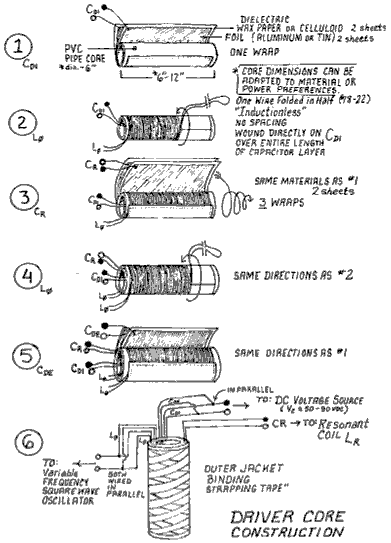 Fig.3 above, illustrates how the centre driver "core" is constructed. There are six basic steps to constructing the driver "core" assembly. First begin with the PVC pipe as shown and begin wrapping the first capacitor CDI. Step two shows the first induction-less coil L1. Note that for the induction-less coil, the wire is "folded" back and the two conductors are wound together as shown. This coil is single-wound with #18 to #22 gauge wire (1.024 mm to 0.644 mm diameter). Step three shows the centre capacitor Cr. This capacitor is created in the same manner as the previous capacitor except that it has three layers of turns. Step four illustrates the second induction-less coil which is wound in the same direction as the first coil. This second coil Lo is single-layer. Step five is the final capacitor CDE, which consists of a single wrap, and is wrapped in the same direction as the two previous capacitors. The final step, six, is to wrap the entire assembly with strapping tape to form an outer jacket when finished. 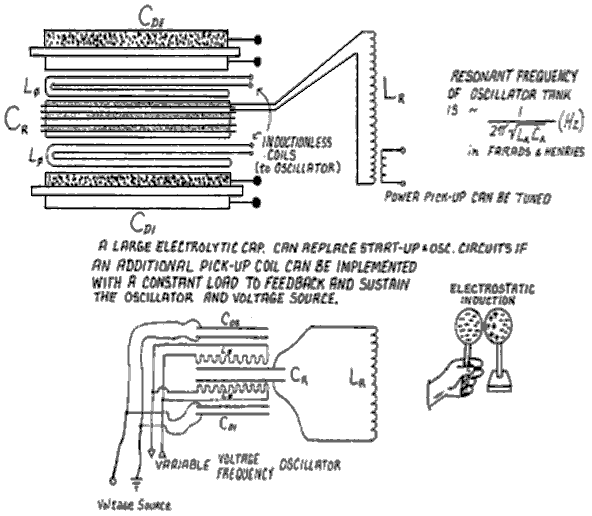 Fig.4 above, is an electrical diagram of the main capacitor "core" and the coil hookups of the E-Stress Power System. Note the parallel connections of the inner and outer capacitors CEI / CDE, which connect to the 90 volt DC power source. Also note the parallel connections of the induction-less coils which connect to the variable frequency oscillator circuit. The centre capacitor Cr is shown connected to the resonant power coil Lr. 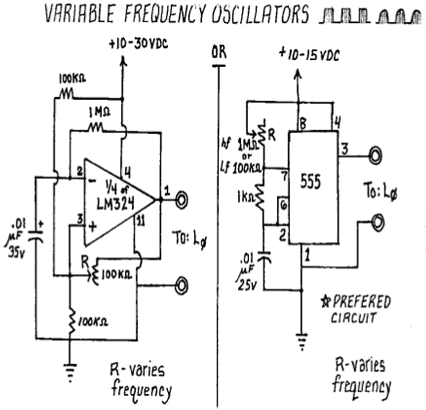 Fig.5 above, displays the two different types of variable frequency oscillators which are used to drive the induction-less coils. The first oscillator displayed consists of an LM324 Op-amp configured to produce feedback and thus oscillate. The second example oscillator consists of an LM555 timer IC. Either example oscillator can be used to drive the induction-less coils. 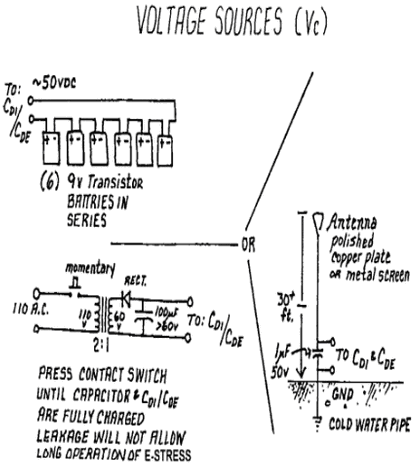 Fig.6 above, shows the DC voltage source Vc which is applied to the CDE / CDI capacitors which are connected in parallel to form the electrostatic field. The DC voltage source could be one of the three types of voltages sources as shown. A battery could be used, which consists of six nine volt batteries. You could also fabricate an AC to DC power source or you could elect to create your own antenna DC source as shown. The battery method affords a quick means to test the circuitry and is safe as well. 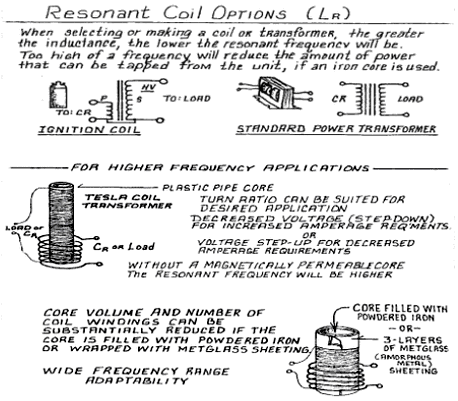 Fig.7 above, illustrates the options for the two different types of resonant coil Lr. Basically, there are two coil options: the standard iron core power transformer and the high frequency Tesla type coil such as the ignition type coil. You will need to determine the type of output you wish to have in the overall design. For conventional designs you would most likely construct the standard transformer shown at the bottom of the diagram, which consists of a core filled with powdered iron or Metglass. 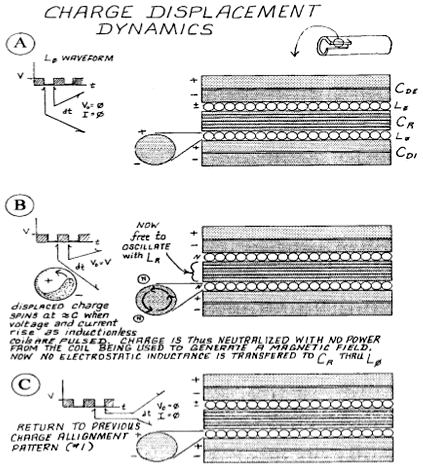 Fig.8 above, discusses the charge displacement dynamics involved in the E-Stress Amplifier power system. Diagram A illustrates the induction-less coil Lo waveform. Diagram B depicts the displaced charge spins when the voltage and current rise as the induction-less coils are pulsed, while diagram C shows the waveform during the return to the previous charge patterns, starting the cyclic over again. Patrick Kelly http://www.free-energy-info.tuks.nl http://www.free-energy-info.com http://www.free-energy-info.co.uk http://www.free-energy-devices.com |